UIT Student Assessment Pack for CPCCBC4011B
VerifiedAdded on 2023/05/30
|72
|24559
|303
AI Summary
This assessment pack is for students enrolled in CPC40110 - Certificate IV in Building and Construction (Building) and provides details about the unit CPCCBC4011B - Apply structural principles to commercial low rise constructions. It includes student and trainer/assessor details, course and unit details, assessment details and results sheet, assessment overview, submission guidelines, and policies and procedures.
Contribute Materials
Your contribution can guide someone’s learning journey. Share your
documents today.
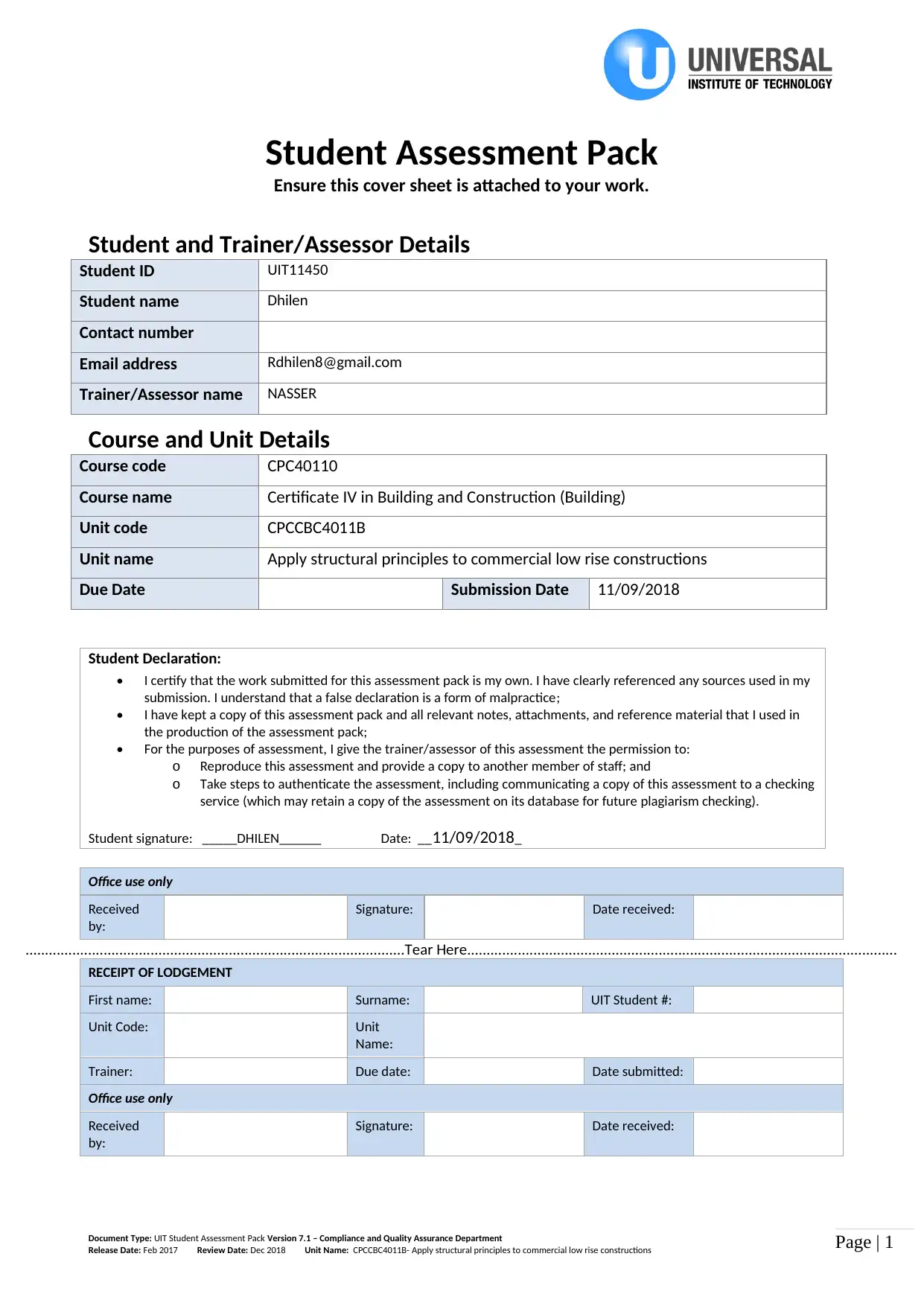
Page | 1
Student Assessment Pack
Ensure this cover sheet is attached to your work.
Student and Trainer/Assessor Details
Student ID UIT11450
Student name Dhilen
Contact number
Email address Rdhilen8@gmail.com
Trainer/Assessor name NASSER
Course and Unit Details
Course code CPC40110
Course name Certificate IV in Building and Construction (Building)
Unit code CPCCBC4011B
Unit name Apply structural principles to commercial low rise constructions
Due Date Submission Date 11/09/2018
Student Declaration:
• I certify that the work submitted for this assessment pack is my own. I have clearly referenced any sources used in my
submission. I understand that a false declaration is a form of malpractice;
• I have kept a copy of this assessment pack and all relevant notes, attachments, and reference material that I used in
the production of the assessment pack;
• For the purposes of assessment, I give the trainer/assessor of this assessment the permission to:
o Reproduce this assessment and provide a copy to another member of staff; and
o Take steps to authenticate the assessment, including communicating a copy of this assessment to a checking
service (which may retain a copy of the assessment on its database for future plagiarism checking).
Student signature: _____DHILEN______ Date: __11/09/2018_
Office use only
Received
by:
Signature: Date received:
.................................................................................................Tear Here..............................................................................................................
RECEIPT OF LODGEMENT
First name: Surname: UIT Student #:
Unit Code: Unit
Name:
Trainer: Due date: Date submitted:
Office use only
Received
by:
Signature: Date received:
Document Type: UIT Student Assessment Pack Version 7.1 – Compliance and Quality Assurance Department
Release Date: Feb 2017 Review Date: Dec 2018 Unit Name: CPCCBC4011B- Apply structural principles to commercial low rise constructions
Student Assessment Pack
Ensure this cover sheet is attached to your work.
Student and Trainer/Assessor Details
Student ID UIT11450
Student name Dhilen
Contact number
Email address Rdhilen8@gmail.com
Trainer/Assessor name NASSER
Course and Unit Details
Course code CPC40110
Course name Certificate IV in Building and Construction (Building)
Unit code CPCCBC4011B
Unit name Apply structural principles to commercial low rise constructions
Due Date Submission Date 11/09/2018
Student Declaration:
• I certify that the work submitted for this assessment pack is my own. I have clearly referenced any sources used in my
submission. I understand that a false declaration is a form of malpractice;
• I have kept a copy of this assessment pack and all relevant notes, attachments, and reference material that I used in
the production of the assessment pack;
• For the purposes of assessment, I give the trainer/assessor of this assessment the permission to:
o Reproduce this assessment and provide a copy to another member of staff; and
o Take steps to authenticate the assessment, including communicating a copy of this assessment to a checking
service (which may retain a copy of the assessment on its database for future plagiarism checking).
Student signature: _____DHILEN______ Date: __11/09/2018_
Office use only
Received
by:
Signature: Date received:
.................................................................................................Tear Here..............................................................................................................
RECEIPT OF LODGEMENT
First name: Surname: UIT Student #:
Unit Code: Unit
Name:
Trainer: Due date: Date submitted:
Office use only
Received
by:
Signature: Date received:
Document Type: UIT Student Assessment Pack Version 7.1 – Compliance and Quality Assurance Department
Release Date: Feb 2017 Review Date: Dec 2018 Unit Name: CPCCBC4011B- Apply structural principles to commercial low rise constructions
Secure Best Marks with AI Grader
Need help grading? Try our AI Grader for instant feedback on your assignments.
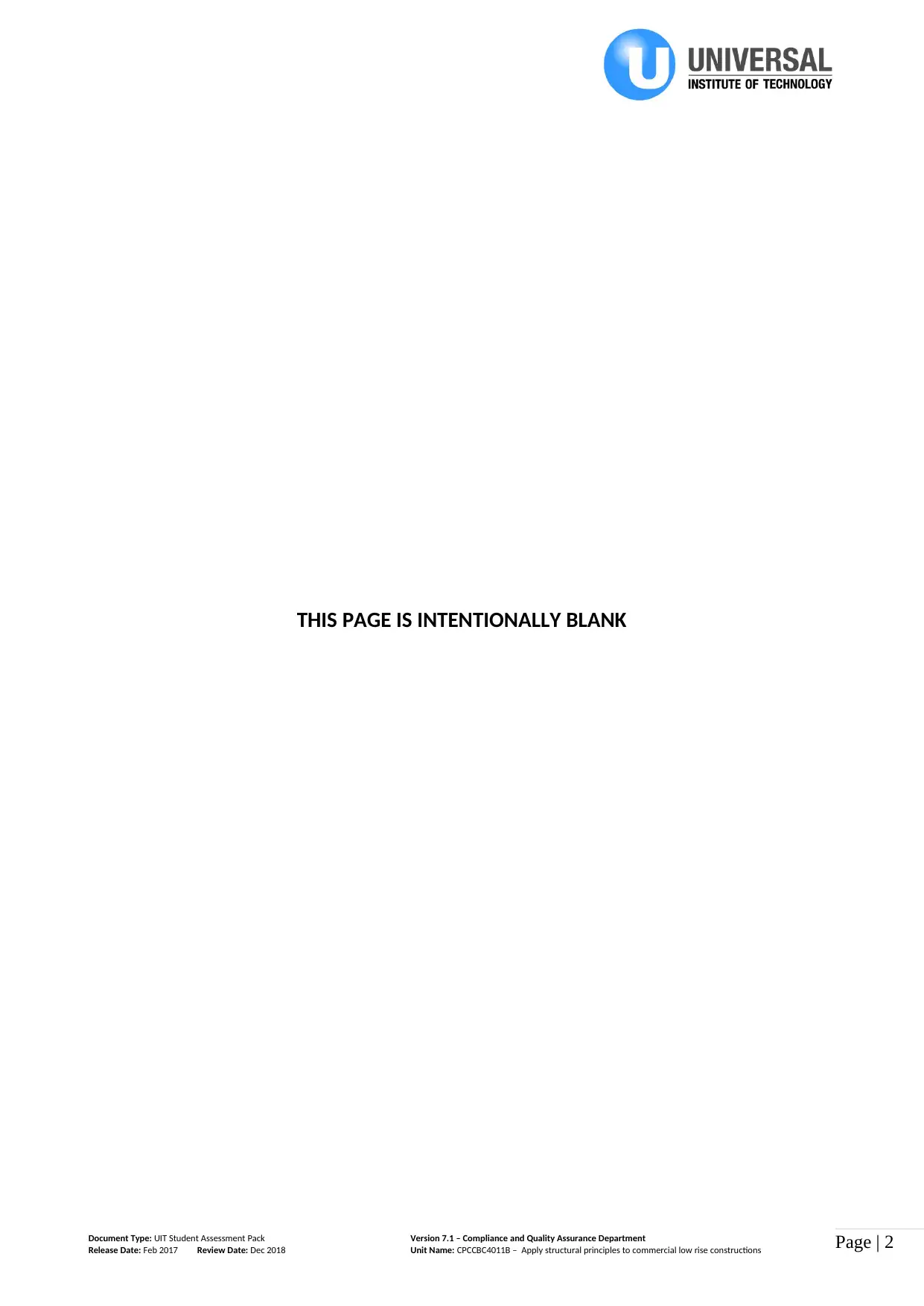
Page | 2
THIS PAGE IS INTENTIONALLY BLANK
Document Type: UIT Student Assessment Pack Version 7.1 – Compliance and Quality Assurance Department
Release Date: Feb 2017 Review Date: Dec 2018 Unit Name: CPCCBC4011B – Apply structural principles to commercial low rise constructions
THIS PAGE IS INTENTIONALLY BLANK
Document Type: UIT Student Assessment Pack Version 7.1 – Compliance and Quality Assurance Department
Release Date: Feb 2017 Review Date: Dec 2018 Unit Name: CPCCBC4011B – Apply structural principles to commercial low rise constructions
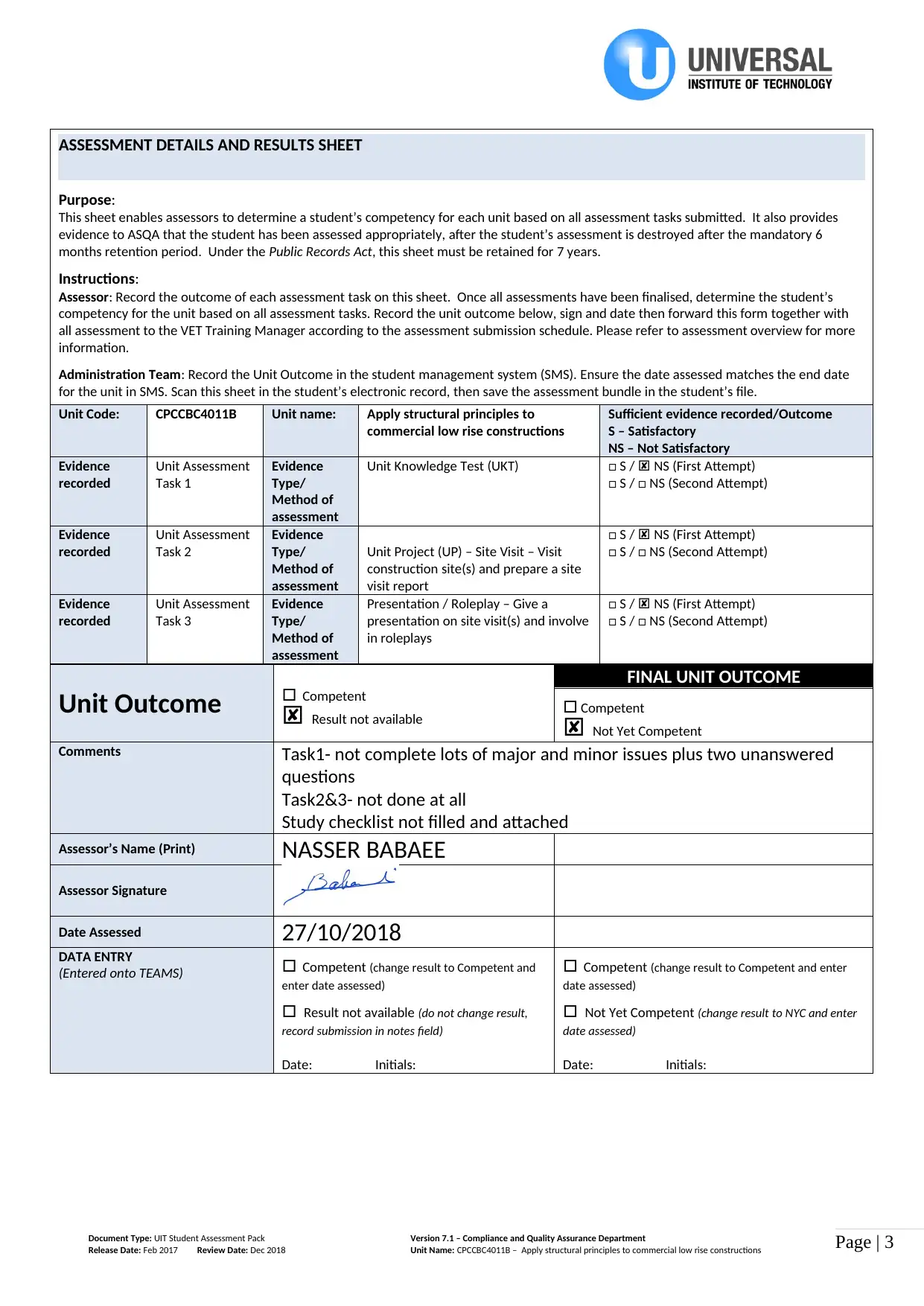
Page | 3
ASSESSMENT DETAILS AND RESULTS SHEET
Purpose:
This sheet enables assessors to determine a student’s competency for each unit based on all assessment tasks submitted. It also provides
evidence to ASQA that the student has been assessed appropriately, after the student’s assessment is destroyed after the mandatory 6
months retention period. Under the Public Records Act, this sheet must be retained for 7 years.
Instructions:
Assessor: Record the outcome of each assessment task on this sheet. Once all assessments have been finalised, determine the student’s
competency for the unit based on all assessment tasks. Record the unit outcome below, sign and date then forward this form together with
all assessment to the VET Training Manager according to the assessment submission schedule. Please refer to assessment overview for more
information.
Administration Team: Record the Unit Outcome in the student management system (SMS). Ensure the date assessed matches the end date
for the unit in SMS. Scan this sheet in the student’s electronic record, then save the assessment bundle in the student’s file.
Unit Code: CPCCBC4011B Unit name: Apply structural principles to
commercial low rise constructions
Sufficient evidence recorded/Outcome
S – Satisfactory
NS – Not Satisfactory
Evidence
recorded
Unit Assessment
Task 1
Evidence
Type/
Method of
assessment
Unit Knowledge Test (UKT) □ S / NS (First Attempt)
□ S / □ NS (Second Attempt)
Evidence
recorded
Unit Assessment
Task 2
Evidence
Type/
Method of
assessment
Unit Project (UP) – Site Visit – Visit
construction site(s) and prepare a site
visit report
□ S / NS (First Attempt)
□ S / □ NS (Second Attempt)
Evidence
recorded
Unit Assessment
Task 3
Evidence
Type/
Method of
assessment
Presentation / Roleplay – Give a
presentation on site visit(s) and involve
in roleplays
□ S / NS (First Attempt)
□ S / □ NS (Second Attempt)
Unit Outcome □ Competent
Result not available
FINAL UNIT OUTCOME
□ Competent
Not Yet Competent
Comments Task1- not complete lots of major and minor issues plus two unanswered
questions
Task2&3- not done at all
Study checklist not filled and attached
Assessor’s Name (Print) NASSER BABAEE
Assessor Signature
Date Assessed 27/10/2018
DATA ENTRY
(Entered onto TEAMS) □ Competent (change result to Competent and
enter date assessed)
□ Result not available (do not change result,
record submission in notes field)
Date: Initials:
□ Competent (change result to Competent and enter
date assessed)
□ Not Yet Competent (change result to NYC and enter
date assessed)
Date: Initials:
Document Type: UIT Student Assessment Pack Version 7.1 – Compliance and Quality Assurance Department
Release Date: Feb 2017 Review Date: Dec 2018 Unit Name: CPCCBC4011B – Apply structural principles to commercial low rise constructions
ASSESSMENT DETAILS AND RESULTS SHEET
Purpose:
This sheet enables assessors to determine a student’s competency for each unit based on all assessment tasks submitted. It also provides
evidence to ASQA that the student has been assessed appropriately, after the student’s assessment is destroyed after the mandatory 6
months retention period. Under the Public Records Act, this sheet must be retained for 7 years.
Instructions:
Assessor: Record the outcome of each assessment task on this sheet. Once all assessments have been finalised, determine the student’s
competency for the unit based on all assessment tasks. Record the unit outcome below, sign and date then forward this form together with
all assessment to the VET Training Manager according to the assessment submission schedule. Please refer to assessment overview for more
information.
Administration Team: Record the Unit Outcome in the student management system (SMS). Ensure the date assessed matches the end date
for the unit in SMS. Scan this sheet in the student’s electronic record, then save the assessment bundle in the student’s file.
Unit Code: CPCCBC4011B Unit name: Apply structural principles to
commercial low rise constructions
Sufficient evidence recorded/Outcome
S – Satisfactory
NS – Not Satisfactory
Evidence
recorded
Unit Assessment
Task 1
Evidence
Type/
Method of
assessment
Unit Knowledge Test (UKT) □ S / NS (First Attempt)
□ S / □ NS (Second Attempt)
Evidence
recorded
Unit Assessment
Task 2
Evidence
Type/
Method of
assessment
Unit Project (UP) – Site Visit – Visit
construction site(s) and prepare a site
visit report
□ S / NS (First Attempt)
□ S / □ NS (Second Attempt)
Evidence
recorded
Unit Assessment
Task 3
Evidence
Type/
Method of
assessment
Presentation / Roleplay – Give a
presentation on site visit(s) and involve
in roleplays
□ S / NS (First Attempt)
□ S / □ NS (Second Attempt)
Unit Outcome □ Competent
Result not available
FINAL UNIT OUTCOME
□ Competent
Not Yet Competent
Comments Task1- not complete lots of major and minor issues plus two unanswered
questions
Task2&3- not done at all
Study checklist not filled and attached
Assessor’s Name (Print) NASSER BABAEE
Assessor Signature
Date Assessed 27/10/2018
DATA ENTRY
(Entered onto TEAMS) □ Competent (change result to Competent and
enter date assessed)
□ Result not available (do not change result,
record submission in notes field)
Date: Initials:
□ Competent (change result to Competent and enter
date assessed)
□ Not Yet Competent (change result to NYC and enter
date assessed)
Date: Initials:
Document Type: UIT Student Assessment Pack Version 7.1 – Compliance and Quality Assurance Department
Release Date: Feb 2017 Review Date: Dec 2018 Unit Name: CPCCBC4011B – Apply structural principles to commercial low rise constructions
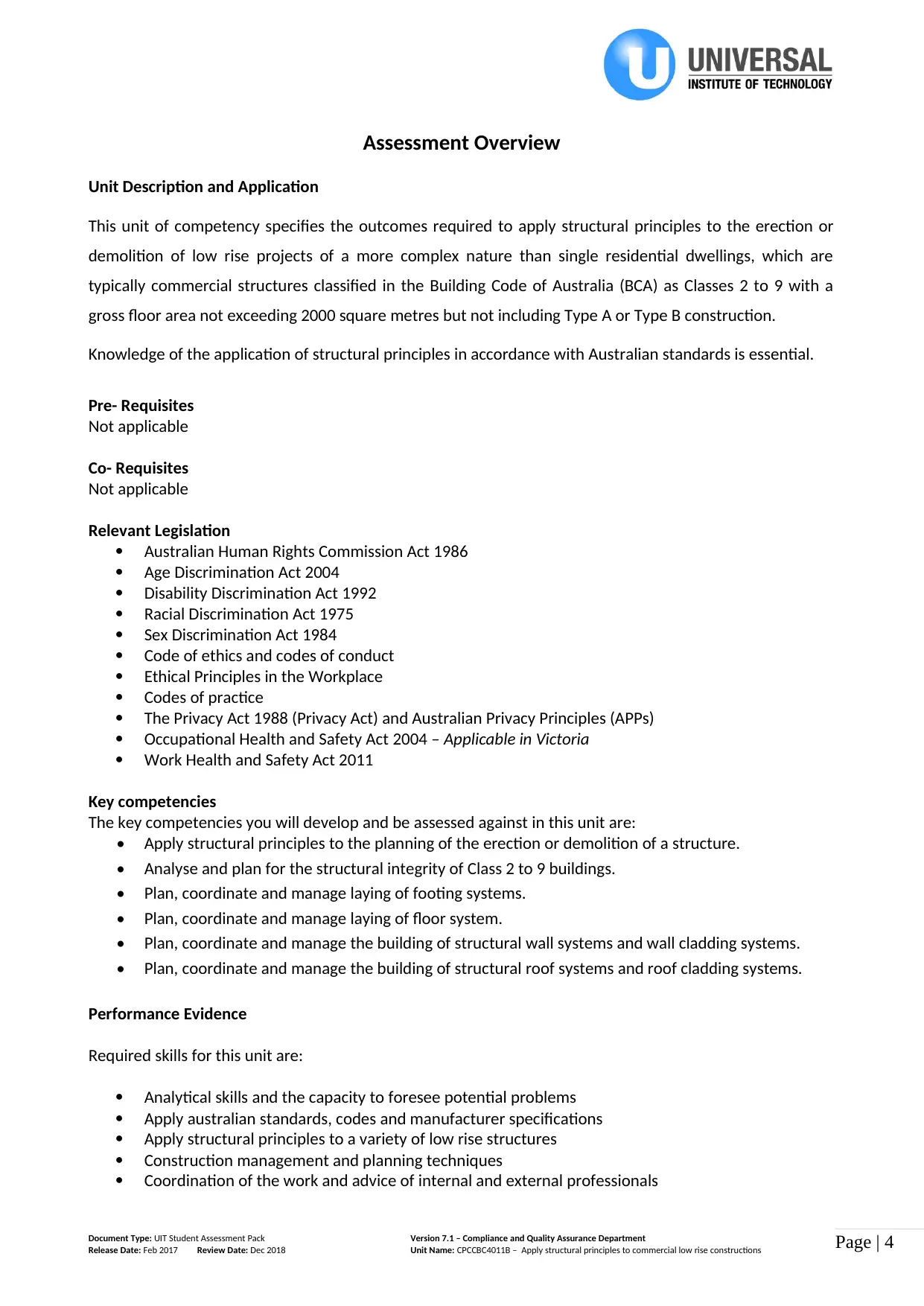
Page | 4
Assessment Overview
Unit Description and Application
This unit of competency specifies the outcomes required to apply structural principles to the erection or
demolition of low rise projects of a more complex nature than single residential dwellings, which are
typically commercial structures classified in the Building Code of Australia (BCA) as Classes 2 to 9 with a
gross floor area not exceeding 2000 square metres but not including Type A or Type B construction.
Knowledge of the application of structural principles in accordance with Australian standards is essential.
Pre- Requisites
Not applicable
Co- Requisites
Not applicable
Relevant Legislation
Australian Human Rights Commission Act 1986
Age Discrimination Act 2004
Disability Discrimination Act 1992
Racial Discrimination Act 1975
Sex Discrimination Act 1984
Code of ethics and codes of conduct
Ethical Principles in the Workplace
Codes of practice
The Privacy Act 1988 (Privacy Act) and Australian Privacy Principles (APPs)
Occupational Health and Safety Act 2004 – Applicable in Victoria
Work Health and Safety Act 2011
Key competencies
The key competencies you will develop and be assessed against in this unit are:
• Apply structural principles to the planning of the erection or demolition of a structure.
• Analyse and plan for the structural integrity of Class 2 to 9 buildings.
• Plan, coordinate and manage laying of footing systems.
• Plan, coordinate and manage laying of floor system.
• Plan, coordinate and manage the building of structural wall systems and wall cladding systems.
• Plan, coordinate and manage the building of structural roof systems and roof cladding systems.
Performance Evidence
Required skills for this unit are:
Analytical skills and the capacity to foresee potential problems
Apply australian standards, codes and manufacturer specifications
Apply structural principles to a variety of low rise structures
Construction management and planning techniques
Coordination of the work and advice of internal and external professionals
Document Type: UIT Student Assessment Pack Version 7.1 – Compliance and Quality Assurance Department
Release Date: Feb 2017 Review Date: Dec 2018 Unit Name: CPCCBC4011B – Apply structural principles to commercial low rise constructions
Assessment Overview
Unit Description and Application
This unit of competency specifies the outcomes required to apply structural principles to the erection or
demolition of low rise projects of a more complex nature than single residential dwellings, which are
typically commercial structures classified in the Building Code of Australia (BCA) as Classes 2 to 9 with a
gross floor area not exceeding 2000 square metres but not including Type A or Type B construction.
Knowledge of the application of structural principles in accordance with Australian standards is essential.
Pre- Requisites
Not applicable
Co- Requisites
Not applicable
Relevant Legislation
Australian Human Rights Commission Act 1986
Age Discrimination Act 2004
Disability Discrimination Act 1992
Racial Discrimination Act 1975
Sex Discrimination Act 1984
Code of ethics and codes of conduct
Ethical Principles in the Workplace
Codes of practice
The Privacy Act 1988 (Privacy Act) and Australian Privacy Principles (APPs)
Occupational Health and Safety Act 2004 – Applicable in Victoria
Work Health and Safety Act 2011
Key competencies
The key competencies you will develop and be assessed against in this unit are:
• Apply structural principles to the planning of the erection or demolition of a structure.
• Analyse and plan for the structural integrity of Class 2 to 9 buildings.
• Plan, coordinate and manage laying of footing systems.
• Plan, coordinate and manage laying of floor system.
• Plan, coordinate and manage the building of structural wall systems and wall cladding systems.
• Plan, coordinate and manage the building of structural roof systems and roof cladding systems.
Performance Evidence
Required skills for this unit are:
Analytical skills and the capacity to foresee potential problems
Apply australian standards, codes and manufacturer specifications
Apply structural principles to a variety of low rise structures
Construction management and planning techniques
Coordination of the work and advice of internal and external professionals
Document Type: UIT Student Assessment Pack Version 7.1 – Compliance and Quality Assurance Department
Release Date: Feb 2017 Review Date: Dec 2018 Unit Name: CPCCBC4011B – Apply structural principles to commercial low rise constructions
Secure Best Marks with AI Grader
Need help grading? Try our AI Grader for instant feedback on your assignments.
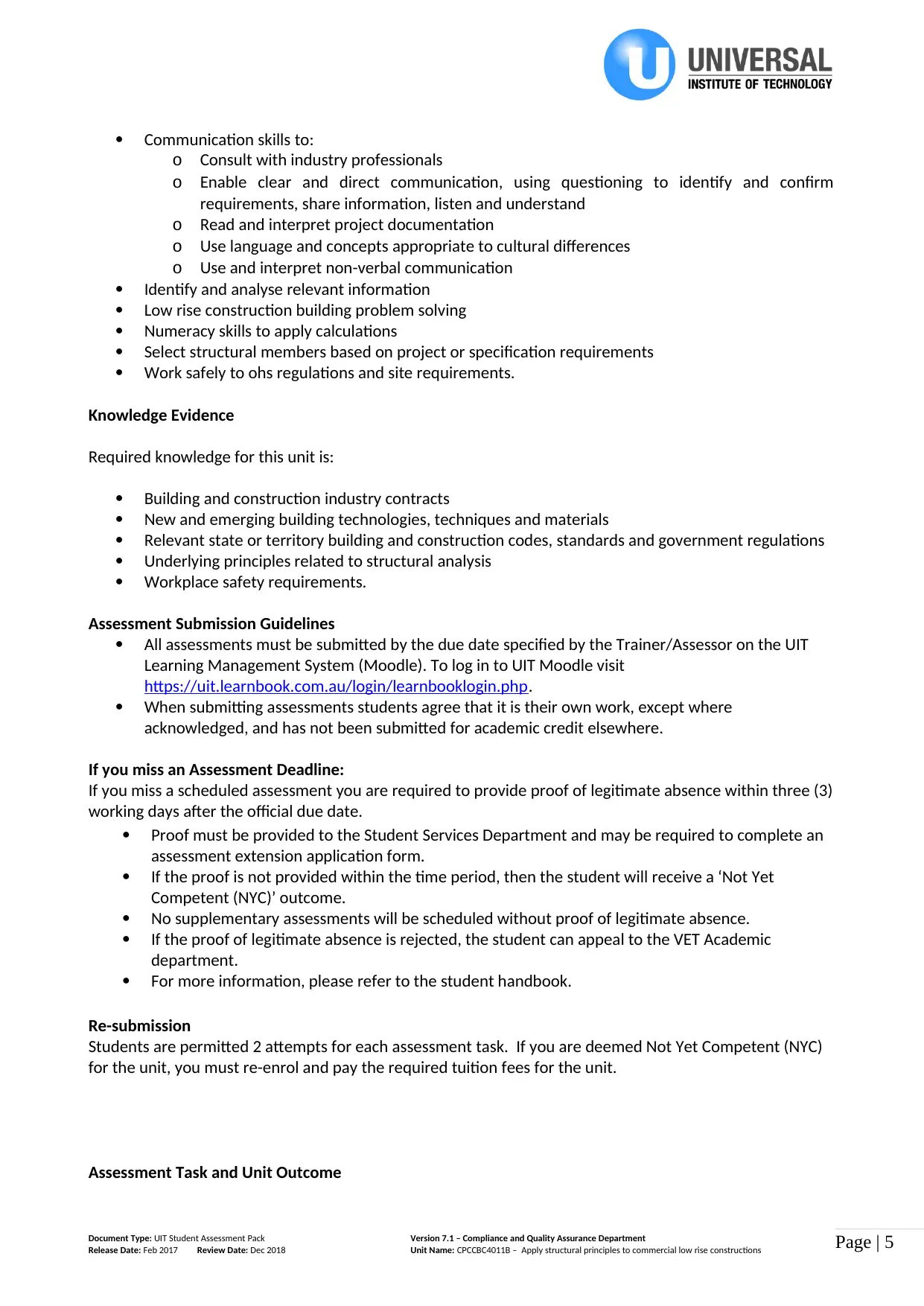
Page | 5
Communication skills to:
o Consult with industry professionals
o Enable clear and direct communication, using questioning to identify and confirm
requirements, share information, listen and understand
o Read and interpret project documentation
o Use language and concepts appropriate to cultural differences
o Use and interpret non-verbal communication
Identify and analyse relevant information
Low rise construction building problem solving
Numeracy skills to apply calculations
Select structural members based on project or specification requirements
Work safely to ohs regulations and site requirements.
Knowledge Evidence
Required knowledge for this unit is:
Building and construction industry contracts
New and emerging building technologies, techniques and materials
Relevant state or territory building and construction codes, standards and government regulations
Underlying principles related to structural analysis
Workplace safety requirements.
Assessment Submission Guidelines
All assessments must be submitted by the due date specified by the Trainer/Assessor on the UIT
Learning Management System (Moodle). To log in to UIT Moodle visit
https://uit.learnbook.com.au/login/learnbooklogin.php.
When submitting assessments students agree that it is their own work, except where
acknowledged, and has not been submitted for academic credit elsewhere.
If you miss an Assessment Deadline:
If you miss a scheduled assessment you are required to provide proof of legitimate absence within three (3)
working days after the official due date.
Proof must be provided to the Student Services Department and may be required to complete an
assessment extension application form.
If the proof is not provided within the time period, then the student will receive a ‘Not Yet
Competent (NYC)’ outcome.
No supplementary assessments will be scheduled without proof of legitimate absence.
If the proof of legitimate absence is rejected, the student can appeal to the VET Academic
department.
For more information, please refer to the student handbook.
Re-submission
Students are permitted 2 attempts for each assessment task. If you are deemed Not Yet Competent (NYC)
for the unit, you must re-enrol and pay the required tuition fees for the unit.
Assessment Task and Unit Outcome
Document Type: UIT Student Assessment Pack Version 7.1 – Compliance and Quality Assurance Department
Release Date: Feb 2017 Review Date: Dec 2018 Unit Name: CPCCBC4011B – Apply structural principles to commercial low rise constructions
Communication skills to:
o Consult with industry professionals
o Enable clear and direct communication, using questioning to identify and confirm
requirements, share information, listen and understand
o Read and interpret project documentation
o Use language and concepts appropriate to cultural differences
o Use and interpret non-verbal communication
Identify and analyse relevant information
Low rise construction building problem solving
Numeracy skills to apply calculations
Select structural members based on project or specification requirements
Work safely to ohs regulations and site requirements.
Knowledge Evidence
Required knowledge for this unit is:
Building and construction industry contracts
New and emerging building technologies, techniques and materials
Relevant state or territory building and construction codes, standards and government regulations
Underlying principles related to structural analysis
Workplace safety requirements.
Assessment Submission Guidelines
All assessments must be submitted by the due date specified by the Trainer/Assessor on the UIT
Learning Management System (Moodle). To log in to UIT Moodle visit
https://uit.learnbook.com.au/login/learnbooklogin.php.
When submitting assessments students agree that it is their own work, except where
acknowledged, and has not been submitted for academic credit elsewhere.
If you miss an Assessment Deadline:
If you miss a scheduled assessment you are required to provide proof of legitimate absence within three (3)
working days after the official due date.
Proof must be provided to the Student Services Department and may be required to complete an
assessment extension application form.
If the proof is not provided within the time period, then the student will receive a ‘Not Yet
Competent (NYC)’ outcome.
No supplementary assessments will be scheduled without proof of legitimate absence.
If the proof of legitimate absence is rejected, the student can appeal to the VET Academic
department.
For more information, please refer to the student handbook.
Re-submission
Students are permitted 2 attempts for each assessment task. If you are deemed Not Yet Competent (NYC)
for the unit, you must re-enrol and pay the required tuition fees for the unit.
Assessment Task and Unit Outcome
Document Type: UIT Student Assessment Pack Version 7.1 – Compliance and Quality Assurance Department
Release Date: Feb 2017 Review Date: Dec 2018 Unit Name: CPCCBC4011B – Apply structural principles to commercial low rise constructions
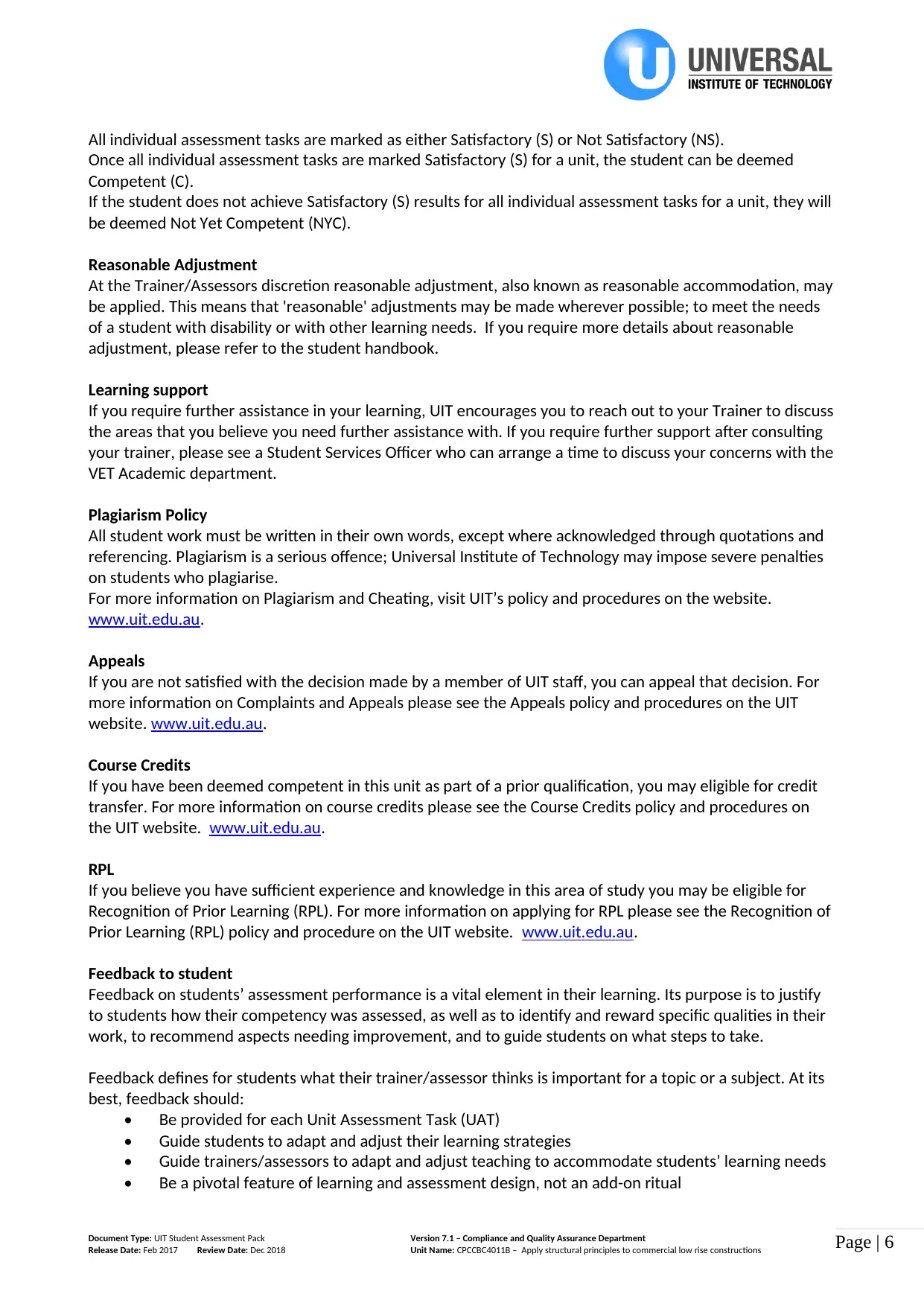
Page | 6
All individual assessment tasks are marked as either Satisfactory (S) or Not Satisfactory (NS).
Once all individual assessment tasks are marked Satisfactory (S) for a unit, the student can be deemed
Competent (C).
If the student does not achieve Satisfactory (S) results for all individual assessment tasks for a unit, they will
be deemed Not Yet Competent (NYC).
Reasonable Adjustment
At the Trainer/Assessors discretion reasonable adjustment, also known as reasonable accommodation, may
be applied. This means that 'reasonable' adjustments may be made wherever possible; to meet the needs
of a student with disability or with other learning needs. If you require more details about reasonable
adjustment, please refer to the student handbook.
Learning support
If you require further assistance in your learning, UIT encourages you to reach out to your Trainer to discuss
the areas that you believe you need further assistance with. If you require further support after consulting
your trainer, please see a Student Services Officer who can arrange a time to discuss your concerns with the
VET Academic department.
Plagiarism Policy
All student work must be written in their own words, except where acknowledged through quotations and
referencing. Plagiarism is a serious offence; Universal Institute of Technology may impose severe penalties
on students who plagiarise.
For more information on Plagiarism and Cheating, visit UIT’s policy and procedures on the website.
www.uit.edu.au.
Appeals
If you are not satisfied with the decision made by a member of UIT staff, you can appeal that decision. For
more information on Complaints and Appeals please see the Appeals policy and procedures on the UIT
website. www.uit.edu.au.
Course Credits
If you have been deemed competent in this unit as part of a prior qualification, you may eligible for credit
transfer. For more information on course credits please see the Course Credits policy and procedures on
the UIT website. www.uit.edu.au.
RPL
If you believe you have sufficient experience and knowledge in this area of study you may be eligible for
Recognition of Prior Learning (RPL). For more information on applying for RPL please see the Recognition of
Prior Learning (RPL) policy and procedure on the UIT website. www.uit.edu.au.
Feedback to student
Feedback on students’ assessment performance is a vital element in their learning. Its purpose is to justify
to students how their competency was assessed, as well as to identify and reward specific qualities in their
work, to recommend aspects needing improvement, and to guide students on what steps to take.
Feedback defines for students what their trainer/assessor thinks is important for a topic or a subject. At its
best, feedback should:
• Be provided for each Unit Assessment Task (UAT)
• Guide students to adapt and adjust their learning strategies
• Guide trainers/assessors to adapt and adjust teaching to accommodate students’ learning needs
• Be a pivotal feature of learning and assessment design, not an add-on ritual
Document Type: UIT Student Assessment Pack Version 7.1 – Compliance and Quality Assurance Department
Release Date: Feb 2017 Review Date: Dec 2018 Unit Name: CPCCBC4011B – Apply structural principles to commercial low rise constructions
All individual assessment tasks are marked as either Satisfactory (S) or Not Satisfactory (NS).
Once all individual assessment tasks are marked Satisfactory (S) for a unit, the student can be deemed
Competent (C).
If the student does not achieve Satisfactory (S) results for all individual assessment tasks for a unit, they will
be deemed Not Yet Competent (NYC).
Reasonable Adjustment
At the Trainer/Assessors discretion reasonable adjustment, also known as reasonable accommodation, may
be applied. This means that 'reasonable' adjustments may be made wherever possible; to meet the needs
of a student with disability or with other learning needs. If you require more details about reasonable
adjustment, please refer to the student handbook.
Learning support
If you require further assistance in your learning, UIT encourages you to reach out to your Trainer to discuss
the areas that you believe you need further assistance with. If you require further support after consulting
your trainer, please see a Student Services Officer who can arrange a time to discuss your concerns with the
VET Academic department.
Plagiarism Policy
All student work must be written in their own words, except where acknowledged through quotations and
referencing. Plagiarism is a serious offence; Universal Institute of Technology may impose severe penalties
on students who plagiarise.
For more information on Plagiarism and Cheating, visit UIT’s policy and procedures on the website.
www.uit.edu.au.
Appeals
If you are not satisfied with the decision made by a member of UIT staff, you can appeal that decision. For
more information on Complaints and Appeals please see the Appeals policy and procedures on the UIT
website. www.uit.edu.au.
Course Credits
If you have been deemed competent in this unit as part of a prior qualification, you may eligible for credit
transfer. For more information on course credits please see the Course Credits policy and procedures on
the UIT website. www.uit.edu.au.
RPL
If you believe you have sufficient experience and knowledge in this area of study you may be eligible for
Recognition of Prior Learning (RPL). For more information on applying for RPL please see the Recognition of
Prior Learning (RPL) policy and procedure on the UIT website. www.uit.edu.au.
Feedback to student
Feedback on students’ assessment performance is a vital element in their learning. Its purpose is to justify
to students how their competency was assessed, as well as to identify and reward specific qualities in their
work, to recommend aspects needing improvement, and to guide students on what steps to take.
Feedback defines for students what their trainer/assessor thinks is important for a topic or a subject. At its
best, feedback should:
• Be provided for each Unit Assessment Task (UAT)
• Guide students to adapt and adjust their learning strategies
• Guide trainers/assessors to adapt and adjust teaching to accommodate students’ learning needs
• Be a pivotal feature of learning and assessment design, not an add-on ritual
Document Type: UIT Student Assessment Pack Version 7.1 – Compliance and Quality Assurance Department
Release Date: Feb 2017 Review Date: Dec 2018 Unit Name: CPCCBC4011B – Apply structural principles to commercial low rise constructions
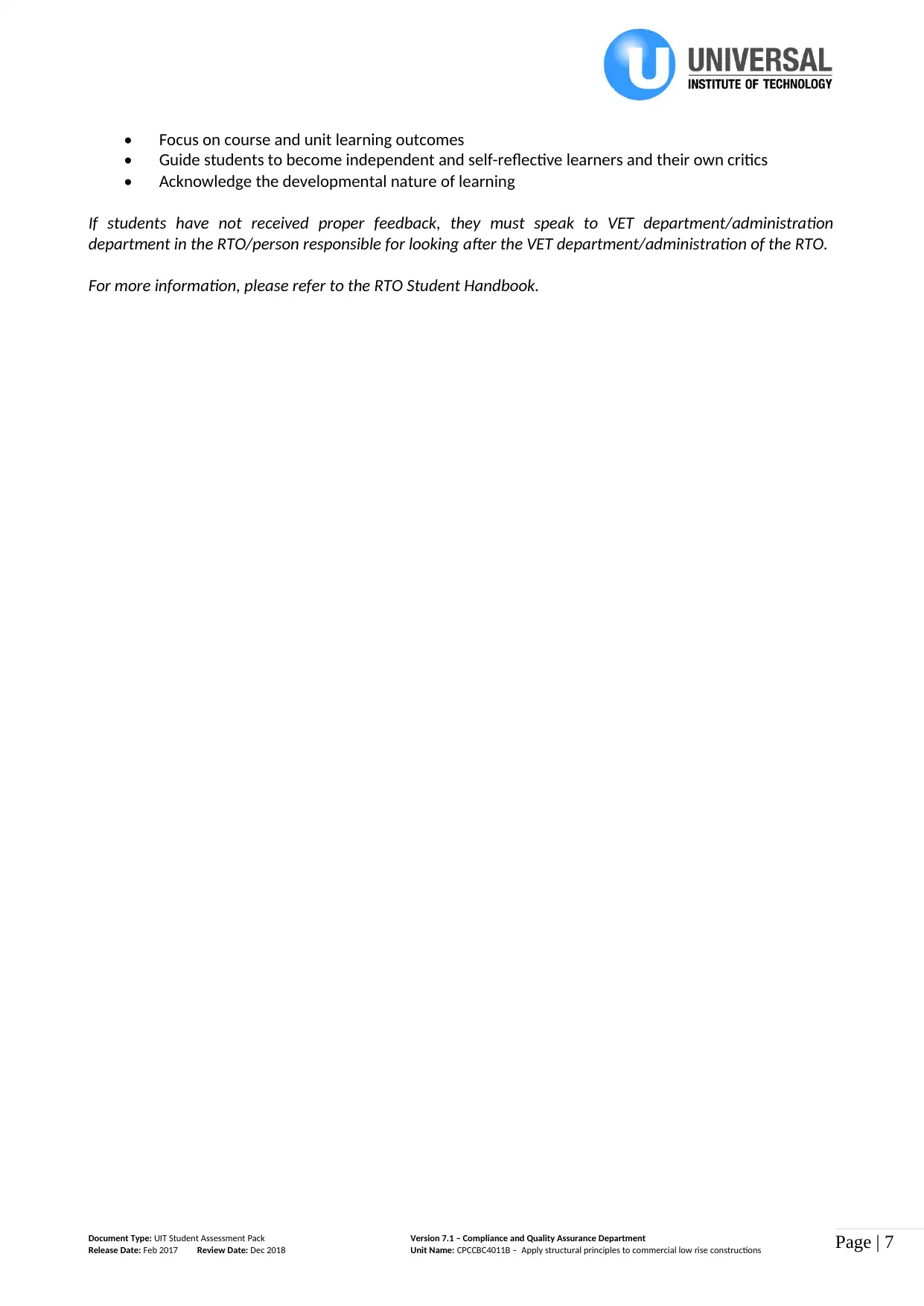
Page | 7
• Focus on course and unit learning outcomes
• Guide students to become independent and self-reflective learners and their own critics
• Acknowledge the developmental nature of learning
If students have not received proper feedback, they must speak to VET department/administration
department in the RTO/person responsible for looking after the VET department/administration of the RTO.
For more information, please refer to the RTO Student Handbook.
Document Type: UIT Student Assessment Pack Version 7.1 – Compliance and Quality Assurance Department
Release Date: Feb 2017 Review Date: Dec 2018 Unit Name: CPCCBC4011B – Apply structural principles to commercial low rise constructions
• Focus on course and unit learning outcomes
• Guide students to become independent and self-reflective learners and their own critics
• Acknowledge the developmental nature of learning
If students have not received proper feedback, they must speak to VET department/administration
department in the RTO/person responsible for looking after the VET department/administration of the RTO.
For more information, please refer to the RTO Student Handbook.
Document Type: UIT Student Assessment Pack Version 7.1 – Compliance and Quality Assurance Department
Release Date: Feb 2017 Review Date: Dec 2018 Unit Name: CPCCBC4011B – Apply structural principles to commercial low rise constructions
Paraphrase This Document
Need a fresh take? Get an instant paraphrase of this document with our AI Paraphraser
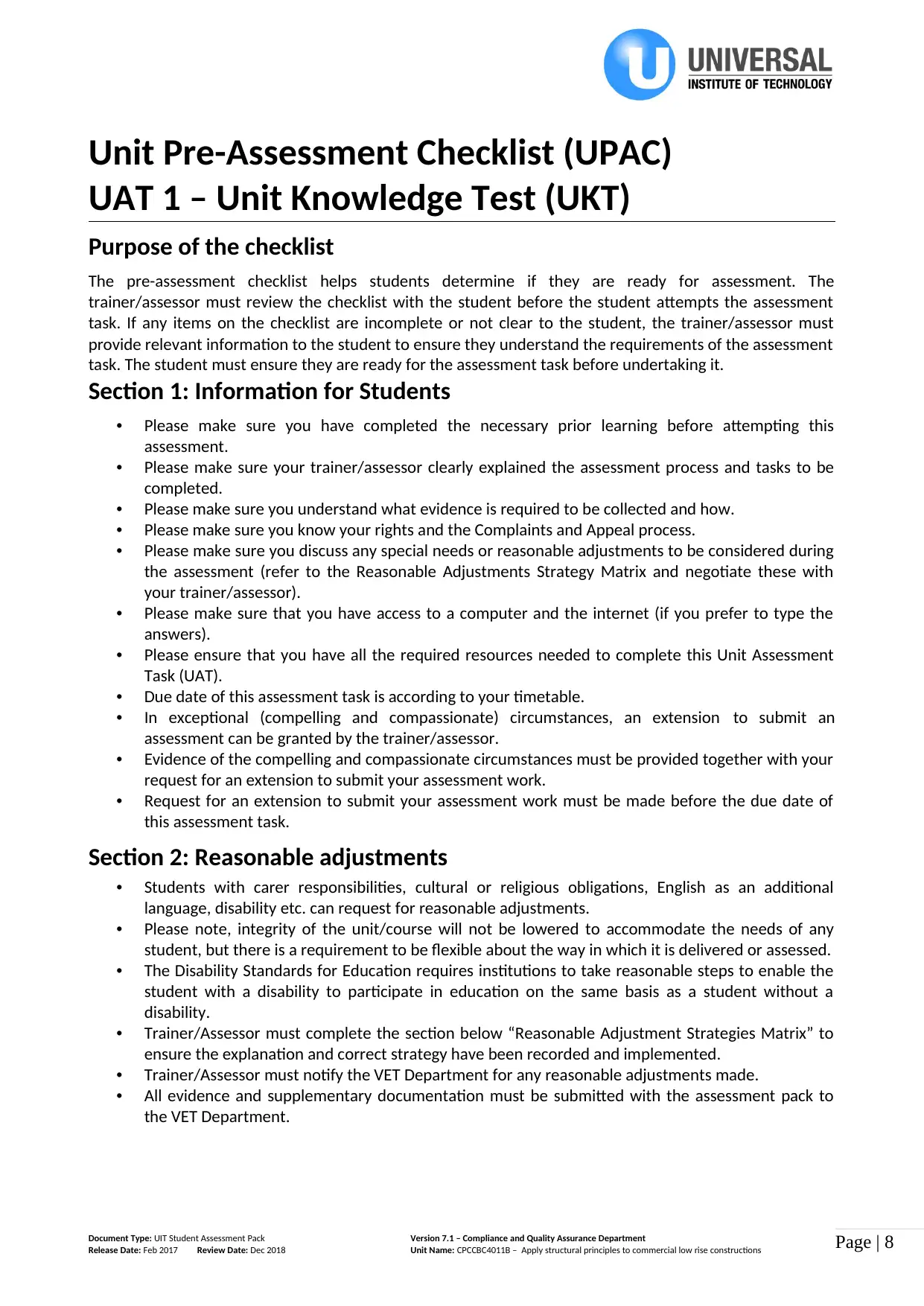
Page | 8
Unit Pre-Assessment Checklist (UPAC)
UAT 1 – Unit Knowledge Test (UKT)
Purpose of the checklist
The pre-assessment checklist helps students determine if they are ready for assessment. The
trainer/assessor must review the checklist with the student before the student attempts the assessment
task. If any items on the checklist are incomplete or not clear to the student, the trainer/assessor must
provide relevant information to the student to ensure they understand the requirements of the assessment
task. The student must ensure they are ready for the assessment task before undertaking it.
Section 1: Information for Students
• Please make sure you have completed the necessary prior learning before attempting this
assessment.
• Please make sure your trainer/assessor clearly explained the assessment process and tasks to be
completed.
• Please make sure you understand what evidence is required to be collected and how.
• Please make sure you know your rights and the Complaints and Appeal process.
• Please make sure you discuss any special needs or reasonable adjustments to be considered during
the assessment (refer to the Reasonable Adjustments Strategy Matrix and negotiate these with
your trainer/assessor).
• Please make sure that you have access to a computer and the internet (if you prefer to type the
answers).
• Please ensure that you have all the required resources needed to complete this Unit Assessment
Task (UAT).
• Due date of this assessment task is according to your timetable.
• In exceptional (compelling and compassionate) circumstances, an extension to submit an
assessment can be granted by the trainer/assessor.
• Evidence of the compelling and compassionate circumstances must be provided together with your
request for an extension to submit your assessment work.
• Request for an extension to submit your assessment work must be made before the due date of
this assessment task.
Section 2: Reasonable adjustments
• Students with carer responsibilities, cultural or religious obligations, English as an additional
language, disability etc. can request for reasonable adjustments.
• Please note, integrity of the unit/course will not be lowered to accommodate the needs of any
student, but there is a requirement to be flexible about the way in which it is delivered or assessed.
• The Disability Standards for Education requires institutions to take reasonable steps to enable the
student with a disability to participate in education on the same basis as a student without a
disability.
• Trainer/Assessor must complete the section below “Reasonable Adjustment Strategies Matrix” to
ensure the explanation and correct strategy have been recorded and implemented.
• Trainer/Assessor must notify the VET Department for any reasonable adjustments made.
• All evidence and supplementary documentation must be submitted with the assessment pack to
the VET Department.
Document Type: UIT Student Assessment Pack Version 7.1 – Compliance and Quality Assurance Department
Release Date: Feb 2017 Review Date: Dec 2018 Unit Name: CPCCBC4011B – Apply structural principles to commercial low rise constructions
Unit Pre-Assessment Checklist (UPAC)
UAT 1 – Unit Knowledge Test (UKT)
Purpose of the checklist
The pre-assessment checklist helps students determine if they are ready for assessment. The
trainer/assessor must review the checklist with the student before the student attempts the assessment
task. If any items on the checklist are incomplete or not clear to the student, the trainer/assessor must
provide relevant information to the student to ensure they understand the requirements of the assessment
task. The student must ensure they are ready for the assessment task before undertaking it.
Section 1: Information for Students
• Please make sure you have completed the necessary prior learning before attempting this
assessment.
• Please make sure your trainer/assessor clearly explained the assessment process and tasks to be
completed.
• Please make sure you understand what evidence is required to be collected and how.
• Please make sure you know your rights and the Complaints and Appeal process.
• Please make sure you discuss any special needs or reasonable adjustments to be considered during
the assessment (refer to the Reasonable Adjustments Strategy Matrix and negotiate these with
your trainer/assessor).
• Please make sure that you have access to a computer and the internet (if you prefer to type the
answers).
• Please ensure that you have all the required resources needed to complete this Unit Assessment
Task (UAT).
• Due date of this assessment task is according to your timetable.
• In exceptional (compelling and compassionate) circumstances, an extension to submit an
assessment can be granted by the trainer/assessor.
• Evidence of the compelling and compassionate circumstances must be provided together with your
request for an extension to submit your assessment work.
• Request for an extension to submit your assessment work must be made before the due date of
this assessment task.
Section 2: Reasonable adjustments
• Students with carer responsibilities, cultural or religious obligations, English as an additional
language, disability etc. can request for reasonable adjustments.
• Please note, integrity of the unit/course will not be lowered to accommodate the needs of any
student, but there is a requirement to be flexible about the way in which it is delivered or assessed.
• The Disability Standards for Education requires institutions to take reasonable steps to enable the
student with a disability to participate in education on the same basis as a student without a
disability.
• Trainer/Assessor must complete the section below “Reasonable Adjustment Strategies Matrix” to
ensure the explanation and correct strategy have been recorded and implemented.
• Trainer/Assessor must notify the VET Department for any reasonable adjustments made.
• All evidence and supplementary documentation must be submitted with the assessment pack to
the VET Department.
Document Type: UIT Student Assessment Pack Version 7.1 – Compliance and Quality Assurance Department
Release Date: Feb 2017 Review Date: Dec 2018 Unit Name: CPCCBC4011B – Apply structural principles to commercial low rise constructions
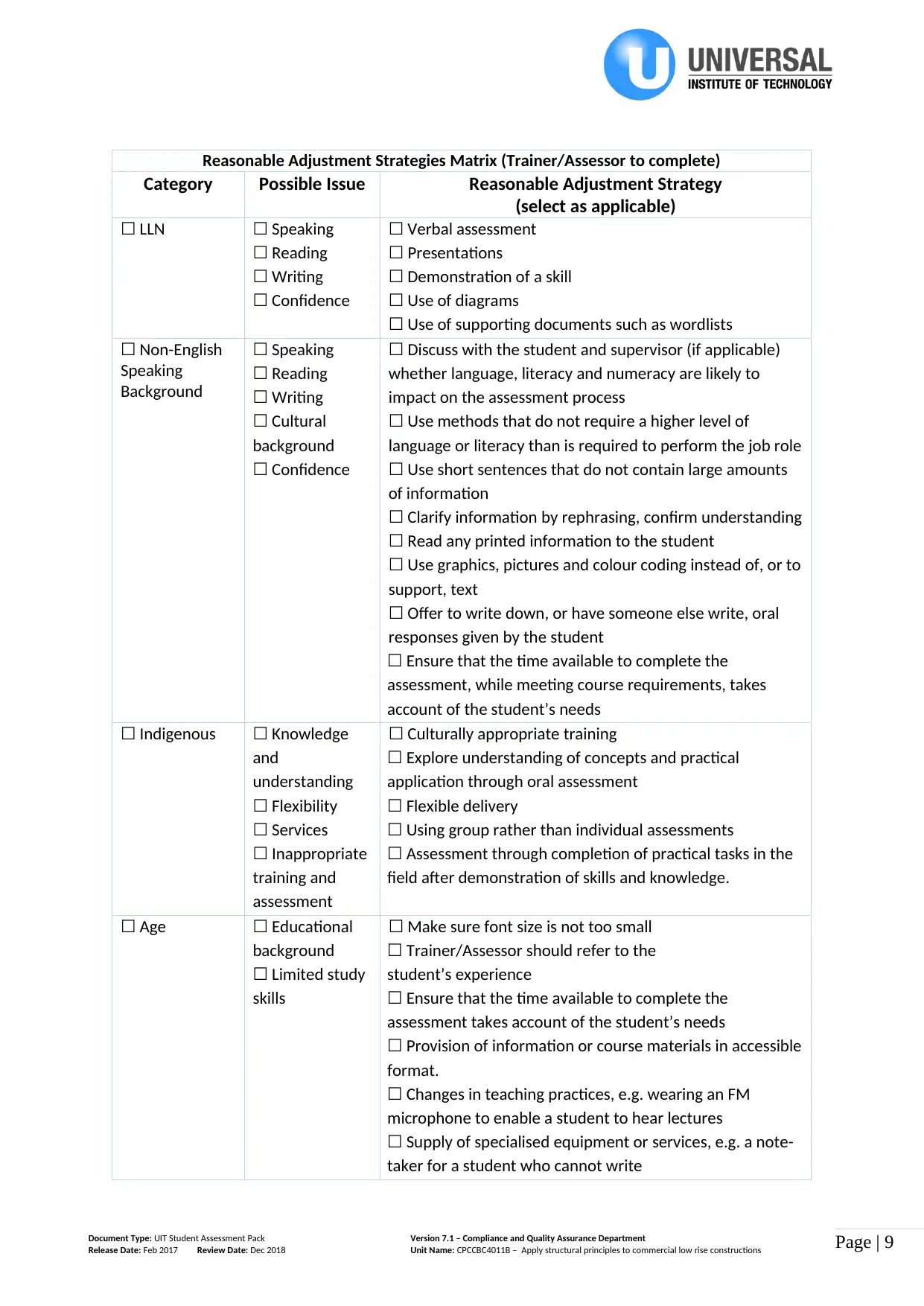
Page | 9
Reasonable Adjustment Strategies Matrix (Trainer/Assessor to complete)
Category Possible Issue Reasonable Adjustment Strategy
(select as applicable)
☐ LLN ☐ Speaking
☐ Reading
☐ Writing
☐ Confidence
☐ Verbal assessment
☐ Presentations
☐ Demonstration of a skill
☐ Use of diagrams
☐ Use of supporting documents such as wordlists
☐ Non-English
Speaking
Background
☐ Speaking
☐ Reading
☐ Writing
☐ Cultural
background
☐ Confidence
☐ Discuss with the student and supervisor (if applicable)
whether language, literacy and numeracy are likely to
impact on the assessment process
☐ Use methods that do not require a higher level of
language or literacy than is required to perform the job role
☐ Use short sentences that do not contain large amounts
of information
☐ Clarify information by rephrasing, confirm understanding
☐ Read any printed information to the student
☐ Use graphics, pictures and colour coding instead of, or to
support, text
☐ Offer to write down, or have someone else write, oral
responses given by the student
☐ Ensure that the time available to complete the
assessment, while meeting course requirements, takes
account of the student’s needs
☐ Indigenous ☐ Knowledge
and
understanding
☐ Flexibility
☐ Services
☐ Inappropriate
training and
assessment
☐ Culturally appropriate training
☐ Explore understanding of concepts and practical
application through oral assessment
☐ Flexible delivery
☐ Using group rather than individual assessments
☐ Assessment through completion of practical tasks in the
field after demonstration of skills and knowledge.
☐ Age ☐ Educational
background
☐ Limited study
skills
☐ Make sure font size is not too small
☐ Trainer/Assessor should refer to the
student’s experience
☐ Ensure that the time available to complete the
assessment takes account of the student’s needs
☐ Provision of information or course materials in accessible
format.
☐ Changes in teaching practices, e.g. wearing an FM
microphone to enable a student to hear lectures
☐ Supply of specialised equipment or services, e.g. a note-
taker for a student who cannot write
Document Type: UIT Student Assessment Pack Version 7.1 – Compliance and Quality Assurance Department
Release Date: Feb 2017 Review Date: Dec 2018 Unit Name: CPCCBC4011B – Apply structural principles to commercial low rise constructions
Reasonable Adjustment Strategies Matrix (Trainer/Assessor to complete)
Category Possible Issue Reasonable Adjustment Strategy
(select as applicable)
☐ LLN ☐ Speaking
☐ Reading
☐ Writing
☐ Confidence
☐ Verbal assessment
☐ Presentations
☐ Demonstration of a skill
☐ Use of diagrams
☐ Use of supporting documents such as wordlists
☐ Non-English
Speaking
Background
☐ Speaking
☐ Reading
☐ Writing
☐ Cultural
background
☐ Confidence
☐ Discuss with the student and supervisor (if applicable)
whether language, literacy and numeracy are likely to
impact on the assessment process
☐ Use methods that do not require a higher level of
language or literacy than is required to perform the job role
☐ Use short sentences that do not contain large amounts
of information
☐ Clarify information by rephrasing, confirm understanding
☐ Read any printed information to the student
☐ Use graphics, pictures and colour coding instead of, or to
support, text
☐ Offer to write down, or have someone else write, oral
responses given by the student
☐ Ensure that the time available to complete the
assessment, while meeting course requirements, takes
account of the student’s needs
☐ Indigenous ☐ Knowledge
and
understanding
☐ Flexibility
☐ Services
☐ Inappropriate
training and
assessment
☐ Culturally appropriate training
☐ Explore understanding of concepts and practical
application through oral assessment
☐ Flexible delivery
☐ Using group rather than individual assessments
☐ Assessment through completion of practical tasks in the
field after demonstration of skills and knowledge.
☐ Age ☐ Educational
background
☐ Limited study
skills
☐ Make sure font size is not too small
☐ Trainer/Assessor should refer to the
student’s experience
☐ Ensure that the time available to complete the
assessment takes account of the student’s needs
☐ Provision of information or course materials in accessible
format.
☐ Changes in teaching practices, e.g. wearing an FM
microphone to enable a student to hear lectures
☐ Supply of specialised equipment or services, e.g. a note-
taker for a student who cannot write
Document Type: UIT Student Assessment Pack Version 7.1 – Compliance and Quality Assurance Department
Release Date: Feb 2017 Review Date: Dec 2018 Unit Name: CPCCBC4011B – Apply structural principles to commercial low rise constructions
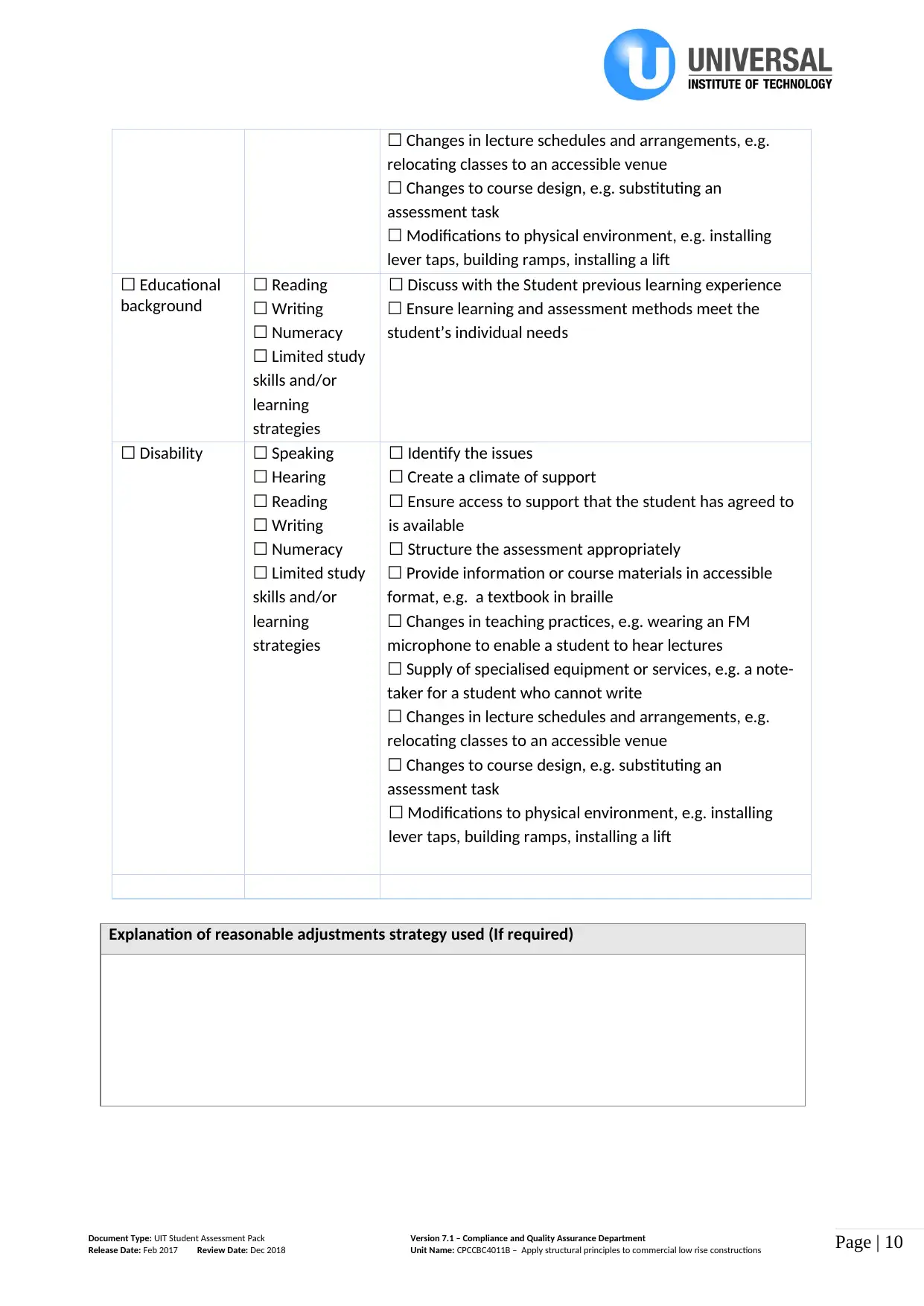
Page | 10
☐ Changes in lecture schedules and arrangements, e.g.
relocating classes to an accessible venue
☐ Changes to course design, e.g. substituting an
assessment task
☐ Modifications to physical environment, e.g. installing
lever taps, building ramps, installing a lift
☐ Educational
background
☐ Reading
☐ Writing
☐ Numeracy
☐ Limited study
skills and/or
learning
strategies
☐ Discuss with the Student previous learning experience
☐ Ensure learning and assessment methods meet the
student’s individual needs
☐ Disability ☐ Speaking
☐ Hearing
☐ Reading
☐ Writing
☐ Numeracy
☐ Limited study
skills and/or
learning
strategies
☐ Identify the issues
☐ Create a climate of support
☐ Ensure access to support that the student has agreed to
is available
☐ Structure the assessment appropriately
☐ Provide information or course materials in accessible
format, e.g. a textbook in braille
☐ Changes in teaching practices, e.g. wearing an FM
microphone to enable a student to hear lectures
☐ Supply of specialised equipment or services, e.g. a note-
taker for a student who cannot write
☐ Changes in lecture schedules and arrangements, e.g.
relocating classes to an accessible venue
☐ Changes to course design, e.g. substituting an
assessment task
☐ Modifications to physical environment, e.g. installing
lever taps, building ramps, installing a lift
Explanation of reasonable adjustments strategy used (If required)
Document Type: UIT Student Assessment Pack Version 7.1 – Compliance and Quality Assurance Department
Release Date: Feb 2017 Review Date: Dec 2018 Unit Name: CPCCBC4011B – Apply structural principles to commercial low rise constructions
☐ Changes in lecture schedules and arrangements, e.g.
relocating classes to an accessible venue
☐ Changes to course design, e.g. substituting an
assessment task
☐ Modifications to physical environment, e.g. installing
lever taps, building ramps, installing a lift
☐ Educational
background
☐ Reading
☐ Writing
☐ Numeracy
☐ Limited study
skills and/or
learning
strategies
☐ Discuss with the Student previous learning experience
☐ Ensure learning and assessment methods meet the
student’s individual needs
☐ Disability ☐ Speaking
☐ Hearing
☐ Reading
☐ Writing
☐ Numeracy
☐ Limited study
skills and/or
learning
strategies
☐ Identify the issues
☐ Create a climate of support
☐ Ensure access to support that the student has agreed to
is available
☐ Structure the assessment appropriately
☐ Provide information or course materials in accessible
format, e.g. a textbook in braille
☐ Changes in teaching practices, e.g. wearing an FM
microphone to enable a student to hear lectures
☐ Supply of specialised equipment or services, e.g. a note-
taker for a student who cannot write
☐ Changes in lecture schedules and arrangements, e.g.
relocating classes to an accessible venue
☐ Changes to course design, e.g. substituting an
assessment task
☐ Modifications to physical environment, e.g. installing
lever taps, building ramps, installing a lift
Explanation of reasonable adjustments strategy used (If required)
Document Type: UIT Student Assessment Pack Version 7.1 – Compliance and Quality Assurance Department
Release Date: Feb 2017 Review Date: Dec 2018 Unit Name: CPCCBC4011B – Apply structural principles to commercial low rise constructions
Secure Best Marks with AI Grader
Need help grading? Try our AI Grader for instant feedback on your assignments.
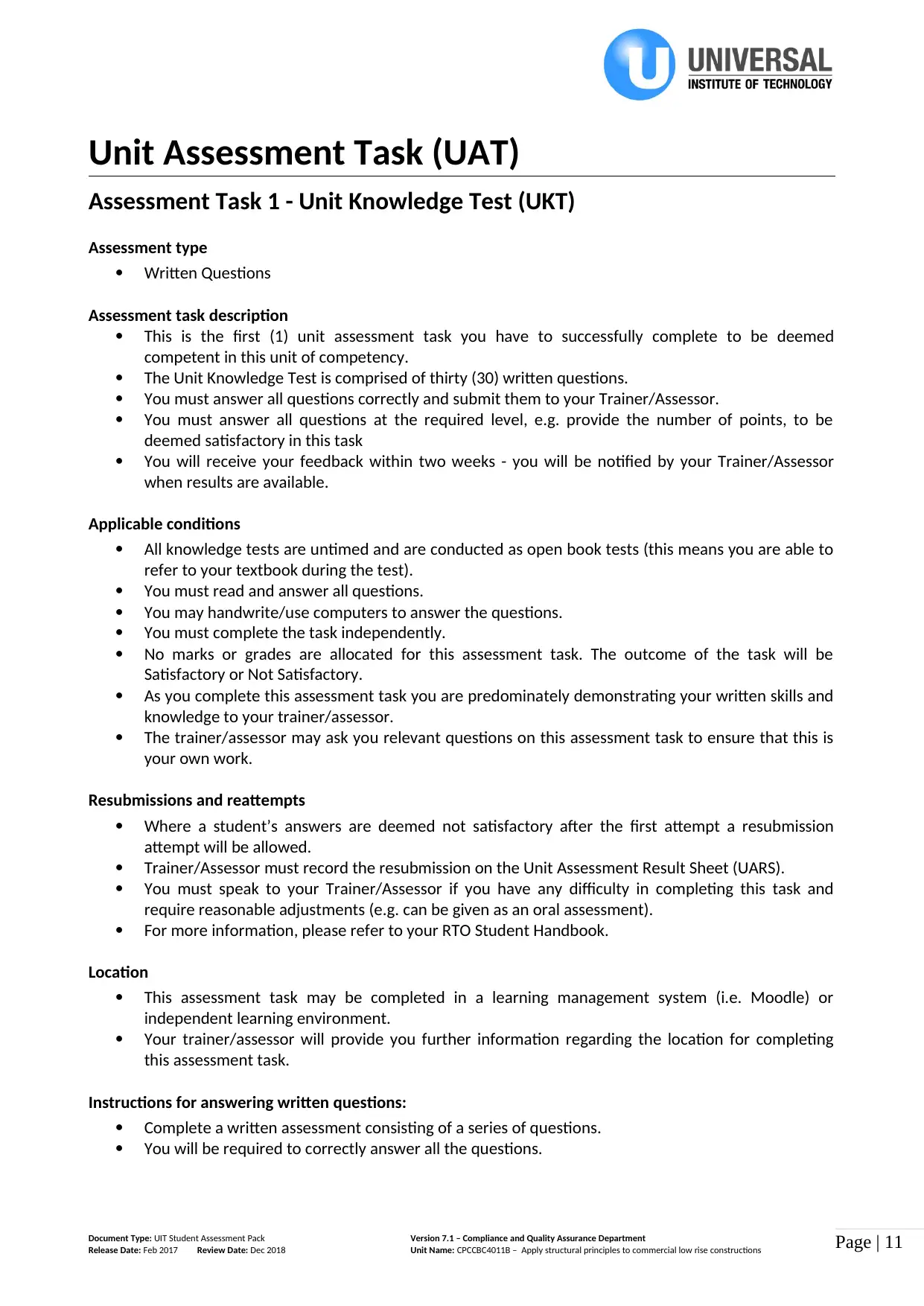
Page | 11
Unit Assessment Task (UAT)
Assessment Task 1 - Unit Knowledge Test (UKT)
Assessment type
Written Questions
Assessment task description
This is the first (1) unit assessment task you have to successfully complete to be deemed
competent in this unit of competency.
The Unit Knowledge Test is comprised of thirty (30) written questions.
You must answer all questions correctly and submit them to your Trainer/Assessor.
You must answer all questions at the required level, e.g. provide the number of points, to be
deemed satisfactory in this task
You will receive your feedback within two weeks - you will be notified by your Trainer/Assessor
when results are available.
Applicable conditions
All knowledge tests are untimed and are conducted as open book tests (this means you are able to
refer to your textbook during the test).
You must read and answer all questions.
You may handwrite/use computers to answer the questions.
You must complete the task independently.
No marks or grades are allocated for this assessment task. The outcome of the task will be
Satisfactory or Not Satisfactory.
As you complete this assessment task you are predominately demonstrating your written skills and
knowledge to your trainer/assessor.
The trainer/assessor may ask you relevant questions on this assessment task to ensure that this is
your own work.
Resubmissions and reattempts
Where a student’s answers are deemed not satisfactory after the first attempt a resubmission
attempt will be allowed.
Trainer/Assessor must record the resubmission on the Unit Assessment Result Sheet (UARS).
You must speak to your Trainer/Assessor if you have any difficulty in completing this task and
require reasonable adjustments (e.g. can be given as an oral assessment).
For more information, please refer to your RTO Student Handbook.
Location
This assessment task may be completed in a learning management system (i.e. Moodle) or
independent learning environment.
Your trainer/assessor will provide you further information regarding the location for completing
this assessment task.
Instructions for answering written questions:
Complete a written assessment consisting of a series of questions.
You will be required to correctly answer all the questions.
Document Type: UIT Student Assessment Pack Version 7.1 – Compliance and Quality Assurance Department
Release Date: Feb 2017 Review Date: Dec 2018 Unit Name: CPCCBC4011B – Apply structural principles to commercial low rise constructions
Unit Assessment Task (UAT)
Assessment Task 1 - Unit Knowledge Test (UKT)
Assessment type
Written Questions
Assessment task description
This is the first (1) unit assessment task you have to successfully complete to be deemed
competent in this unit of competency.
The Unit Knowledge Test is comprised of thirty (30) written questions.
You must answer all questions correctly and submit them to your Trainer/Assessor.
You must answer all questions at the required level, e.g. provide the number of points, to be
deemed satisfactory in this task
You will receive your feedback within two weeks - you will be notified by your Trainer/Assessor
when results are available.
Applicable conditions
All knowledge tests are untimed and are conducted as open book tests (this means you are able to
refer to your textbook during the test).
You must read and answer all questions.
You may handwrite/use computers to answer the questions.
You must complete the task independently.
No marks or grades are allocated for this assessment task. The outcome of the task will be
Satisfactory or Not Satisfactory.
As you complete this assessment task you are predominately demonstrating your written skills and
knowledge to your trainer/assessor.
The trainer/assessor may ask you relevant questions on this assessment task to ensure that this is
your own work.
Resubmissions and reattempts
Where a student’s answers are deemed not satisfactory after the first attempt a resubmission
attempt will be allowed.
Trainer/Assessor must record the resubmission on the Unit Assessment Result Sheet (UARS).
You must speak to your Trainer/Assessor if you have any difficulty in completing this task and
require reasonable adjustments (e.g. can be given as an oral assessment).
For more information, please refer to your RTO Student Handbook.
Location
This assessment task may be completed in a learning management system (i.e. Moodle) or
independent learning environment.
Your trainer/assessor will provide you further information regarding the location for completing
this assessment task.
Instructions for answering written questions:
Complete a written assessment consisting of a series of questions.
You will be required to correctly answer all the questions.
Document Type: UIT Student Assessment Pack Version 7.1 – Compliance and Quality Assurance Department
Release Date: Feb 2017 Review Date: Dec 2018 Unit Name: CPCCBC4011B – Apply structural principles to commercial low rise constructions

Page | 12
Do not start answering questions without understanding what is required from you. Read the
questions carefully and critically analyse them for a few seconds, this will help you to identify what
is really needed.
Your answers must demonstrate an understanding and application of relevant concepts, critical
thinking, and good writing skills.
Be concise to the point and write answers according to the given word-limit to each question and
do not provide irrelevant information. Be careful, quantity is not quality.
Be careful to use non-discriminatory language. The language used should not devalue, demean, or
exclude individuals or groups on the basis of attributes such as gender, disability, culture, race,
religion, sexual preference or age. Gender inclusive language should be used.
When you quote, paraphrase, summarise or copy information from the sources you are using to
write your answers/research your work, you must always acknowledge the source.
How your trainer/assessor will assess your work?
This assessment task requires the student to answer all the questions.
Answers must demonstrate the student’s understanding and knowledge of the unit.
If all assessment tasks are deemed Satisfactory (S), then the unit outcome is Competent (C).
If at least one of the assessment task is deemed Not Satisfactory (NS), then the unit outcome is Not
Yet Competent (NYC).
Once all assessment tasks allocated to this Unit of Competency have been undertaken,
trainer/assessor will complete an Assessment Details and Results Sheet to record the unit outcome.
The outcome will be either Competent (C) or Not Yet Competent (NYC).
The “Assessment Plan” is available with the Unit Assessment Pack (UAP) – Cover Sheet.
Purpose of the assessment
This assessment task is designed to evaluate your Knowledge for the following:
Knowledge to apply structural principles in erection or demolition of low-rise commercial building.
Knowledge of various construction materials and the related construction methods.
Knowledge of the performance characteristics of structural members – such as beams, columns,
slabs and retaining walls.
Knowledge of safe work practices, legislative and environmental requirements for demolition of an
existing structure.
Knowledge about various industry professionals whom a builder has to deal with during
construction works.
Knowledge of various project documents – plans, working drawings, specification etc used during
construction.
Knowledge of BCA requirements for special category of constructions that involve - bushfire, high
wind, earthquake and alpine environments.
Knowledge to plan, coordinate and manage laying of footing systems – including assessment for
structural integrity and compliance with relevant codes and industry principles.
Knowledge to plan, coordinate and manage laying of structural floor systems – including
assessment for structural integrity and compliance with relevant codes and industry principles.
Knowledge to plan, coordinate and manage laying of wall and wall cladding systems – including
assessment for structural integrity and compliance with relevant codes and industry principles.
Knowledge to plan, coordinate and manage laying of roof and roof cladding systems – including
assessment for structural integrity and compliance with relevant codes and industry principles.
Knowledge of some new and emerging construction technologies and materials. Ways to know
about these new technologies.
Knowledge about safety requirements to work on a construction site.
Document Type: UIT Student Assessment Pack Version 7.1 – Compliance and Quality Assurance Department
Release Date: Feb 2017 Review Date: Dec 2018 Unit Name: CPCCBC4011B – Apply structural principles to commercial low rise constructions
Do not start answering questions without understanding what is required from you. Read the
questions carefully and critically analyse them for a few seconds, this will help you to identify what
is really needed.
Your answers must demonstrate an understanding and application of relevant concepts, critical
thinking, and good writing skills.
Be concise to the point and write answers according to the given word-limit to each question and
do not provide irrelevant information. Be careful, quantity is not quality.
Be careful to use non-discriminatory language. The language used should not devalue, demean, or
exclude individuals or groups on the basis of attributes such as gender, disability, culture, race,
religion, sexual preference or age. Gender inclusive language should be used.
When you quote, paraphrase, summarise or copy information from the sources you are using to
write your answers/research your work, you must always acknowledge the source.
How your trainer/assessor will assess your work?
This assessment task requires the student to answer all the questions.
Answers must demonstrate the student’s understanding and knowledge of the unit.
If all assessment tasks are deemed Satisfactory (S), then the unit outcome is Competent (C).
If at least one of the assessment task is deemed Not Satisfactory (NS), then the unit outcome is Not
Yet Competent (NYC).
Once all assessment tasks allocated to this Unit of Competency have been undertaken,
trainer/assessor will complete an Assessment Details and Results Sheet to record the unit outcome.
The outcome will be either Competent (C) or Not Yet Competent (NYC).
The “Assessment Plan” is available with the Unit Assessment Pack (UAP) – Cover Sheet.
Purpose of the assessment
This assessment task is designed to evaluate your Knowledge for the following:
Knowledge to apply structural principles in erection or demolition of low-rise commercial building.
Knowledge of various construction materials and the related construction methods.
Knowledge of the performance characteristics of structural members – such as beams, columns,
slabs and retaining walls.
Knowledge of safe work practices, legislative and environmental requirements for demolition of an
existing structure.
Knowledge about various industry professionals whom a builder has to deal with during
construction works.
Knowledge of various project documents – plans, working drawings, specification etc used during
construction.
Knowledge of BCA requirements for special category of constructions that involve - bushfire, high
wind, earthquake and alpine environments.
Knowledge to plan, coordinate and manage laying of footing systems – including assessment for
structural integrity and compliance with relevant codes and industry principles.
Knowledge to plan, coordinate and manage laying of structural floor systems – including
assessment for structural integrity and compliance with relevant codes and industry principles.
Knowledge to plan, coordinate and manage laying of wall and wall cladding systems – including
assessment for structural integrity and compliance with relevant codes and industry principles.
Knowledge to plan, coordinate and manage laying of roof and roof cladding systems – including
assessment for structural integrity and compliance with relevant codes and industry principles.
Knowledge of some new and emerging construction technologies and materials. Ways to know
about these new technologies.
Knowledge about safety requirements to work on a construction site.
Document Type: UIT Student Assessment Pack Version 7.1 – Compliance and Quality Assurance Department
Release Date: Feb 2017 Review Date: Dec 2018 Unit Name: CPCCBC4011B – Apply structural principles to commercial low rise constructions
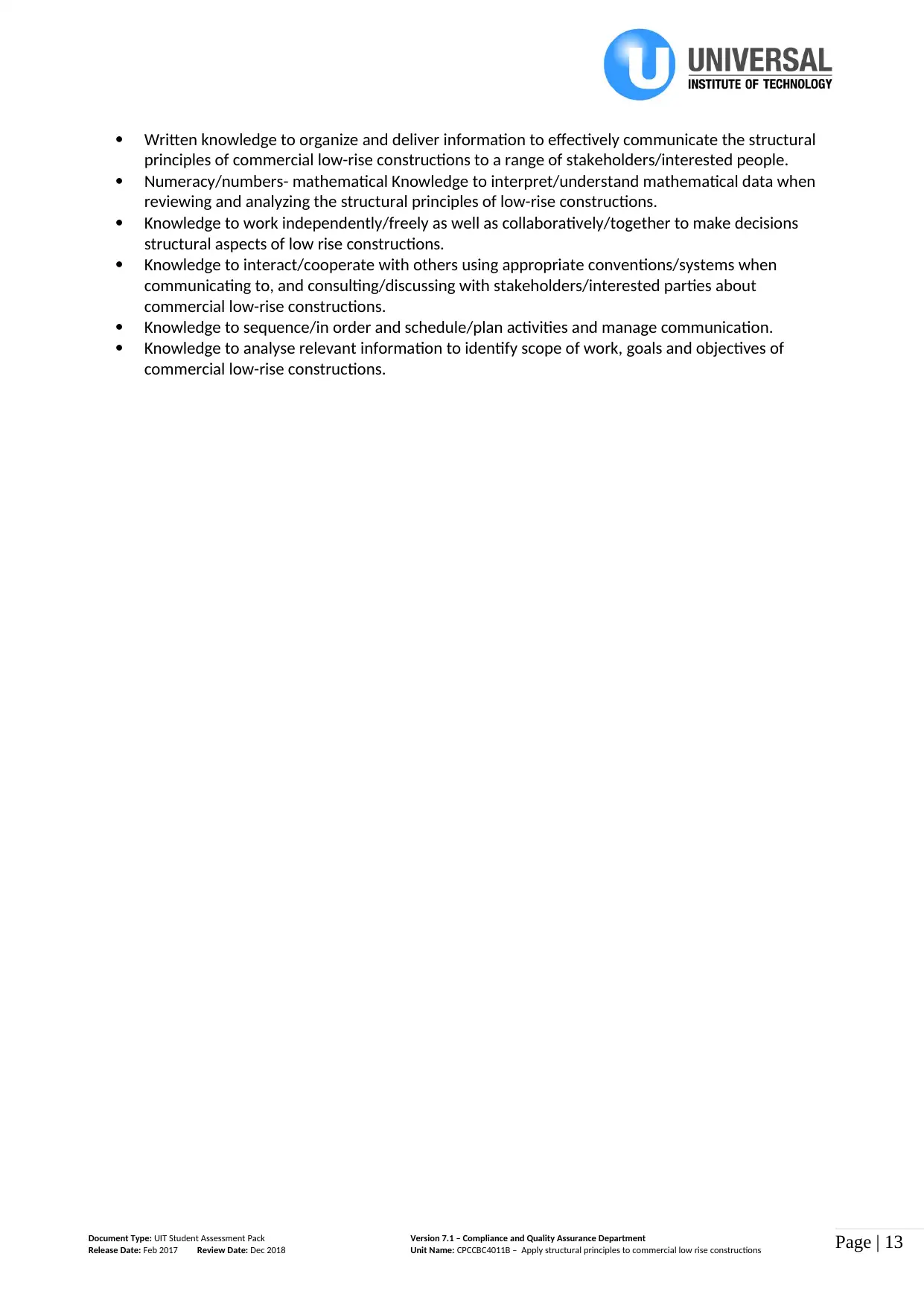
Page | 13
Written knowledge to organize and deliver information to effectively communicate the structural
principles of commercial low-rise constructions to a range of stakeholders/interested people.
Numeracy/numbers- mathematical Knowledge to interpret/understand mathematical data when
reviewing and analyzing the structural principles of low-rise constructions.
Knowledge to work independently/freely as well as collaboratively/together to make decisions
structural aspects of low rise constructions.
Knowledge to interact/cooperate with others using appropriate conventions/systems when
communicating to, and consulting/discussing with stakeholders/interested parties about
commercial low-rise constructions.
Knowledge to sequence/in order and schedule/plan activities and manage communication.
Knowledge to analyse relevant information to identify scope of work, goals and objectives of
commercial low-rise constructions.
Document Type: UIT Student Assessment Pack Version 7.1 – Compliance and Quality Assurance Department
Release Date: Feb 2017 Review Date: Dec 2018 Unit Name: CPCCBC4011B – Apply structural principles to commercial low rise constructions
Written knowledge to organize and deliver information to effectively communicate the structural
principles of commercial low-rise constructions to a range of stakeholders/interested people.
Numeracy/numbers- mathematical Knowledge to interpret/understand mathematical data when
reviewing and analyzing the structural principles of low-rise constructions.
Knowledge to work independently/freely as well as collaboratively/together to make decisions
structural aspects of low rise constructions.
Knowledge to interact/cooperate with others using appropriate conventions/systems when
communicating to, and consulting/discussing with stakeholders/interested parties about
commercial low-rise constructions.
Knowledge to sequence/in order and schedule/plan activities and manage communication.
Knowledge to analyse relevant information to identify scope of work, goals and objectives of
commercial low-rise constructions.
Document Type: UIT Student Assessment Pack Version 7.1 – Compliance and Quality Assurance Department
Release Date: Feb 2017 Review Date: Dec 2018 Unit Name: CPCCBC4011B – Apply structural principles to commercial low rise constructions
Paraphrase This Document
Need a fresh take? Get an instant paraphrase of this document with our AI Paraphraser
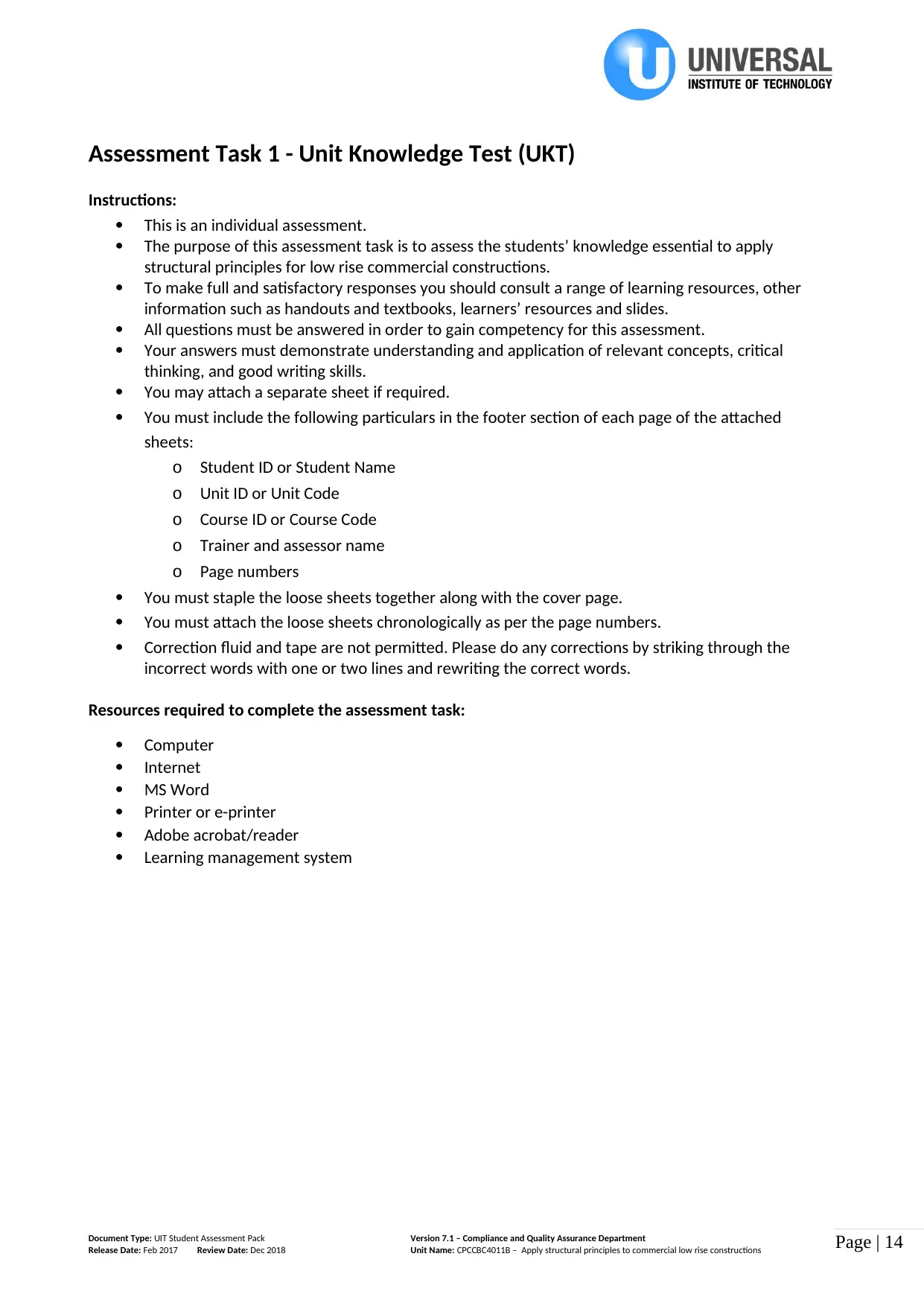
Page | 14
Assessment Task 1 - Unit Knowledge Test (UKT)
Instructions:
This is an individual assessment.
The purpose of this assessment task is to assess the students’ knowledge essential to apply
structural principles for low rise commercial constructions.
To make full and satisfactory responses you should consult a range of learning resources, other
information such as handouts and textbooks, learners’ resources and slides.
All questions must be answered in order to gain competency for this assessment.
Your answers must demonstrate understanding and application of relevant concepts, critical
thinking, and good writing skills.
You may attach a separate sheet if required.
You must include the following particulars in the footer section of each page of the attached
sheets:
o Student ID or Student Name
o Unit ID or Unit Code
o Course ID or Course Code
o Trainer and assessor name
o Page numbers
You must staple the loose sheets together along with the cover page.
You must attach the loose sheets chronologically as per the page numbers.
Correction fluid and tape are not permitted. Please do any corrections by striking through the
incorrect words with one or two lines and rewriting the correct words.
Resources required to complete the assessment task:
Computer
Internet
MS Word
Printer or e-printer
Adobe acrobat/reader
Learning management system
Document Type: UIT Student Assessment Pack Version 7.1 – Compliance and Quality Assurance Department
Release Date: Feb 2017 Review Date: Dec 2018 Unit Name: CPCCBC4011B – Apply structural principles to commercial low rise constructions
Assessment Task 1 - Unit Knowledge Test (UKT)
Instructions:
This is an individual assessment.
The purpose of this assessment task is to assess the students’ knowledge essential to apply
structural principles for low rise commercial constructions.
To make full and satisfactory responses you should consult a range of learning resources, other
information such as handouts and textbooks, learners’ resources and slides.
All questions must be answered in order to gain competency for this assessment.
Your answers must demonstrate understanding and application of relevant concepts, critical
thinking, and good writing skills.
You may attach a separate sheet if required.
You must include the following particulars in the footer section of each page of the attached
sheets:
o Student ID or Student Name
o Unit ID or Unit Code
o Course ID or Course Code
o Trainer and assessor name
o Page numbers
You must staple the loose sheets together along with the cover page.
You must attach the loose sheets chronologically as per the page numbers.
Correction fluid and tape are not permitted. Please do any corrections by striking through the
incorrect words with one or two lines and rewriting the correct words.
Resources required to complete the assessment task:
Computer
Internet
MS Word
Printer or e-printer
Adobe acrobat/reader
Learning management system
Document Type: UIT Student Assessment Pack Version 7.1 – Compliance and Quality Assurance Department
Release Date: Feb 2017 Review Date: Dec 2018 Unit Name: CPCCBC4011B – Apply structural principles to commercial low rise constructions
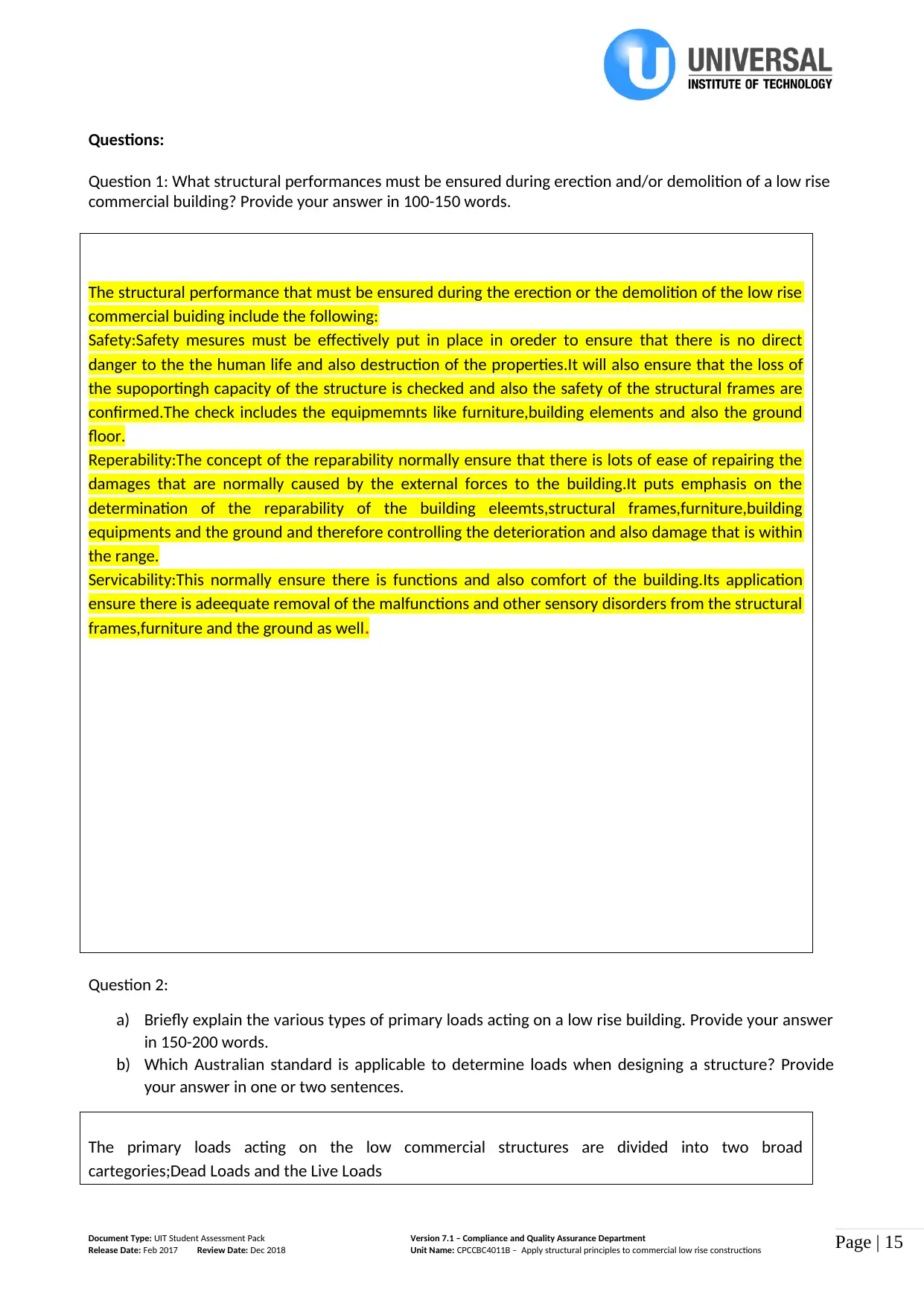
Page | 15
Questions:
Question 1: What structural performances must be ensured during erection and/or demolition of a low rise
commercial building? Provide your answer in 100-150 words.
The structural performance that must be ensured during the erection or the demolition of the low rise
commercial buiding include the following:
Safety:Safety mesures must be effectively put in place in oreder to ensure that there is no direct
danger to the the human life and also destruction of the properties.It will also ensure that the loss of
the supoportingh capacity of the structure is checked and also the safety of the structural frames are
confirmed.The check includes the equipmemnts like furniture,building elements and also the ground
floor.
Reperability:The concept of the reparability normally ensure that there is lots of ease of repairing the
damages that are normally caused by the external forces to the building.It puts emphasis on the
determination of the reparability of the building eleemts,structural frames,furniture,building
equipments and the ground and therefore controlling the deterioration and also damage that is within
the range.
Servicability:This normally ensure there is functions and also comfort of the building.Its application
ensure there is adeequate removal of the malfunctions and other sensory disorders from the structural
frames,furniture and the ground as well.
Question 2:
a) Briefly explain the various types of primary loads acting on a low rise building. Provide your answer
in 150-200 words.
b) Which Australian standard is applicable to determine loads when designing a structure? Provide
your answer in one or two sentences.
The primary loads acting on the low commercial structures are divided into two broad
cartegories;Dead Loads and the Live Loads
Document Type: UIT Student Assessment Pack Version 7.1 – Compliance and Quality Assurance Department
Release Date: Feb 2017 Review Date: Dec 2018 Unit Name: CPCCBC4011B – Apply structural principles to commercial low rise constructions
Questions:
Question 1: What structural performances must be ensured during erection and/or demolition of a low rise
commercial building? Provide your answer in 100-150 words.
The structural performance that must be ensured during the erection or the demolition of the low rise
commercial buiding include the following:
Safety:Safety mesures must be effectively put in place in oreder to ensure that there is no direct
danger to the the human life and also destruction of the properties.It will also ensure that the loss of
the supoportingh capacity of the structure is checked and also the safety of the structural frames are
confirmed.The check includes the equipmemnts like furniture,building elements and also the ground
floor.
Reperability:The concept of the reparability normally ensure that there is lots of ease of repairing the
damages that are normally caused by the external forces to the building.It puts emphasis on the
determination of the reparability of the building eleemts,structural frames,furniture,building
equipments and the ground and therefore controlling the deterioration and also damage that is within
the range.
Servicability:This normally ensure there is functions and also comfort of the building.Its application
ensure there is adeequate removal of the malfunctions and other sensory disorders from the structural
frames,furniture and the ground as well.
Question 2:
a) Briefly explain the various types of primary loads acting on a low rise building. Provide your answer
in 150-200 words.
b) Which Australian standard is applicable to determine loads when designing a structure? Provide
your answer in one or two sentences.
The primary loads acting on the low commercial structures are divided into two broad
cartegories;Dead Loads and the Live Loads
Document Type: UIT Student Assessment Pack Version 7.1 – Compliance and Quality Assurance Department
Release Date: Feb 2017 Review Date: Dec 2018 Unit Name: CPCCBC4011B – Apply structural principles to commercial low rise constructions
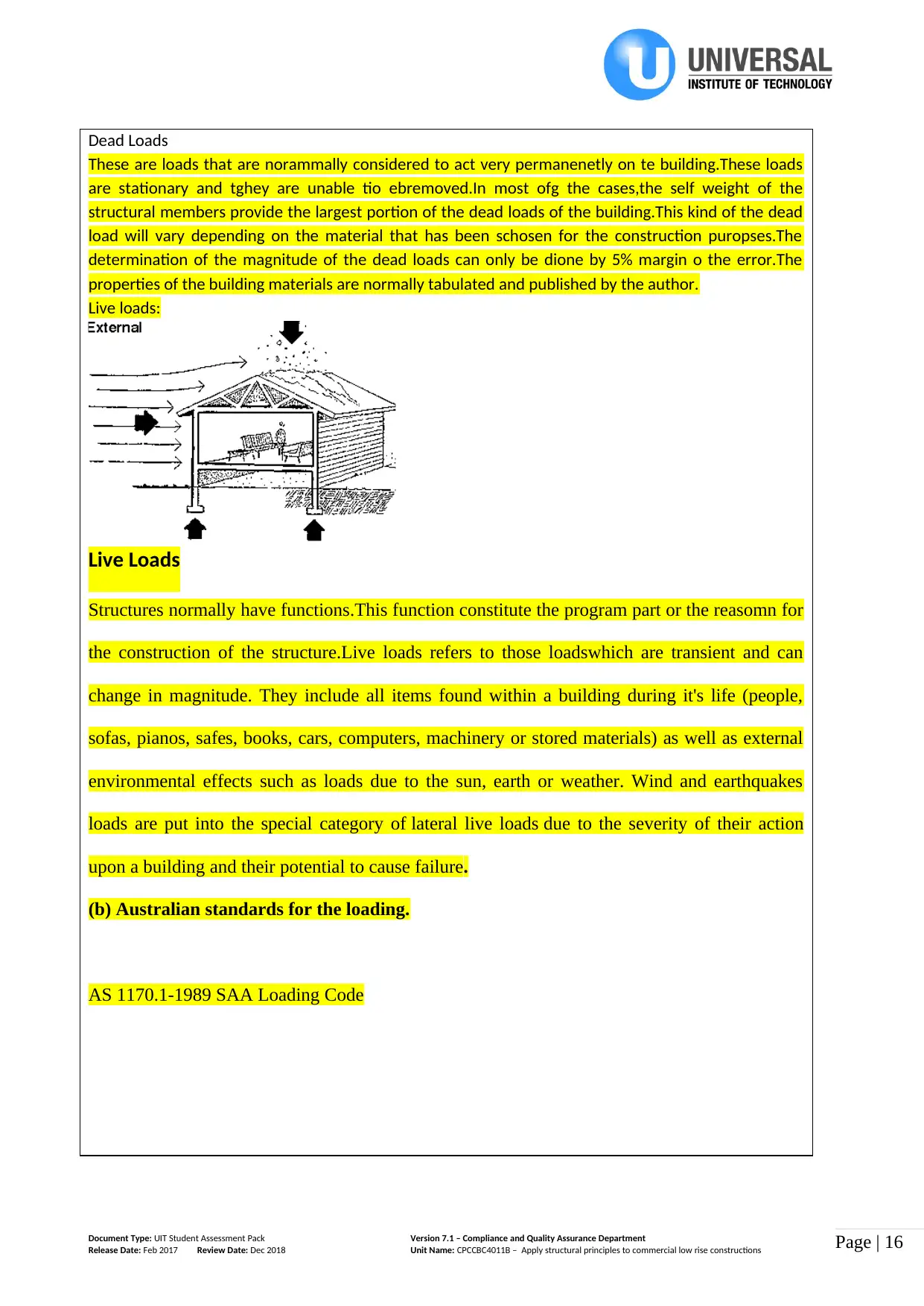
Page | 16
Dead Loads
These are loads that are norammally considered to act very permanenetly on te building.These loads
are stationary and tghey are unable tio ebremoved.In most ofg the cases,the self weight of the
structural members provide the largest portion of the dead loads of the building.This kind of the dead
load will vary depending on the material that has been schosen for the construction puropses.The
determination of the magnitude of the dead loads can only be dione by 5% margin o the error.The
properties of the building materials are normally tabulated and published by the author.
Live loads:
Live Loads
Structures normally have functions.This function constitute the program part or the reasomn for
the construction of the structure.Live loads refers to those loadswhich are transient and can
change in magnitude. They include all items found within a building during it's life (people,
sofas, pianos, safes, books, cars, computers, machinery or stored materials) as well as external
environmental effects such as loads due to the sun, earth or weather. Wind and earthquakes
loads are put into the special category of lateral live loads due to the severity of their action
upon a building and their potential to cause failure.
(b) Australian standards for the loading.
AS 1170.1-1989 SAA Loading Code
Document Type: UIT Student Assessment Pack Version 7.1 – Compliance and Quality Assurance Department
Release Date: Feb 2017 Review Date: Dec 2018 Unit Name: CPCCBC4011B – Apply structural principles to commercial low rise constructions
Dead Loads
These are loads that are norammally considered to act very permanenetly on te building.These loads
are stationary and tghey are unable tio ebremoved.In most ofg the cases,the self weight of the
structural members provide the largest portion of the dead loads of the building.This kind of the dead
load will vary depending on the material that has been schosen for the construction puropses.The
determination of the magnitude of the dead loads can only be dione by 5% margin o the error.The
properties of the building materials are normally tabulated and published by the author.
Live loads:
Live Loads
Structures normally have functions.This function constitute the program part or the reasomn for
the construction of the structure.Live loads refers to those loadswhich are transient and can
change in magnitude. They include all items found within a building during it's life (people,
sofas, pianos, safes, books, cars, computers, machinery or stored materials) as well as external
environmental effects such as loads due to the sun, earth or weather. Wind and earthquakes
loads are put into the special category of lateral live loads due to the severity of their action
upon a building and their potential to cause failure.
(b) Australian standards for the loading.
AS 1170.1-1989 SAA Loading Code
Document Type: UIT Student Assessment Pack Version 7.1 – Compliance and Quality Assurance Department
Release Date: Feb 2017 Review Date: Dec 2018 Unit Name: CPCCBC4011B – Apply structural principles to commercial low rise constructions
Secure Best Marks with AI Grader
Need help grading? Try our AI Grader for instant feedback on your assignments.
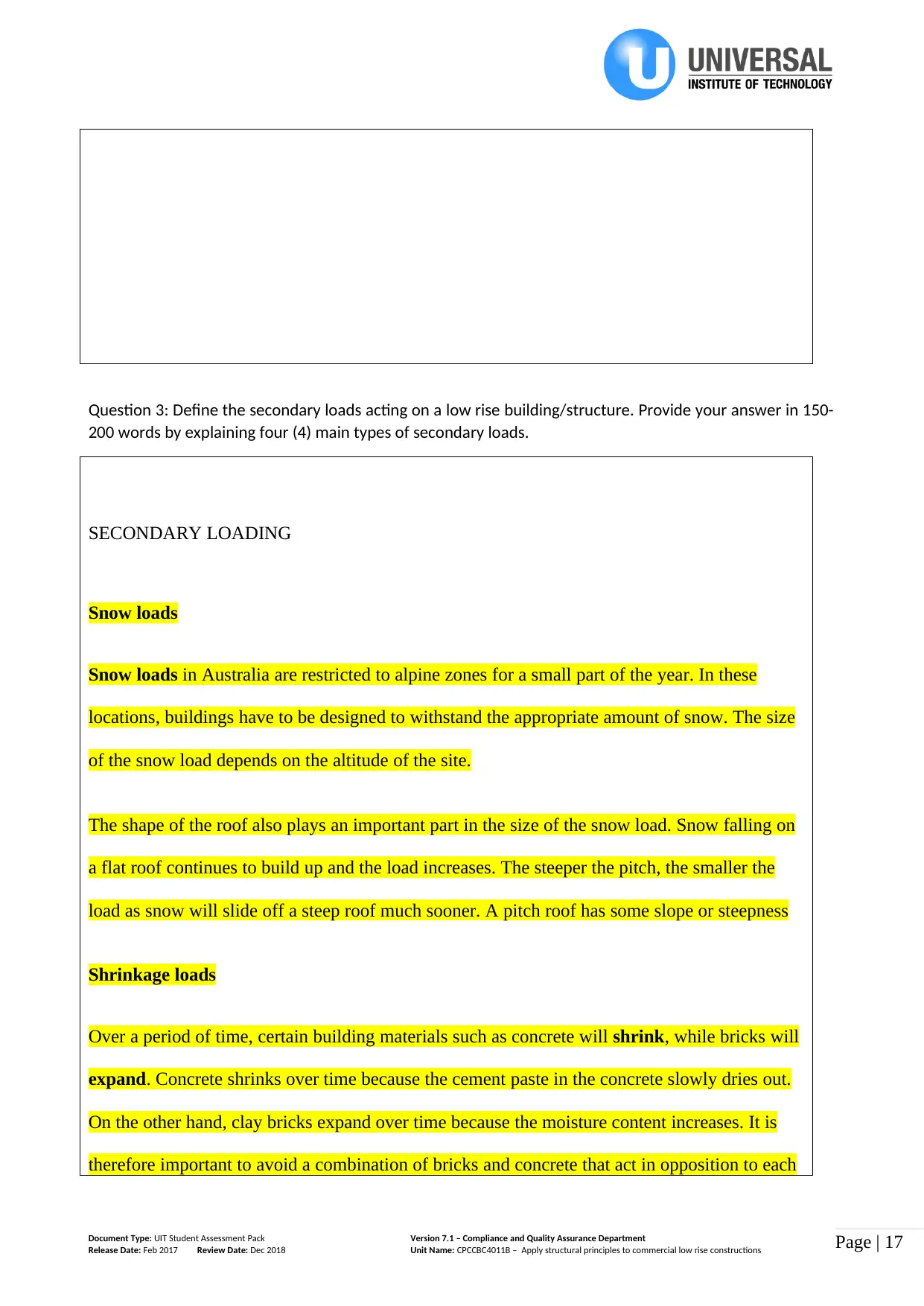
Page | 17
Question 3: Define the secondary loads acting on a low rise building/structure. Provide your answer in 150-
200 words by explaining four (4) main types of secondary loads.
SECONDARY LOADING
Snow loads
Snow loads in Australia are restricted to alpine zones for a small part of the year. In these
locations, buildings have to be designed to withstand the appropriate amount of snow. The size
of the snow load depends on the altitude of the site.
The shape of the roof also plays an important part in the size of the snow load. Snow falling on
a flat roof continues to build up and the load increases. The steeper the pitch, the smaller the
load as snow will slide off a steep roof much sooner. A pitch roof has some slope or steepness
Shrinkage loads
Over a period of time, certain building materials such as concrete will shrink, while bricks will
expand. Concrete shrinks over time because the cement paste in the concrete slowly dries out.
On the other hand, clay bricks expand over time because the moisture content increases. It is
therefore important to avoid a combination of bricks and concrete that act in opposition to each
Document Type: UIT Student Assessment Pack Version 7.1 – Compliance and Quality Assurance Department
Release Date: Feb 2017 Review Date: Dec 2018 Unit Name: CPCCBC4011B – Apply structural principles to commercial low rise constructions
Question 3: Define the secondary loads acting on a low rise building/structure. Provide your answer in 150-
200 words by explaining four (4) main types of secondary loads.
SECONDARY LOADING
Snow loads
Snow loads in Australia are restricted to alpine zones for a small part of the year. In these
locations, buildings have to be designed to withstand the appropriate amount of snow. The size
of the snow load depends on the altitude of the site.
The shape of the roof also plays an important part in the size of the snow load. Snow falling on
a flat roof continues to build up and the load increases. The steeper the pitch, the smaller the
load as snow will slide off a steep roof much sooner. A pitch roof has some slope or steepness
Shrinkage loads
Over a period of time, certain building materials such as concrete will shrink, while bricks will
expand. Concrete shrinks over time because the cement paste in the concrete slowly dries out.
On the other hand, clay bricks expand over time because the moisture content increases. It is
therefore important to avoid a combination of bricks and concrete that act in opposition to each
Document Type: UIT Student Assessment Pack Version 7.1 – Compliance and Quality Assurance Department
Release Date: Feb 2017 Review Date: Dec 2018 Unit Name: CPCCBC4011B – Apply structural principles to commercial low rise constructions
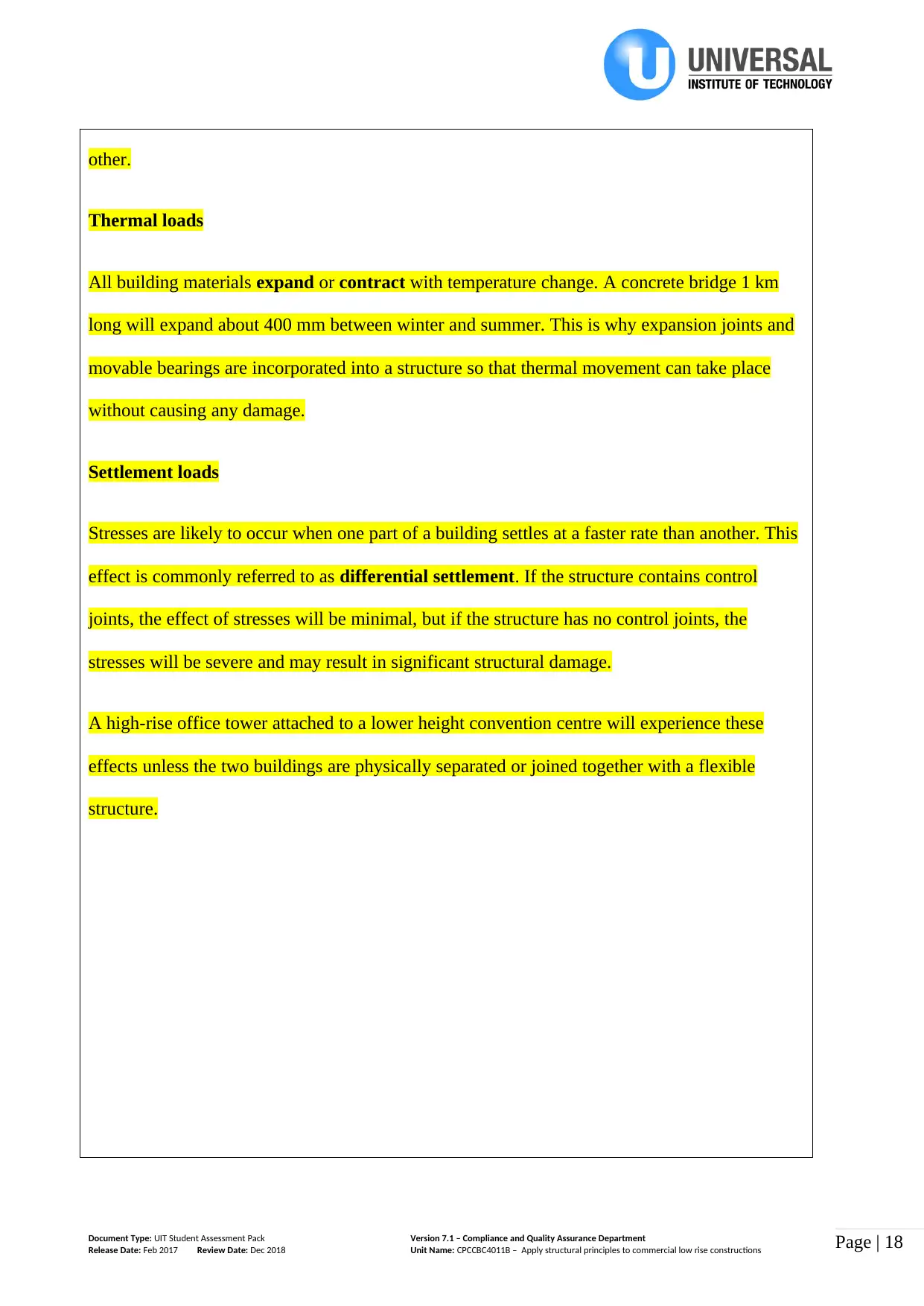
Page | 18
other.
Thermal loads
All building materials expand or contract with temperature change. A concrete bridge 1 km
long will expand about 400 mm between winter and summer. This is why expansion joints and
movable bearings are incorporated into a structure so that thermal movement can take place
without causing any damage.
Settlement loads
Stresses are likely to occur when one part of a building settles at a faster rate than another. This
effect is commonly referred to as differential settlement. If the structure contains control
joints, the effect of stresses will be minimal, but if the structure has no control joints, the
stresses will be severe and may result in significant structural damage.
A high-rise office tower attached to a lower height convention centre will experience these
effects unless the two buildings are physically separated or joined together with a flexible
structure.
Document Type: UIT Student Assessment Pack Version 7.1 – Compliance and Quality Assurance Department
Release Date: Feb 2017 Review Date: Dec 2018 Unit Name: CPCCBC4011B – Apply structural principles to commercial low rise constructions
other.
Thermal loads
All building materials expand or contract with temperature change. A concrete bridge 1 km
long will expand about 400 mm between winter and summer. This is why expansion joints and
movable bearings are incorporated into a structure so that thermal movement can take place
without causing any damage.
Settlement loads
Stresses are likely to occur when one part of a building settles at a faster rate than another. This
effect is commonly referred to as differential settlement. If the structure contains control
joints, the effect of stresses will be minimal, but if the structure has no control joints, the
stresses will be severe and may result in significant structural damage.
A high-rise office tower attached to a lower height convention centre will experience these
effects unless the two buildings are physically separated or joined together with a flexible
structure.
Document Type: UIT Student Assessment Pack Version 7.1 – Compliance and Quality Assurance Department
Release Date: Feb 2017 Review Date: Dec 2018 Unit Name: CPCCBC4011B – Apply structural principles to commercial low rise constructions
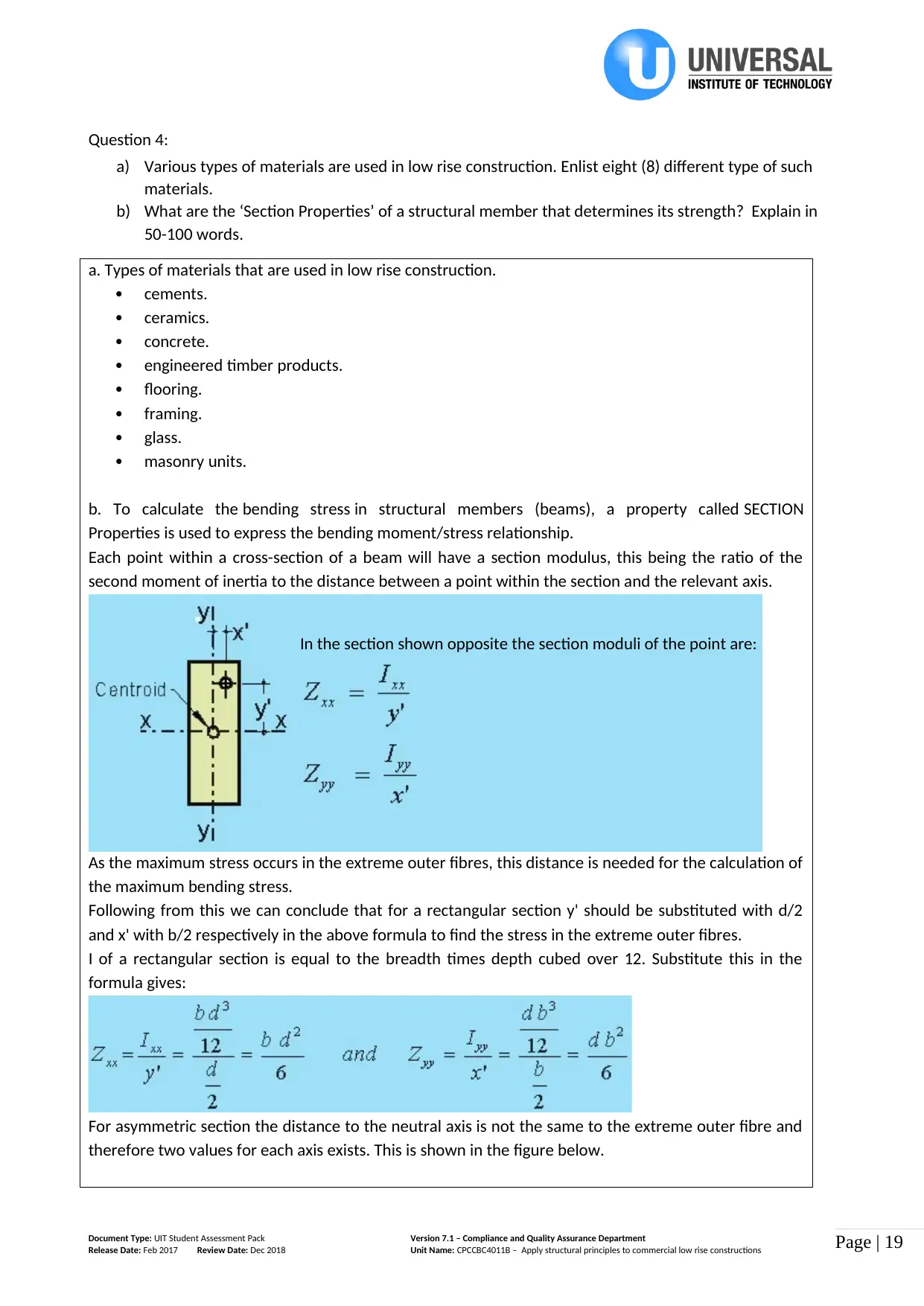
Page | 19
Question 4:
a) Various types of materials are used in low rise construction. Enlist eight (8) different type of such
materials.
b) What are the ‘Section Properties’ of a structural member that determines its strength? Explain in
50-100 words.
a. Types of materials that are used in low rise construction.
cements.
ceramics.
concrete.
engineered timber products.
flooring.
framing.
glass.
masonry units.
b. To calculate the bending stress in structural members (beams), a property called SECTION
Properties is used to express the bending moment/stress relationship.
Each point within a cross-section of a beam will have a section modulus, this being the ratio of the
second moment of inertia to the distance between a point within the section and the relevant axis.
In the section shown opposite the section moduli of the point are:
As the maximum stress occurs in the extreme outer fibres, this distance is needed for the calculation of
the maximum bending stress.
Following from this we can conclude that for a rectangular section y' should be substituted with d/2
and x' with b/2 respectively in the above formula to find the stress in the extreme outer fibres.
I of a rectangular section is equal to the breadth times depth cubed over 12. Substitute this in the
formula gives:
For asymmetric section the distance to the neutral axis is not the same to the extreme outer fibre and
therefore two values for each axis exists. This is shown in the figure below.
Document Type: UIT Student Assessment Pack Version 7.1 – Compliance and Quality Assurance Department
Release Date: Feb 2017 Review Date: Dec 2018 Unit Name: CPCCBC4011B – Apply structural principles to commercial low rise constructions
Question 4:
a) Various types of materials are used in low rise construction. Enlist eight (8) different type of such
materials.
b) What are the ‘Section Properties’ of a structural member that determines its strength? Explain in
50-100 words.
a. Types of materials that are used in low rise construction.
cements.
ceramics.
concrete.
engineered timber products.
flooring.
framing.
glass.
masonry units.
b. To calculate the bending stress in structural members (beams), a property called SECTION
Properties is used to express the bending moment/stress relationship.
Each point within a cross-section of a beam will have a section modulus, this being the ratio of the
second moment of inertia to the distance between a point within the section and the relevant axis.
In the section shown opposite the section moduli of the point are:
As the maximum stress occurs in the extreme outer fibres, this distance is needed for the calculation of
the maximum bending stress.
Following from this we can conclude that for a rectangular section y' should be substituted with d/2
and x' with b/2 respectively in the above formula to find the stress in the extreme outer fibres.
I of a rectangular section is equal to the breadth times depth cubed over 12. Substitute this in the
formula gives:
For asymmetric section the distance to the neutral axis is not the same to the extreme outer fibre and
therefore two values for each axis exists. This is shown in the figure below.
Document Type: UIT Student Assessment Pack Version 7.1 – Compliance and Quality Assurance Department
Release Date: Feb 2017 Review Date: Dec 2018 Unit Name: CPCCBC4011B – Apply structural principles to commercial low rise constructions
Paraphrase This Document
Need a fresh take? Get an instant paraphrase of this document with our AI Paraphraser
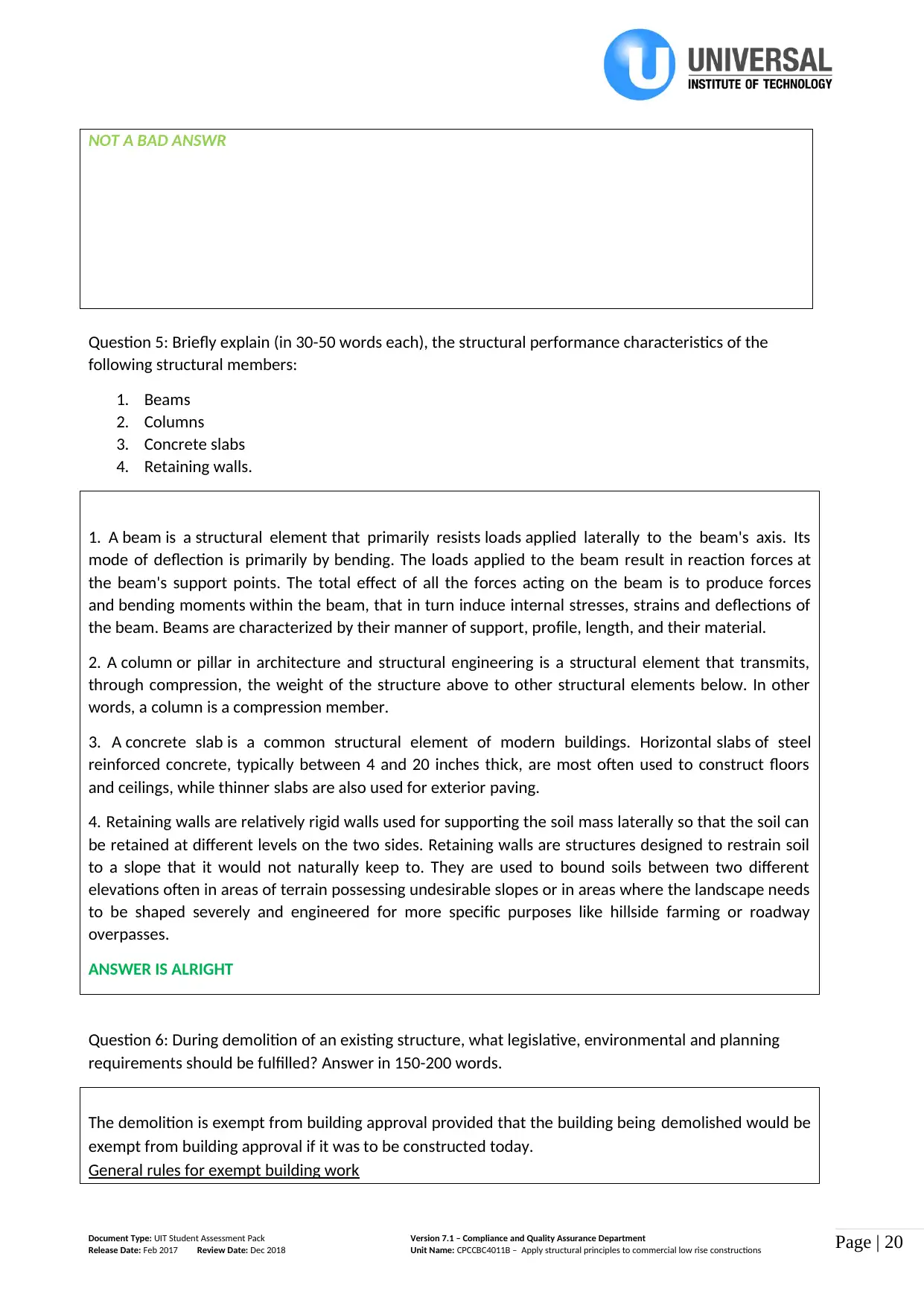
Page | 20
NOT A BAD ANSWR
Question 5: Briefly explain (in 30-50 words each), the structural performance characteristics of the
following structural members:
1. Beams
2. Columns
3. Concrete slabs
4. Retaining walls.
1. A beam is a structural element that primarily resists loads applied laterally to the beam's axis. Its
mode of deflection is primarily by bending. The loads applied to the beam result in reaction forces at
the beam's support points. The total effect of all the forces acting on the beam is to produce forces
and bending moments within the beam, that in turn induce internal stresses, strains and deflections of
the beam. Beams are characterized by their manner of support, profile, length, and their material.
2. A column or pillar in architecture and structural engineering is a structural element that transmits,
through compression, the weight of the structure above to other structural elements below. In other
words, a column is a compression member.
3. A concrete slab is a common structural element of modern buildings. Horizontal slabs of steel
reinforced concrete, typically between 4 and 20 inches thick, are most often used to construct floors
and ceilings, while thinner slabs are also used for exterior paving.
4. Retaining walls are relatively rigid walls used for supporting the soil mass laterally so that the soil can
be retained at different levels on the two sides. Retaining walls are structures designed to restrain soil
to a slope that it would not naturally keep to. They are used to bound soils between two different
elevations often in areas of terrain possessing undesirable slopes or in areas where the landscape needs
to be shaped severely and engineered for more specific purposes like hillside farming or roadway
overpasses.
ANSWER IS ALRIGHT
Question 6: During demolition of an existing structure, what legislative, environmental and planning
requirements should be fulfilled? Answer in 150-200 words.
The demolition is exempt from building approval provided that the building being demolished would be
exempt from building approval if it was to be constructed today.
General rules for exempt building work
Document Type: UIT Student Assessment Pack Version 7.1 – Compliance and Quality Assurance Department
Release Date: Feb 2017 Review Date: Dec 2018 Unit Name: CPCCBC4011B – Apply structural principles to commercial low rise constructions
NOT A BAD ANSWR
Question 5: Briefly explain (in 30-50 words each), the structural performance characteristics of the
following structural members:
1. Beams
2. Columns
3. Concrete slabs
4. Retaining walls.
1. A beam is a structural element that primarily resists loads applied laterally to the beam's axis. Its
mode of deflection is primarily by bending. The loads applied to the beam result in reaction forces at
the beam's support points. The total effect of all the forces acting on the beam is to produce forces
and bending moments within the beam, that in turn induce internal stresses, strains and deflections of
the beam. Beams are characterized by their manner of support, profile, length, and their material.
2. A column or pillar in architecture and structural engineering is a structural element that transmits,
through compression, the weight of the structure above to other structural elements below. In other
words, a column is a compression member.
3. A concrete slab is a common structural element of modern buildings. Horizontal slabs of steel
reinforced concrete, typically between 4 and 20 inches thick, are most often used to construct floors
and ceilings, while thinner slabs are also used for exterior paving.
4. Retaining walls are relatively rigid walls used for supporting the soil mass laterally so that the soil can
be retained at different levels on the two sides. Retaining walls are structures designed to restrain soil
to a slope that it would not naturally keep to. They are used to bound soils between two different
elevations often in areas of terrain possessing undesirable slopes or in areas where the landscape needs
to be shaped severely and engineered for more specific purposes like hillside farming or roadway
overpasses.
ANSWER IS ALRIGHT
Question 6: During demolition of an existing structure, what legislative, environmental and planning
requirements should be fulfilled? Answer in 150-200 words.
The demolition is exempt from building approval provided that the building being demolished would be
exempt from building approval if it was to be constructed today.
General rules for exempt building work
Document Type: UIT Student Assessment Pack Version 7.1 – Compliance and Quality Assurance Department
Release Date: Feb 2017 Review Date: Dec 2018 Unit Name: CPCCBC4011B – Apply structural principles to commercial low rise constructions
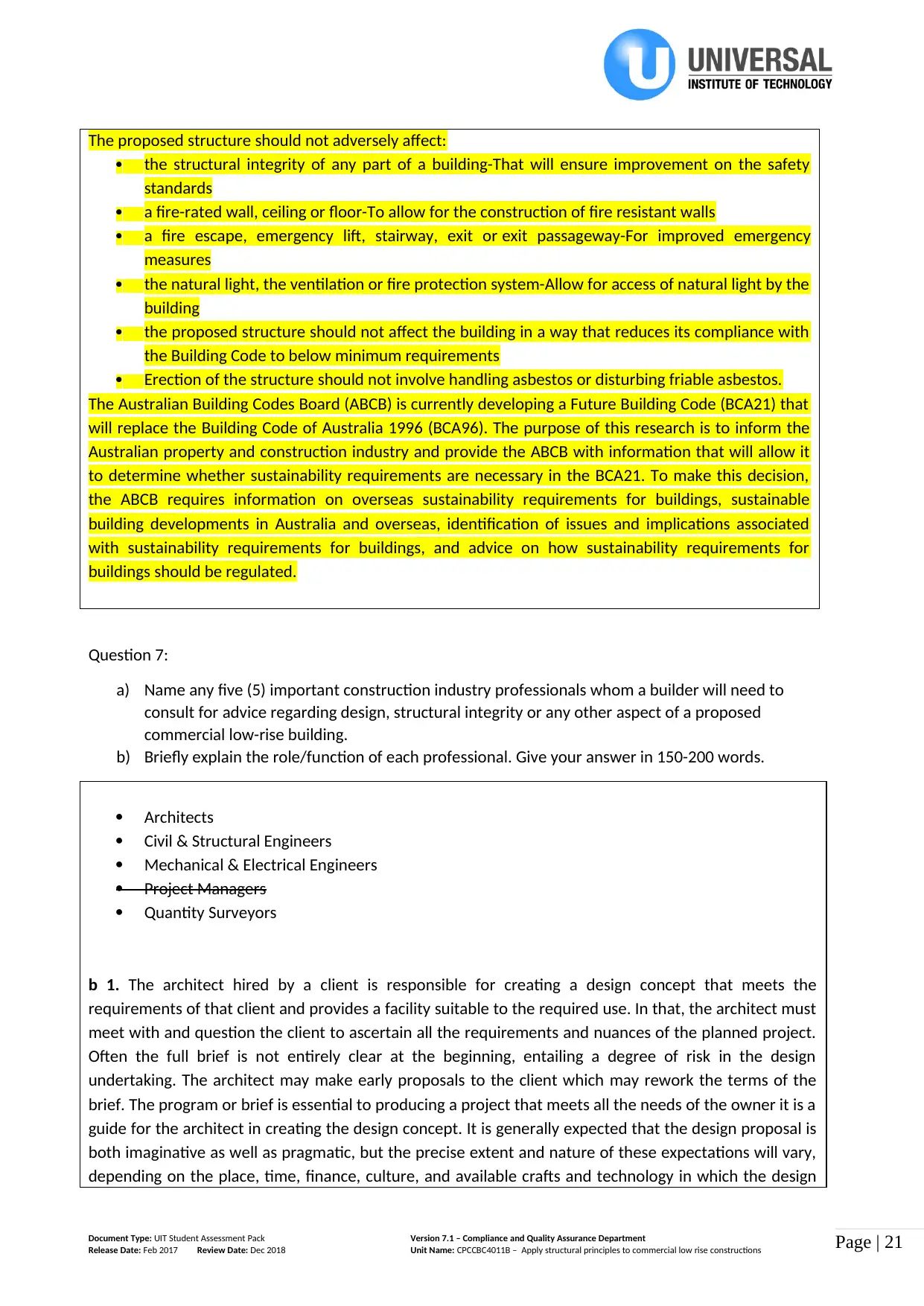
Page | 21
The proposed structure should not adversely affect:
the structural integrity of any part of a building-That will ensure improvement on the safety
standards
a fire-rated wall, ceiling or floor-To allow for the construction of fire resistant walls
a fire escape, emergency lift, stairway, exit or exit passageway-For improved emergency
measures
the natural light, the ventilation or fire protection system-Allow for access of natural light by the
building
the proposed structure should not affect the building in a way that reduces its compliance with
the Building Code to below minimum requirements
Erection of the structure should not involve handling asbestos or disturbing friable asbestos.
The Australian Building Codes Board (ABCB) is currently developing a Future Building Code (BCA21) that
will replace the Building Code of Australia 1996 (BCA96). The purpose of this research is to inform the
Australian property and construction industry and provide the ABCB with information that will allow it
to determine whether sustainability requirements are necessary in the BCA21. To make this decision,
the ABCB requires information on overseas sustainability requirements for buildings, sustainable
building developments in Australia and overseas, identification of issues and implications associated
with sustainability requirements for buildings, and advice on how sustainability requirements for
buildings should be regulated.
Question 7:
a) Name any five (5) important construction industry professionals whom a builder will need to
consult for advice regarding design, structural integrity or any other aspect of a proposed
commercial low-rise building.
b) Briefly explain the role/function of each professional. Give your answer in 150-200 words.
Architects
Civil & Structural Engineers
Mechanical & Electrical Engineers
Project Managers
Quantity Surveyors
b 1. The architect hired by a client is responsible for creating a design concept that meets the
requirements of that client and provides a facility suitable to the required use. In that, the architect must
meet with and question the client to ascertain all the requirements and nuances of the planned project.
Often the full brief is not entirely clear at the beginning, entailing a degree of risk in the design
undertaking. The architect may make early proposals to the client which may rework the terms of the
brief. The program or brief is essential to producing a project that meets all the needs of the owner it is a
guide for the architect in creating the design concept. It is generally expected that the design proposal is
both imaginative as well as pragmatic, but the precise extent and nature of these expectations will vary,
depending on the place, time, finance, culture, and available crafts and technology in which the design
Document Type: UIT Student Assessment Pack Version 7.1 – Compliance and Quality Assurance Department
Release Date: Feb 2017 Review Date: Dec 2018 Unit Name: CPCCBC4011B – Apply structural principles to commercial low rise constructions
The proposed structure should not adversely affect:
the structural integrity of any part of a building-That will ensure improvement on the safety
standards
a fire-rated wall, ceiling or floor-To allow for the construction of fire resistant walls
a fire escape, emergency lift, stairway, exit or exit passageway-For improved emergency
measures
the natural light, the ventilation or fire protection system-Allow for access of natural light by the
building
the proposed structure should not affect the building in a way that reduces its compliance with
the Building Code to below minimum requirements
Erection of the structure should not involve handling asbestos or disturbing friable asbestos.
The Australian Building Codes Board (ABCB) is currently developing a Future Building Code (BCA21) that
will replace the Building Code of Australia 1996 (BCA96). The purpose of this research is to inform the
Australian property and construction industry and provide the ABCB with information that will allow it
to determine whether sustainability requirements are necessary in the BCA21. To make this decision,
the ABCB requires information on overseas sustainability requirements for buildings, sustainable
building developments in Australia and overseas, identification of issues and implications associated
with sustainability requirements for buildings, and advice on how sustainability requirements for
buildings should be regulated.
Question 7:
a) Name any five (5) important construction industry professionals whom a builder will need to
consult for advice regarding design, structural integrity or any other aspect of a proposed
commercial low-rise building.
b) Briefly explain the role/function of each professional. Give your answer in 150-200 words.
Architects
Civil & Structural Engineers
Mechanical & Electrical Engineers
Project Managers
Quantity Surveyors
b 1. The architect hired by a client is responsible for creating a design concept that meets the
requirements of that client and provides a facility suitable to the required use. In that, the architect must
meet with and question the client to ascertain all the requirements and nuances of the planned project.
Often the full brief is not entirely clear at the beginning, entailing a degree of risk in the design
undertaking. The architect may make early proposals to the client which may rework the terms of the
brief. The program or brief is essential to producing a project that meets all the needs of the owner it is a
guide for the architect in creating the design concept. It is generally expected that the design proposal is
both imaginative as well as pragmatic, but the precise extent and nature of these expectations will vary,
depending on the place, time, finance, culture, and available crafts and technology in which the design
Document Type: UIT Student Assessment Pack Version 7.1 – Compliance and Quality Assurance Department
Release Date: Feb 2017 Review Date: Dec 2018 Unit Name: CPCCBC4011B – Apply structural principles to commercial low rise constructions

Page | 22
takes place.
2. Structural engineers is a part of civil engineering in which structural engineers are educated to create
the 'bones and muscles' that create the form and shape of manmade structures. Structural
engineers need to understand and calculate the stability, strength and rigidity of built structures
for buildings and no building structures. The structural designs are integrated with those of other
designers such as architects and building services engineer and often supervise the construction of
projects by contractors on site. They can also be involved in the design of machinery, medical
equipment, and vehicles where structural integrity affects functioning and safety.
3. Mechanical, electrical and plumbing (MEP) refers to these aspects of building design and
construction. In commercial buildings these aspects are often designed by an engineering firm
specializing in MEP. MEP design is important for design decision-making, accurate documentation,
performance and cost-estimation, construction planning, managing and operating the resulting facility.
4. The project manager has an important role in interfacing between the project and the business area.
This is important for communicating and encouraging the need for transformation and change within the
business area in tandem with the delivery of new capabilities from the project. The readiness of the
business to exploit the new capability is crucial to success. Without this state of readiness in the
business, there are likely to be disruptions and delays in the plan for benefits realisation.
5. Quantity Surveying is a profession that dates back to the 18th century in the United Kingdom, when
construction projects were measured and valued after they were designed and built. The “measurers”
would quantify and assign a value to the work after the building was constructed and then negotiate
with the client and architect on behalf of the tradesmen. By the early 19th century, a new contractor
system resulted in price competition before construction. Quantity Surveyors developed the skill of pre-
measuring quantities from drawings and assembling them in “bills of quantities” before construction
began. The quantity surveying profession today has greatly evolved. Today’s Quantity Surveyors are a
key part of the construction and financial management process, including cost estimating and
forecasting, cost management, construction techniques and management, procurement processes and
contractual matters. With the uncertainty of today’s market conditions, the movement towards “green”
buildings, and the use of non-traditional procurement methods, the quantity surveyors role continues to
evolve.
NOT BAD; YOU COULD ALSO HAVE MENTIONED “LAND SURVERYOR”
AND “BUILDING SURVEYOR”
Question 8: What project documents shall be submitted to the local council to obtain approval for the
construction of a low-rise building? Briefly explain the function of each document. Answer in 150-200
words.
Certificate of design compliance (BA3)
Document Type: UIT Student Assessment Pack Version 7.1 – Compliance and Quality Assurance Department
Release Date: Feb 2017 Review Date: Dec 2018 Unit Name: CPCCBC4011B – Apply structural principles to commercial low rise constructions
takes place.
2. Structural engineers is a part of civil engineering in which structural engineers are educated to create
the 'bones and muscles' that create the form and shape of manmade structures. Structural
engineers need to understand and calculate the stability, strength and rigidity of built structures
for buildings and no building structures. The structural designs are integrated with those of other
designers such as architects and building services engineer and often supervise the construction of
projects by contractors on site. They can also be involved in the design of machinery, medical
equipment, and vehicles where structural integrity affects functioning and safety.
3. Mechanical, electrical and plumbing (MEP) refers to these aspects of building design and
construction. In commercial buildings these aspects are often designed by an engineering firm
specializing in MEP. MEP design is important for design decision-making, accurate documentation,
performance and cost-estimation, construction planning, managing and operating the resulting facility.
4. The project manager has an important role in interfacing between the project and the business area.
This is important for communicating and encouraging the need for transformation and change within the
business area in tandem with the delivery of new capabilities from the project. The readiness of the
business to exploit the new capability is crucial to success. Without this state of readiness in the
business, there are likely to be disruptions and delays in the plan for benefits realisation.
5. Quantity Surveying is a profession that dates back to the 18th century in the United Kingdom, when
construction projects were measured and valued after they were designed and built. The “measurers”
would quantify and assign a value to the work after the building was constructed and then negotiate
with the client and architect on behalf of the tradesmen. By the early 19th century, a new contractor
system resulted in price competition before construction. Quantity Surveyors developed the skill of pre-
measuring quantities from drawings and assembling them in “bills of quantities” before construction
began. The quantity surveying profession today has greatly evolved. Today’s Quantity Surveyors are a
key part of the construction and financial management process, including cost estimating and
forecasting, cost management, construction techniques and management, procurement processes and
contractual matters. With the uncertainty of today’s market conditions, the movement towards “green”
buildings, and the use of non-traditional procurement methods, the quantity surveyors role continues to
evolve.
NOT BAD; YOU COULD ALSO HAVE MENTIONED “LAND SURVERYOR”
AND “BUILDING SURVEYOR”
Question 8: What project documents shall be submitted to the local council to obtain approval for the
construction of a low-rise building? Briefly explain the function of each document. Answer in 150-200
words.
Certificate of design compliance (BA3)
Document Type: UIT Student Assessment Pack Version 7.1 – Compliance and Quality Assurance Department
Release Date: Feb 2017 Review Date: Dec 2018 Unit Name: CPCCBC4011B – Apply structural principles to commercial low rise constructions
Secure Best Marks with AI Grader
Need help grading? Try our AI Grader for instant feedback on your assignments.
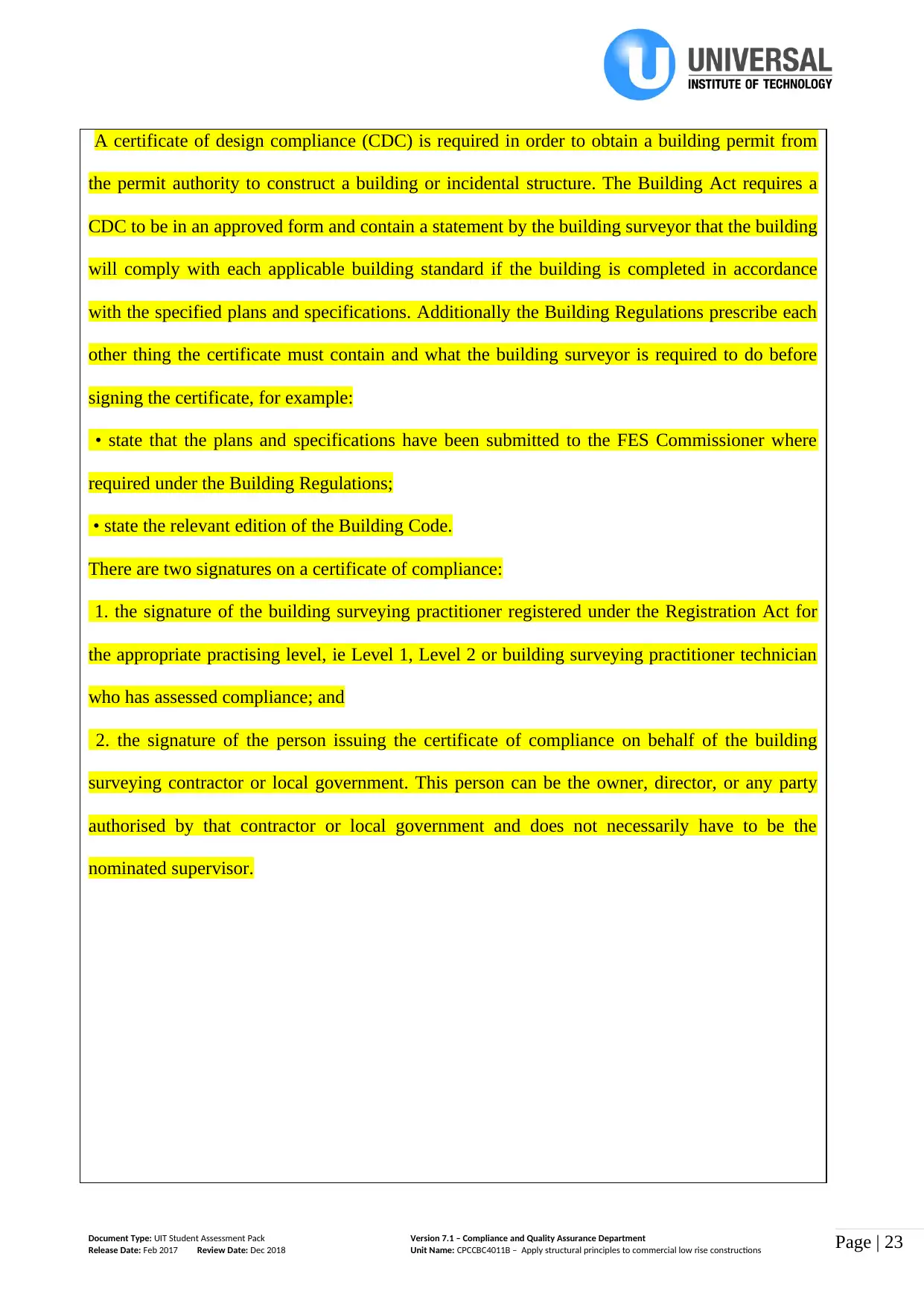
Page | 23
A certificate of design compliance (CDC) is required in order to obtain a building permit from
the permit authority to construct a building or incidental structure. The Building Act requires a
CDC to be in an approved form and contain a statement by the building surveyor that the building
will comply with each applicable building standard if the building is completed in accordance
with the specified plans and specifications. Additionally the Building Regulations prescribe each
other thing the certificate must contain and what the building surveyor is required to do before
signing the certificate, for example:
• state that the plans and specifications have been submitted to the FES Commissioner where
required under the Building Regulations;
• state the relevant edition of the Building Code.
There are two signatures on a certificate of compliance:
1. the signature of the building surveying practitioner registered under the Registration Act for
the appropriate practising level, ie Level 1, Level 2 or building surveying practitioner technician
who has assessed compliance; and
2. the signature of the person issuing the certificate of compliance on behalf of the building
surveying contractor or local government. This person can be the owner, director, or any party
authorised by that contractor or local government and does not necessarily have to be the
nominated supervisor.
Document Type: UIT Student Assessment Pack Version 7.1 – Compliance and Quality Assurance Department
Release Date: Feb 2017 Review Date: Dec 2018 Unit Name: CPCCBC4011B – Apply structural principles to commercial low rise constructions
A certificate of design compliance (CDC) is required in order to obtain a building permit from
the permit authority to construct a building or incidental structure. The Building Act requires a
CDC to be in an approved form and contain a statement by the building surveyor that the building
will comply with each applicable building standard if the building is completed in accordance
with the specified plans and specifications. Additionally the Building Regulations prescribe each
other thing the certificate must contain and what the building surveyor is required to do before
signing the certificate, for example:
• state that the plans and specifications have been submitted to the FES Commissioner where
required under the Building Regulations;
• state the relevant edition of the Building Code.
There are two signatures on a certificate of compliance:
1. the signature of the building surveying practitioner registered under the Registration Act for
the appropriate practising level, ie Level 1, Level 2 or building surveying practitioner technician
who has assessed compliance; and
2. the signature of the person issuing the certificate of compliance on behalf of the building
surveying contractor or local government. This person can be the owner, director, or any party
authorised by that contractor or local government and does not necessarily have to be the
nominated supervisor.
Document Type: UIT Student Assessment Pack Version 7.1 – Compliance and Quality Assurance Department
Release Date: Feb 2017 Review Date: Dec 2018 Unit Name: CPCCBC4011B – Apply structural principles to commercial low rise constructions
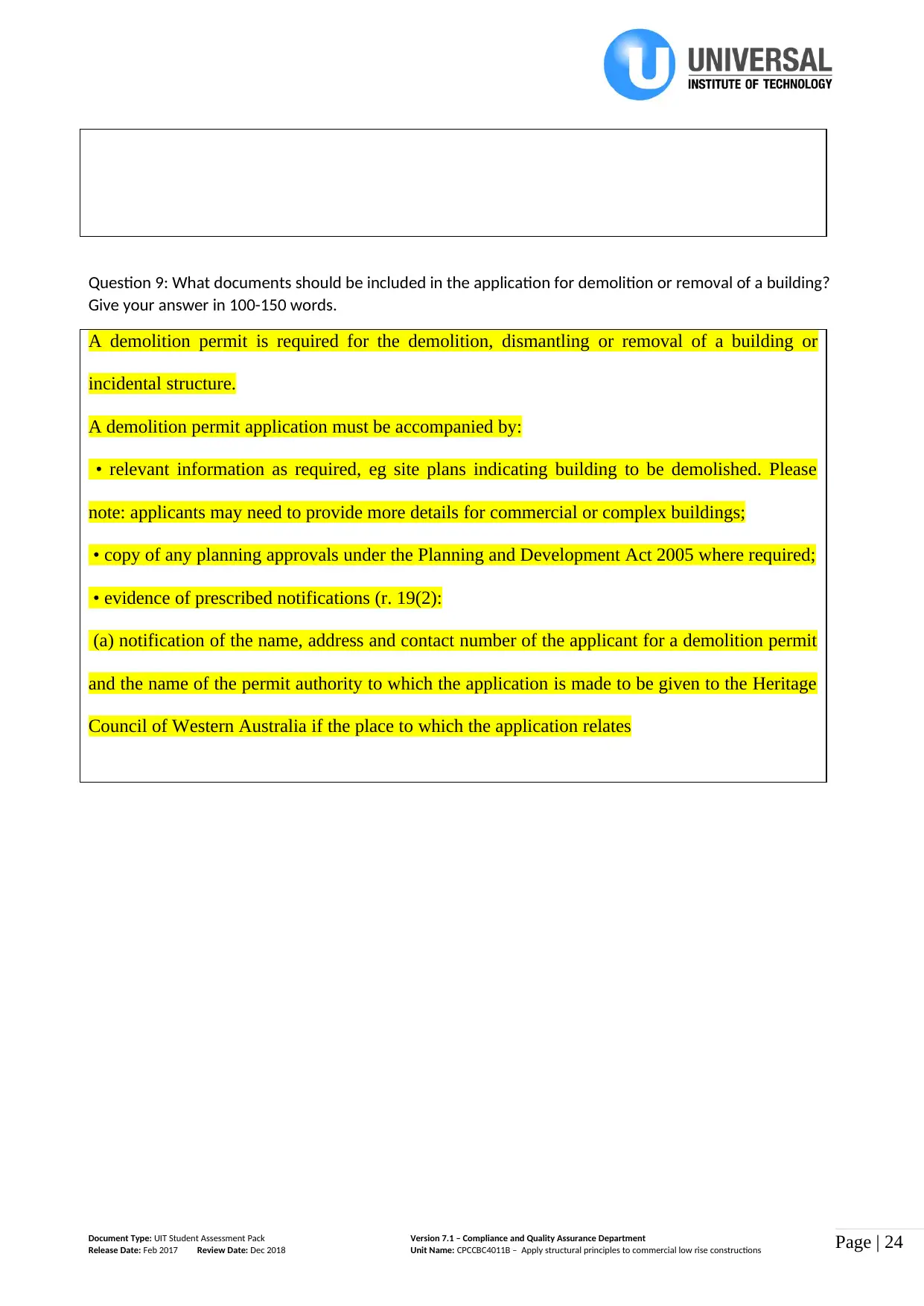
Page | 24
Question 9: What documents should be included in the application for demolition or removal of a building?
Give your answer in 100-150 words.
A demolition permit is required for the demolition, dismantling or removal of a building or
incidental structure.
A demolition permit application must be accompanied by:
• relevant information as required, eg site plans indicating building to be demolished. Please
note: applicants may need to provide more details for commercial or complex buildings;
• copy of any planning approvals under the Planning and Development Act 2005 where required;
• evidence of prescribed notifications (r. 19(2):
(a) notification of the name, address and contact number of the applicant for a demolition permit
and the name of the permit authority to which the application is made to be given to the Heritage
Council of Western Australia if the place to which the application relates
Document Type: UIT Student Assessment Pack Version 7.1 – Compliance and Quality Assurance Department
Release Date: Feb 2017 Review Date: Dec 2018 Unit Name: CPCCBC4011B – Apply structural principles to commercial low rise constructions
Question 9: What documents should be included in the application for demolition or removal of a building?
Give your answer in 100-150 words.
A demolition permit is required for the demolition, dismantling or removal of a building or
incidental structure.
A demolition permit application must be accompanied by:
• relevant information as required, eg site plans indicating building to be demolished. Please
note: applicants may need to provide more details for commercial or complex buildings;
• copy of any planning approvals under the Planning and Development Act 2005 where required;
• evidence of prescribed notifications (r. 19(2):
(a) notification of the name, address and contact number of the applicant for a demolition permit
and the name of the permit authority to which the application is made to be given to the Heritage
Council of Western Australia if the place to which the application relates
Document Type: UIT Student Assessment Pack Version 7.1 – Compliance and Quality Assurance Department
Release Date: Feb 2017 Review Date: Dec 2018 Unit Name: CPCCBC4011B – Apply structural principles to commercial low rise constructions
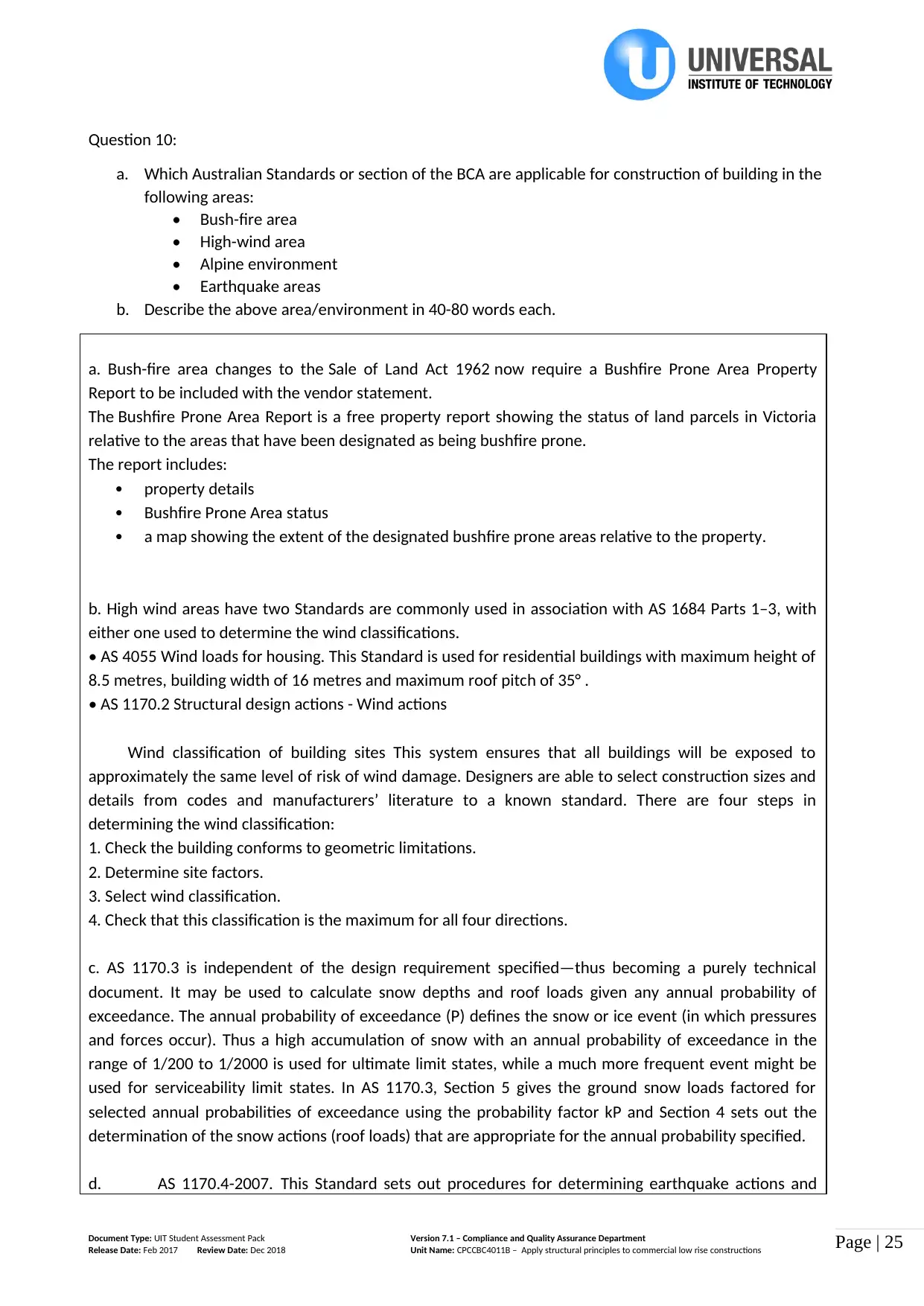
Page | 25
Question 10:
a. Which Australian Standards or section of the BCA are applicable for construction of building in the
following areas:
• Bush-fire area
• High-wind area
• Alpine environment
• Earthquake areas
b. Describe the above area/environment in 40-80 words each.
a. Bush-fire area changes to the Sale of Land Act 1962 now require a Bushfire Prone Area Property
Report to be included with the vendor statement.
The Bushfire Prone Area Report is a free property report showing the status of land parcels in Victoria
relative to the areas that have been designated as being bushfire prone.
The report includes:
property details
Bushfire Prone Area status
a map showing the extent of the designated bushfire prone areas relative to the property.
b. High wind areas have two Standards are commonly used in association with AS 1684 Parts 1–3, with
either one used to determine the wind classifications.
• AS 4055 Wind loads for housing. This Standard is used for residential buildings with maximum height of
8.5 metres, building width of 16 metres and maximum roof pitch of 35° .
• AS 1170.2 Structural design actions - Wind actions
Wind classification of building sites This system ensures that all buildings will be exposed to
approximately the same level of risk of wind damage. Designers are able to select construction sizes and
details from codes and manufacturers’ literature to a known standard. There are four steps in
determining the wind classification:
1. Check the building conforms to geometric limitations.
2. Determine site factors.
3. Select wind classification.
4. Check that this classification is the maximum for all four directions.
c. AS 1170.3 is independent of the design requirement specified—thus becoming a purely technical
document. It may be used to calculate snow depths and roof loads given any annual probability of
exceedance. The annual probability of exceedance (P) defines the snow or ice event (in which pressures
and forces occur). Thus a high accumulation of snow with an annual probability of exceedance in the
range of 1/200 to 1/2000 is used for ultimate limit states, while a much more frequent event might be
used for serviceability limit states. In AS 1170.3, Section 5 gives the ground snow loads factored for
selected annual probabilities of exceedance using the probability factor kP and Section 4 sets out the
determination of the snow actions (roof loads) that are appropriate for the annual probability specified.
d. AS 1170.4-2007. This Standard sets out procedures for determining earthquake actions and
Document Type: UIT Student Assessment Pack Version 7.1 – Compliance and Quality Assurance Department
Release Date: Feb 2017 Review Date: Dec 2018 Unit Name: CPCCBC4011B – Apply structural principles to commercial low rise constructions
Question 10:
a. Which Australian Standards or section of the BCA are applicable for construction of building in the
following areas:
• Bush-fire area
• High-wind area
• Alpine environment
• Earthquake areas
b. Describe the above area/environment in 40-80 words each.
a. Bush-fire area changes to the Sale of Land Act 1962 now require a Bushfire Prone Area Property
Report to be included with the vendor statement.
The Bushfire Prone Area Report is a free property report showing the status of land parcels in Victoria
relative to the areas that have been designated as being bushfire prone.
The report includes:
property details
Bushfire Prone Area status
a map showing the extent of the designated bushfire prone areas relative to the property.
b. High wind areas have two Standards are commonly used in association with AS 1684 Parts 1–3, with
either one used to determine the wind classifications.
• AS 4055 Wind loads for housing. This Standard is used for residential buildings with maximum height of
8.5 metres, building width of 16 metres and maximum roof pitch of 35° .
• AS 1170.2 Structural design actions - Wind actions
Wind classification of building sites This system ensures that all buildings will be exposed to
approximately the same level of risk of wind damage. Designers are able to select construction sizes and
details from codes and manufacturers’ literature to a known standard. There are four steps in
determining the wind classification:
1. Check the building conforms to geometric limitations.
2. Determine site factors.
3. Select wind classification.
4. Check that this classification is the maximum for all four directions.
c. AS 1170.3 is independent of the design requirement specified—thus becoming a purely technical
document. It may be used to calculate snow depths and roof loads given any annual probability of
exceedance. The annual probability of exceedance (P) defines the snow or ice event (in which pressures
and forces occur). Thus a high accumulation of snow with an annual probability of exceedance in the
range of 1/200 to 1/2000 is used for ultimate limit states, while a much more frequent event might be
used for serviceability limit states. In AS 1170.3, Section 5 gives the ground snow loads factored for
selected annual probabilities of exceedance using the probability factor kP and Section 4 sets out the
determination of the snow actions (roof loads) that are appropriate for the annual probability specified.
d. AS 1170.4-2007. This Standard sets out procedures for determining earthquake actions and
Document Type: UIT Student Assessment Pack Version 7.1 – Compliance and Quality Assurance Department
Release Date: Feb 2017 Review Date: Dec 2018 Unit Name: CPCCBC4011B – Apply structural principles to commercial low rise constructions
Paraphrase This Document
Need a fresh take? Get an instant paraphrase of this document with our AI Paraphraser

Page | 26
detailing requirements for structures and components to be used in the design of structures. It also
includes requirements for domestic structures. Importance level 1 structures are not required to be
designed for earthquake actions. The following structures are outside the scope of this Standard:
(a) High-risk structures.
(b) Bridges.
(c) Tanks containing liquids.
(d) Civil structures including dams and bunds.
(e) Offshore structures that are partly or fully immersed.
(f) Soil-retaining structures.
(g) Structures with first mode periods greater than 5 s.
This Standard does not consider the effect on a structure of related earthquake phenomena such as
settlement, slides, subsidence, liquefaction or faulting.
ANSWER IS OK
Question 11: What are some of the ways using which a builder or construction professional can get access
to new and emerging building technologies? Answer in 100-150 words.
The builder or the construction professional can get access to the new technologies by utilising
the following platforms
Internet
one can’t talk technological growth without paying homage to the Internet. It has completely
transformed how we design, build, and monitor construction projects and has proved to be a basic
foundation for many of today’s innovations.
Construction management software,GPS, laser-based survey equipment, and laser-guided
excavation and tunneling equipment have meant better precision in foundations, perimeters, and
corners. The automation of a previously very manual activity has meant there is far less room for
error, having a domino effect on time, resources, and, ultimately, money.
This technology further manages risk, as well. By using available software solutions to design
and analyze structures before construction even begins, engineers and contractors can pinpoint
areas of high risk for worker injury, improve maintenance access, and maintain a safer job site..
.
Document Type: UIT Student Assessment Pack Version 7.1 – Compliance and Quality Assurance Department
Release Date: Feb 2017 Review Date: Dec 2018 Unit Name: CPCCBC4011B – Apply structural principles to commercial low rise constructions
detailing requirements for structures and components to be used in the design of structures. It also
includes requirements for domestic structures. Importance level 1 structures are not required to be
designed for earthquake actions. The following structures are outside the scope of this Standard:
(a) High-risk structures.
(b) Bridges.
(c) Tanks containing liquids.
(d) Civil structures including dams and bunds.
(e) Offshore structures that are partly or fully immersed.
(f) Soil-retaining structures.
(g) Structures with first mode periods greater than 5 s.
This Standard does not consider the effect on a structure of related earthquake phenomena such as
settlement, slides, subsidence, liquefaction or faulting.
ANSWER IS OK
Question 11: What are some of the ways using which a builder or construction professional can get access
to new and emerging building technologies? Answer in 100-150 words.
The builder or the construction professional can get access to the new technologies by utilising
the following platforms
Internet
one can’t talk technological growth without paying homage to the Internet. It has completely
transformed how we design, build, and monitor construction projects and has proved to be a basic
foundation for many of today’s innovations.
Construction management software,GPS, laser-based survey equipment, and laser-guided
excavation and tunneling equipment have meant better precision in foundations, perimeters, and
corners. The automation of a previously very manual activity has meant there is far less room for
error, having a domino effect on time, resources, and, ultimately, money.
This technology further manages risk, as well. By using available software solutions to design
and analyze structures before construction even begins, engineers and contractors can pinpoint
areas of high risk for worker injury, improve maintenance access, and maintain a safer job site..
.
Document Type: UIT Student Assessment Pack Version 7.1 – Compliance and Quality Assurance Department
Release Date: Feb 2017 Review Date: Dec 2018 Unit Name: CPCCBC4011B – Apply structural principles to commercial low rise constructions
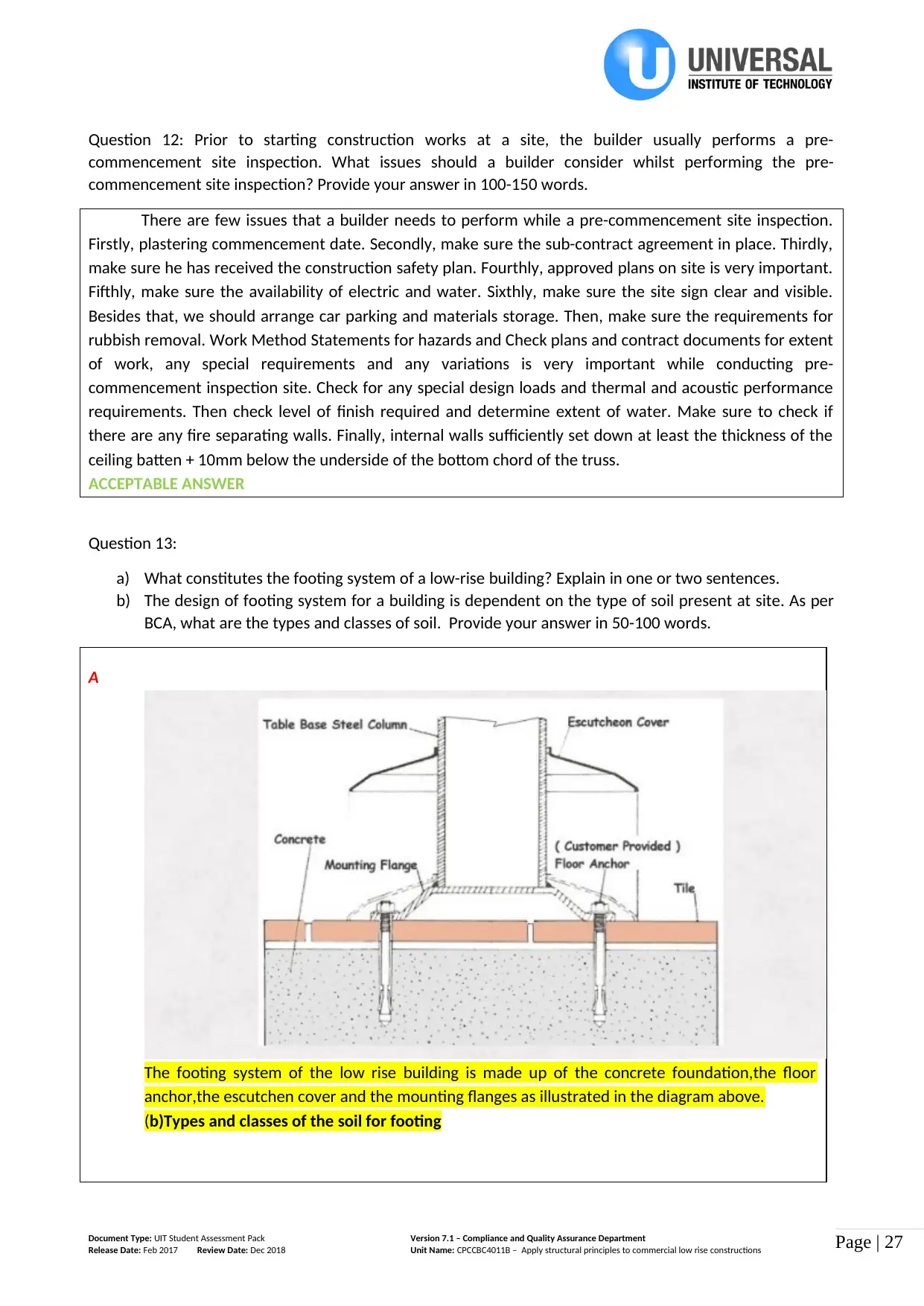
Page | 27
Question 12: Prior to starting construction works at a site, the builder usually performs a pre-
commencement site inspection. What issues should a builder consider whilst performing the pre-
commencement site inspection? Provide your answer in 100-150 words.
There are few issues that a builder needs to perform while a pre-commencement site inspection.
Firstly, plastering commencement date. Secondly, make sure the sub-contract agreement in place. Thirdly,
make sure he has received the construction safety plan. Fourthly, approved plans on site is very important.
Fifthly, make sure the availability of electric and water. Sixthly, make sure the site sign clear and visible.
Besides that, we should arrange car parking and materials storage. Then, make sure the requirements for
rubbish removal. Work Method Statements for hazards and Check plans and contract documents for extent
of work, any special requirements and any variations is very important while conducting pre-
commencement inspection site. Check for any special design loads and thermal and acoustic performance
requirements. Then check level of finish required and determine extent of water. Make sure to check if
there are any fire separating walls. Finally, internal walls sufficiently set down at least the thickness of the
ceiling batten + 10mm below the underside of the bottom chord of the truss.
ACCEPTABLE ANSWER
Question 13:
a) What constitutes the footing system of a low-rise building? Explain in one or two sentences.
b) The design of footing system for a building is dependent on the type of soil present at site. As per
BCA, what are the types and classes of soil. Provide your answer in 50-100 words.
A
The footing system of the low rise building is made up of the concrete foundation,the floor
anchor,the escutchen cover and the mounting flanges as illustrated in the diagram above.
(b)Types and classes of the soil for footing
Document Type: UIT Student Assessment Pack Version 7.1 – Compliance and Quality Assurance Department
Release Date: Feb 2017 Review Date: Dec 2018 Unit Name: CPCCBC4011B – Apply structural principles to commercial low rise constructions
Question 12: Prior to starting construction works at a site, the builder usually performs a pre-
commencement site inspection. What issues should a builder consider whilst performing the pre-
commencement site inspection? Provide your answer in 100-150 words.
There are few issues that a builder needs to perform while a pre-commencement site inspection.
Firstly, plastering commencement date. Secondly, make sure the sub-contract agreement in place. Thirdly,
make sure he has received the construction safety plan. Fourthly, approved plans on site is very important.
Fifthly, make sure the availability of electric and water. Sixthly, make sure the site sign clear and visible.
Besides that, we should arrange car parking and materials storage. Then, make sure the requirements for
rubbish removal. Work Method Statements for hazards and Check plans and contract documents for extent
of work, any special requirements and any variations is very important while conducting pre-
commencement inspection site. Check for any special design loads and thermal and acoustic performance
requirements. Then check level of finish required and determine extent of water. Make sure to check if
there are any fire separating walls. Finally, internal walls sufficiently set down at least the thickness of the
ceiling batten + 10mm below the underside of the bottom chord of the truss.
ACCEPTABLE ANSWER
Question 13:
a) What constitutes the footing system of a low-rise building? Explain in one or two sentences.
b) The design of footing system for a building is dependent on the type of soil present at site. As per
BCA, what are the types and classes of soil. Provide your answer in 50-100 words.
A
The footing system of the low rise building is made up of the concrete foundation,the floor
anchor,the escutchen cover and the mounting flanges as illustrated in the diagram above.
(b)Types and classes of the soil for footing
Document Type: UIT Student Assessment Pack Version 7.1 – Compliance and Quality Assurance Department
Release Date: Feb 2017 Review Date: Dec 2018 Unit Name: CPCCBC4011B – Apply structural principles to commercial low rise constructions
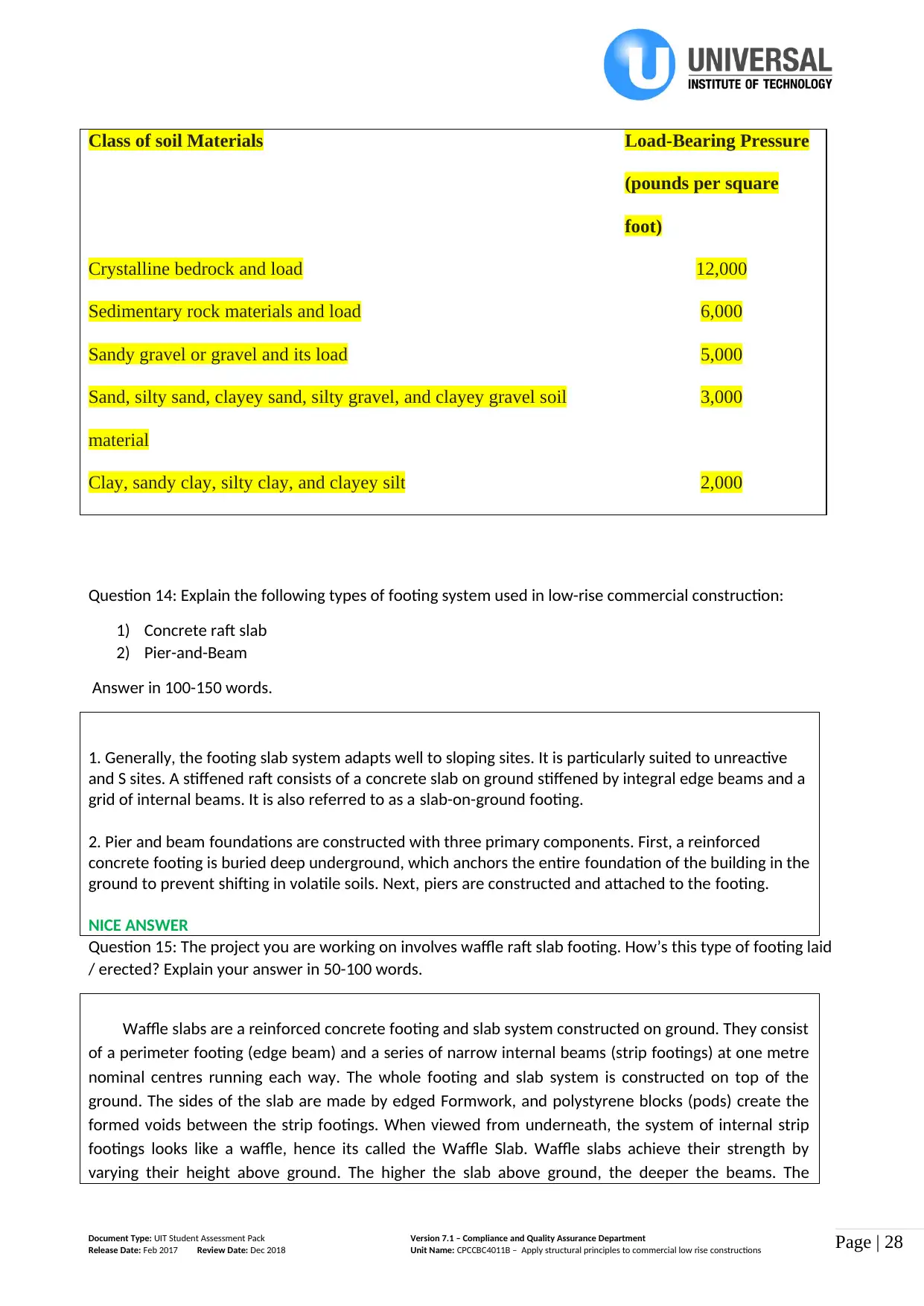
Page | 28
Class of soil Materials Load-Bearing Pressure
(pounds per square
foot)
Crystalline bedrock and load 12,000
Sedimentary rock materials and load 6,000
Sandy gravel or gravel and its load 5,000
Sand, silty sand, clayey sand, silty gravel, and clayey gravel soil
material
3,000
Clay, sandy clay, silty clay, and clayey silt 2,000
Question 14: Explain the following types of footing system used in low-rise commercial construction:
1) Concrete raft slab
2) Pier-and-Beam
Answer in 100-150 words.
1. Generally, the footing slab system adapts well to sloping sites. It is particularly suited to unreactive
and S sites. A stiffened raft consists of a concrete slab on ground stiffened by integral edge beams and a
grid of internal beams. It is also referred to as a slab-on-ground footing.
2. Pier and beam foundations are constructed with three primary components. First, a reinforced
concrete footing is buried deep underground, which anchors the entire foundation of the building in the
ground to prevent shifting in volatile soils. Next, piers are constructed and attached to the footing.
NICE ANSWER
Question 15: The project you are working on involves waffle raft slab footing. How’s this type of footing laid
/ erected? Explain your answer in 50-100 words.
Waffle slabs are a reinforced concrete footing and slab system constructed on ground. They consist
of a perimeter footing (edge beam) and a series of narrow internal beams (strip footings) at one metre
nominal centres running each way. The whole footing and slab system is constructed on top of the
ground. The sides of the slab are made by edged Formwork, and polystyrene blocks (pods) create the
formed voids between the strip footings. When viewed from underneath, the system of internal strip
footings looks like a waffle, hence its called the Waffle Slab. Waffle slabs achieve their strength by
varying their height above ground. The higher the slab above ground, the deeper the beams. The
Document Type: UIT Student Assessment Pack Version 7.1 – Compliance and Quality Assurance Department
Release Date: Feb 2017 Review Date: Dec 2018 Unit Name: CPCCBC4011B – Apply structural principles to commercial low rise constructions
Class of soil Materials Load-Bearing Pressure
(pounds per square
foot)
Crystalline bedrock and load 12,000
Sedimentary rock materials and load 6,000
Sandy gravel or gravel and its load 5,000
Sand, silty sand, clayey sand, silty gravel, and clayey gravel soil
material
3,000
Clay, sandy clay, silty clay, and clayey silt 2,000
Question 14: Explain the following types of footing system used in low-rise commercial construction:
1) Concrete raft slab
2) Pier-and-Beam
Answer in 100-150 words.
1. Generally, the footing slab system adapts well to sloping sites. It is particularly suited to unreactive
and S sites. A stiffened raft consists of a concrete slab on ground stiffened by integral edge beams and a
grid of internal beams. It is also referred to as a slab-on-ground footing.
2. Pier and beam foundations are constructed with three primary components. First, a reinforced
concrete footing is buried deep underground, which anchors the entire foundation of the building in the
ground to prevent shifting in volatile soils. Next, piers are constructed and attached to the footing.
NICE ANSWER
Question 15: The project you are working on involves waffle raft slab footing. How’s this type of footing laid
/ erected? Explain your answer in 50-100 words.
Waffle slabs are a reinforced concrete footing and slab system constructed on ground. They consist
of a perimeter footing (edge beam) and a series of narrow internal beams (strip footings) at one metre
nominal centres running each way. The whole footing and slab system is constructed on top of the
ground. The sides of the slab are made by edged Formwork, and polystyrene blocks (pods) create the
formed voids between the strip footings. When viewed from underneath, the system of internal strip
footings looks like a waffle, hence its called the Waffle Slab. Waffle slabs achieve their strength by
varying their height above ground. The higher the slab above ground, the deeper the beams. The
Document Type: UIT Student Assessment Pack Version 7.1 – Compliance and Quality Assurance Department
Release Date: Feb 2017 Review Date: Dec 2018 Unit Name: CPCCBC4011B – Apply structural principles to commercial low rise constructions
Secure Best Marks with AI Grader
Need help grading? Try our AI Grader for instant feedback on your assignments.
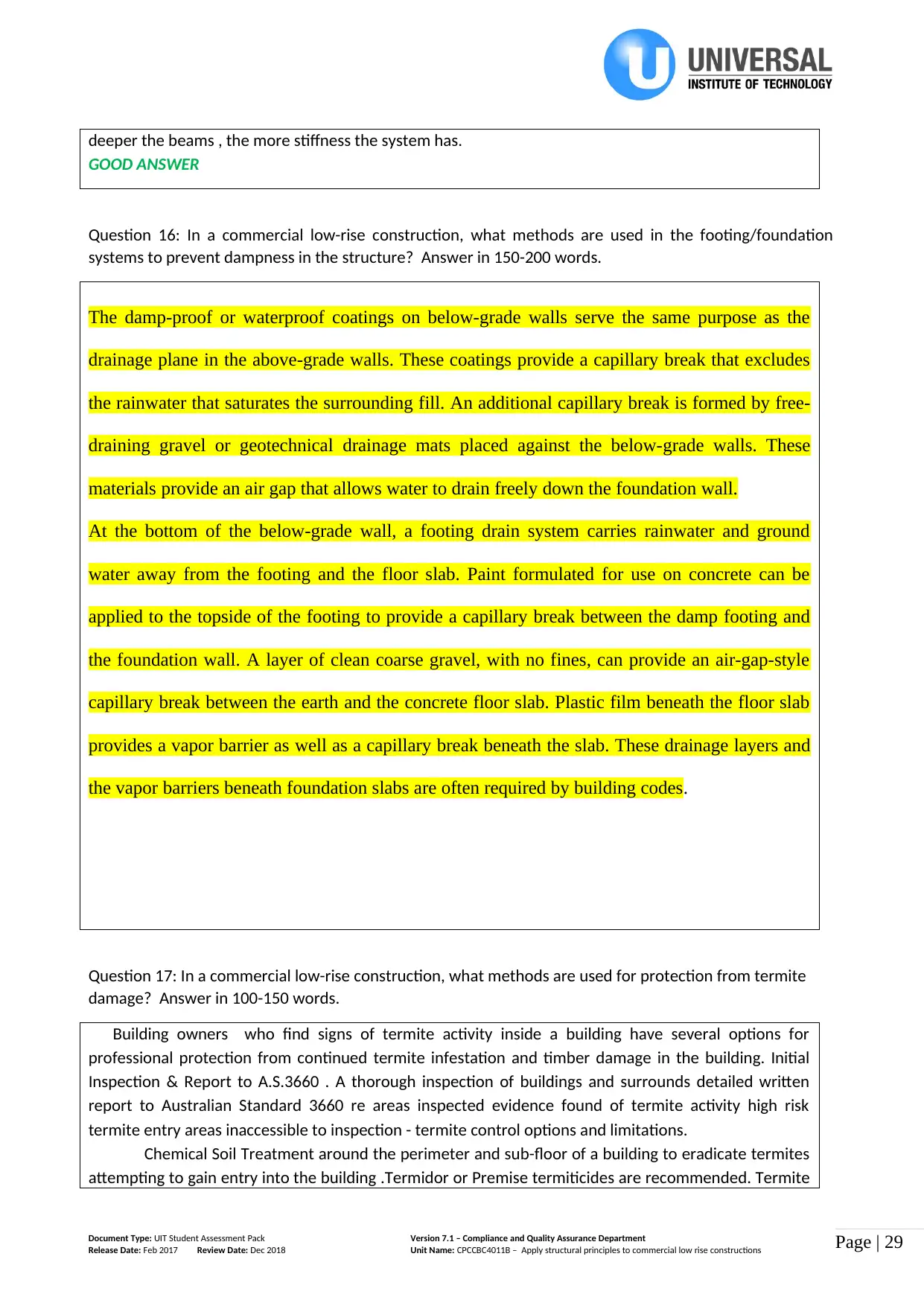
Page | 29
deeper the beams , the more stiffness the system has.
GOOD ANSWER
Question 16: In a commercial low-rise construction, what methods are used in the footing/foundation
systems to prevent dampness in the structure? Answer in 150-200 words.
The damp-proof or waterproof coatings on below-grade walls serve the same purpose as the
drainage plane in the above-grade walls. These coatings provide a capillary break that excludes
the rainwater that saturates the surrounding fill. An additional capillary break is formed by free-
draining gravel or geotechnical drainage mats placed against the below-grade walls. These
materials provide an air gap that allows water to drain freely down the foundation wall.
At the bottom of the below-grade wall, a footing drain system carries rainwater and ground
water away from the footing and the floor slab. Paint formulated for use on concrete can be
applied to the topside of the footing to provide a capillary break between the damp footing and
the foundation wall. A layer of clean coarse gravel, with no fines, can provide an air-gap-style
capillary break between the earth and the concrete floor slab. Plastic film beneath the floor slab
provides a vapor barrier as well as a capillary break beneath the slab. These drainage layers and
the vapor barriers beneath foundation slabs are often required by building codes.
Question 17: In a commercial low-rise construction, what methods are used for protection from termite
damage? Answer in 100-150 words.
Building owners who find signs of termite activity inside a building have several options for
professional protection from continued termite infestation and timber damage in the building. Initial
Inspection & Report to A.S.3660 . A thorough inspection of buildings and surrounds detailed written
report to Australian Standard 3660 re areas inspected evidence found of termite activity high risk
termite entry areas inaccessible to inspection - termite control options and limitations.
Chemical Soil Treatment around the perimeter and sub-floor of a building to eradicate termites
attempting to gain entry into the building .Termidor or Premise termiticides are recommended. Termite
Document Type: UIT Student Assessment Pack Version 7.1 – Compliance and Quality Assurance Department
Release Date: Feb 2017 Review Date: Dec 2018 Unit Name: CPCCBC4011B – Apply structural principles to commercial low rise constructions
deeper the beams , the more stiffness the system has.
GOOD ANSWER
Question 16: In a commercial low-rise construction, what methods are used in the footing/foundation
systems to prevent dampness in the structure? Answer in 150-200 words.
The damp-proof or waterproof coatings on below-grade walls serve the same purpose as the
drainage plane in the above-grade walls. These coatings provide a capillary break that excludes
the rainwater that saturates the surrounding fill. An additional capillary break is formed by free-
draining gravel or geotechnical drainage mats placed against the below-grade walls. These
materials provide an air gap that allows water to drain freely down the foundation wall.
At the bottom of the below-grade wall, a footing drain system carries rainwater and ground
water away from the footing and the floor slab. Paint formulated for use on concrete can be
applied to the topside of the footing to provide a capillary break between the damp footing and
the foundation wall. A layer of clean coarse gravel, with no fines, can provide an air-gap-style
capillary break between the earth and the concrete floor slab. Plastic film beneath the floor slab
provides a vapor barrier as well as a capillary break beneath the slab. These drainage layers and
the vapor barriers beneath foundation slabs are often required by building codes.
Question 17: In a commercial low-rise construction, what methods are used for protection from termite
damage? Answer in 100-150 words.
Building owners who find signs of termite activity inside a building have several options for
professional protection from continued termite infestation and timber damage in the building. Initial
Inspection & Report to A.S.3660 . A thorough inspection of buildings and surrounds detailed written
report to Australian Standard 3660 re areas inspected evidence found of termite activity high risk
termite entry areas inaccessible to inspection - termite control options and limitations.
Chemical Soil Treatment around the perimeter and sub-floor of a building to eradicate termites
attempting to gain entry into the building .Termidor or Premise termiticides are recommended. Termite
Document Type: UIT Student Assessment Pack Version 7.1 – Compliance and Quality Assurance Department
Release Date: Feb 2017 Review Date: Dec 2018 Unit Name: CPCCBC4011B – Apply structural principles to commercial low rise constructions

Page | 30
Baiting installation monitoring of termite bait stations. Nemesis Exterra Sentricon termite baits this
method relies heavily on the termites "finding" and consuming sufficient bait recommended in some
limited circumstances, particularly in areas where live termite activity is present. Building Modification
& Maintenance termite risk reduction measures may include improving subfloor ventilation removal of
timber in contact with the soil improving inspection access areas. Subsequent Inspections to A.S.3660 –
essential at least at 3 to 6 months intervals where signs of termite activity has been previously located
close by susceptible buildings or timber structures.
CHEMICAL METHODS ARE OK.
Physical methods
Metal ant capping
Historically metal ant caps have been used on brick piers and sub-floor walls under suspended
timber floors. Similarly, metal sheeting is often used through brick piers and masonry walls to
force termites to the outside but is not generally used in the industry any more as it has not
proven overly successful over time.
Metal sheeting is prone to rusting and sometimes they have been poorly installed – often nailed
to the pier, creating a hole that the termites can crawl through – making them useless.
Stainless steel mesh
Marine grade stainless steel mesh may also be used as a physical protection barrier to termites.
The size of the mesh openings is small enough to prevent termites passing through, this acting as
an effective barrier to termites. Mesh is commonly glued to slabs and masonry and may also be
used around pipes through slabs. As is the case with granite guard, this particular termite barrier
system has mostly become obsolete due to the advancement of termite membranes, which are
cheaper and more effective.
Document Type: UIT Student Assessment Pack Version 7.1 – Compliance and Quality Assurance Department
Release Date: Feb 2017 Review Date: Dec 2018 Unit Name: CPCCBC4011B – Apply structural principles to commercial low rise constructions
Baiting installation monitoring of termite bait stations. Nemesis Exterra Sentricon termite baits this
method relies heavily on the termites "finding" and consuming sufficient bait recommended in some
limited circumstances, particularly in areas where live termite activity is present. Building Modification
& Maintenance termite risk reduction measures may include improving subfloor ventilation removal of
timber in contact with the soil improving inspection access areas. Subsequent Inspections to A.S.3660 –
essential at least at 3 to 6 months intervals where signs of termite activity has been previously located
close by susceptible buildings or timber structures.
CHEMICAL METHODS ARE OK.
Physical methods
Metal ant capping
Historically metal ant caps have been used on brick piers and sub-floor walls under suspended
timber floors. Similarly, metal sheeting is often used through brick piers and masonry walls to
force termites to the outside but is not generally used in the industry any more as it has not
proven overly successful over time.
Metal sheeting is prone to rusting and sometimes they have been poorly installed – often nailed
to the pier, creating a hole that the termites can crawl through – making them useless.
Stainless steel mesh
Marine grade stainless steel mesh may also be used as a physical protection barrier to termites.
The size of the mesh openings is small enough to prevent termites passing through, this acting as
an effective barrier to termites. Mesh is commonly glued to slabs and masonry and may also be
used around pipes through slabs. As is the case with granite guard, this particular termite barrier
system has mostly become obsolete due to the advancement of termite membranes, which are
cheaper and more effective.
Document Type: UIT Student Assessment Pack Version 7.1 – Compliance and Quality Assurance Department
Release Date: Feb 2017 Review Date: Dec 2018 Unit Name: CPCCBC4011B – Apply structural principles to commercial low rise constructions
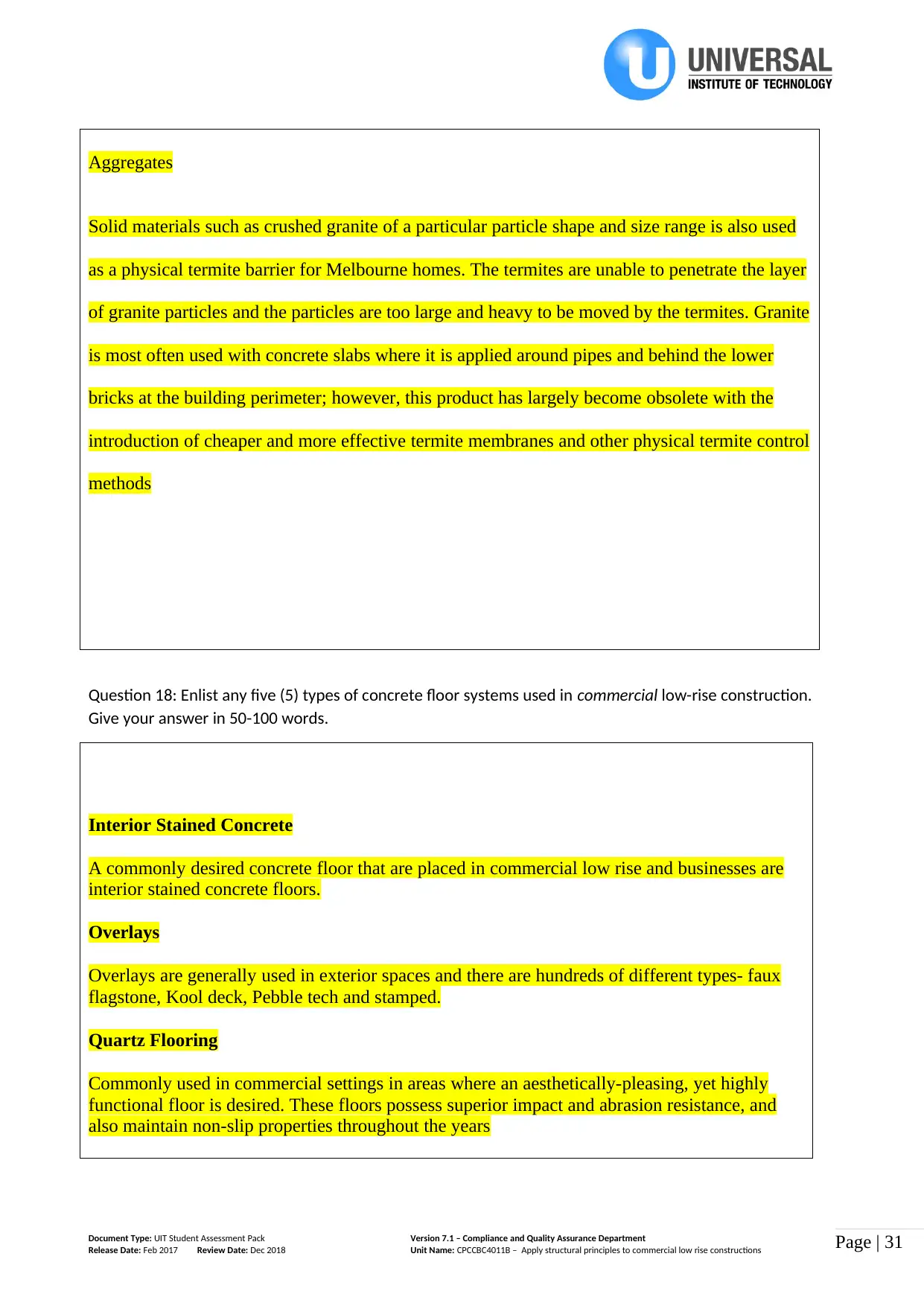
Page | 31
Aggregates
Solid materials such as crushed granite of a particular particle shape and size range is also used
as a physical termite barrier for Melbourne homes. The termites are unable to penetrate the layer
of granite particles and the particles are too large and heavy to be moved by the termites. Granite
is most often used with concrete slabs where it is applied around pipes and behind the lower
bricks at the building perimeter; however, this product has largely become obsolete with the
introduction of cheaper and more effective termite membranes and other physical termite control
methods
Question 18: Enlist any five (5) types of concrete floor systems used in commercial low-rise construction.
Give your answer in 50-100 words.
Interior Stained Concrete
A commonly desired concrete floor that are placed in commercial low rise and businesses are
interior stained concrete floors.
Overlays
Overlays are generally used in exterior spaces and there are hundreds of different types- faux
flagstone, Kool deck, Pebble tech and stamped.
Quartz Flooring
Commonly used in commercial settings in areas where an aesthetically-pleasing, yet highly
functional floor is desired. These floors possess superior impact and abrasion resistance, and
also maintain non-slip properties throughout the years
Document Type: UIT Student Assessment Pack Version 7.1 – Compliance and Quality Assurance Department
Release Date: Feb 2017 Review Date: Dec 2018 Unit Name: CPCCBC4011B – Apply structural principles to commercial low rise constructions
Aggregates
Solid materials such as crushed granite of a particular particle shape and size range is also used
as a physical termite barrier for Melbourne homes. The termites are unable to penetrate the layer
of granite particles and the particles are too large and heavy to be moved by the termites. Granite
is most often used with concrete slabs where it is applied around pipes and behind the lower
bricks at the building perimeter; however, this product has largely become obsolete with the
introduction of cheaper and more effective termite membranes and other physical termite control
methods
Question 18: Enlist any five (5) types of concrete floor systems used in commercial low-rise construction.
Give your answer in 50-100 words.
Interior Stained Concrete
A commonly desired concrete floor that are placed in commercial low rise and businesses are
interior stained concrete floors.
Overlays
Overlays are generally used in exterior spaces and there are hundreds of different types- faux
flagstone, Kool deck, Pebble tech and stamped.
Quartz Flooring
Commonly used in commercial settings in areas where an aesthetically-pleasing, yet highly
functional floor is desired. These floors possess superior impact and abrasion resistance, and
also maintain non-slip properties throughout the years
Document Type: UIT Student Assessment Pack Version 7.1 – Compliance and Quality Assurance Department
Release Date: Feb 2017 Review Date: Dec 2018 Unit Name: CPCCBC4011B – Apply structural principles to commercial low rise constructions
Paraphrase This Document
Need a fresh take? Get an instant paraphrase of this document with our AI Paraphraser
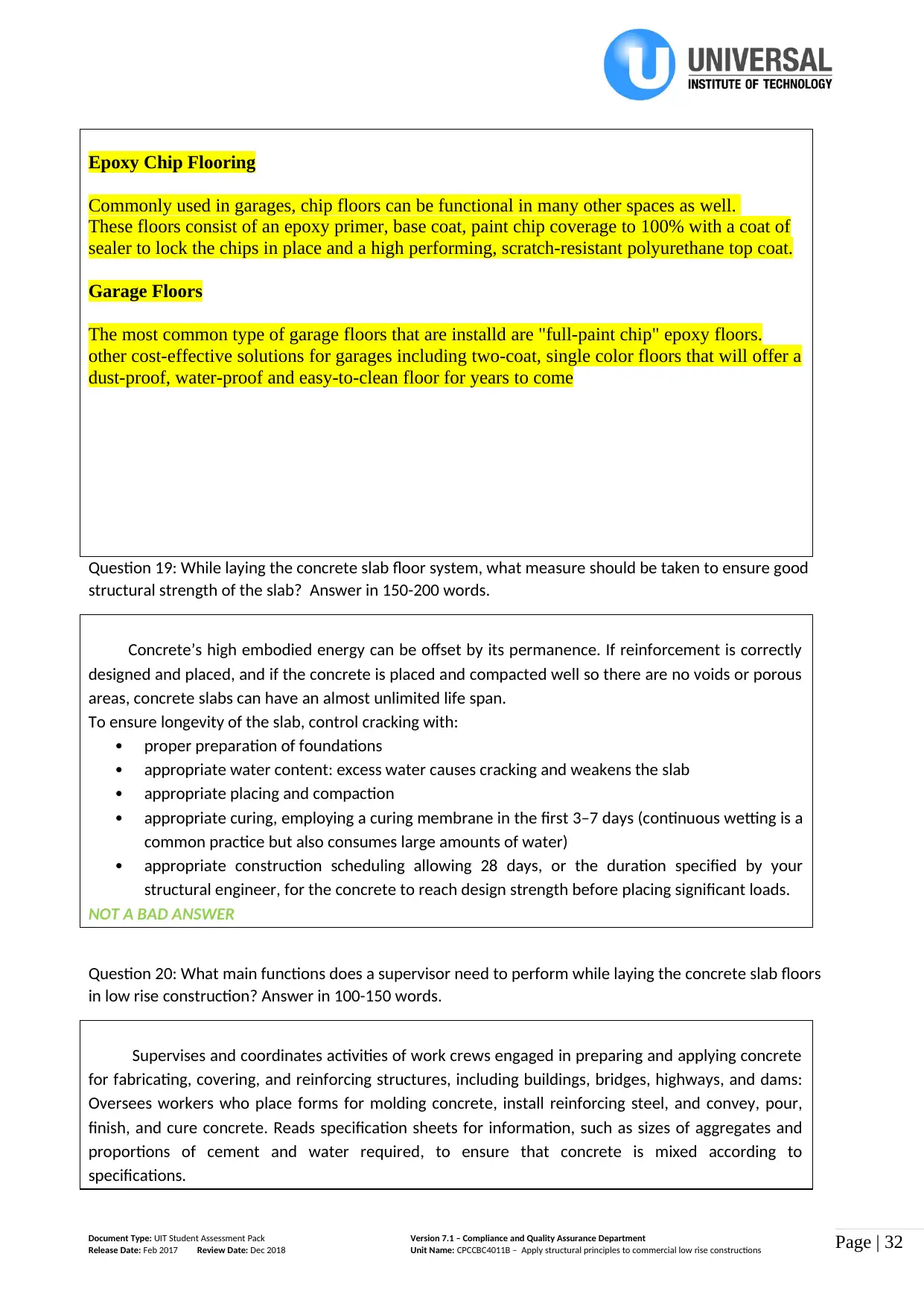
Page | 32
Epoxy Chip Flooring
Commonly used in garages, chip floors can be functional in many other spaces as well.
These floors consist of an epoxy primer, base coat, paint chip coverage to 100% with a coat of
sealer to lock the chips in place and a high performing, scratch-resistant polyurethane top coat.
Garage Floors
The most common type of garage floors that are installd are "full-paint chip" epoxy floors.
other cost-effective solutions for garages including two-coat, single color floors that will offer a
dust-proof, water-proof and easy-to-clean floor for years to come
Question 19: While laying the concrete slab floor system, what measure should be taken to ensure good
structural strength of the slab? Answer in 150-200 words.
Concrete’s high embodied energy can be offset by its permanence. If reinforcement is correctly
designed and placed, and if the concrete is placed and compacted well so there are no voids or porous
areas, concrete slabs can have an almost unlimited life span.
To ensure longevity of the slab, control cracking with:
proper preparation of foundations
appropriate water content: excess water causes cracking and weakens the slab
appropriate placing and compaction
appropriate curing, employing a curing membrane in the first 3–7 days (continuous wetting is a
common practice but also consumes large amounts of water)
appropriate construction scheduling allowing 28 days, or the duration specified by your
structural engineer, for the concrete to reach design strength before placing significant loads.
NOT A BAD ANSWER
Question 20: What main functions does a supervisor need to perform while laying the concrete slab floors
in low rise construction? Answer in 100-150 words.
Supervises and coordinates activities of work crews engaged in preparing and applying concrete
for fabricating, covering, and reinforcing structures, including buildings, bridges, highways, and dams:
Oversees workers who place forms for molding concrete, install reinforcing steel, and convey, pour,
finish, and cure concrete. Reads specification sheets for information, such as sizes of aggregates and
proportions of cement and water required, to ensure that concrete is mixed according to
specifications.
Document Type: UIT Student Assessment Pack Version 7.1 – Compliance and Quality Assurance Department
Release Date: Feb 2017 Review Date: Dec 2018 Unit Name: CPCCBC4011B – Apply structural principles to commercial low rise constructions
Epoxy Chip Flooring
Commonly used in garages, chip floors can be functional in many other spaces as well.
These floors consist of an epoxy primer, base coat, paint chip coverage to 100% with a coat of
sealer to lock the chips in place and a high performing, scratch-resistant polyurethane top coat.
Garage Floors
The most common type of garage floors that are installd are "full-paint chip" epoxy floors.
other cost-effective solutions for garages including two-coat, single color floors that will offer a
dust-proof, water-proof and easy-to-clean floor for years to come
Question 19: While laying the concrete slab floor system, what measure should be taken to ensure good
structural strength of the slab? Answer in 150-200 words.
Concrete’s high embodied energy can be offset by its permanence. If reinforcement is correctly
designed and placed, and if the concrete is placed and compacted well so there are no voids or porous
areas, concrete slabs can have an almost unlimited life span.
To ensure longevity of the slab, control cracking with:
proper preparation of foundations
appropriate water content: excess water causes cracking and weakens the slab
appropriate placing and compaction
appropriate curing, employing a curing membrane in the first 3–7 days (continuous wetting is a
common practice but also consumes large amounts of water)
appropriate construction scheduling allowing 28 days, or the duration specified by your
structural engineer, for the concrete to reach design strength before placing significant loads.
NOT A BAD ANSWER
Question 20: What main functions does a supervisor need to perform while laying the concrete slab floors
in low rise construction? Answer in 100-150 words.
Supervises and coordinates activities of work crews engaged in preparing and applying concrete
for fabricating, covering, and reinforcing structures, including buildings, bridges, highways, and dams:
Oversees workers who place forms for molding concrete, install reinforcing steel, and convey, pour,
finish, and cure concrete. Reads specification sheets for information, such as sizes of aggregates and
proportions of cement and water required, to ensure that concrete is mixed according to
specifications.
Document Type: UIT Student Assessment Pack Version 7.1 – Compliance and Quality Assurance Department
Release Date: Feb 2017 Review Date: Dec 2018 Unit Name: CPCCBC4011B – Apply structural principles to commercial low rise constructions
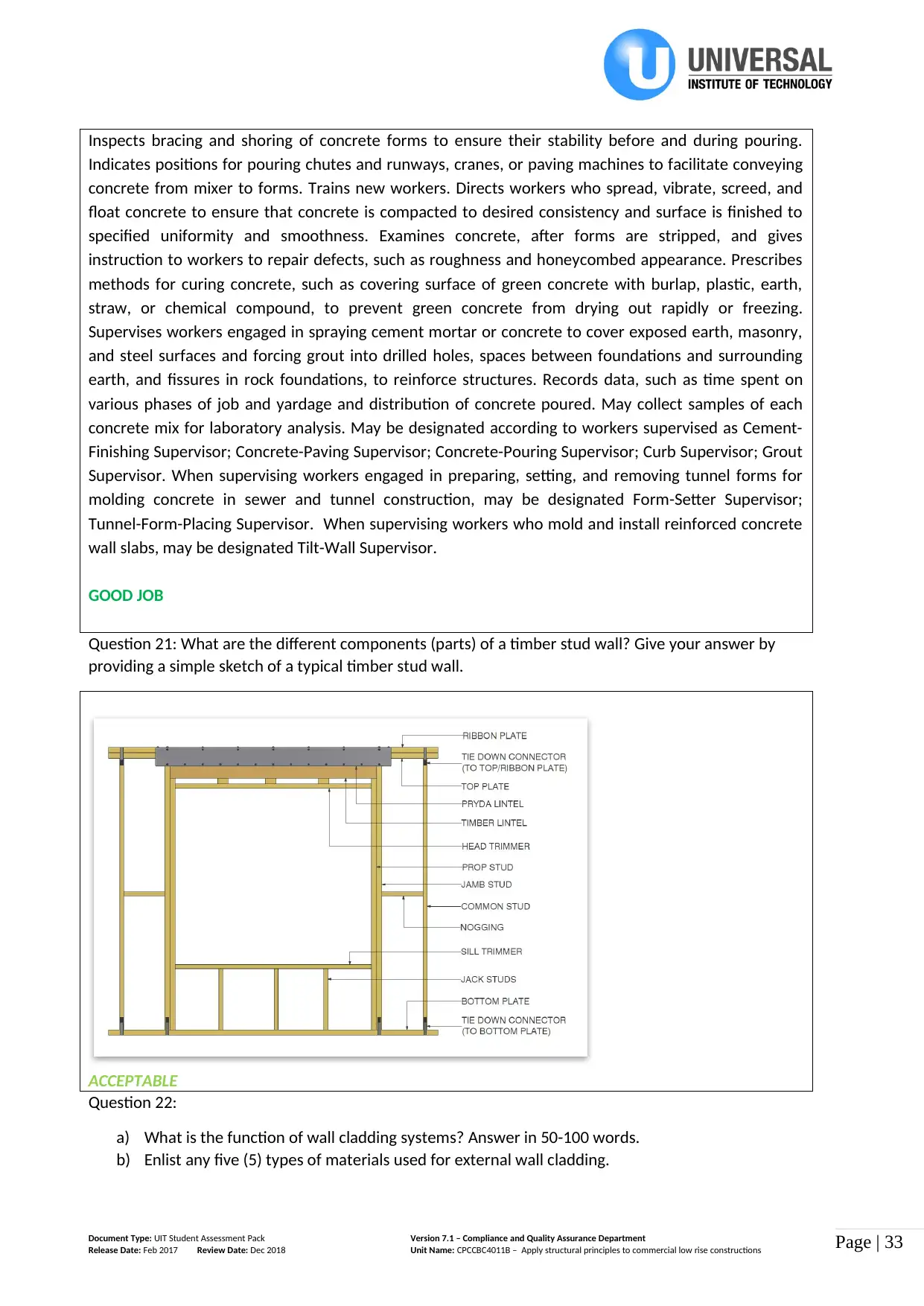
Page | 33
Inspects bracing and shoring of concrete forms to ensure their stability before and during pouring.
Indicates positions for pouring chutes and runways, cranes, or paving machines to facilitate conveying
concrete from mixer to forms. Trains new workers. Directs workers who spread, vibrate, screed, and
float concrete to ensure that concrete is compacted to desired consistency and surface is finished to
specified uniformity and smoothness. Examines concrete, after forms are stripped, and gives
instruction to workers to repair defects, such as roughness and honeycombed appearance. Prescribes
methods for curing concrete, such as covering surface of green concrete with burlap, plastic, earth,
straw, or chemical compound, to prevent green concrete from drying out rapidly or freezing.
Supervises workers engaged in spraying cement mortar or concrete to cover exposed earth, masonry,
and steel surfaces and forcing grout into drilled holes, spaces between foundations and surrounding
earth, and fissures in rock foundations, to reinforce structures. Records data, such as time spent on
various phases of job and yardage and distribution of concrete poured. May collect samples of each
concrete mix for laboratory analysis. May be designated according to workers supervised as Cement-
Finishing Supervisor; Concrete-Paving Supervisor; Concrete-Pouring Supervisor; Curb Supervisor; Grout
Supervisor. When supervising workers engaged in preparing, setting, and removing tunnel forms for
molding concrete in sewer and tunnel construction, may be designated Form-Setter Supervisor;
Tunnel-Form-Placing Supervisor. When supervising workers who mold and install reinforced concrete
wall slabs, may be designated Tilt-Wall Supervisor.
GOOD JOB
Question 21: What are the different components (parts) of a timber stud wall? Give your answer by
providing a simple sketch of a typical timber stud wall.
ACCEPTABLE
Question 22:
a) What is the function of wall cladding systems? Answer in 50-100 words.
b) Enlist any five (5) types of materials used for external wall cladding.
Document Type: UIT Student Assessment Pack Version 7.1 – Compliance and Quality Assurance Department
Release Date: Feb 2017 Review Date: Dec 2018 Unit Name: CPCCBC4011B – Apply structural principles to commercial low rise constructions
Inspects bracing and shoring of concrete forms to ensure their stability before and during pouring.
Indicates positions for pouring chutes and runways, cranes, or paving machines to facilitate conveying
concrete from mixer to forms. Trains new workers. Directs workers who spread, vibrate, screed, and
float concrete to ensure that concrete is compacted to desired consistency and surface is finished to
specified uniformity and smoothness. Examines concrete, after forms are stripped, and gives
instruction to workers to repair defects, such as roughness and honeycombed appearance. Prescribes
methods for curing concrete, such as covering surface of green concrete with burlap, plastic, earth,
straw, or chemical compound, to prevent green concrete from drying out rapidly or freezing.
Supervises workers engaged in spraying cement mortar or concrete to cover exposed earth, masonry,
and steel surfaces and forcing grout into drilled holes, spaces between foundations and surrounding
earth, and fissures in rock foundations, to reinforce structures. Records data, such as time spent on
various phases of job and yardage and distribution of concrete poured. May collect samples of each
concrete mix for laboratory analysis. May be designated according to workers supervised as Cement-
Finishing Supervisor; Concrete-Paving Supervisor; Concrete-Pouring Supervisor; Curb Supervisor; Grout
Supervisor. When supervising workers engaged in preparing, setting, and removing tunnel forms for
molding concrete in sewer and tunnel construction, may be designated Form-Setter Supervisor;
Tunnel-Form-Placing Supervisor. When supervising workers who mold and install reinforced concrete
wall slabs, may be designated Tilt-Wall Supervisor.
GOOD JOB
Question 21: What are the different components (parts) of a timber stud wall? Give your answer by
providing a simple sketch of a typical timber stud wall.
ACCEPTABLE
Question 22:
a) What is the function of wall cladding systems? Answer in 50-100 words.
b) Enlist any five (5) types of materials used for external wall cladding.
Document Type: UIT Student Assessment Pack Version 7.1 – Compliance and Quality Assurance Department
Release Date: Feb 2017 Review Date: Dec 2018 Unit Name: CPCCBC4011B – Apply structural principles to commercial low rise constructions
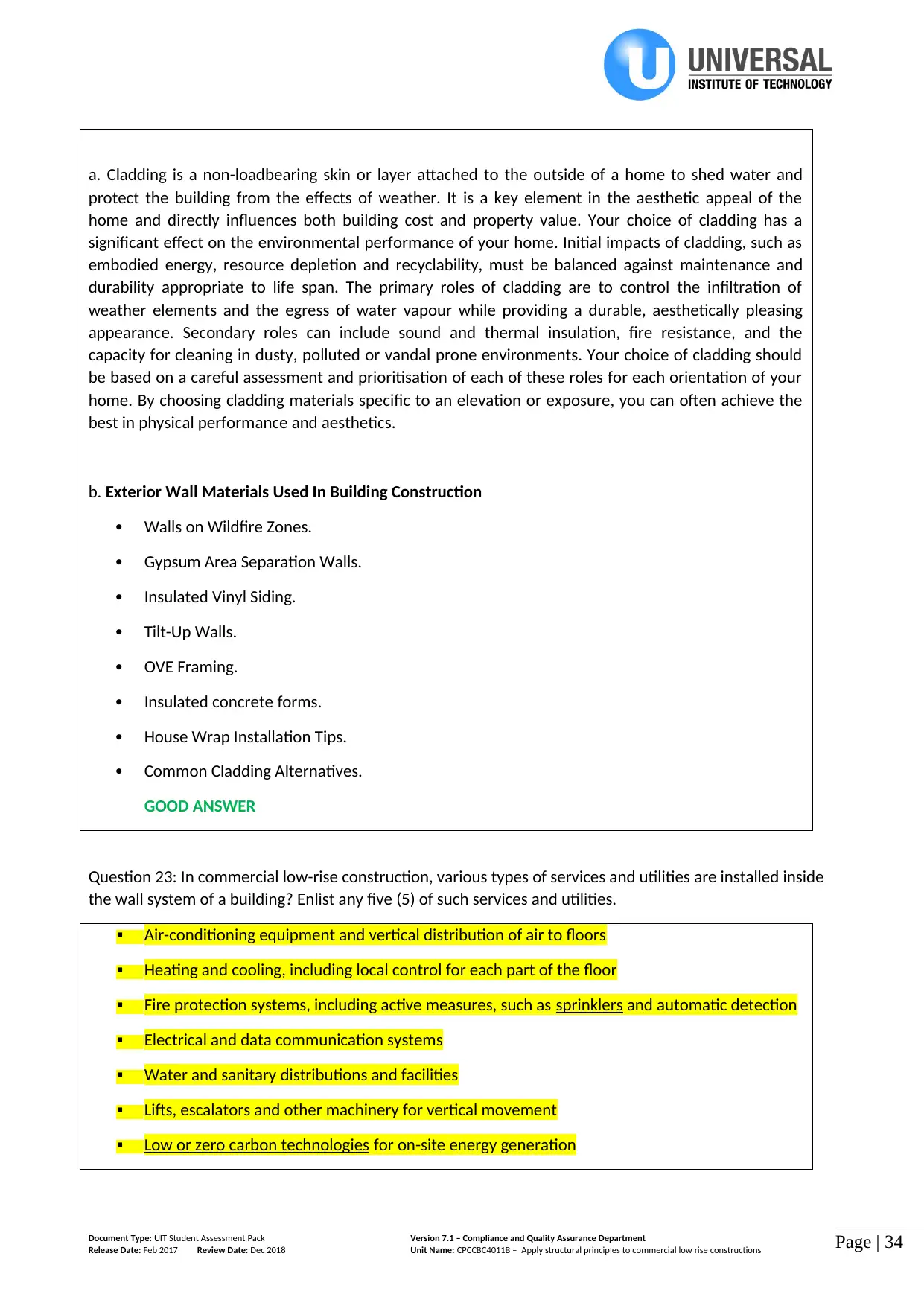
Page | 34
a. Cladding is a non-loadbearing skin or layer attached to the outside of a home to shed water and
protect the building from the effects of weather. It is a key element in the aesthetic appeal of the
home and directly influences both building cost and property value. Your choice of cladding has a
significant effect on the environmental performance of your home. Initial impacts of cladding, such as
embodied energy, resource depletion and recyclability, must be balanced against maintenance and
durability appropriate to life span. The primary roles of cladding are to control the infiltration of
weather elements and the egress of water vapour while providing a durable, aesthetically pleasing
appearance. Secondary roles can include sound and thermal insulation, fire resistance, and the
capacity for cleaning in dusty, polluted or vandal prone environments. Your choice of cladding should
be based on a careful assessment and prioritisation of each of these roles for each orientation of your
home. By choosing cladding materials specific to an elevation or exposure, you can often achieve the
best in physical performance and aesthetics.
b. Exterior Wall Materials Used In Building Construction
Walls on Wildfire Zones.
Gypsum Area Separation Walls.
Insulated Vinyl Siding.
Tilt-Up Walls.
OVE Framing.
Insulated concrete forms.
House Wrap Installation Tips.
Common Cladding Alternatives.
GOOD ANSWER
Question 23: In commercial low-rise construction, various types of services and utilities are installed inside
the wall system of a building? Enlist any five (5) of such services and utilities.
Air-conditioning equipment and vertical distribution of air to floors
Heating and cooling, including local control for each part of the floor
Fire protection systems, including active measures, such as sprinklers and automatic detection
Electrical and data communication systems
Water and sanitary distributions and facilities
Lifts, escalators and other machinery for vertical movement
Low or zero carbon technologies for on-site energy generation
Document Type: UIT Student Assessment Pack Version 7.1 – Compliance and Quality Assurance Department
Release Date: Feb 2017 Review Date: Dec 2018 Unit Name: CPCCBC4011B – Apply structural principles to commercial low rise constructions
a. Cladding is a non-loadbearing skin or layer attached to the outside of a home to shed water and
protect the building from the effects of weather. It is a key element in the aesthetic appeal of the
home and directly influences both building cost and property value. Your choice of cladding has a
significant effect on the environmental performance of your home. Initial impacts of cladding, such as
embodied energy, resource depletion and recyclability, must be balanced against maintenance and
durability appropriate to life span. The primary roles of cladding are to control the infiltration of
weather elements and the egress of water vapour while providing a durable, aesthetically pleasing
appearance. Secondary roles can include sound and thermal insulation, fire resistance, and the
capacity for cleaning in dusty, polluted or vandal prone environments. Your choice of cladding should
be based on a careful assessment and prioritisation of each of these roles for each orientation of your
home. By choosing cladding materials specific to an elevation or exposure, you can often achieve the
best in physical performance and aesthetics.
b. Exterior Wall Materials Used In Building Construction
Walls on Wildfire Zones.
Gypsum Area Separation Walls.
Insulated Vinyl Siding.
Tilt-Up Walls.
OVE Framing.
Insulated concrete forms.
House Wrap Installation Tips.
Common Cladding Alternatives.
GOOD ANSWER
Question 23: In commercial low-rise construction, various types of services and utilities are installed inside
the wall system of a building? Enlist any five (5) of such services and utilities.
Air-conditioning equipment and vertical distribution of air to floors
Heating and cooling, including local control for each part of the floor
Fire protection systems, including active measures, such as sprinklers and automatic detection
Electrical and data communication systems
Water and sanitary distributions and facilities
Lifts, escalators and other machinery for vertical movement
Low or zero carbon technologies for on-site energy generation
Document Type: UIT Student Assessment Pack Version 7.1 – Compliance and Quality Assurance Department
Release Date: Feb 2017 Review Date: Dec 2018 Unit Name: CPCCBC4011B – Apply structural principles to commercial low rise constructions
Secure Best Marks with AI Grader
Need help grading? Try our AI Grader for instant feedback on your assignments.
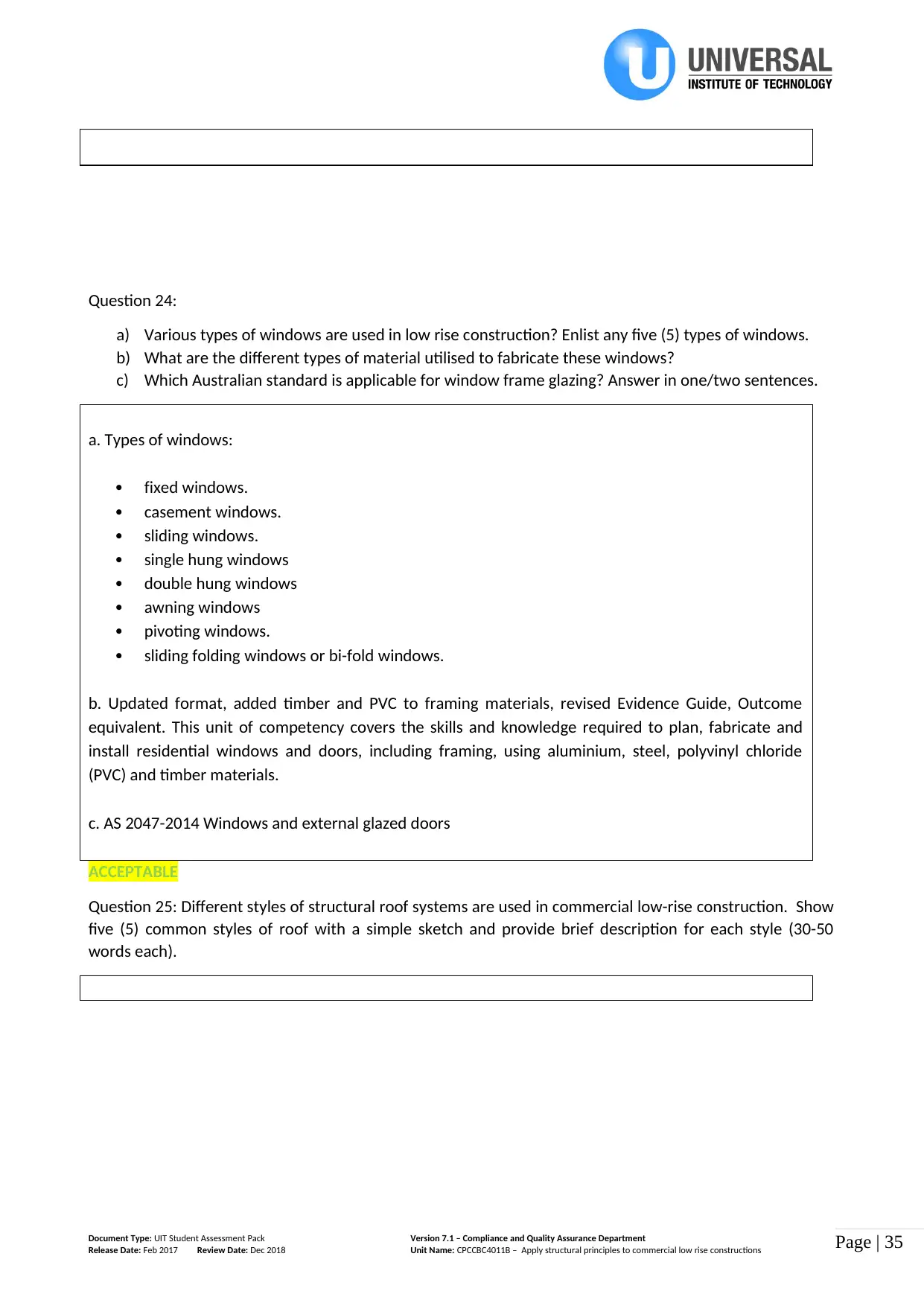
Page | 35
Question 24:
a) Various types of windows are used in low rise construction? Enlist any five (5) types of windows.
b) What are the different types of material utilised to fabricate these windows?
c) Which Australian standard is applicable for window frame glazing? Answer in one/two sentences.
a. Types of windows:
fixed windows.
casement windows.
sliding windows.
single hung windows
double hung windows
awning windows
pivoting windows.
sliding folding windows or bi-fold windows.
b. Updated format, added timber and PVC to framing materials, revised Evidence Guide, Outcome
equivalent. This unit of competency covers the skills and knowledge required to plan, fabricate and
install residential windows and doors, including framing, using aluminium, steel, polyvinyl chloride
(PVC) and timber materials.
c. AS 2047-2014 Windows and external glazed doors
ACCEPTABLE
Question 25: Different styles of structural roof systems are used in commercial low-rise construction. Show
five (5) common styles of roof with a simple sketch and provide brief description for each style (30-50
words each).
Document Type: UIT Student Assessment Pack Version 7.1 – Compliance and Quality Assurance Department
Release Date: Feb 2017 Review Date: Dec 2018 Unit Name: CPCCBC4011B – Apply structural principles to commercial low rise constructions
Question 24:
a) Various types of windows are used in low rise construction? Enlist any five (5) types of windows.
b) What are the different types of material utilised to fabricate these windows?
c) Which Australian standard is applicable for window frame glazing? Answer in one/two sentences.
a. Types of windows:
fixed windows.
casement windows.
sliding windows.
single hung windows
double hung windows
awning windows
pivoting windows.
sliding folding windows or bi-fold windows.
b. Updated format, added timber and PVC to framing materials, revised Evidence Guide, Outcome
equivalent. This unit of competency covers the skills and knowledge required to plan, fabricate and
install residential windows and doors, including framing, using aluminium, steel, polyvinyl chloride
(PVC) and timber materials.
c. AS 2047-2014 Windows and external glazed doors
ACCEPTABLE
Question 25: Different styles of structural roof systems are used in commercial low-rise construction. Show
five (5) common styles of roof with a simple sketch and provide brief description for each style (30-50
words each).
Document Type: UIT Student Assessment Pack Version 7.1 – Compliance and Quality Assurance Department
Release Date: Feb 2017 Review Date: Dec 2018 Unit Name: CPCCBC4011B – Apply structural principles to commercial low rise constructions

Page | 36
1. A- Frame roof
A-frame. Any upright, rigid supporting frame in the form of a triangle or an inverted V, as V. a building
constructed principally of such a frame, with a steep gabled roof resting directly on a foundation.
2. Bonnet roof
A roof having a double slope on all four sides, the lower slope being less steep than the upper slope;
often extends over an open-sided raised porch to provide excellent shade for the house and protection
against rain.
3. Butterfly roof
A butterfly roof is a form of roof characterised by an inversion of a standard roof form, with two roof
surfaces sloping down from opposing edges to a valley near the middle of the roof. It is so called
because its shape resembles a butterfly's wings.
4. Gable and Valley roof
A hip roof, hip-roof or hipped roof, is a type of roof where all sides slope downwards to the walls,
usually with a fairly gentle slope (although a tented roof by definition is a hipped roof with steeply
pitched slopes rising to a peak). Thus a hipped roof house has no gables or other vertical sides to the
roof.
5. Flat roof
A flat roof is a roof which is almost level in contrast to the many types of sloped roofs. The slope of a
roof is properly known as its pitch and flat roofs have up to approximately 10°. Flat roofs are an ancient
form mostly used in arid climates and allow the roof space to be used as a living space or a living roof.
6. Gable roof with dormer window
Dormer, in architecture, a vertical window that projects from a sloping roof and usually illuminates a
bedroom. The term derives from the Latin dormitories, “sleeping room.” Dormers are set either on the
face of the wall or high upon the roof, and their roofs may be gabled, hipped, flat, or with one slope.
Document Type: UIT Student Assessment Pack Version 7.1 – Compliance and Quality Assurance Department
Release Date: Feb 2017 Review Date: Dec 2018 Unit Name: CPCCBC4011B – Apply structural principles to commercial low rise constructions
1. A- Frame roof
A-frame. Any upright, rigid supporting frame in the form of a triangle or an inverted V, as V. a building
constructed principally of such a frame, with a steep gabled roof resting directly on a foundation.
2. Bonnet roof
A roof having a double slope on all four sides, the lower slope being less steep than the upper slope;
often extends over an open-sided raised porch to provide excellent shade for the house and protection
against rain.
3. Butterfly roof
A butterfly roof is a form of roof characterised by an inversion of a standard roof form, with two roof
surfaces sloping down from opposing edges to a valley near the middle of the roof. It is so called
because its shape resembles a butterfly's wings.
4. Gable and Valley roof
A hip roof, hip-roof or hipped roof, is a type of roof where all sides slope downwards to the walls,
usually with a fairly gentle slope (although a tented roof by definition is a hipped roof with steeply
pitched slopes rising to a peak). Thus a hipped roof house has no gables or other vertical sides to the
roof.
5. Flat roof
A flat roof is a roof which is almost level in contrast to the many types of sloped roofs. The slope of a
roof is properly known as its pitch and flat roofs have up to approximately 10°. Flat roofs are an ancient
form mostly used in arid climates and allow the roof space to be used as a living space or a living roof.
6. Gable roof with dormer window
Dormer, in architecture, a vertical window that projects from a sloping roof and usually illuminates a
bedroom. The term derives from the Latin dormitories, “sleeping room.” Dormers are set either on the
face of the wall or high upon the roof, and their roofs may be gabled, hipped, flat, or with one slope.
Document Type: UIT Student Assessment Pack Version 7.1 – Compliance and Quality Assurance Department
Release Date: Feb 2017 Review Date: Dec 2018 Unit Name: CPCCBC4011B – Apply structural principles to commercial low rise constructions
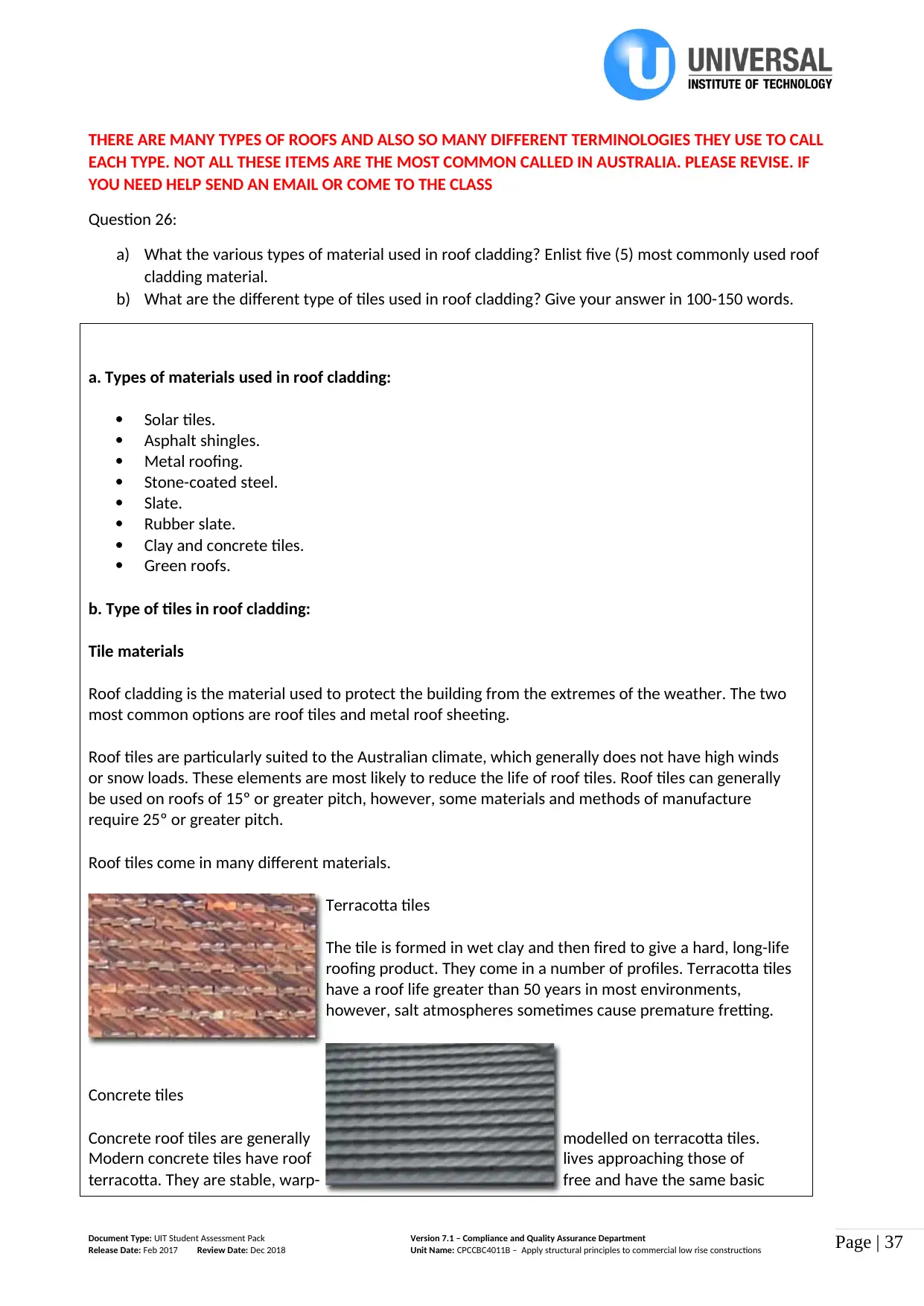
Page | 37
THERE ARE MANY TYPES OF ROOFS AND ALSO SO MANY DIFFERENT TERMINOLOGIES THEY USE TO CALL
EACH TYPE. NOT ALL THESE ITEMS ARE THE MOST COMMON CALLED IN AUSTRALIA. PLEASE REVISE. IF
YOU NEED HELP SEND AN EMAIL OR COME TO THE CLASS
Question 26:
a) What the various types of material used in roof cladding? Enlist five (5) most commonly used roof
cladding material.
b) What are the different type of tiles used in roof cladding? Give your answer in 100-150 words.
a. Types of materials used in roof cladding:
Solar tiles.
Asphalt shingles.
Metal roofing.
Stone-coated steel.
Slate.
Rubber slate.
Clay and concrete tiles.
Green roofs.
b. Type of tiles in roof cladding:
Tile materials
Roof cladding is the material used to protect the building from the extremes of the weather. The two
most common options are roof tiles and metal roof sheeting.
Roof tiles are particularly suited to the Australian climate, which generally does not have high winds
or snow loads. These elements are most likely to reduce the life of roof tiles. Roof tiles can generally
be used on roofs of 15º or greater pitch, however, some materials and methods of manufacture
require 25º or greater pitch.
Roof tiles come in many different materials.
Terracotta tiles
The tile is formed in wet clay and then fired to give a hard, long-life
roofing product. They come in a number of profiles. Terracotta tiles
have a roof life greater than 50 years in most environments,
however, salt atmospheres sometimes cause premature fretting.
Concrete tiles
Concrete roof tiles are generally modelled on terracotta tiles.
Modern concrete tiles have roof lives approaching those of
terracotta. They are stable, warp- free and have the same basic
Document Type: UIT Student Assessment Pack Version 7.1 – Compliance and Quality Assurance Department
Release Date: Feb 2017 Review Date: Dec 2018 Unit Name: CPCCBC4011B – Apply structural principles to commercial low rise constructions
THERE ARE MANY TYPES OF ROOFS AND ALSO SO MANY DIFFERENT TERMINOLOGIES THEY USE TO CALL
EACH TYPE. NOT ALL THESE ITEMS ARE THE MOST COMMON CALLED IN AUSTRALIA. PLEASE REVISE. IF
YOU NEED HELP SEND AN EMAIL OR COME TO THE CLASS
Question 26:
a) What the various types of material used in roof cladding? Enlist five (5) most commonly used roof
cladding material.
b) What are the different type of tiles used in roof cladding? Give your answer in 100-150 words.
a. Types of materials used in roof cladding:
Solar tiles.
Asphalt shingles.
Metal roofing.
Stone-coated steel.
Slate.
Rubber slate.
Clay and concrete tiles.
Green roofs.
b. Type of tiles in roof cladding:
Tile materials
Roof cladding is the material used to protect the building from the extremes of the weather. The two
most common options are roof tiles and metal roof sheeting.
Roof tiles are particularly suited to the Australian climate, which generally does not have high winds
or snow loads. These elements are most likely to reduce the life of roof tiles. Roof tiles can generally
be used on roofs of 15º or greater pitch, however, some materials and methods of manufacture
require 25º or greater pitch.
Roof tiles come in many different materials.
Terracotta tiles
The tile is formed in wet clay and then fired to give a hard, long-life
roofing product. They come in a number of profiles. Terracotta tiles
have a roof life greater than 50 years in most environments,
however, salt atmospheres sometimes cause premature fretting.
Concrete tiles
Concrete roof tiles are generally modelled on terracotta tiles.
Modern concrete tiles have roof lives approaching those of
terracotta. They are stable, warp- free and have the same basic
Document Type: UIT Student Assessment Pack Version 7.1 – Compliance and Quality Assurance Department
Release Date: Feb 2017 Review Date: Dec 2018 Unit Name: CPCCBC4011B – Apply structural principles to commercial low rise constructions
Paraphrase This Document
Need a fresh take? Get an instant paraphrase of this document with our AI Paraphraser
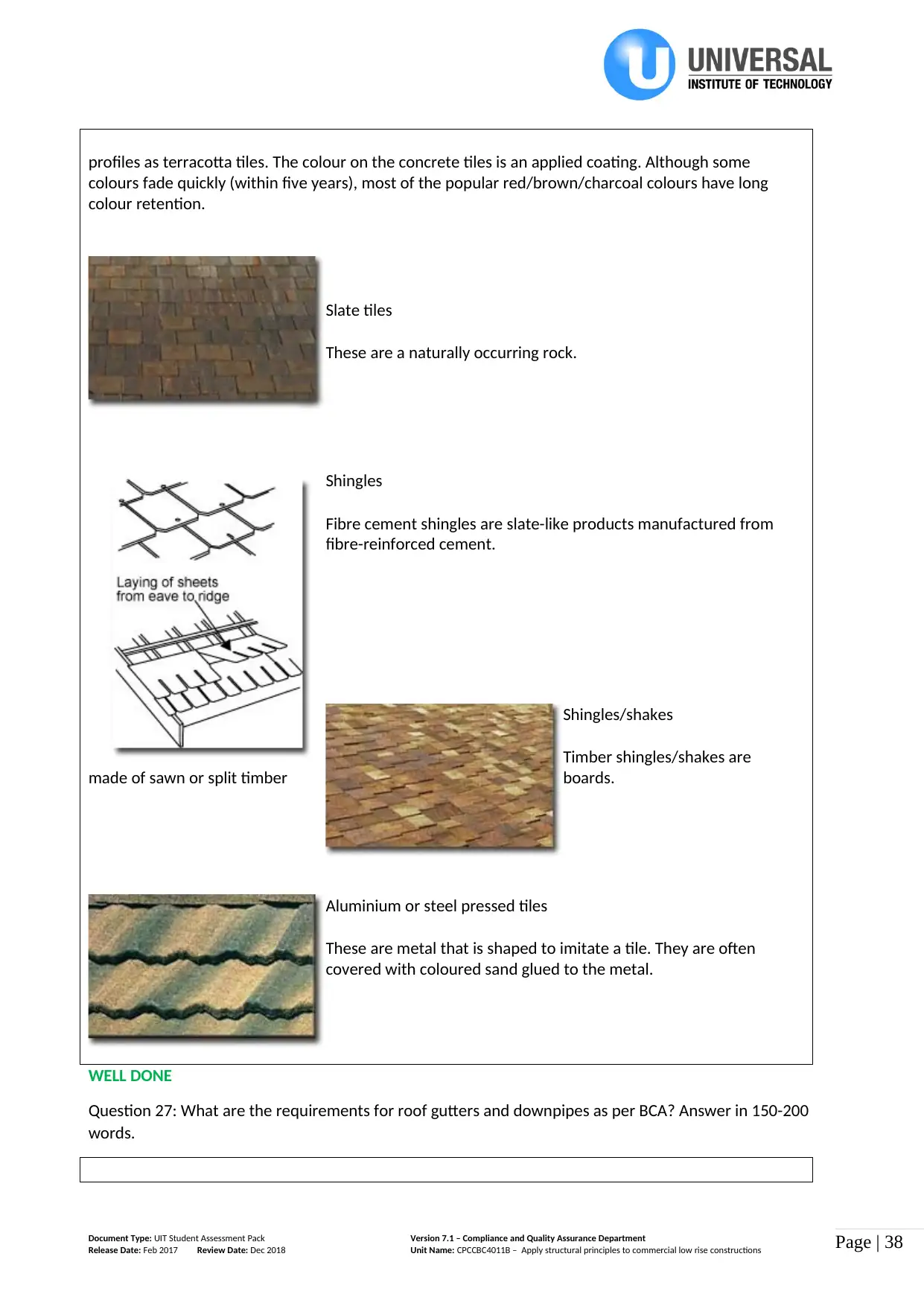
Page | 38
profiles as terracotta tiles. The colour on the concrete tiles is an applied coating. Although some
colours fade quickly (within five years), most of the popular red/brown/charcoal colours have long
colour retention.
Slate tiles
These are a naturally occurring rock.
Shingles
Fibre cement shingles are slate-like products manufactured from
fibre-reinforced cement.
Shingles/shakes
Timber shingles/shakes are
made of sawn or split timber boards.
Aluminium or steel pressed tiles
These are metal that is shaped to imitate a tile. They are often
covered with coloured sand glued to the metal.
WELL DONE
Question 27: What are the requirements for roof gutters and downpipes as per BCA? Answer in 150-200
words.
Document Type: UIT Student Assessment Pack Version 7.1 – Compliance and Quality Assurance Department
Release Date: Feb 2017 Review Date: Dec 2018 Unit Name: CPCCBC4011B – Apply structural principles to commercial low rise constructions
profiles as terracotta tiles. The colour on the concrete tiles is an applied coating. Although some
colours fade quickly (within five years), most of the popular red/brown/charcoal colours have long
colour retention.
Slate tiles
These are a naturally occurring rock.
Shingles
Fibre cement shingles are slate-like products manufactured from
fibre-reinforced cement.
Shingles/shakes
Timber shingles/shakes are
made of sawn or split timber boards.
Aluminium or steel pressed tiles
These are metal that is shaped to imitate a tile. They are often
covered with coloured sand glued to the metal.
WELL DONE
Question 27: What are the requirements for roof gutters and downpipes as per BCA? Answer in 150-200
words.
Document Type: UIT Student Assessment Pack Version 7.1 – Compliance and Quality Assurance Department
Release Date: Feb 2017 Review Date: Dec 2018 Unit Name: CPCCBC4011B – Apply structural principles to commercial low rise constructions
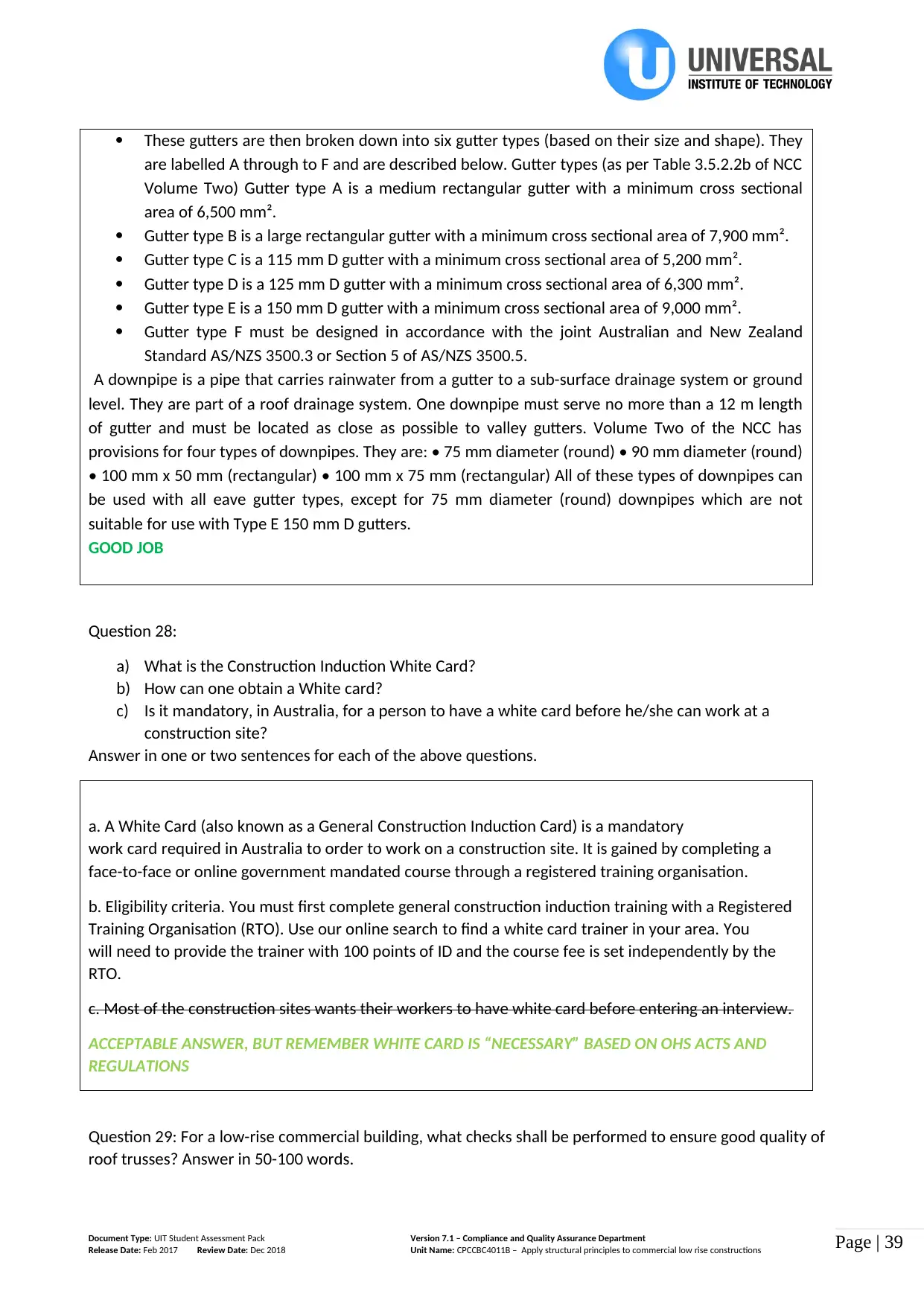
Page | 39
These gutters are then broken down into six gutter types (based on their size and shape). They
are labelled A through to F and are described below. Gutter types (as per Table 3.5.2.2b of NCC
Volume Two) Gutter type A is a medium rectangular gutter with a minimum cross sectional
area of 6,500 mm².
Gutter type B is a large rectangular gutter with a minimum cross sectional area of 7,900 mm².
Gutter type C is a 115 mm D gutter with a minimum cross sectional area of 5,200 mm².
Gutter type D is a 125 mm D gutter with a minimum cross sectional area of 6,300 mm².
Gutter type E is a 150 mm D gutter with a minimum cross sectional area of 9,000 mm².
Gutter type F must be designed in accordance with the joint Australian and New Zealand
Standard AS/NZS 3500.3 or Section 5 of AS/NZS 3500.5.
A downpipe is a pipe that carries rainwater from a gutter to a sub-surface drainage system or ground
level. They are part of a roof drainage system. One downpipe must serve no more than a 12 m length
of gutter and must be located as close as possible to valley gutters. Volume Two of the NCC has
provisions for four types of downpipes. They are: • 75 mm diameter (round) • 90 mm diameter (round)
• 100 mm x 50 mm (rectangular) • 100 mm x 75 mm (rectangular) All of these types of downpipes can
be used with all eave gutter types, except for 75 mm diameter (round) downpipes which are not
suitable for use with Type E 150 mm D gutters.
GOOD JOB
Question 28:
a) What is the Construction Induction White Card?
b) How can one obtain a White card?
c) Is it mandatory, in Australia, for a person to have a white card before he/she can work at a
construction site?
Answer in one or two sentences for each of the above questions.
a. A White Card (also known as a General Construction Induction Card) is a mandatory
work card required in Australia to order to work on a construction site. It is gained by completing a
face-to-face or online government mandated course through a registered training organisation.
b. Eligibility criteria. You must first complete general construction induction training with a Registered
Training Organisation (RTO). Use our online search to find a white card trainer in your area. You
will need to provide the trainer with 100 points of ID and the course fee is set independently by the
RTO.
c. Most of the construction sites wants their workers to have white card before entering an interview.
ACCEPTABLE ANSWER, BUT REMEMBER WHITE CARD IS “NECESSARY” BASED ON OHS ACTS AND
REGULATIONS
Question 29: For a low-rise commercial building, what checks shall be performed to ensure good quality of
roof trusses? Answer in 50-100 words.
Document Type: UIT Student Assessment Pack Version 7.1 – Compliance and Quality Assurance Department
Release Date: Feb 2017 Review Date: Dec 2018 Unit Name: CPCCBC4011B – Apply structural principles to commercial low rise constructions
These gutters are then broken down into six gutter types (based on their size and shape). They
are labelled A through to F and are described below. Gutter types (as per Table 3.5.2.2b of NCC
Volume Two) Gutter type A is a medium rectangular gutter with a minimum cross sectional
area of 6,500 mm².
Gutter type B is a large rectangular gutter with a minimum cross sectional area of 7,900 mm².
Gutter type C is a 115 mm D gutter with a minimum cross sectional area of 5,200 mm².
Gutter type D is a 125 mm D gutter with a minimum cross sectional area of 6,300 mm².
Gutter type E is a 150 mm D gutter with a minimum cross sectional area of 9,000 mm².
Gutter type F must be designed in accordance with the joint Australian and New Zealand
Standard AS/NZS 3500.3 or Section 5 of AS/NZS 3500.5.
A downpipe is a pipe that carries rainwater from a gutter to a sub-surface drainage system or ground
level. They are part of a roof drainage system. One downpipe must serve no more than a 12 m length
of gutter and must be located as close as possible to valley gutters. Volume Two of the NCC has
provisions for four types of downpipes. They are: • 75 mm diameter (round) • 90 mm diameter (round)
• 100 mm x 50 mm (rectangular) • 100 mm x 75 mm (rectangular) All of these types of downpipes can
be used with all eave gutter types, except for 75 mm diameter (round) downpipes which are not
suitable for use with Type E 150 mm D gutters.
GOOD JOB
Question 28:
a) What is the Construction Induction White Card?
b) How can one obtain a White card?
c) Is it mandatory, in Australia, for a person to have a white card before he/she can work at a
construction site?
Answer in one or two sentences for each of the above questions.
a. A White Card (also known as a General Construction Induction Card) is a mandatory
work card required in Australia to order to work on a construction site. It is gained by completing a
face-to-face or online government mandated course through a registered training organisation.
b. Eligibility criteria. You must first complete general construction induction training with a Registered
Training Organisation (RTO). Use our online search to find a white card trainer in your area. You
will need to provide the trainer with 100 points of ID and the course fee is set independently by the
RTO.
c. Most of the construction sites wants their workers to have white card before entering an interview.
ACCEPTABLE ANSWER, BUT REMEMBER WHITE CARD IS “NECESSARY” BASED ON OHS ACTS AND
REGULATIONS
Question 29: For a low-rise commercial building, what checks shall be performed to ensure good quality of
roof trusses? Answer in 50-100 words.
Document Type: UIT Student Assessment Pack Version 7.1 – Compliance and Quality Assurance Department
Release Date: Feb 2017 Review Date: Dec 2018 Unit Name: CPCCBC4011B – Apply structural principles to commercial low rise constructions
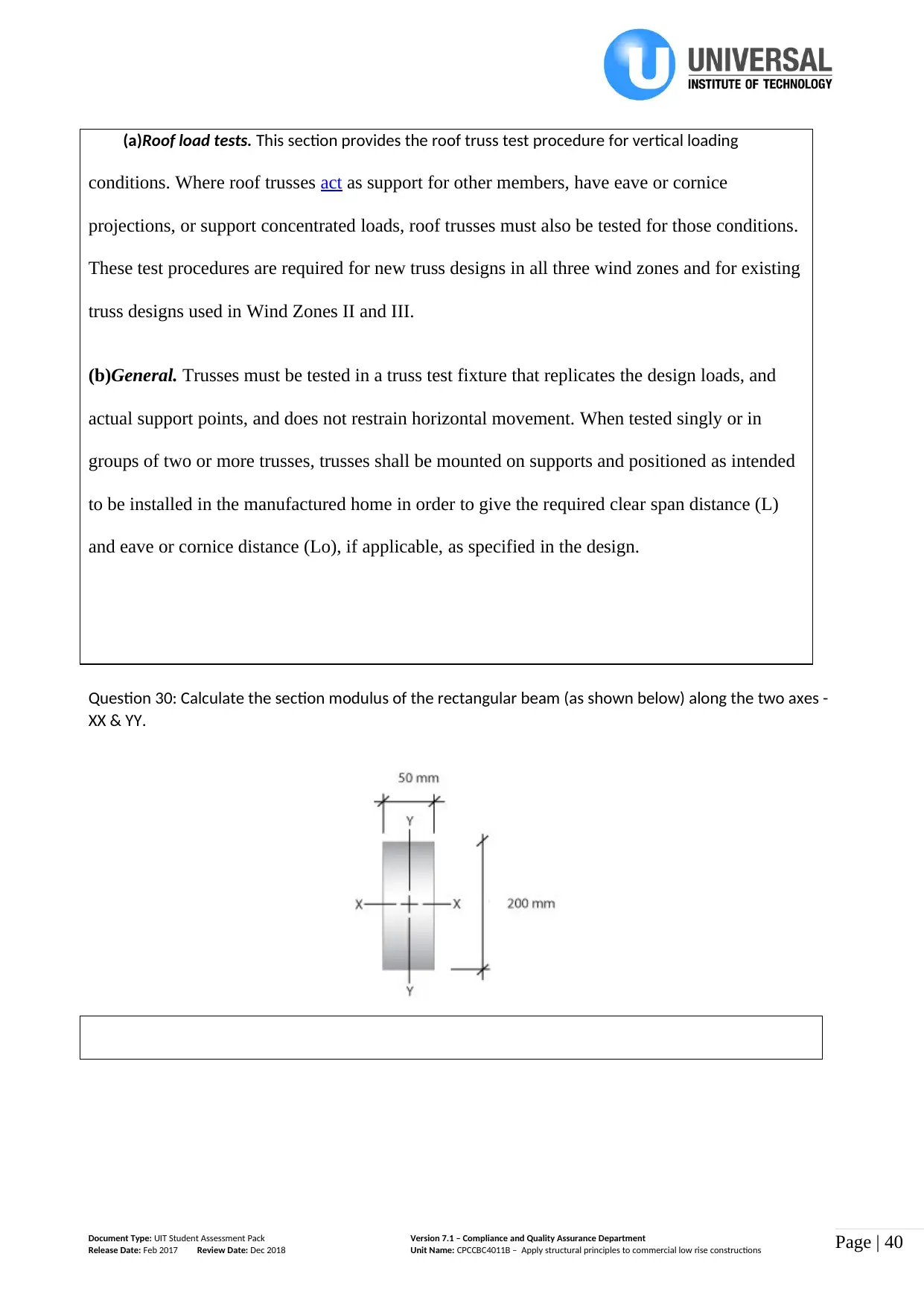
Page | 40
(a)Roof load tests. This section provides the roof truss test procedure for vertical loading
conditions. Where roof trusses act as support for other members, have eave or cornice
projections, or support concentrated loads, roof trusses must also be tested for those conditions.
These test procedures are required for new truss designs in all three wind zones and for existing
truss designs used in Wind Zones II and III.
(b)General. Trusses must be tested in a truss test fixture that replicates the design loads, and
actual support points, and does not restrain horizontal movement. When tested singly or in
groups of two or more trusses, trusses shall be mounted on supports and positioned as intended
to be installed in the manufactured home in order to give the required clear span distance (L)
and eave or cornice distance (Lo), if applicable, as specified in the design.
Question 30: Calculate the section modulus of the rectangular beam (as shown below) along the two axes -
XX & YY.
Document Type: UIT Student Assessment Pack Version 7.1 – Compliance and Quality Assurance Department
Release Date: Feb 2017 Review Date: Dec 2018 Unit Name: CPCCBC4011B – Apply structural principles to commercial low rise constructions
(a)Roof load tests. This section provides the roof truss test procedure for vertical loading
conditions. Where roof trusses act as support for other members, have eave or cornice
projections, or support concentrated loads, roof trusses must also be tested for those conditions.
These test procedures are required for new truss designs in all three wind zones and for existing
truss designs used in Wind Zones II and III.
(b)General. Trusses must be tested in a truss test fixture that replicates the design loads, and
actual support points, and does not restrain horizontal movement. When tested singly or in
groups of two or more trusses, trusses shall be mounted on supports and positioned as intended
to be installed in the manufactured home in order to give the required clear span distance (L)
and eave or cornice distance (Lo), if applicable, as specified in the design.
Question 30: Calculate the section modulus of the rectangular beam (as shown below) along the two axes -
XX & YY.
Document Type: UIT Student Assessment Pack Version 7.1 – Compliance and Quality Assurance Department
Release Date: Feb 2017 Review Date: Dec 2018 Unit Name: CPCCBC4011B – Apply structural principles to commercial low rise constructions
Secure Best Marks with AI Grader
Need help grading? Try our AI Grader for instant feedback on your assignments.
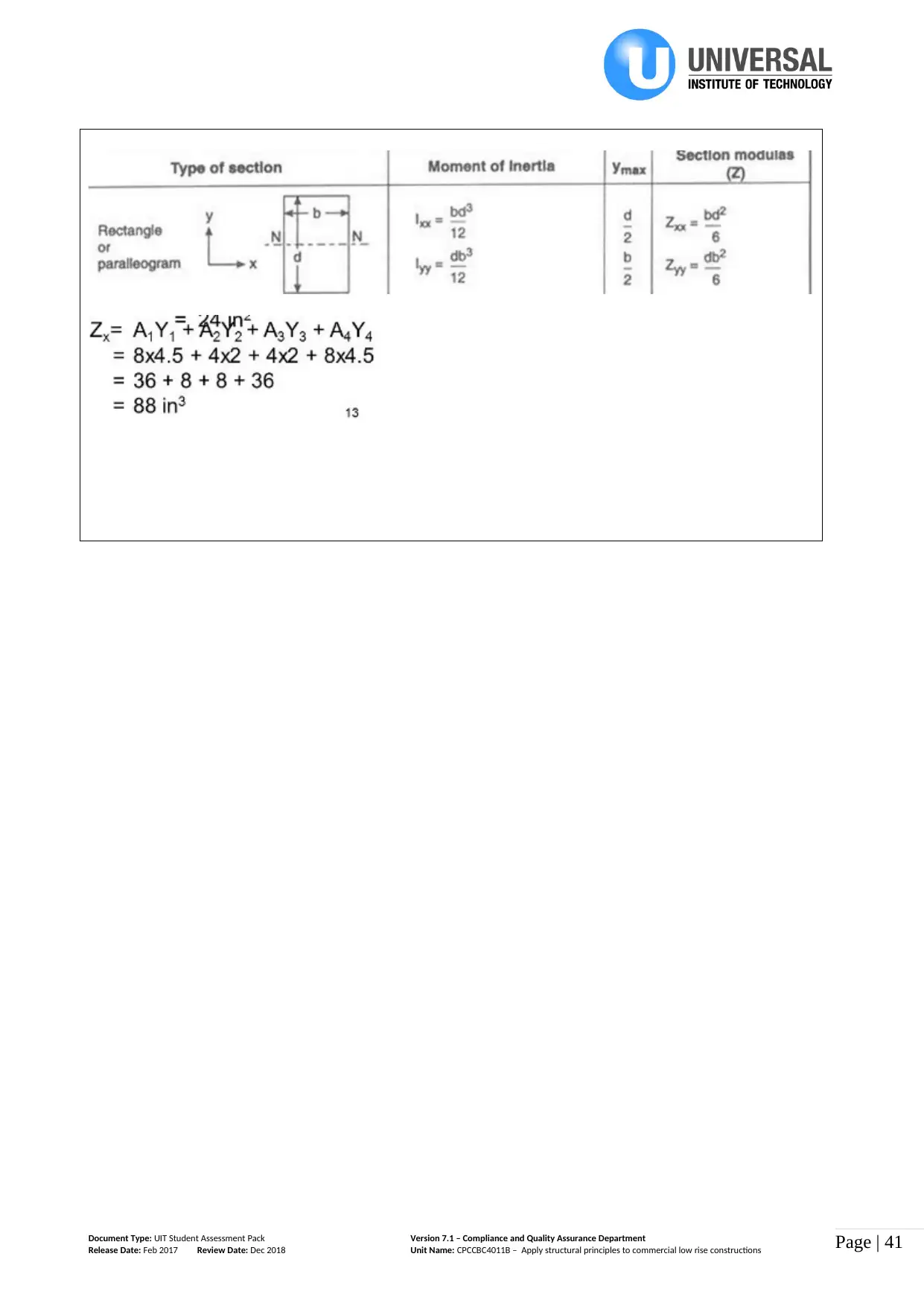
Page | 41Document Type: UIT Student Assessment Pack Version 7.1 – Compliance and Quality Assurance Department
Release Date: Feb 2017 Review Date: Dec 2018 Unit Name: CPCCBC4011B – Apply structural principles to commercial low rise constructions
Release Date: Feb 2017 Review Date: Dec 2018 Unit Name: CPCCBC4011B – Apply structural principles to commercial low rise constructions
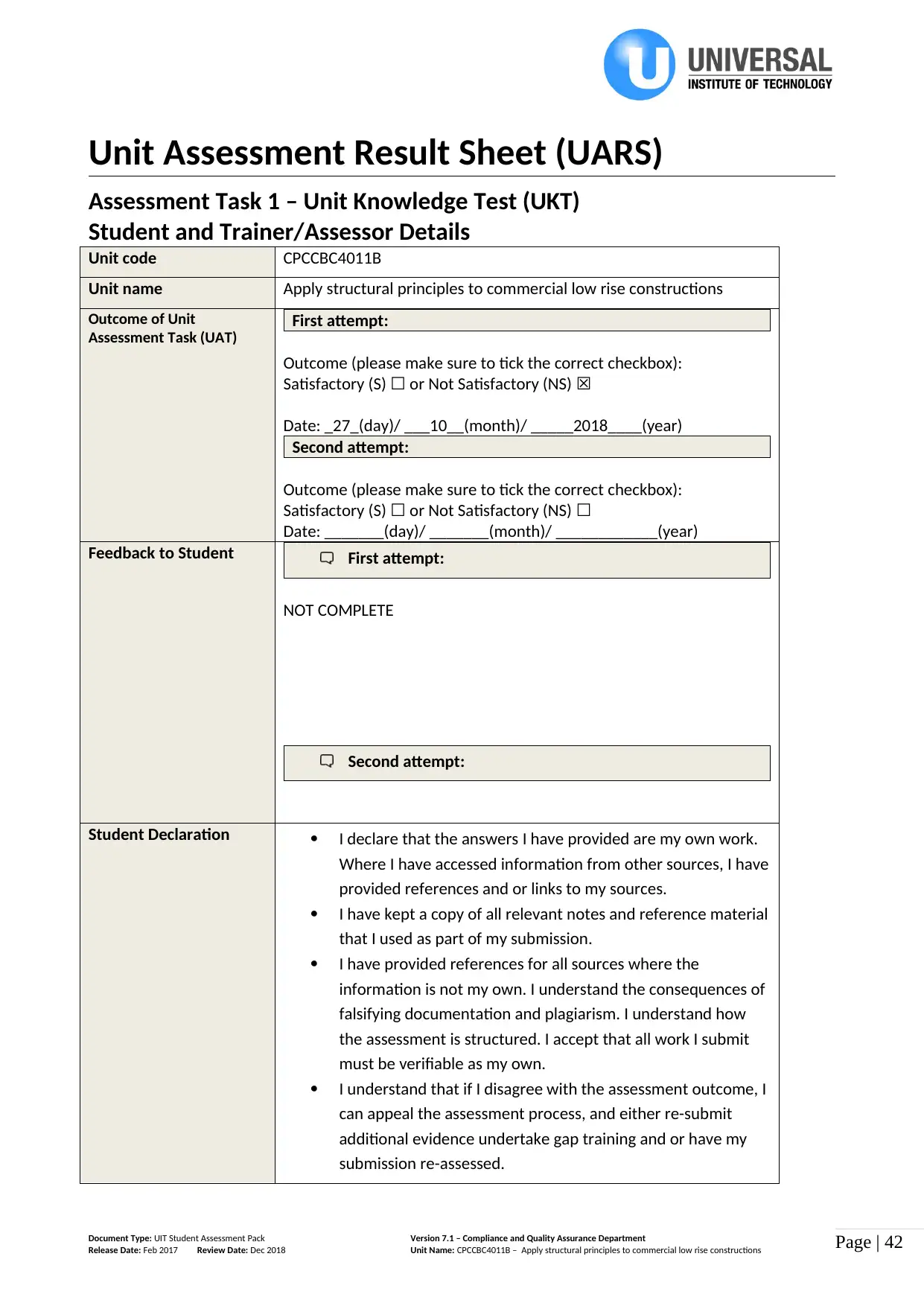
Page | 42
Unit Assessment Result Sheet (UARS)
Assessment Task 1 – Unit Knowledge Test (UKT)
Student and Trainer/Assessor Details
Unit code CPCCBC4011B
Unit name Apply structural principles to commercial low rise constructions
Outcome of Unit
Assessment Task (UAT)
First attempt:
Outcome (please make sure to tick the correct checkbox):
Satisfactory (S) ☐ or Not Satisfactory (NS) ☒
Date: _27_(day)/ ___10__(month)/ _____2018____(year)
Second attempt:
Outcome (please make sure to tick the correct checkbox):
Satisfactory (S) ☐ or Not Satisfactory (NS) ☐
Date: _______(day)/ _______(month)/ ____________(year)
Feedback to Student First attempt:
NOT COMPLETE
Second attempt:
Student Declaration I declare that the answers I have provided are my own work.
Where I have accessed information from other sources, I have
provided references and or links to my sources.
I have kept a copy of all relevant notes and reference material
that I used as part of my submission.
I have provided references for all sources where the
information is not my own. I understand the consequences of
falsifying documentation and plagiarism. I understand how
the assessment is structured. I accept that all work I submit
must be verifiable as my own.
I understand that if I disagree with the assessment outcome, I
can appeal the assessment process, and either re-submit
additional evidence undertake gap training and or have my
submission re-assessed.
Document Type: UIT Student Assessment Pack Version 7.1 – Compliance and Quality Assurance Department
Release Date: Feb 2017 Review Date: Dec 2018 Unit Name: CPCCBC4011B – Apply structural principles to commercial low rise constructions
Unit Assessment Result Sheet (UARS)
Assessment Task 1 – Unit Knowledge Test (UKT)
Student and Trainer/Assessor Details
Unit code CPCCBC4011B
Unit name Apply structural principles to commercial low rise constructions
Outcome of Unit
Assessment Task (UAT)
First attempt:
Outcome (please make sure to tick the correct checkbox):
Satisfactory (S) ☐ or Not Satisfactory (NS) ☒
Date: _27_(day)/ ___10__(month)/ _____2018____(year)
Second attempt:
Outcome (please make sure to tick the correct checkbox):
Satisfactory (S) ☐ or Not Satisfactory (NS) ☐
Date: _______(day)/ _______(month)/ ____________(year)
Feedback to Student First attempt:
NOT COMPLETE
Second attempt:
Student Declaration I declare that the answers I have provided are my own work.
Where I have accessed information from other sources, I have
provided references and or links to my sources.
I have kept a copy of all relevant notes and reference material
that I used as part of my submission.
I have provided references for all sources where the
information is not my own. I understand the consequences of
falsifying documentation and plagiarism. I understand how
the assessment is structured. I accept that all work I submit
must be verifiable as my own.
I understand that if I disagree with the assessment outcome, I
can appeal the assessment process, and either re-submit
additional evidence undertake gap training and or have my
submission re-assessed.
Document Type: UIT Student Assessment Pack Version 7.1 – Compliance and Quality Assurance Department
Release Date: Feb 2017 Review Date: Dec 2018 Unit Name: CPCCBC4011B – Apply structural principles to commercial low rise constructions
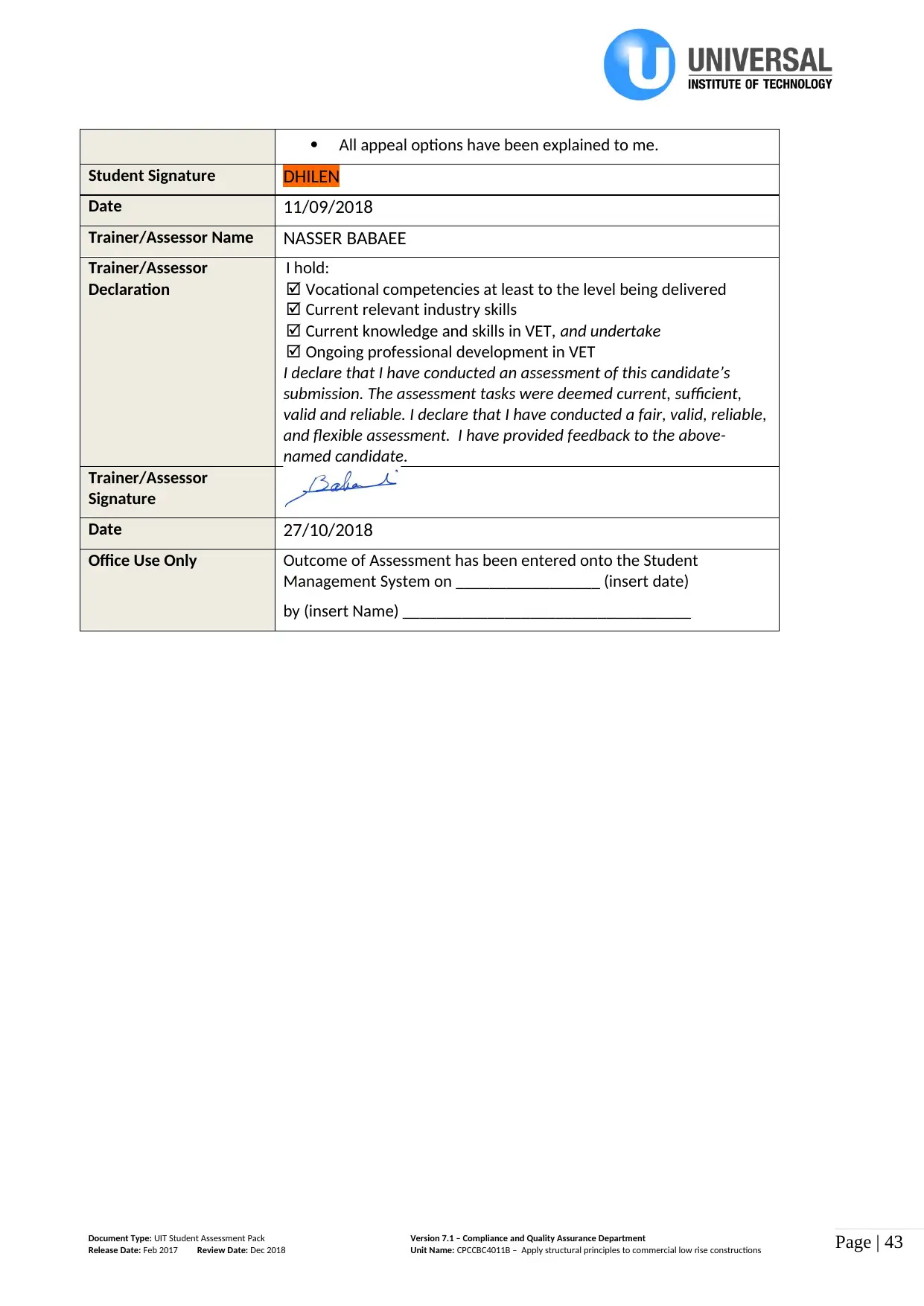
Page | 43
All appeal options have been explained to me.
Student Signature DHILEN
Date 11/09/2018
Trainer/Assessor Name NASSER BABAEE
Trainer/Assessor
Declaration
I hold:
Vocational competencies at least to the level being delivered
Current relevant industry skills
Current knowledge and skills in VET, and undertake
Ongoing professional development in VET
I declare that I have conducted an assessment of this candidate’s
submission. The assessment tasks were deemed current, sufficient,
valid and reliable. I declare that I have conducted a fair, valid, reliable,
and flexible assessment. I have provided feedback to the above-
named candidate.
Trainer/Assessor
Signature
Date 27/10/2018
Office Use Only Outcome of Assessment has been entered onto the Student
Management System on _________________ (insert date)
by (insert Name) __________________________________
Document Type: UIT Student Assessment Pack Version 7.1 – Compliance and Quality Assurance Department
Release Date: Feb 2017 Review Date: Dec 2018 Unit Name: CPCCBC4011B – Apply structural principles to commercial low rise constructions
All appeal options have been explained to me.
Student Signature DHILEN
Date 11/09/2018
Trainer/Assessor Name NASSER BABAEE
Trainer/Assessor
Declaration
I hold:
Vocational competencies at least to the level being delivered
Current relevant industry skills
Current knowledge and skills in VET, and undertake
Ongoing professional development in VET
I declare that I have conducted an assessment of this candidate’s
submission. The assessment tasks were deemed current, sufficient,
valid and reliable. I declare that I have conducted a fair, valid, reliable,
and flexible assessment. I have provided feedback to the above-
named candidate.
Trainer/Assessor
Signature
Date 27/10/2018
Office Use Only Outcome of Assessment has been entered onto the Student
Management System on _________________ (insert date)
by (insert Name) __________________________________
Document Type: UIT Student Assessment Pack Version 7.1 – Compliance and Quality Assurance Department
Release Date: Feb 2017 Review Date: Dec 2018 Unit Name: CPCCBC4011B – Apply structural principles to commercial low rise constructions
Paraphrase This Document
Need a fresh take? Get an instant paraphrase of this document with our AI Paraphraser
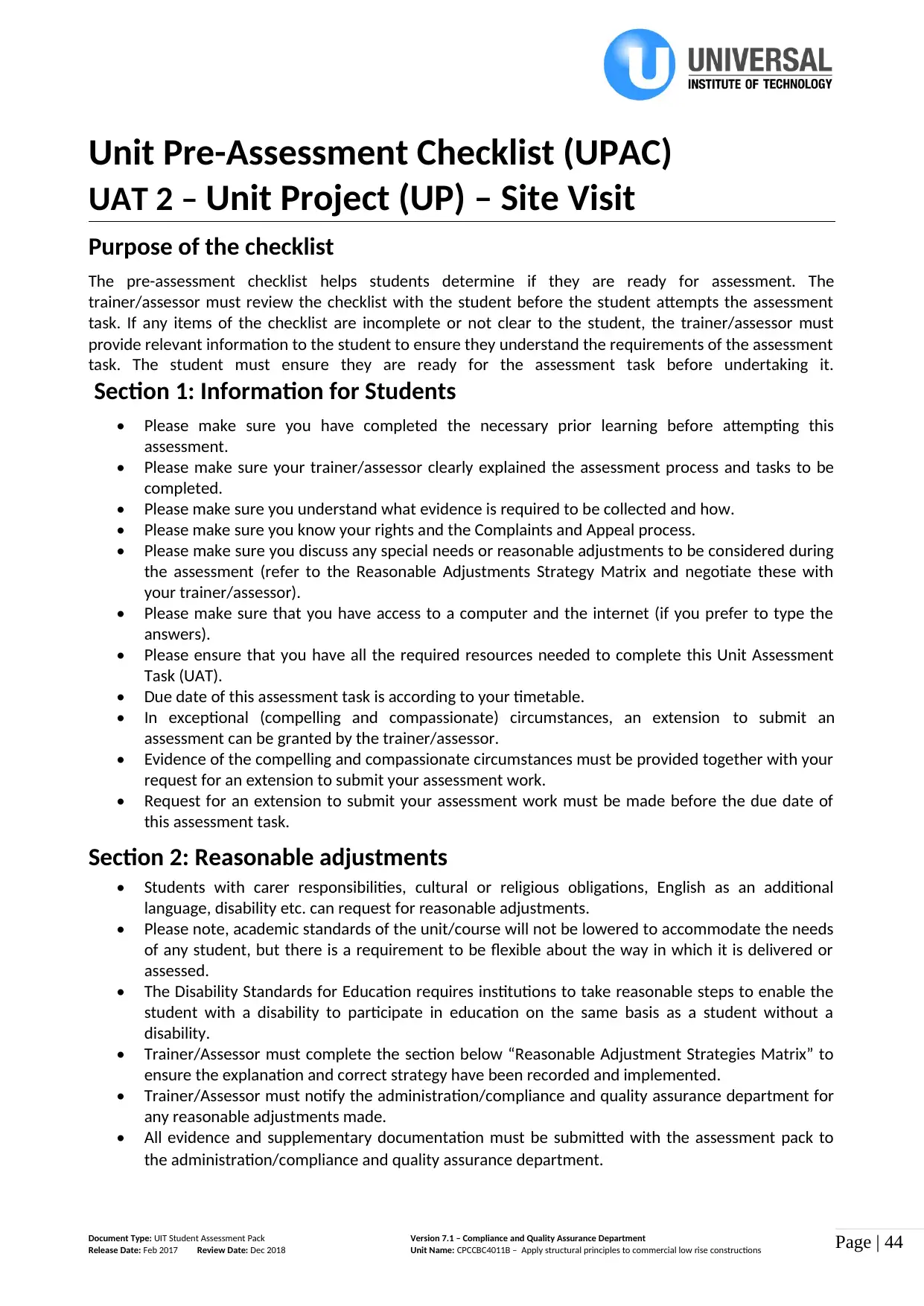
Page | 44
Unit Pre-Assessment Checklist (UPAC)
UAT 2 – Unit Project (UP) – Site Visit
Purpose of the checklist
The pre-assessment checklist helps students determine if they are ready for assessment. The
trainer/assessor must review the checklist with the student before the student attempts the assessment
task. If any items of the checklist are incomplete or not clear to the student, the trainer/assessor must
provide relevant information to the student to ensure they understand the requirements of the assessment
task. The student must ensure they are ready for the assessment task before undertaking it.
Section 1: Information for Students
• Please make sure you have completed the necessary prior learning before attempting this
assessment.
• Please make sure your trainer/assessor clearly explained the assessment process and tasks to be
completed.
• Please make sure you understand what evidence is required to be collected and how.
• Please make sure you know your rights and the Complaints and Appeal process.
• Please make sure you discuss any special needs or reasonable adjustments to be considered during
the assessment (refer to the Reasonable Adjustments Strategy Matrix and negotiate these with
your trainer/assessor).
• Please make sure that you have access to a computer and the internet (if you prefer to type the
answers).
• Please ensure that you have all the required resources needed to complete this Unit Assessment
Task (UAT).
• Due date of this assessment task is according to your timetable.
• In exceptional (compelling and compassionate) circumstances, an extension to submit an
assessment can be granted by the trainer/assessor.
• Evidence of the compelling and compassionate circumstances must be provided together with your
request for an extension to submit your assessment work.
• Request for an extension to submit your assessment work must be made before the due date of
this assessment task.
Section 2: Reasonable adjustments
• Students with carer responsibilities, cultural or religious obligations, English as an additional
language, disability etc. can request for reasonable adjustments.
• Please note, academic standards of the unit/course will not be lowered to accommodate the needs
of any student, but there is a requirement to be flexible about the way in which it is delivered or
assessed.
• The Disability Standards for Education requires institutions to take reasonable steps to enable the
student with a disability to participate in education on the same basis as a student without a
disability.
• Trainer/Assessor must complete the section below “Reasonable Adjustment Strategies Matrix” to
ensure the explanation and correct strategy have been recorded and implemented.
• Trainer/Assessor must notify the administration/compliance and quality assurance department for
any reasonable adjustments made.
• All evidence and supplementary documentation must be submitted with the assessment pack to
the administration/compliance and quality assurance department.
Document Type: UIT Student Assessment Pack Version 7.1 – Compliance and Quality Assurance Department
Release Date: Feb 2017 Review Date: Dec 2018 Unit Name: CPCCBC4011B – Apply structural principles to commercial low rise constructions
Unit Pre-Assessment Checklist (UPAC)
UAT 2 – Unit Project (UP) – Site Visit
Purpose of the checklist
The pre-assessment checklist helps students determine if they are ready for assessment. The
trainer/assessor must review the checklist with the student before the student attempts the assessment
task. If any items of the checklist are incomplete or not clear to the student, the trainer/assessor must
provide relevant information to the student to ensure they understand the requirements of the assessment
task. The student must ensure they are ready for the assessment task before undertaking it.
Section 1: Information for Students
• Please make sure you have completed the necessary prior learning before attempting this
assessment.
• Please make sure your trainer/assessor clearly explained the assessment process and tasks to be
completed.
• Please make sure you understand what evidence is required to be collected and how.
• Please make sure you know your rights and the Complaints and Appeal process.
• Please make sure you discuss any special needs or reasonable adjustments to be considered during
the assessment (refer to the Reasonable Adjustments Strategy Matrix and negotiate these with
your trainer/assessor).
• Please make sure that you have access to a computer and the internet (if you prefer to type the
answers).
• Please ensure that you have all the required resources needed to complete this Unit Assessment
Task (UAT).
• Due date of this assessment task is according to your timetable.
• In exceptional (compelling and compassionate) circumstances, an extension to submit an
assessment can be granted by the trainer/assessor.
• Evidence of the compelling and compassionate circumstances must be provided together with your
request for an extension to submit your assessment work.
• Request for an extension to submit your assessment work must be made before the due date of
this assessment task.
Section 2: Reasonable adjustments
• Students with carer responsibilities, cultural or religious obligations, English as an additional
language, disability etc. can request for reasonable adjustments.
• Please note, academic standards of the unit/course will not be lowered to accommodate the needs
of any student, but there is a requirement to be flexible about the way in which it is delivered or
assessed.
• The Disability Standards for Education requires institutions to take reasonable steps to enable the
student with a disability to participate in education on the same basis as a student without a
disability.
• Trainer/Assessor must complete the section below “Reasonable Adjustment Strategies Matrix” to
ensure the explanation and correct strategy have been recorded and implemented.
• Trainer/Assessor must notify the administration/compliance and quality assurance department for
any reasonable adjustments made.
• All evidence and supplementary documentation must be submitted with the assessment pack to
the administration/compliance and quality assurance department.
Document Type: UIT Student Assessment Pack Version 7.1 – Compliance and Quality Assurance Department
Release Date: Feb 2017 Review Date: Dec 2018 Unit Name: CPCCBC4011B – Apply structural principles to commercial low rise constructions
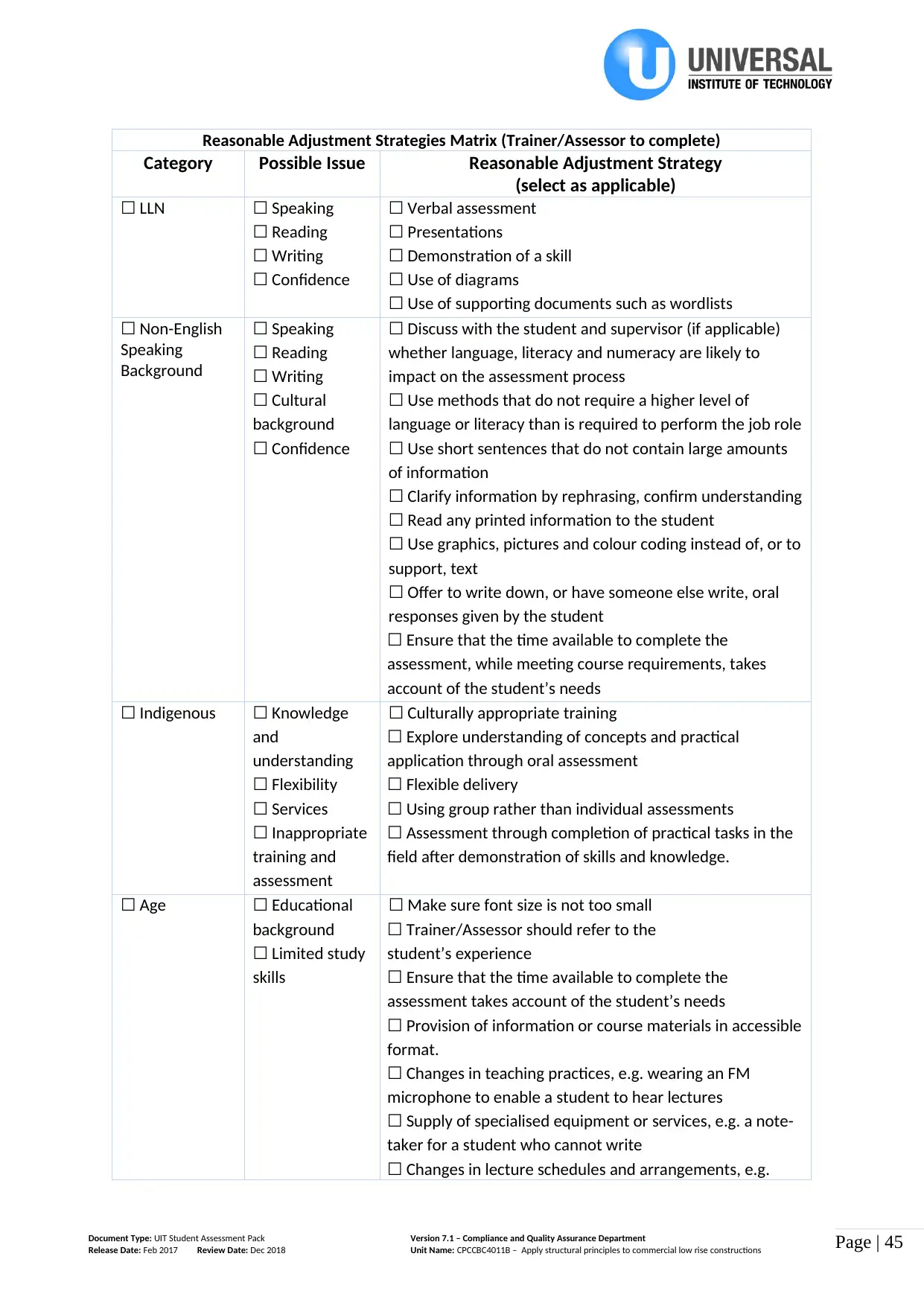
Page | 45
Reasonable Adjustment Strategies Matrix (Trainer/Assessor to complete)
Category Possible Issue Reasonable Adjustment Strategy
(select as applicable)
☐ LLN ☐ Speaking
☐ Reading
☐ Writing
☐ Confidence
☐ Verbal assessment
☐ Presentations
☐ Demonstration of a skill
☐ Use of diagrams
☐ Use of supporting documents such as wordlists
☐ Non-English
Speaking
Background
☐ Speaking
☐ Reading
☐ Writing
☐ Cultural
background
☐ Confidence
☐ Discuss with the student and supervisor (if applicable)
whether language, literacy and numeracy are likely to
impact on the assessment process
☐ Use methods that do not require a higher level of
language or literacy than is required to perform the job role
☐ Use short sentences that do not contain large amounts
of information
☐ Clarify information by rephrasing, confirm understanding
☐ Read any printed information to the student
☐ Use graphics, pictures and colour coding instead of, or to
support, text
☐ Offer to write down, or have someone else write, oral
responses given by the student
☐ Ensure that the time available to complete the
assessment, while meeting course requirements, takes
account of the student’s needs
☐ Indigenous ☐ Knowledge
and
understanding
☐ Flexibility
☐ Services
☐ Inappropriate
training and
assessment
☐ Culturally appropriate training
☐ Explore understanding of concepts and practical
application through oral assessment
☐ Flexible delivery
☐ Using group rather than individual assessments
☐ Assessment through completion of practical tasks in the
field after demonstration of skills and knowledge.
☐ Age ☐ Educational
background
☐ Limited study
skills
☐ Make sure font size is not too small
☐ Trainer/Assessor should refer to the
student’s experience
☐ Ensure that the time available to complete the
assessment takes account of the student’s needs
☐ Provision of information or course materials in accessible
format.
☐ Changes in teaching practices, e.g. wearing an FM
microphone to enable a student to hear lectures
☐ Supply of specialised equipment or services, e.g. a note-
taker for a student who cannot write
☐ Changes in lecture schedules and arrangements, e.g.
Document Type: UIT Student Assessment Pack Version 7.1 – Compliance and Quality Assurance Department
Release Date: Feb 2017 Review Date: Dec 2018 Unit Name: CPCCBC4011B – Apply structural principles to commercial low rise constructions
Reasonable Adjustment Strategies Matrix (Trainer/Assessor to complete)
Category Possible Issue Reasonable Adjustment Strategy
(select as applicable)
☐ LLN ☐ Speaking
☐ Reading
☐ Writing
☐ Confidence
☐ Verbal assessment
☐ Presentations
☐ Demonstration of a skill
☐ Use of diagrams
☐ Use of supporting documents such as wordlists
☐ Non-English
Speaking
Background
☐ Speaking
☐ Reading
☐ Writing
☐ Cultural
background
☐ Confidence
☐ Discuss with the student and supervisor (if applicable)
whether language, literacy and numeracy are likely to
impact on the assessment process
☐ Use methods that do not require a higher level of
language or literacy than is required to perform the job role
☐ Use short sentences that do not contain large amounts
of information
☐ Clarify information by rephrasing, confirm understanding
☐ Read any printed information to the student
☐ Use graphics, pictures and colour coding instead of, or to
support, text
☐ Offer to write down, or have someone else write, oral
responses given by the student
☐ Ensure that the time available to complete the
assessment, while meeting course requirements, takes
account of the student’s needs
☐ Indigenous ☐ Knowledge
and
understanding
☐ Flexibility
☐ Services
☐ Inappropriate
training and
assessment
☐ Culturally appropriate training
☐ Explore understanding of concepts and practical
application through oral assessment
☐ Flexible delivery
☐ Using group rather than individual assessments
☐ Assessment through completion of practical tasks in the
field after demonstration of skills and knowledge.
☐ Age ☐ Educational
background
☐ Limited study
skills
☐ Make sure font size is not too small
☐ Trainer/Assessor should refer to the
student’s experience
☐ Ensure that the time available to complete the
assessment takes account of the student’s needs
☐ Provision of information or course materials in accessible
format.
☐ Changes in teaching practices, e.g. wearing an FM
microphone to enable a student to hear lectures
☐ Supply of specialised equipment or services, e.g. a note-
taker for a student who cannot write
☐ Changes in lecture schedules and arrangements, e.g.
Document Type: UIT Student Assessment Pack Version 7.1 – Compliance and Quality Assurance Department
Release Date: Feb 2017 Review Date: Dec 2018 Unit Name: CPCCBC4011B – Apply structural principles to commercial low rise constructions
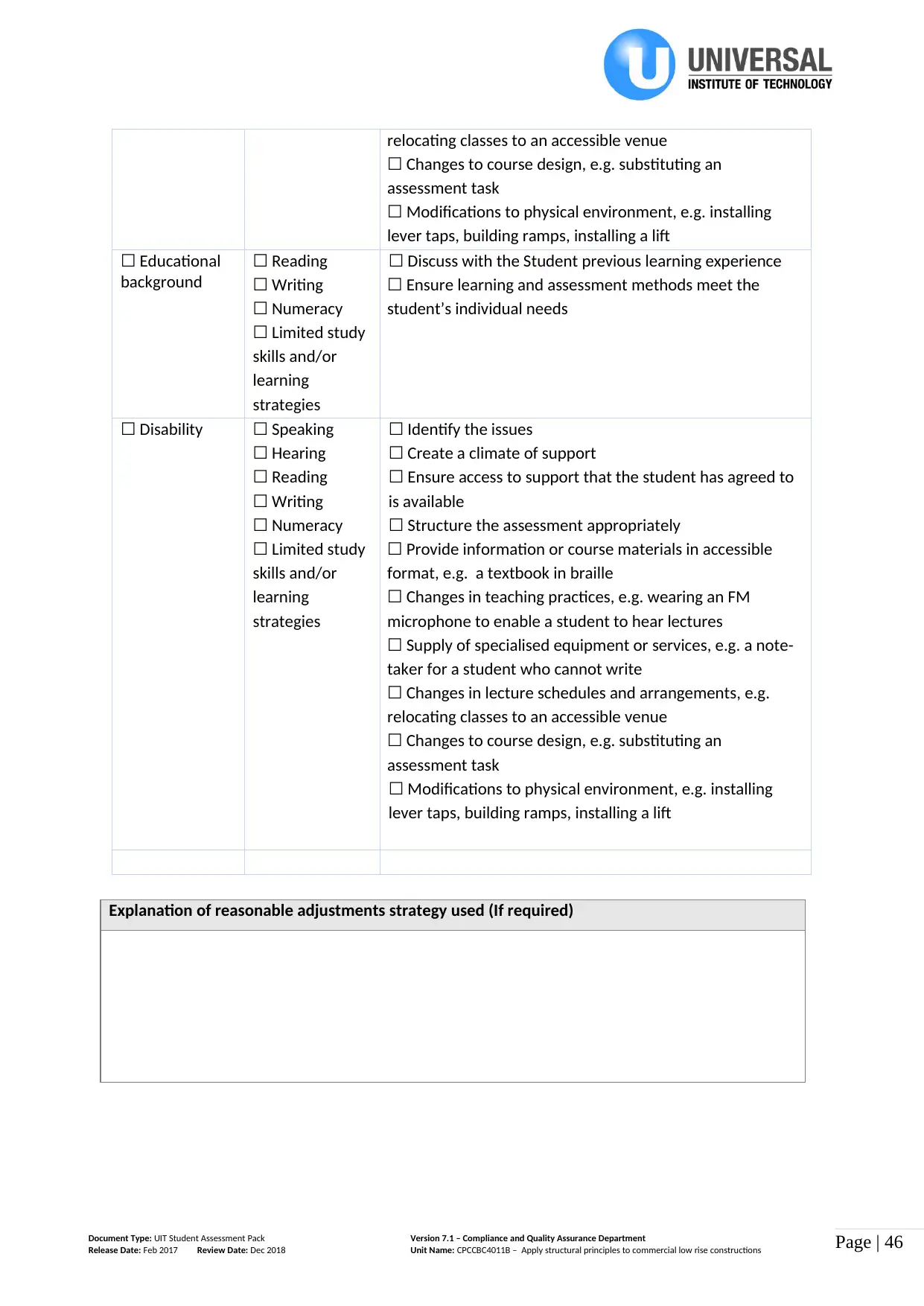
Page | 46
relocating classes to an accessible venue
☐ Changes to course design, e.g. substituting an
assessment task
☐ Modifications to physical environment, e.g. installing
lever taps, building ramps, installing a lift
☐ Educational
background
☐ Reading
☐ Writing
☐ Numeracy
☐ Limited study
skills and/or
learning
strategies
☐ Discuss with the Student previous learning experience
☐ Ensure learning and assessment methods meet the
student’s individual needs
☐ Disability ☐ Speaking
☐ Hearing
☐ Reading
☐ Writing
☐ Numeracy
☐ Limited study
skills and/or
learning
strategies
☐ Identify the issues
☐ Create a climate of support
☐ Ensure access to support that the student has agreed to
is available
☐ Structure the assessment appropriately
☐ Provide information or course materials in accessible
format, e.g. a textbook in braille
☐ Changes in teaching practices, e.g. wearing an FM
microphone to enable a student to hear lectures
☐ Supply of specialised equipment or services, e.g. a note-
taker for a student who cannot write
☐ Changes in lecture schedules and arrangements, e.g.
relocating classes to an accessible venue
☐ Changes to course design, e.g. substituting an
assessment task
☐ Modifications to physical environment, e.g. installing
lever taps, building ramps, installing a lift
Explanation of reasonable adjustments strategy used (If required)
Document Type: UIT Student Assessment Pack Version 7.1 – Compliance and Quality Assurance Department
Release Date: Feb 2017 Review Date: Dec 2018 Unit Name: CPCCBC4011B – Apply structural principles to commercial low rise constructions
relocating classes to an accessible venue
☐ Changes to course design, e.g. substituting an
assessment task
☐ Modifications to physical environment, e.g. installing
lever taps, building ramps, installing a lift
☐ Educational
background
☐ Reading
☐ Writing
☐ Numeracy
☐ Limited study
skills and/or
learning
strategies
☐ Discuss with the Student previous learning experience
☐ Ensure learning and assessment methods meet the
student’s individual needs
☐ Disability ☐ Speaking
☐ Hearing
☐ Reading
☐ Writing
☐ Numeracy
☐ Limited study
skills and/or
learning
strategies
☐ Identify the issues
☐ Create a climate of support
☐ Ensure access to support that the student has agreed to
is available
☐ Structure the assessment appropriately
☐ Provide information or course materials in accessible
format, e.g. a textbook in braille
☐ Changes in teaching practices, e.g. wearing an FM
microphone to enable a student to hear lectures
☐ Supply of specialised equipment or services, e.g. a note-
taker for a student who cannot write
☐ Changes in lecture schedules and arrangements, e.g.
relocating classes to an accessible venue
☐ Changes to course design, e.g. substituting an
assessment task
☐ Modifications to physical environment, e.g. installing
lever taps, building ramps, installing a lift
Explanation of reasonable adjustments strategy used (If required)
Document Type: UIT Student Assessment Pack Version 7.1 – Compliance and Quality Assurance Department
Release Date: Feb 2017 Review Date: Dec 2018 Unit Name: CPCCBC4011B – Apply structural principles to commercial low rise constructions
Secure Best Marks with AI Grader
Need help grading? Try our AI Grader for instant feedback on your assignments.
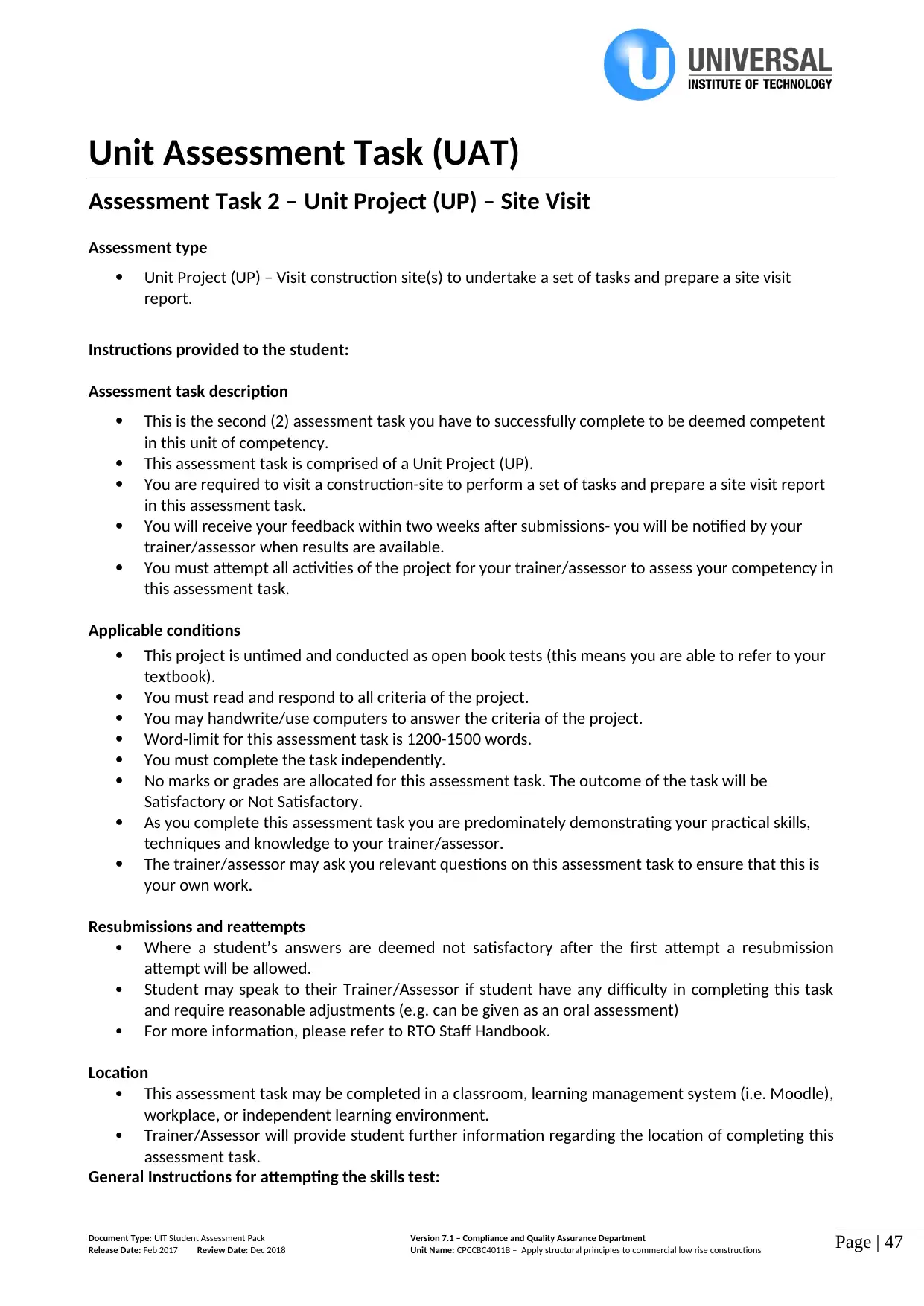
Page | 47
Unit Assessment Task (UAT)
Assessment Task 2 – Unit Project (UP) – Site Visit
Assessment type
Unit Project (UP) – Visit construction site(s) to undertake a set of tasks and prepare a site visit
report.
Instructions provided to the student:
Assessment task description
This is the second (2) assessment task you have to successfully complete to be deemed competent
in this unit of competency.
This assessment task is comprised of a Unit Project (UP).
You are required to visit a construction-site to perform a set of tasks and prepare a site visit report
in this assessment task.
You will receive your feedback within two weeks after submissions- you will be notified by your
trainer/assessor when results are available.
You must attempt all activities of the project for your trainer/assessor to assess your competency in
this assessment task.
Applicable conditions
This project is untimed and conducted as open book tests (this means you are able to refer to your
textbook).
You must read and respond to all criteria of the project.
You may handwrite/use computers to answer the criteria of the project.
Word-limit for this assessment task is 1200-1500 words.
You must complete the task independently.
No marks or grades are allocated for this assessment task. The outcome of the task will be
Satisfactory or Not Satisfactory.
As you complete this assessment task you are predominately demonstrating your practical skills,
techniques and knowledge to your trainer/assessor.
The trainer/assessor may ask you relevant questions on this assessment task to ensure that this is
your own work.
Resubmissions and reattempts
Where a student’s answers are deemed not satisfactory after the first attempt a resubmission
attempt will be allowed.
Student may speak to their Trainer/Assessor if student have any difficulty in completing this task
and require reasonable adjustments (e.g. can be given as an oral assessment)
For more information, please refer to RTO Staff Handbook.
Location
This assessment task may be completed in a classroom, learning management system (i.e. Moodle),
workplace, or independent learning environment.
Trainer/Assessor will provide student further information regarding the location of completing this
assessment task.
General Instructions for attempting the skills test:
Document Type: UIT Student Assessment Pack Version 7.1 – Compliance and Quality Assurance Department
Release Date: Feb 2017 Review Date: Dec 2018 Unit Name: CPCCBC4011B – Apply structural principles to commercial low rise constructions
Unit Assessment Task (UAT)
Assessment Task 2 – Unit Project (UP) – Site Visit
Assessment type
Unit Project (UP) – Visit construction site(s) to undertake a set of tasks and prepare a site visit
report.
Instructions provided to the student:
Assessment task description
This is the second (2) assessment task you have to successfully complete to be deemed competent
in this unit of competency.
This assessment task is comprised of a Unit Project (UP).
You are required to visit a construction-site to perform a set of tasks and prepare a site visit report
in this assessment task.
You will receive your feedback within two weeks after submissions- you will be notified by your
trainer/assessor when results are available.
You must attempt all activities of the project for your trainer/assessor to assess your competency in
this assessment task.
Applicable conditions
This project is untimed and conducted as open book tests (this means you are able to refer to your
textbook).
You must read and respond to all criteria of the project.
You may handwrite/use computers to answer the criteria of the project.
Word-limit for this assessment task is 1200-1500 words.
You must complete the task independently.
No marks or grades are allocated for this assessment task. The outcome of the task will be
Satisfactory or Not Satisfactory.
As you complete this assessment task you are predominately demonstrating your practical skills,
techniques and knowledge to your trainer/assessor.
The trainer/assessor may ask you relevant questions on this assessment task to ensure that this is
your own work.
Resubmissions and reattempts
Where a student’s answers are deemed not satisfactory after the first attempt a resubmission
attempt will be allowed.
Student may speak to their Trainer/Assessor if student have any difficulty in completing this task
and require reasonable adjustments (e.g. can be given as an oral assessment)
For more information, please refer to RTO Staff Handbook.
Location
This assessment task may be completed in a classroom, learning management system (i.e. Moodle),
workplace, or independent learning environment.
Trainer/Assessor will provide student further information regarding the location of completing this
assessment task.
General Instructions for attempting the skills test:
Document Type: UIT Student Assessment Pack Version 7.1 – Compliance and Quality Assurance Department
Release Date: Feb 2017 Review Date: Dec 2018 Unit Name: CPCCBC4011B – Apply structural principles to commercial low rise constructions
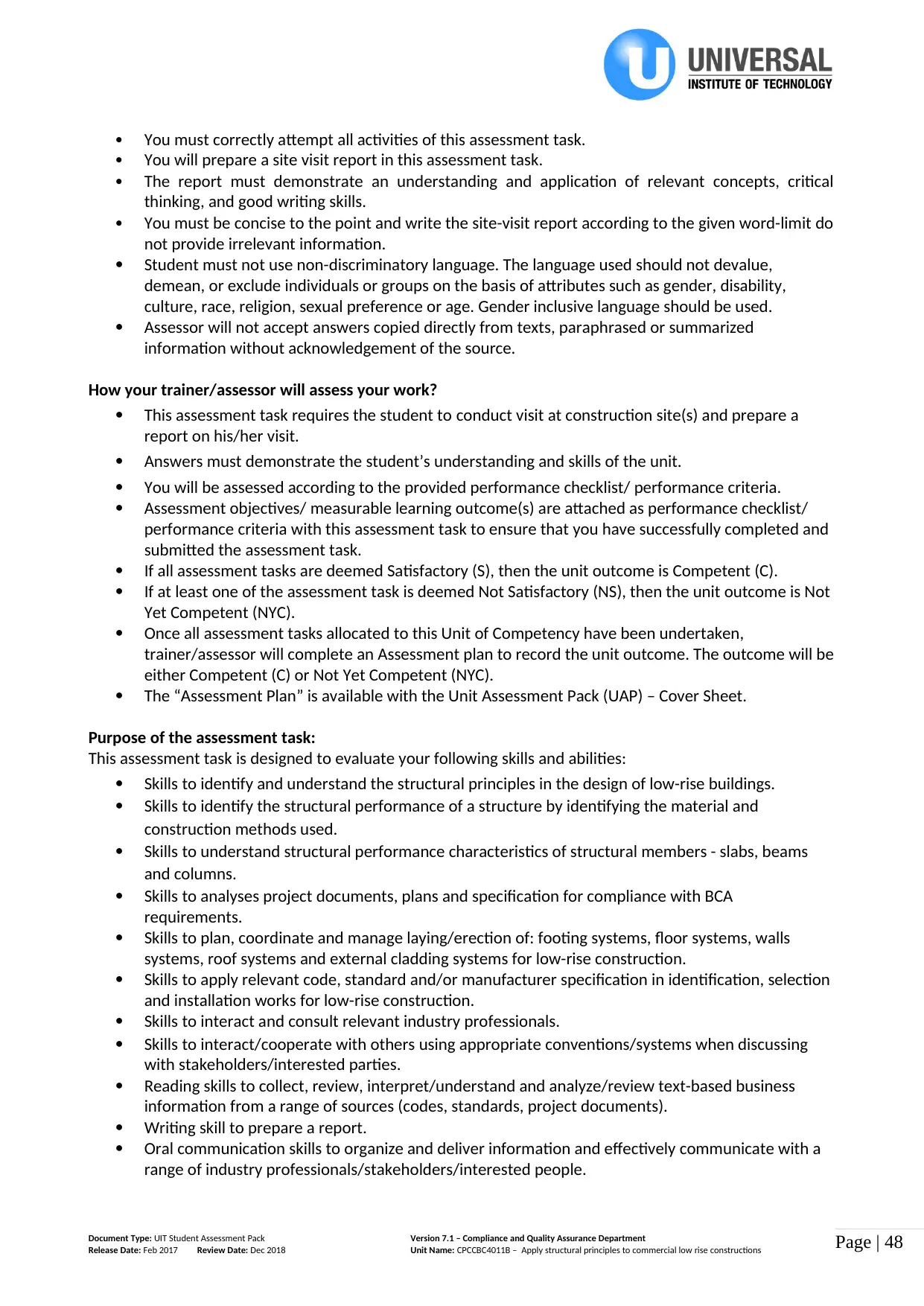
Page | 48
You must correctly attempt all activities of this assessment task.
You will prepare a site visit report in this assessment task.
The report must demonstrate an understanding and application of relevant concepts, critical
thinking, and good writing skills.
You must be concise to the point and write the site-visit report according to the given word-limit do
not provide irrelevant information.
Student must not use non-discriminatory language. The language used should not devalue,
demean, or exclude individuals or groups on the basis of attributes such as gender, disability,
culture, race, religion, sexual preference or age. Gender inclusive language should be used.
Assessor will not accept answers copied directly from texts, paraphrased or summarized
information without acknowledgement of the source.
How your trainer/assessor will assess your work?
This assessment task requires the student to conduct visit at construction site(s) and prepare a
report on his/her visit.
Answers must demonstrate the student’s understanding and skills of the unit.
You will be assessed according to the provided performance checklist/ performance criteria.
Assessment objectives/ measurable learning outcome(s) are attached as performance checklist/
performance criteria with this assessment task to ensure that you have successfully completed and
submitted the assessment task.
If all assessment tasks are deemed Satisfactory (S), then the unit outcome is Competent (C).
If at least one of the assessment task is deemed Not Satisfactory (NS), then the unit outcome is Not
Yet Competent (NYC).
Once all assessment tasks allocated to this Unit of Competency have been undertaken,
trainer/assessor will complete an Assessment plan to record the unit outcome. The outcome will be
either Competent (C) or Not Yet Competent (NYC).
The “Assessment Plan” is available with the Unit Assessment Pack (UAP) – Cover Sheet.
Purpose of the assessment task:
This assessment task is designed to evaluate your following skills and abilities:
Skills to identify and understand the structural principles in the design of low-rise buildings.
Skills to identify the structural performance of a structure by identifying the material and
construction methods used.
Skills to understand structural performance characteristics of structural members - slabs, beams
and columns.
Skills to analyses project documents, plans and specification for compliance with BCA
requirements.
Skills to plan, coordinate and manage laying/erection of: footing systems, floor systems, walls
systems, roof systems and external cladding systems for low-rise construction.
Skills to apply relevant code, standard and/or manufacturer specification in identification, selection
and installation works for low-rise construction.
Skills to interact and consult relevant industry professionals.
Skills to interact/cooperate with others using appropriate conventions/systems when discussing
with stakeholders/interested parties.
Reading skills to collect, review, interpret/understand and analyze/review text-based business
information from a range of sources (codes, standards, project documents).
Writing skill to prepare a report.
Oral communication skills to organize and deliver information and effectively communicate with a
range of industry professionals/stakeholders/interested people.
Document Type: UIT Student Assessment Pack Version 7.1 – Compliance and Quality Assurance Department
Release Date: Feb 2017 Review Date: Dec 2018 Unit Name: CPCCBC4011B – Apply structural principles to commercial low rise constructions
You must correctly attempt all activities of this assessment task.
You will prepare a site visit report in this assessment task.
The report must demonstrate an understanding and application of relevant concepts, critical
thinking, and good writing skills.
You must be concise to the point and write the site-visit report according to the given word-limit do
not provide irrelevant information.
Student must not use non-discriminatory language. The language used should not devalue,
demean, or exclude individuals or groups on the basis of attributes such as gender, disability,
culture, race, religion, sexual preference or age. Gender inclusive language should be used.
Assessor will not accept answers copied directly from texts, paraphrased or summarized
information without acknowledgement of the source.
How your trainer/assessor will assess your work?
This assessment task requires the student to conduct visit at construction site(s) and prepare a
report on his/her visit.
Answers must demonstrate the student’s understanding and skills of the unit.
You will be assessed according to the provided performance checklist/ performance criteria.
Assessment objectives/ measurable learning outcome(s) are attached as performance checklist/
performance criteria with this assessment task to ensure that you have successfully completed and
submitted the assessment task.
If all assessment tasks are deemed Satisfactory (S), then the unit outcome is Competent (C).
If at least one of the assessment task is deemed Not Satisfactory (NS), then the unit outcome is Not
Yet Competent (NYC).
Once all assessment tasks allocated to this Unit of Competency have been undertaken,
trainer/assessor will complete an Assessment plan to record the unit outcome. The outcome will be
either Competent (C) or Not Yet Competent (NYC).
The “Assessment Plan” is available with the Unit Assessment Pack (UAP) – Cover Sheet.
Purpose of the assessment task:
This assessment task is designed to evaluate your following skills and abilities:
Skills to identify and understand the structural principles in the design of low-rise buildings.
Skills to identify the structural performance of a structure by identifying the material and
construction methods used.
Skills to understand structural performance characteristics of structural members - slabs, beams
and columns.
Skills to analyses project documents, plans and specification for compliance with BCA
requirements.
Skills to plan, coordinate and manage laying/erection of: footing systems, floor systems, walls
systems, roof systems and external cladding systems for low-rise construction.
Skills to apply relevant code, standard and/or manufacturer specification in identification, selection
and installation works for low-rise construction.
Skills to interact and consult relevant industry professionals.
Skills to interact/cooperate with others using appropriate conventions/systems when discussing
with stakeholders/interested parties.
Reading skills to collect, review, interpret/understand and analyze/review text-based business
information from a range of sources (codes, standards, project documents).
Writing skill to prepare a report.
Oral communication skills to organize and deliver information and effectively communicate with a
range of industry professionals/stakeholders/interested people.
Document Type: UIT Student Assessment Pack Version 7.1 – Compliance and Quality Assurance Department
Release Date: Feb 2017 Review Date: Dec 2018 Unit Name: CPCCBC4011B – Apply structural principles to commercial low rise constructions
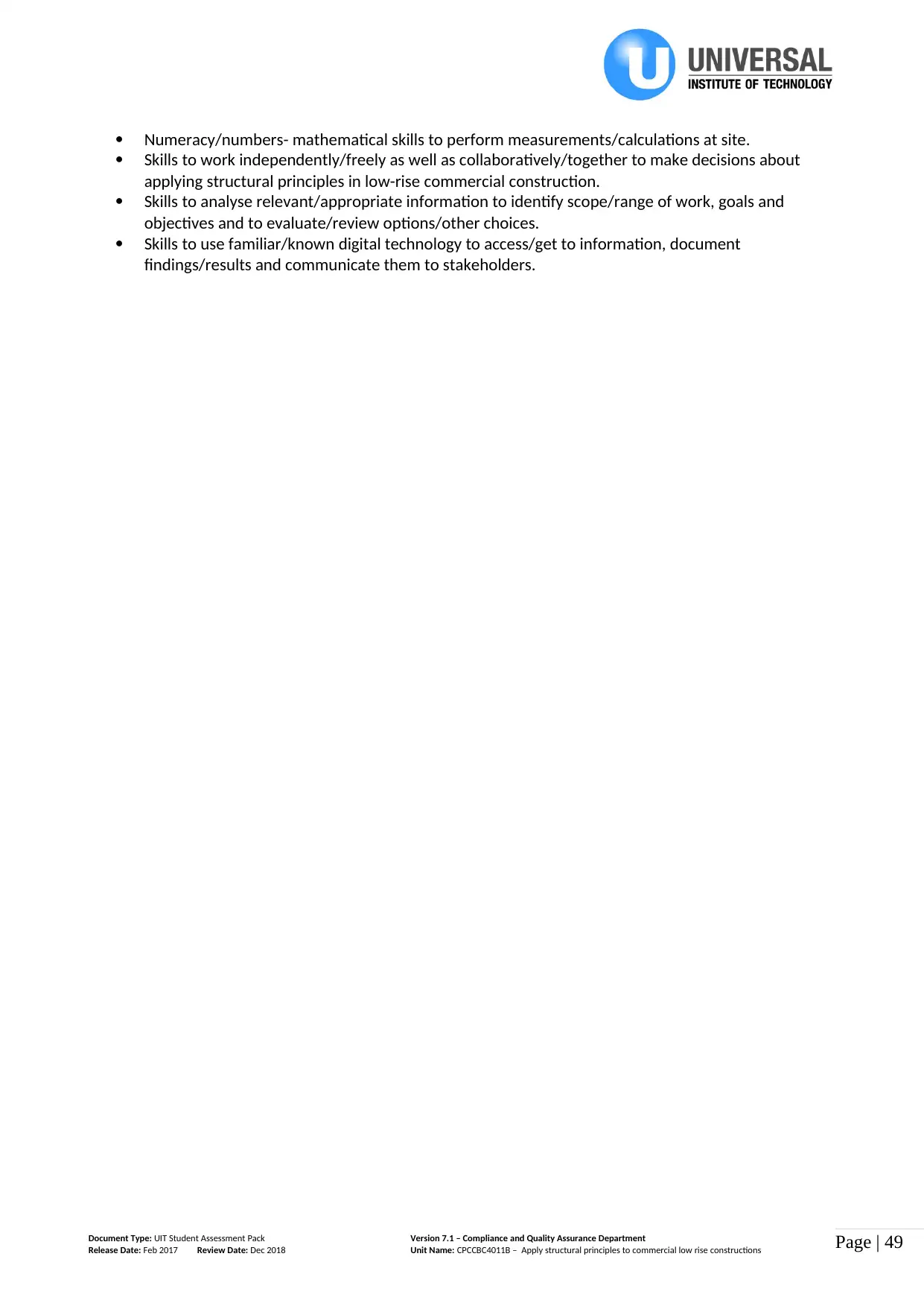
Page | 49
Numeracy/numbers- mathematical skills to perform measurements/calculations at site.
Skills to work independently/freely as well as collaboratively/together to make decisions about
applying structural principles in low-rise commercial construction.
Skills to analyse relevant/appropriate information to identify scope/range of work, goals and
objectives and to evaluate/review options/other choices.
Skills to use familiar/known digital technology to access/get to information, document
findings/results and communicate them to stakeholders.
Document Type: UIT Student Assessment Pack Version 7.1 – Compliance and Quality Assurance Department
Release Date: Feb 2017 Review Date: Dec 2018 Unit Name: CPCCBC4011B – Apply structural principles to commercial low rise constructions
Numeracy/numbers- mathematical skills to perform measurements/calculations at site.
Skills to work independently/freely as well as collaboratively/together to make decisions about
applying structural principles in low-rise commercial construction.
Skills to analyse relevant/appropriate information to identify scope/range of work, goals and
objectives and to evaluate/review options/other choices.
Skills to use familiar/known digital technology to access/get to information, document
findings/results and communicate them to stakeholders.
Document Type: UIT Student Assessment Pack Version 7.1 – Compliance and Quality Assurance Department
Release Date: Feb 2017 Review Date: Dec 2018 Unit Name: CPCCBC4011B – Apply structural principles to commercial low rise constructions
Paraphrase This Document
Need a fresh take? Get an instant paraphrase of this document with our AI Paraphraser
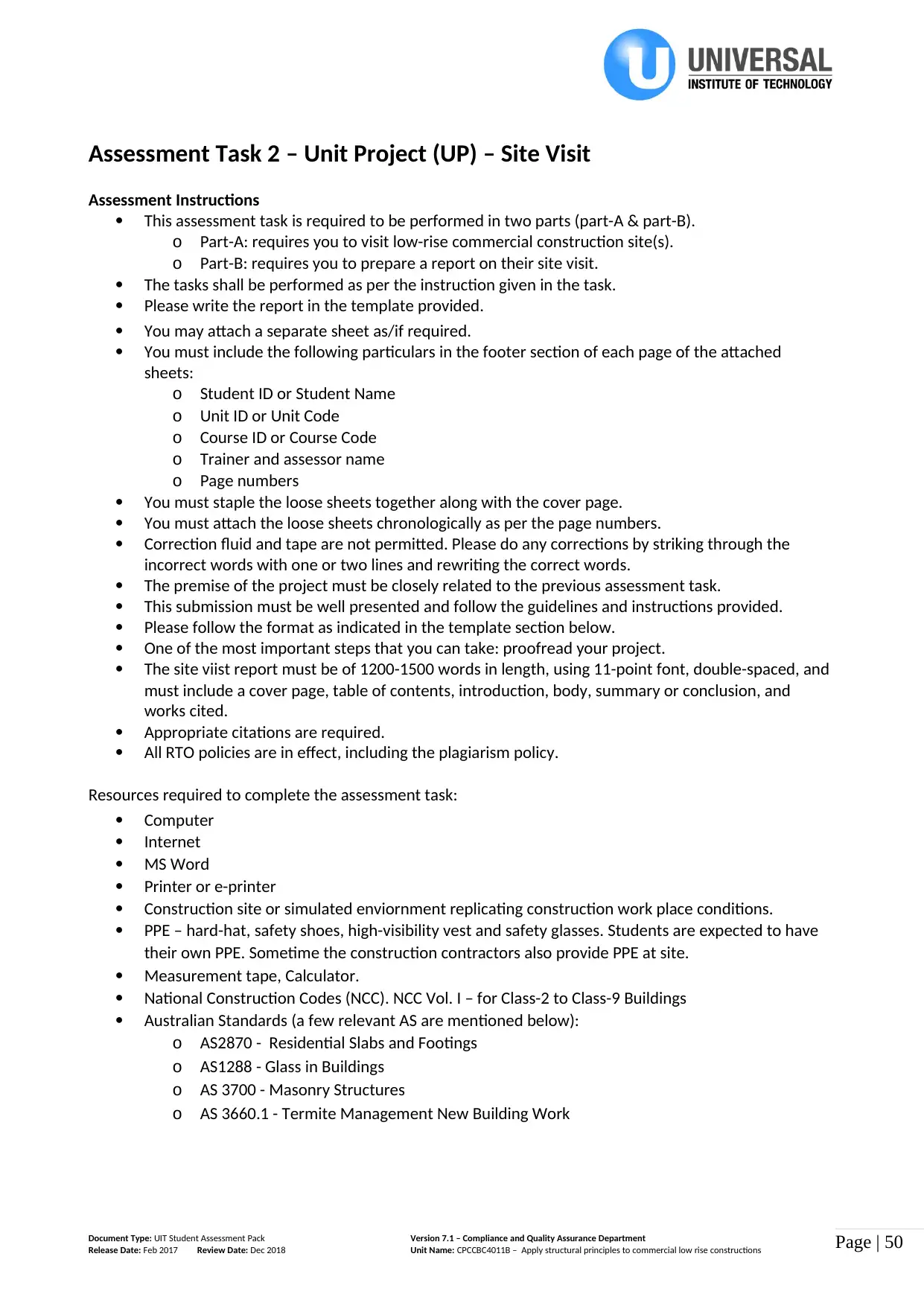
Page | 50
Assessment Task 2 – Unit Project (UP) – Site Visit
Assessment Instructions
This assessment task is required to be performed in two parts (part-A & part-B).
o Part-A: requires you to visit low-rise commercial construction site(s).
o Part-B: requires you to prepare a report on their site visit.
The tasks shall be performed as per the instruction given in the task.
Please write the report in the template provided.
You may attach a separate sheet as/if required.
You must include the following particulars in the footer section of each page of the attached
sheets:
o Student ID or Student Name
o Unit ID or Unit Code
o Course ID or Course Code
o Trainer and assessor name
o Page numbers
You must staple the loose sheets together along with the cover page.
You must attach the loose sheets chronologically as per the page numbers.
Correction fluid and tape are not permitted. Please do any corrections by striking through the
incorrect words with one or two lines and rewriting the correct words.
The premise of the project must be closely related to the previous assessment task.
This submission must be well presented and follow the guidelines and instructions provided.
Please follow the format as indicated in the template section below.
One of the most important steps that you can take: proofread your project.
The site viist report must be of 1200-1500 words in length, using 11-point font, double-spaced, and
must include a cover page, table of contents, introduction, body, summary or conclusion, and
works cited.
Appropriate citations are required.
All RTO policies are in effect, including the plagiarism policy.
Resources required to complete the assessment task:
Computer
Internet
MS Word
Printer or e-printer
Construction site or simulated enviornment replicating construction work place conditions.
PPE – hard-hat, safety shoes, high-visibility vest and safety glasses. Students are expected to have
their own PPE. Sometime the construction contractors also provide PPE at site.
Measurement tape, Calculator.
National Construction Codes (NCC). NCC Vol. I – for Class-2 to Class-9 Buildings
Australian Standards (a few relevant AS are mentioned below):
o AS2870 - Residential Slabs and Footings
o AS1288 - Glass in Buildings
o AS 3700 - Masonry Structures
o AS 3660.1 - Termite Management New Building Work
Document Type: UIT Student Assessment Pack Version 7.1 – Compliance and Quality Assurance Department
Release Date: Feb 2017 Review Date: Dec 2018 Unit Name: CPCCBC4011B – Apply structural principles to commercial low rise constructions
Assessment Task 2 – Unit Project (UP) – Site Visit
Assessment Instructions
This assessment task is required to be performed in two parts (part-A & part-B).
o Part-A: requires you to visit low-rise commercial construction site(s).
o Part-B: requires you to prepare a report on their site visit.
The tasks shall be performed as per the instruction given in the task.
Please write the report in the template provided.
You may attach a separate sheet as/if required.
You must include the following particulars in the footer section of each page of the attached
sheets:
o Student ID or Student Name
o Unit ID or Unit Code
o Course ID or Course Code
o Trainer and assessor name
o Page numbers
You must staple the loose sheets together along with the cover page.
You must attach the loose sheets chronologically as per the page numbers.
Correction fluid and tape are not permitted. Please do any corrections by striking through the
incorrect words with one or two lines and rewriting the correct words.
The premise of the project must be closely related to the previous assessment task.
This submission must be well presented and follow the guidelines and instructions provided.
Please follow the format as indicated in the template section below.
One of the most important steps that you can take: proofread your project.
The site viist report must be of 1200-1500 words in length, using 11-point font, double-spaced, and
must include a cover page, table of contents, introduction, body, summary or conclusion, and
works cited.
Appropriate citations are required.
All RTO policies are in effect, including the plagiarism policy.
Resources required to complete the assessment task:
Computer
Internet
MS Word
Printer or e-printer
Construction site or simulated enviornment replicating construction work place conditions.
PPE – hard-hat, safety shoes, high-visibility vest and safety glasses. Students are expected to have
their own PPE. Sometime the construction contractors also provide PPE at site.
Measurement tape, Calculator.
National Construction Codes (NCC). NCC Vol. I – for Class-2 to Class-9 Buildings
Australian Standards (a few relevant AS are mentioned below):
o AS2870 - Residential Slabs and Footings
o AS1288 - Glass in Buildings
o AS 3700 - Masonry Structures
o AS 3660.1 - Termite Management New Building Work
Document Type: UIT Student Assessment Pack Version 7.1 – Compliance and Quality Assurance Department
Release Date: Feb 2017 Review Date: Dec 2018 Unit Name: CPCCBC4011B – Apply structural principles to commercial low rise constructions
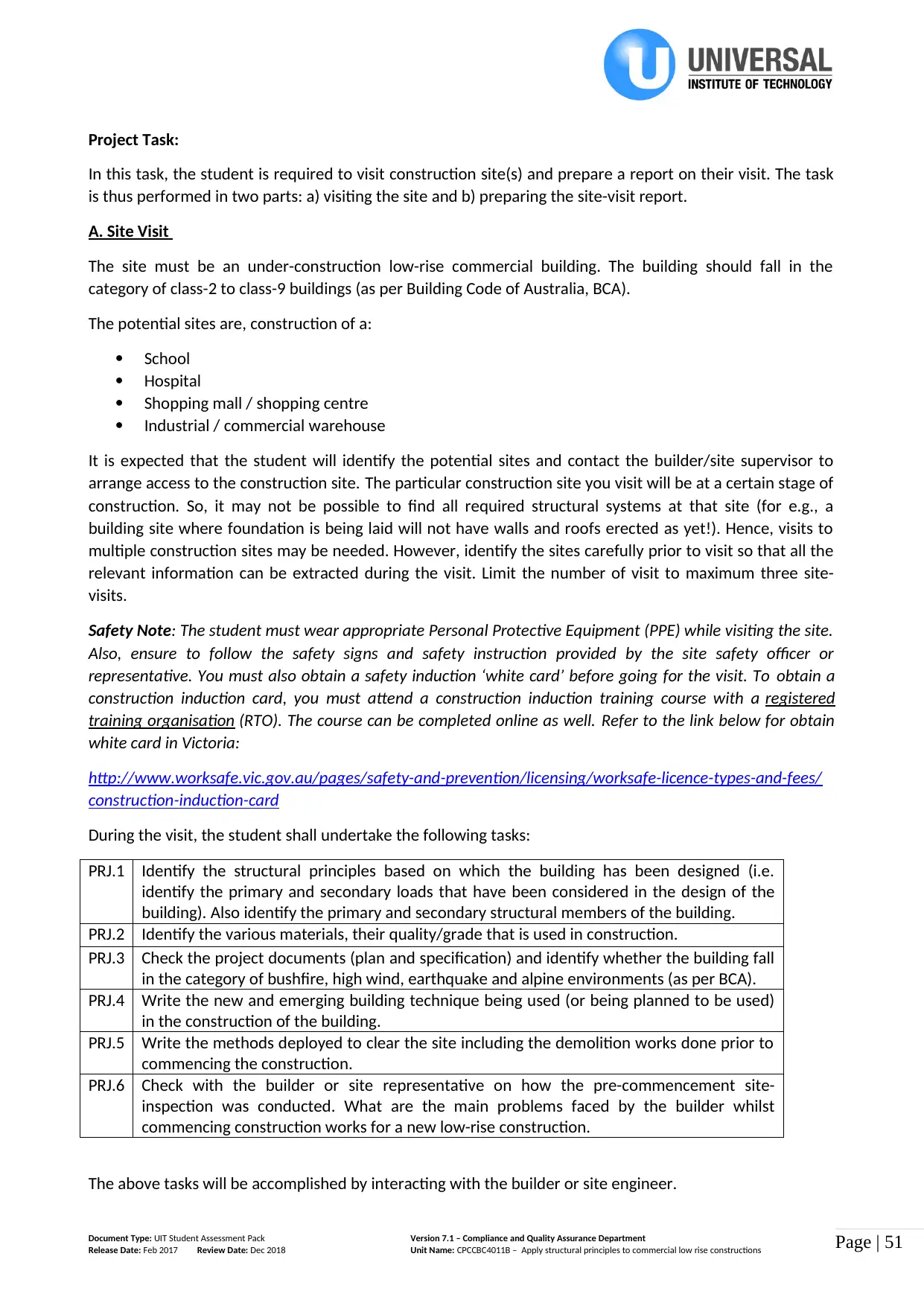
Page | 51
Project Task:
In this task, the student is required to visit construction site(s) and prepare a report on their visit. The task
is thus performed in two parts: a) visiting the site and b) preparing the site-visit report.
A. Site Visit
The site must be an under-construction low-rise commercial building. The building should fall in the
category of class-2 to class-9 buildings (as per Building Code of Australia, BCA).
The potential sites are, construction of a:
School
Hospital
Shopping mall / shopping centre
Industrial / commercial warehouse
It is expected that the student will identify the potential sites and contact the builder/site supervisor to
arrange access to the construction site. The particular construction site you visit will be at a certain stage of
construction. So, it may not be possible to find all required structural systems at that site (for e.g., a
building site where foundation is being laid will not have walls and roofs erected as yet!). Hence, visits to
multiple construction sites may be needed. However, identify the sites carefully prior to visit so that all the
relevant information can be extracted during the visit. Limit the number of visit to maximum three site-
visits.
Safety Note: The student must wear appropriate Personal Protective Equipment (PPE) while visiting the site.
Also, ensure to follow the safety signs and safety instruction provided by the site safety officer or
representative. You must also obtain a safety induction ‘white card’ before going for the visit. To obtain a
construction induction card, you must attend a construction induction training course with a registered
training organisation (RTO). The course can be completed online as well. Refer to the link below for obtain
white card in Victoria:
http://www.worksafe.vic.gov.au/pages/safety-and-prevention/licensing/worksafe-licence-types-and-fees/
construction-induction-card
During the visit, the student shall undertake the following tasks:
PRJ.1 Identify the structural principles based on which the building has been designed (i.e.
identify the primary and secondary loads that have been considered in the design of the
building). Also identify the primary and secondary structural members of the building.
PRJ.2 Identify the various materials, their quality/grade that is used in construction.
PRJ.3 Check the project documents (plan and specification) and identify whether the building fall
in the category of bushfire, high wind, earthquake and alpine environments (as per BCA).
PRJ.4 Write the new and emerging building technique being used (or being planned to be used)
in the construction of the building.
PRJ.5 Write the methods deployed to clear the site including the demolition works done prior to
commencing the construction.
PRJ.6 Check with the builder or site representative on how the pre-commencement site-
inspection was conducted. What are the main problems faced by the builder whilst
commencing construction works for a new low-rise construction.
The above tasks will be accomplished by interacting with the builder or site engineer.
Document Type: UIT Student Assessment Pack Version 7.1 – Compliance and Quality Assurance Department
Release Date: Feb 2017 Review Date: Dec 2018 Unit Name: CPCCBC4011B – Apply structural principles to commercial low rise constructions
Project Task:
In this task, the student is required to visit construction site(s) and prepare a report on their visit. The task
is thus performed in two parts: a) visiting the site and b) preparing the site-visit report.
A. Site Visit
The site must be an under-construction low-rise commercial building. The building should fall in the
category of class-2 to class-9 buildings (as per Building Code of Australia, BCA).
The potential sites are, construction of a:
School
Hospital
Shopping mall / shopping centre
Industrial / commercial warehouse
It is expected that the student will identify the potential sites and contact the builder/site supervisor to
arrange access to the construction site. The particular construction site you visit will be at a certain stage of
construction. So, it may not be possible to find all required structural systems at that site (for e.g., a
building site where foundation is being laid will not have walls and roofs erected as yet!). Hence, visits to
multiple construction sites may be needed. However, identify the sites carefully prior to visit so that all the
relevant information can be extracted during the visit. Limit the number of visit to maximum three site-
visits.
Safety Note: The student must wear appropriate Personal Protective Equipment (PPE) while visiting the site.
Also, ensure to follow the safety signs and safety instruction provided by the site safety officer or
representative. You must also obtain a safety induction ‘white card’ before going for the visit. To obtain a
construction induction card, you must attend a construction induction training course with a registered
training organisation (RTO). The course can be completed online as well. Refer to the link below for obtain
white card in Victoria:
http://www.worksafe.vic.gov.au/pages/safety-and-prevention/licensing/worksafe-licence-types-and-fees/
construction-induction-card
During the visit, the student shall undertake the following tasks:
PRJ.1 Identify the structural principles based on which the building has been designed (i.e.
identify the primary and secondary loads that have been considered in the design of the
building). Also identify the primary and secondary structural members of the building.
PRJ.2 Identify the various materials, their quality/grade that is used in construction.
PRJ.3 Check the project documents (plan and specification) and identify whether the building fall
in the category of bushfire, high wind, earthquake and alpine environments (as per BCA).
PRJ.4 Write the new and emerging building technique being used (or being planned to be used)
in the construction of the building.
PRJ.5 Write the methods deployed to clear the site including the demolition works done prior to
commencing the construction.
PRJ.6 Check with the builder or site representative on how the pre-commencement site-
inspection was conducted. What are the main problems faced by the builder whilst
commencing construction works for a new low-rise construction.
The above tasks will be accomplished by interacting with the builder or site engineer.
Document Type: UIT Student Assessment Pack Version 7.1 – Compliance and Quality Assurance Department
Release Date: Feb 2017 Review Date: Dec 2018 Unit Name: CPCCBC4011B – Apply structural principles to commercial low rise constructions
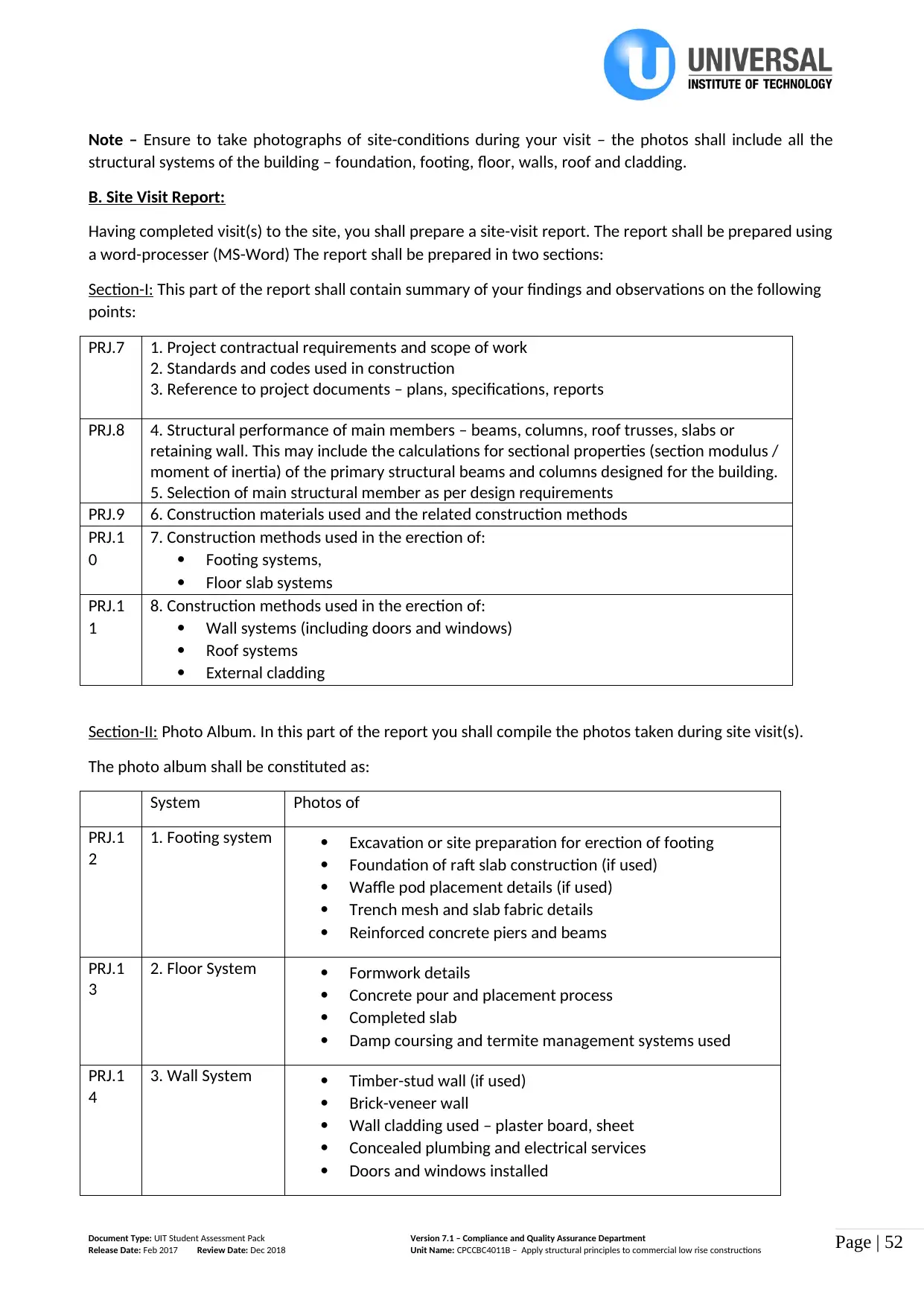
Page | 52
Note – Ensure to take photographs of site-conditions during your visit – the photos shall include all the
structural systems of the building – foundation, footing, floor, walls, roof and cladding.
B. Site Visit Report:
Having completed visit(s) to the site, you shall prepare a site-visit report. The report shall be prepared using
a word-processer (MS-Word) The report shall be prepared in two sections:
Section-I: This part of the report shall contain summary of your findings and observations on the following
points:
PRJ.7 1. Project contractual requirements and scope of work
2. Standards and codes used in construction
3. Reference to project documents – plans, specifications, reports
PRJ.8 4. Structural performance of main members – beams, columns, roof trusses, slabs or
retaining wall. This may include the calculations for sectional properties (section modulus /
moment of inertia) of the primary structural beams and columns designed for the building.
5. Selection of main structural member as per design requirements
PRJ.9 6. Construction materials used and the related construction methods
PRJ.1
0
7. Construction methods used in the erection of:
Footing systems,
Floor slab systems
PRJ.1
1
8. Construction methods used in the erection of:
Wall systems (including doors and windows)
Roof systems
External cladding
Section-II: Photo Album. In this part of the report you shall compile the photos taken during site visit(s).
The photo album shall be constituted as:
System Photos of
PRJ.1
2
1. Footing system Excavation or site preparation for erection of footing
Foundation of raft slab construction (if used)
Waffle pod placement details (if used)
Trench mesh and slab fabric details
Reinforced concrete piers and beams
PRJ.1
3
2. Floor System Formwork details
Concrete pour and placement process
Completed slab
Damp coursing and termite management systems used
PRJ.1
4
3. Wall System Timber-stud wall (if used)
Brick-veneer wall
Wall cladding used – plaster board, sheet
Concealed plumbing and electrical services
Doors and windows installed
Document Type: UIT Student Assessment Pack Version 7.1 – Compliance and Quality Assurance Department
Release Date: Feb 2017 Review Date: Dec 2018 Unit Name: CPCCBC4011B – Apply structural principles to commercial low rise constructions
Note – Ensure to take photographs of site-conditions during your visit – the photos shall include all the
structural systems of the building – foundation, footing, floor, walls, roof and cladding.
B. Site Visit Report:
Having completed visit(s) to the site, you shall prepare a site-visit report. The report shall be prepared using
a word-processer (MS-Word) The report shall be prepared in two sections:
Section-I: This part of the report shall contain summary of your findings and observations on the following
points:
PRJ.7 1. Project contractual requirements and scope of work
2. Standards and codes used in construction
3. Reference to project documents – plans, specifications, reports
PRJ.8 4. Structural performance of main members – beams, columns, roof trusses, slabs or
retaining wall. This may include the calculations for sectional properties (section modulus /
moment of inertia) of the primary structural beams and columns designed for the building.
5. Selection of main structural member as per design requirements
PRJ.9 6. Construction materials used and the related construction methods
PRJ.1
0
7. Construction methods used in the erection of:
Footing systems,
Floor slab systems
PRJ.1
1
8. Construction methods used in the erection of:
Wall systems (including doors and windows)
Roof systems
External cladding
Section-II: Photo Album. In this part of the report you shall compile the photos taken during site visit(s).
The photo album shall be constituted as:
System Photos of
PRJ.1
2
1. Footing system Excavation or site preparation for erection of footing
Foundation of raft slab construction (if used)
Waffle pod placement details (if used)
Trench mesh and slab fabric details
Reinforced concrete piers and beams
PRJ.1
3
2. Floor System Formwork details
Concrete pour and placement process
Completed slab
Damp coursing and termite management systems used
PRJ.1
4
3. Wall System Timber-stud wall (if used)
Brick-veneer wall
Wall cladding used – plaster board, sheet
Concealed plumbing and electrical services
Doors and windows installed
Document Type: UIT Student Assessment Pack Version 7.1 – Compliance and Quality Assurance Department
Release Date: Feb 2017 Review Date: Dec 2018 Unit Name: CPCCBC4011B – Apply structural principles to commercial low rise constructions
Secure Best Marks with AI Grader
Need help grading? Try our AI Grader for instant feedback on your assignments.

Page | 53
PRJ.1
5
4. Roof System Roof Tiles (Terracotta tiles, concrete tiles or any other type
of tiles)
Rafter and purlin
Metal plate roofs
Concealed plumbing, electrical or any other services
Gutter, drainage system, rain-water pipe
PRJ.1
6
5. External
Cladding
Concrete, clay and metal tiles
Shakes and shingles
Short and long run metal sheeting
For each photo, a brief description about the photo shall be provided. Identify the technical construction
principle and performance characteristics for the structural member shown in the photo. Also, ensure to
mention relevant section/clause of the NCC or Australian Standard applicable for that photo (structural
component).
Note: Ensure to collect sufficient information during your site-visits, so that you can prepare the report
thoroughly.
Document Type: UIT Student Assessment Pack Version 7.1 – Compliance and Quality Assurance Department
Release Date: Feb 2017 Review Date: Dec 2018 Unit Name: CPCCBC4011B – Apply structural principles to commercial low rise constructions
PRJ.1
5
4. Roof System Roof Tiles (Terracotta tiles, concrete tiles or any other type
of tiles)
Rafter and purlin
Metal plate roofs
Concealed plumbing, electrical or any other services
Gutter, drainage system, rain-water pipe
PRJ.1
6
5. External
Cladding
Concrete, clay and metal tiles
Shakes and shingles
Short and long run metal sheeting
For each photo, a brief description about the photo shall be provided. Identify the technical construction
principle and performance characteristics for the structural member shown in the photo. Also, ensure to
mention relevant section/clause of the NCC or Australian Standard applicable for that photo (structural
component).
Note: Ensure to collect sufficient information during your site-visits, so that you can prepare the report
thoroughly.
Document Type: UIT Student Assessment Pack Version 7.1 – Compliance and Quality Assurance Department
Release Date: Feb 2017 Review Date: Dec 2018 Unit Name: CPCCBC4011B – Apply structural principles to commercial low rise constructions
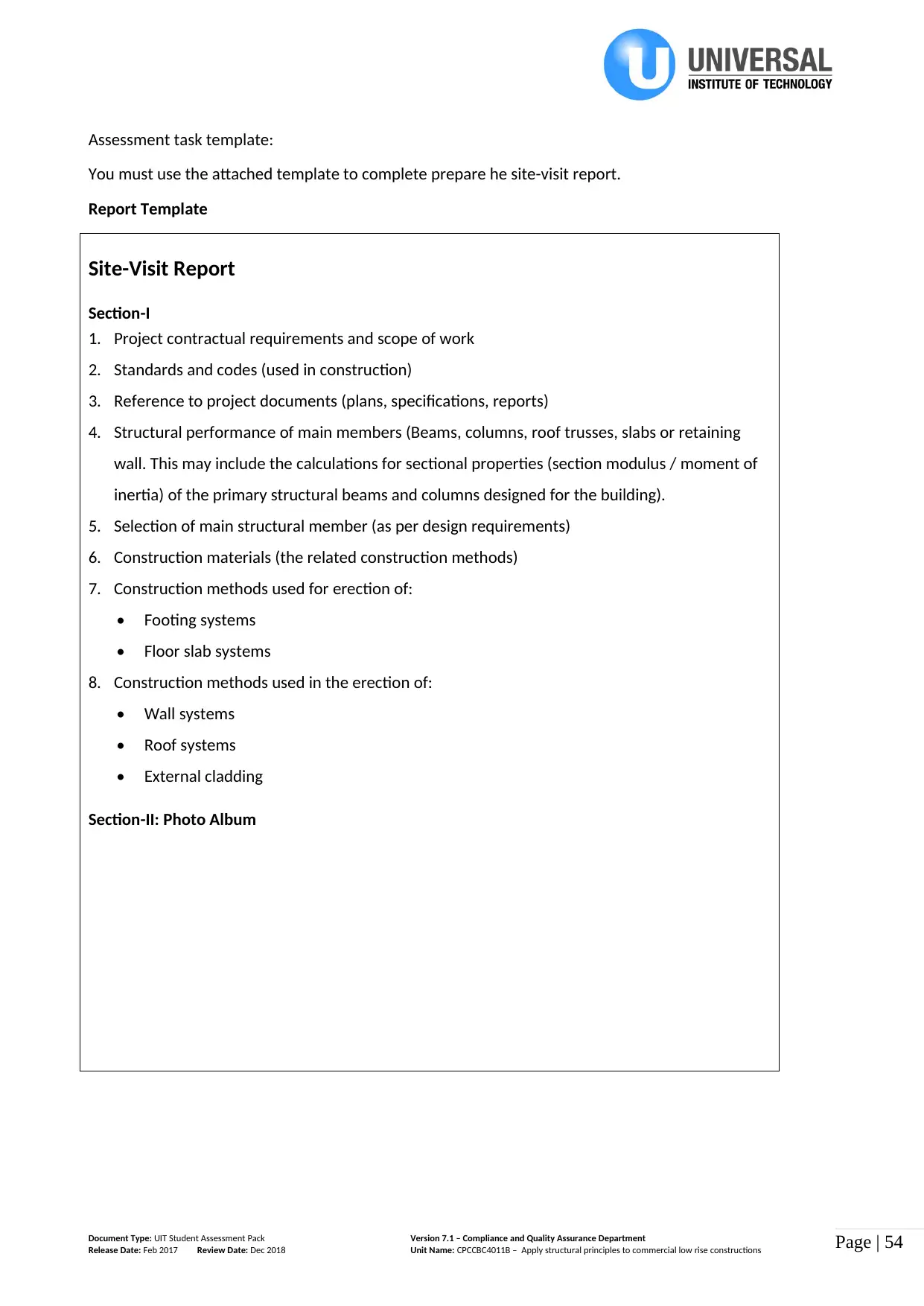
Page | 54
Assessment task template:
You must use the attached template to complete prepare he site-visit report.
Report Template
Site-Visit Report
Section-I
1. Project contractual requirements and scope of work
2. Standards and codes (used in construction)
3. Reference to project documents (plans, specifications, reports)
4. Structural performance of main members (Beams, columns, roof trusses, slabs or retaining
wall. This may include the calculations for sectional properties (section modulus / moment of
inertia) of the primary structural beams and columns designed for the building).
5. Selection of main structural member (as per design requirements)
6. Construction materials (the related construction methods)
7. Construction methods used for erection of:
• Footing systems
• Floor slab systems
8. Construction methods used in the erection of:
• Wall systems
• Roof systems
• External cladding
Section-II: Photo Album
Document Type: UIT Student Assessment Pack Version 7.1 – Compliance and Quality Assurance Department
Release Date: Feb 2017 Review Date: Dec 2018 Unit Name: CPCCBC4011B – Apply structural principles to commercial low rise constructions
Assessment task template:
You must use the attached template to complete prepare he site-visit report.
Report Template
Site-Visit Report
Section-I
1. Project contractual requirements and scope of work
2. Standards and codes (used in construction)
3. Reference to project documents (plans, specifications, reports)
4. Structural performance of main members (Beams, columns, roof trusses, slabs or retaining
wall. This may include the calculations for sectional properties (section modulus / moment of
inertia) of the primary structural beams and columns designed for the building).
5. Selection of main structural member (as per design requirements)
6. Construction materials (the related construction methods)
7. Construction methods used for erection of:
• Footing systems
• Floor slab systems
8. Construction methods used in the erection of:
• Wall systems
• Roof systems
• External cladding
Section-II: Photo Album
Document Type: UIT Student Assessment Pack Version 7.1 – Compliance and Quality Assurance Department
Release Date: Feb 2017 Review Date: Dec 2018 Unit Name: CPCCBC4011B – Apply structural principles to commercial low rise constructions
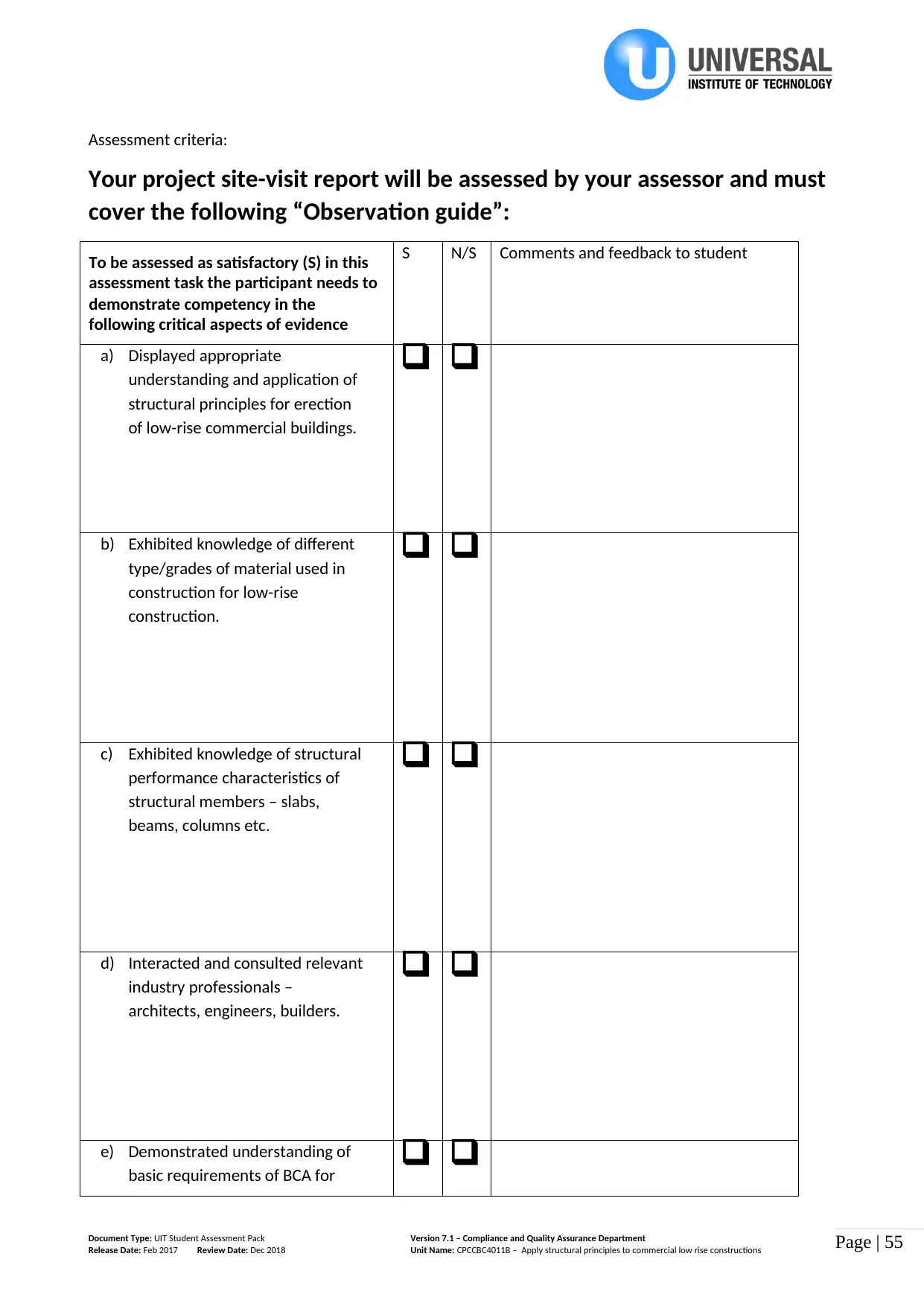
Page | 55
Assessment criteria:
Your project site-visit report will be assessed by your assessor and must
cover the following “Observation guide”:
To be assessed as satisfactory (S) in this
assessment task the participant needs to
demonstrate competency in the
following critical aspects of evidence
S N/S Comments and feedback to student
a) Displayed appropriate
understanding and application of
structural principles for erection
of low-rise commercial buildings.
b) Exhibited knowledge of different
type/grades of material used in
construction for low-rise
construction.
c) Exhibited knowledge of structural
performance characteristics of
structural members – slabs,
beams, columns etc.
d) Interacted and consulted relevant
industry professionals –
architects, engineers, builders.
e) Demonstrated understanding of
basic requirements of BCA for
Document Type: UIT Student Assessment Pack Version 7.1 – Compliance and Quality Assurance Department
Release Date: Feb 2017 Review Date: Dec 2018 Unit Name: CPCCBC4011B – Apply structural principles to commercial low rise constructions
Assessment criteria:
Your project site-visit report will be assessed by your assessor and must
cover the following “Observation guide”:
To be assessed as satisfactory (S) in this
assessment task the participant needs to
demonstrate competency in the
following critical aspects of evidence
S N/S Comments and feedback to student
a) Displayed appropriate
understanding and application of
structural principles for erection
of low-rise commercial buildings.
b) Exhibited knowledge of different
type/grades of material used in
construction for low-rise
construction.
c) Exhibited knowledge of structural
performance characteristics of
structural members – slabs,
beams, columns etc.
d) Interacted and consulted relevant
industry professionals –
architects, engineers, builders.
e) Demonstrated understanding of
basic requirements of BCA for
Document Type: UIT Student Assessment Pack Version 7.1 – Compliance and Quality Assurance Department
Release Date: Feb 2017 Review Date: Dec 2018 Unit Name: CPCCBC4011B – Apply structural principles to commercial low rise constructions
Paraphrase This Document
Need a fresh take? Get an instant paraphrase of this document with our AI Paraphraser
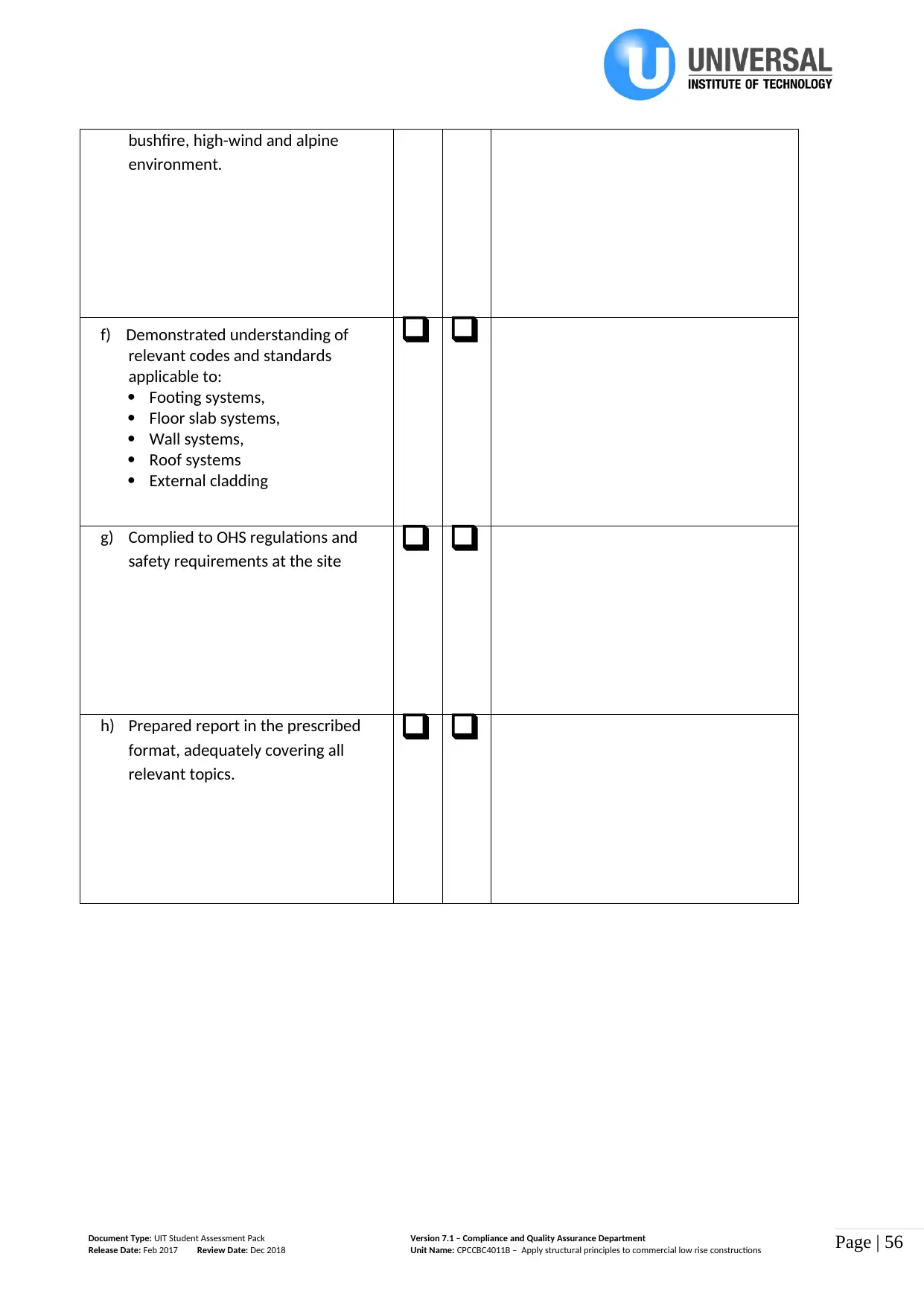
Page | 56
bushfire, high-wind and alpine
environment.
f) Demonstrated understanding of
relevant codes and standards
applicable to:
Footing systems,
Floor slab systems,
Wall systems,
Roof systems
External cladding
g) Complied to OHS regulations and
safety requirements at the site
h) Prepared report in the prescribed
format, adequately covering all
relevant topics.
Document Type: UIT Student Assessment Pack Version 7.1 – Compliance and Quality Assurance Department
Release Date: Feb 2017 Review Date: Dec 2018 Unit Name: CPCCBC4011B – Apply structural principles to commercial low rise constructions
bushfire, high-wind and alpine
environment.
f) Demonstrated understanding of
relevant codes and standards
applicable to:
Footing systems,
Floor slab systems,
Wall systems,
Roof systems
External cladding
g) Complied to OHS regulations and
safety requirements at the site
h) Prepared report in the prescribed
format, adequately covering all
relevant topics.
Document Type: UIT Student Assessment Pack Version 7.1 – Compliance and Quality Assurance Department
Release Date: Feb 2017 Review Date: Dec 2018 Unit Name: CPCCBC4011B – Apply structural principles to commercial low rise constructions
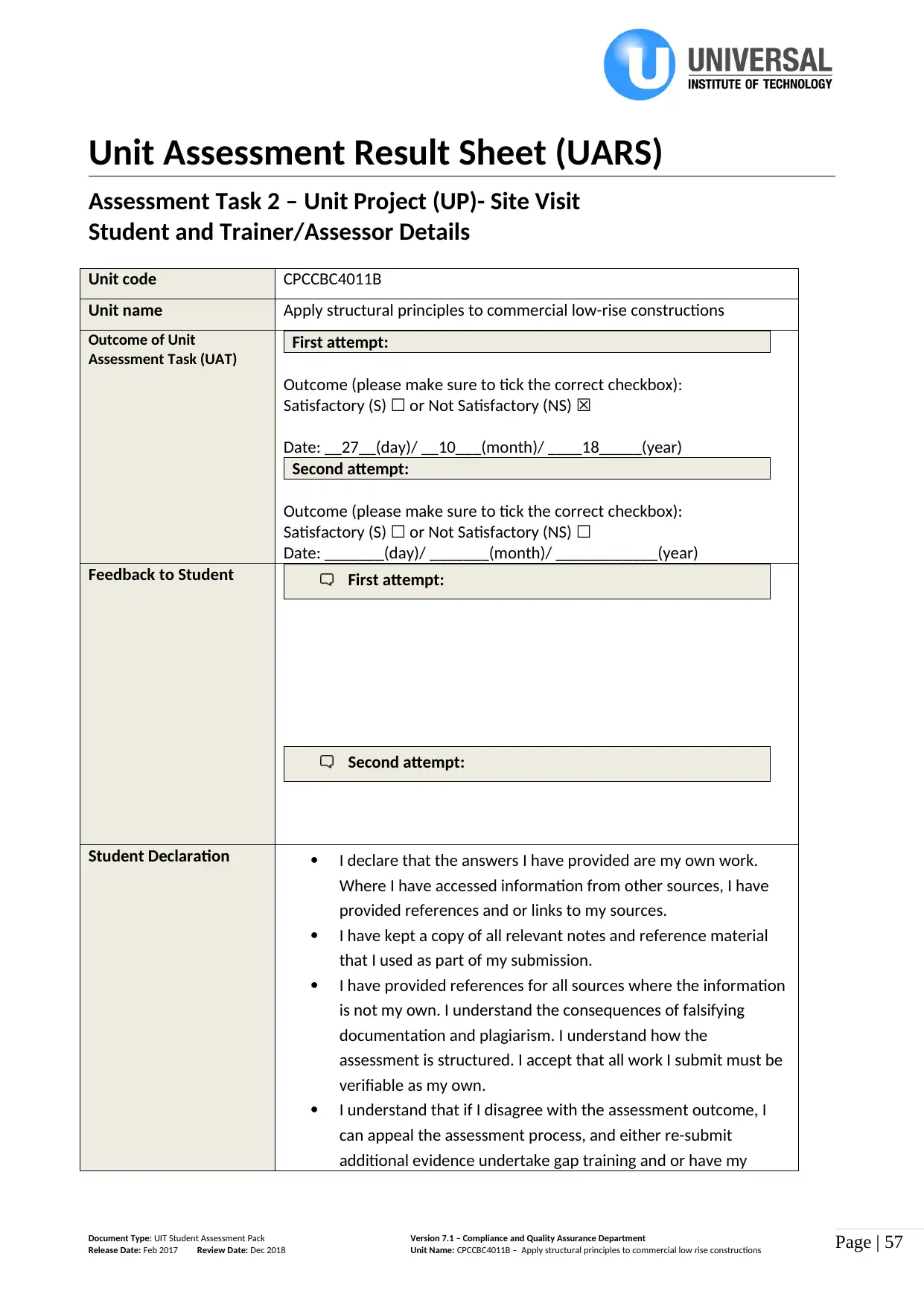
Page | 57
Unit Assessment Result Sheet (UARS)
Assessment Task 2 – Unit Project (UP)- Site Visit
Student and Trainer/Assessor Details
Unit code CPCCBC4011B
Unit name Apply structural principles to commercial low-rise constructions
Outcome of Unit
Assessment Task (UAT)
First attempt:
Outcome (please make sure to tick the correct checkbox):
Satisfactory (S) ☐ or Not Satisfactory (NS) ☒
Date: __27__(day)/ __10___(month)/ ____18_____(year)
Second attempt:
Outcome (please make sure to tick the correct checkbox):
Satisfactory (S) ☐ or Not Satisfactory (NS) ☐
Date: _______(day)/ _______(month)/ ____________(year)
Feedback to Student First attempt:
Second attempt:
Student Declaration I declare that the answers I have provided are my own work.
Where I have accessed information from other sources, I have
provided references and or links to my sources.
I have kept a copy of all relevant notes and reference material
that I used as part of my submission.
I have provided references for all sources where the information
is not my own. I understand the consequences of falsifying
documentation and plagiarism. I understand how the
assessment is structured. I accept that all work I submit must be
verifiable as my own.
I understand that if I disagree with the assessment outcome, I
can appeal the assessment process, and either re-submit
additional evidence undertake gap training and or have my
Document Type: UIT Student Assessment Pack Version 7.1 – Compliance and Quality Assurance Department
Release Date: Feb 2017 Review Date: Dec 2018 Unit Name: CPCCBC4011B – Apply structural principles to commercial low rise constructions
Unit Assessment Result Sheet (UARS)
Assessment Task 2 – Unit Project (UP)- Site Visit
Student and Trainer/Assessor Details
Unit code CPCCBC4011B
Unit name Apply structural principles to commercial low-rise constructions
Outcome of Unit
Assessment Task (UAT)
First attempt:
Outcome (please make sure to tick the correct checkbox):
Satisfactory (S) ☐ or Not Satisfactory (NS) ☒
Date: __27__(day)/ __10___(month)/ ____18_____(year)
Second attempt:
Outcome (please make sure to tick the correct checkbox):
Satisfactory (S) ☐ or Not Satisfactory (NS) ☐
Date: _______(day)/ _______(month)/ ____________(year)
Feedback to Student First attempt:
Second attempt:
Student Declaration I declare that the answers I have provided are my own work.
Where I have accessed information from other sources, I have
provided references and or links to my sources.
I have kept a copy of all relevant notes and reference material
that I used as part of my submission.
I have provided references for all sources where the information
is not my own. I understand the consequences of falsifying
documentation and plagiarism. I understand how the
assessment is structured. I accept that all work I submit must be
verifiable as my own.
I understand that if I disagree with the assessment outcome, I
can appeal the assessment process, and either re-submit
additional evidence undertake gap training and or have my
Document Type: UIT Student Assessment Pack Version 7.1 – Compliance and Quality Assurance Department
Release Date: Feb 2017 Review Date: Dec 2018 Unit Name: CPCCBC4011B – Apply structural principles to commercial low rise constructions

Page | 58
submission re-assessed.
All appeal options have been explained to me.
Student Signature DHILEN
Date 11/09/2018
Trainer/Assessor Name NASSER BABAEE
Trainer/Assessor
Declaration
I hold:
Vocational competencies at least to the level being delivered
Current relevant industry skills
Current knowledge and skills in VET, and undertake
Ongoing professional development in VET
I declare that I have conducted an assessment of this candidate’s
submission. The assessment tasks were deemed current, sufficient, valid
and reliable. I declare that I have conducted a fair, valid, reliable, and
flexible assessment. I have provided feedback to the above-named
candidate.
Trainer/Assessor
Signature
Date 27/10/2018
Office Use Only Outcome of Assessment has been entered onto the Student
Management System on _________________ (insert date)
by (insert Name) __________________________________
Document Type: UIT Student Assessment Pack Version 7.1 – Compliance and Quality Assurance Department
Release Date: Feb 2017 Review Date: Dec 2018 Unit Name: CPCCBC4011B – Apply structural principles to commercial low rise constructions
submission re-assessed.
All appeal options have been explained to me.
Student Signature DHILEN
Date 11/09/2018
Trainer/Assessor Name NASSER BABAEE
Trainer/Assessor
Declaration
I hold:
Vocational competencies at least to the level being delivered
Current relevant industry skills
Current knowledge and skills in VET, and undertake
Ongoing professional development in VET
I declare that I have conducted an assessment of this candidate’s
submission. The assessment tasks were deemed current, sufficient, valid
and reliable. I declare that I have conducted a fair, valid, reliable, and
flexible assessment. I have provided feedback to the above-named
candidate.
Trainer/Assessor
Signature
Date 27/10/2018
Office Use Only Outcome of Assessment has been entered onto the Student
Management System on _________________ (insert date)
by (insert Name) __________________________________
Document Type: UIT Student Assessment Pack Version 7.1 – Compliance and Quality Assurance Department
Release Date: Feb 2017 Review Date: Dec 2018 Unit Name: CPCCBC4011B – Apply structural principles to commercial low rise constructions
Secure Best Marks with AI Grader
Need help grading? Try our AI Grader for instant feedback on your assignments.

Page | 59
Unit Pre-Assessment Checklist (UPAC)
UAT 3 – Presentation / Roleplay
Purpose of the checklist
The pre-assessment checklist helps students determine if they are ready for assessment. The
trainer/assessor must review the checklist with the student before the student attempts the assessment
task. If any items on the checklist are incomplete or not clear to the student, the trainer/assessor must
provide relevant information to the student to ensure they understand the requirements of the assessment
task. The student must ensure they are ready for the assessment task before undertaking it.
Section 1: Information for Students
• Please make sure you have completed the necessary prior learning before attempting this
assessment.
• Please make sure your trainer/assessor clearly explained the assessment process and tasks to be
completed.
• Please make sure you understand what evidence is required to be collected and how.
• Please make sure you know your rights and the Complaints and Appeal process.
• Please make sure you discuss any special needs or reasonable adjustments to be considered during
the assessment (refer to the Reasonable Adjustments Strategy Matrix and negotiate these with
your trainer/assessor).
• Please make sure that you have access to a computer and the internet (if you prefer to type the
answers).
• Please ensure that you have all the required resources needed to complete this Unit Assessment
Task (UAT).
• Due date of this assessment task is according to your timetable.
• In exceptional (compelling and compassionate) circumstances, an extension to submit an
assessment can be granted by the trainer/assessor.
• Evidence of the compelling and compassionate circumstances must be provided together with your
request for an extension to submit your assessment work.
• Request for an extension to submit your assessment work must be made before the due date of
this assessment task.
Section 2: Reasonable adjustments
• Students with carer responsibilities, cultural or religious obligations, English as an additional
language, disability etc. can request for reasonable adjustments.
• Please note, integrity of the unit/course will not be lowered to accommodate the needs of any
student, but there is a requirement to be flexible about the way in which it is delivered or assessed.
• The Disability Standards for Education requires institutions to take reasonable steps to enable the
student with a disability to participate in education on the same basis as a student without a
disability.
• Trainer/Assessor must complete the section below “Reasonable Adjustment Strategies Matrix” to
ensure the explanation and correct strategy have been recorded and implemented.
• Trainer/Assessor must notify the VET Department for any reasonable adjustments made.
• All evidence and supplementary documentation must be submitted with the assessment pack to
the VET Department.
Document Type: UIT Student Assessment Pack Version 7.1 – Compliance and Quality Assurance Department
Release Date: Feb 2017 Review Date: Dec 2018 Unit Name: CPCCBC4011B – Apply structural principles to commercial low rise constructions
Unit Pre-Assessment Checklist (UPAC)
UAT 3 – Presentation / Roleplay
Purpose of the checklist
The pre-assessment checklist helps students determine if they are ready for assessment. The
trainer/assessor must review the checklist with the student before the student attempts the assessment
task. If any items on the checklist are incomplete or not clear to the student, the trainer/assessor must
provide relevant information to the student to ensure they understand the requirements of the assessment
task. The student must ensure they are ready for the assessment task before undertaking it.
Section 1: Information for Students
• Please make sure you have completed the necessary prior learning before attempting this
assessment.
• Please make sure your trainer/assessor clearly explained the assessment process and tasks to be
completed.
• Please make sure you understand what evidence is required to be collected and how.
• Please make sure you know your rights and the Complaints and Appeal process.
• Please make sure you discuss any special needs or reasonable adjustments to be considered during
the assessment (refer to the Reasonable Adjustments Strategy Matrix and negotiate these with
your trainer/assessor).
• Please make sure that you have access to a computer and the internet (if you prefer to type the
answers).
• Please ensure that you have all the required resources needed to complete this Unit Assessment
Task (UAT).
• Due date of this assessment task is according to your timetable.
• In exceptional (compelling and compassionate) circumstances, an extension to submit an
assessment can be granted by the trainer/assessor.
• Evidence of the compelling and compassionate circumstances must be provided together with your
request for an extension to submit your assessment work.
• Request for an extension to submit your assessment work must be made before the due date of
this assessment task.
Section 2: Reasonable adjustments
• Students with carer responsibilities, cultural or religious obligations, English as an additional
language, disability etc. can request for reasonable adjustments.
• Please note, integrity of the unit/course will not be lowered to accommodate the needs of any
student, but there is a requirement to be flexible about the way in which it is delivered or assessed.
• The Disability Standards for Education requires institutions to take reasonable steps to enable the
student with a disability to participate in education on the same basis as a student without a
disability.
• Trainer/Assessor must complete the section below “Reasonable Adjustment Strategies Matrix” to
ensure the explanation and correct strategy have been recorded and implemented.
• Trainer/Assessor must notify the VET Department for any reasonable adjustments made.
• All evidence and supplementary documentation must be submitted with the assessment pack to
the VET Department.
Document Type: UIT Student Assessment Pack Version 7.1 – Compliance and Quality Assurance Department
Release Date: Feb 2017 Review Date: Dec 2018 Unit Name: CPCCBC4011B – Apply structural principles to commercial low rise constructions
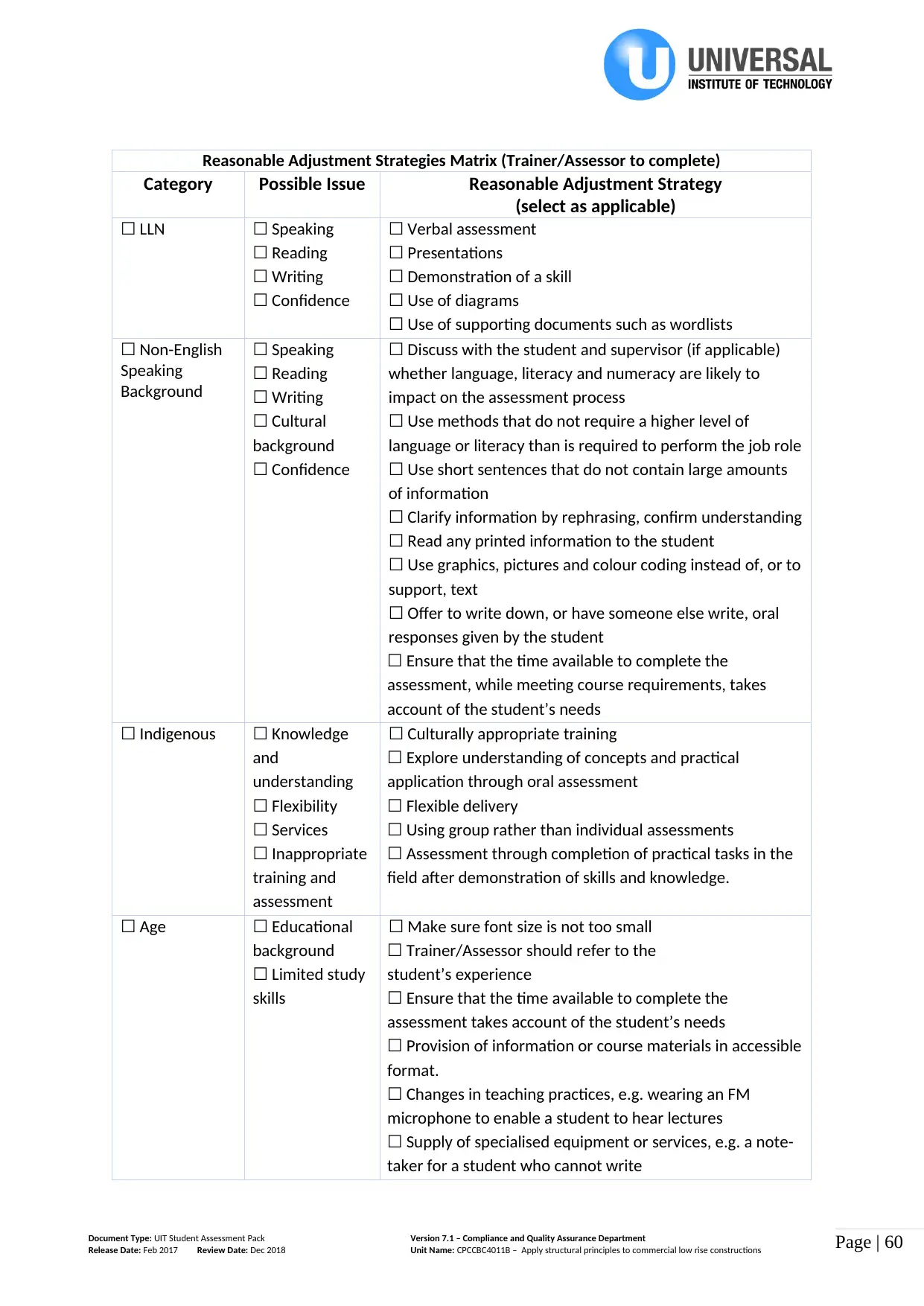
Page | 60
Reasonable Adjustment Strategies Matrix (Trainer/Assessor to complete)
Category Possible Issue Reasonable Adjustment Strategy
(select as applicable)
☐ LLN ☐ Speaking
☐ Reading
☐ Writing
☐ Confidence
☐ Verbal assessment
☐ Presentations
☐ Demonstration of a skill
☐ Use of diagrams
☐ Use of supporting documents such as wordlists
☐ Non-English
Speaking
Background
☐ Speaking
☐ Reading
☐ Writing
☐ Cultural
background
☐ Confidence
☐ Discuss with the student and supervisor (if applicable)
whether language, literacy and numeracy are likely to
impact on the assessment process
☐ Use methods that do not require a higher level of
language or literacy than is required to perform the job role
☐ Use short sentences that do not contain large amounts
of information
☐ Clarify information by rephrasing, confirm understanding
☐ Read any printed information to the student
☐ Use graphics, pictures and colour coding instead of, or to
support, text
☐ Offer to write down, or have someone else write, oral
responses given by the student
☐ Ensure that the time available to complete the
assessment, while meeting course requirements, takes
account of the student’s needs
☐ Indigenous ☐ Knowledge
and
understanding
☐ Flexibility
☐ Services
☐ Inappropriate
training and
assessment
☐ Culturally appropriate training
☐ Explore understanding of concepts and practical
application through oral assessment
☐ Flexible delivery
☐ Using group rather than individual assessments
☐ Assessment through completion of practical tasks in the
field after demonstration of skills and knowledge.
☐ Age ☐ Educational
background
☐ Limited study
skills
☐ Make sure font size is not too small
☐ Trainer/Assessor should refer to the
student’s experience
☐ Ensure that the time available to complete the
assessment takes account of the student’s needs
☐ Provision of information or course materials in accessible
format.
☐ Changes in teaching practices, e.g. wearing an FM
microphone to enable a student to hear lectures
☐ Supply of specialised equipment or services, e.g. a note-
taker for a student who cannot write
Document Type: UIT Student Assessment Pack Version 7.1 – Compliance and Quality Assurance Department
Release Date: Feb 2017 Review Date: Dec 2018 Unit Name: CPCCBC4011B – Apply structural principles to commercial low rise constructions
Reasonable Adjustment Strategies Matrix (Trainer/Assessor to complete)
Category Possible Issue Reasonable Adjustment Strategy
(select as applicable)
☐ LLN ☐ Speaking
☐ Reading
☐ Writing
☐ Confidence
☐ Verbal assessment
☐ Presentations
☐ Demonstration of a skill
☐ Use of diagrams
☐ Use of supporting documents such as wordlists
☐ Non-English
Speaking
Background
☐ Speaking
☐ Reading
☐ Writing
☐ Cultural
background
☐ Confidence
☐ Discuss with the student and supervisor (if applicable)
whether language, literacy and numeracy are likely to
impact on the assessment process
☐ Use methods that do not require a higher level of
language or literacy than is required to perform the job role
☐ Use short sentences that do not contain large amounts
of information
☐ Clarify information by rephrasing, confirm understanding
☐ Read any printed information to the student
☐ Use graphics, pictures and colour coding instead of, or to
support, text
☐ Offer to write down, or have someone else write, oral
responses given by the student
☐ Ensure that the time available to complete the
assessment, while meeting course requirements, takes
account of the student’s needs
☐ Indigenous ☐ Knowledge
and
understanding
☐ Flexibility
☐ Services
☐ Inappropriate
training and
assessment
☐ Culturally appropriate training
☐ Explore understanding of concepts and practical
application through oral assessment
☐ Flexible delivery
☐ Using group rather than individual assessments
☐ Assessment through completion of practical tasks in the
field after demonstration of skills and knowledge.
☐ Age ☐ Educational
background
☐ Limited study
skills
☐ Make sure font size is not too small
☐ Trainer/Assessor should refer to the
student’s experience
☐ Ensure that the time available to complete the
assessment takes account of the student’s needs
☐ Provision of information or course materials in accessible
format.
☐ Changes in teaching practices, e.g. wearing an FM
microphone to enable a student to hear lectures
☐ Supply of specialised equipment or services, e.g. a note-
taker for a student who cannot write
Document Type: UIT Student Assessment Pack Version 7.1 – Compliance and Quality Assurance Department
Release Date: Feb 2017 Review Date: Dec 2018 Unit Name: CPCCBC4011B – Apply structural principles to commercial low rise constructions
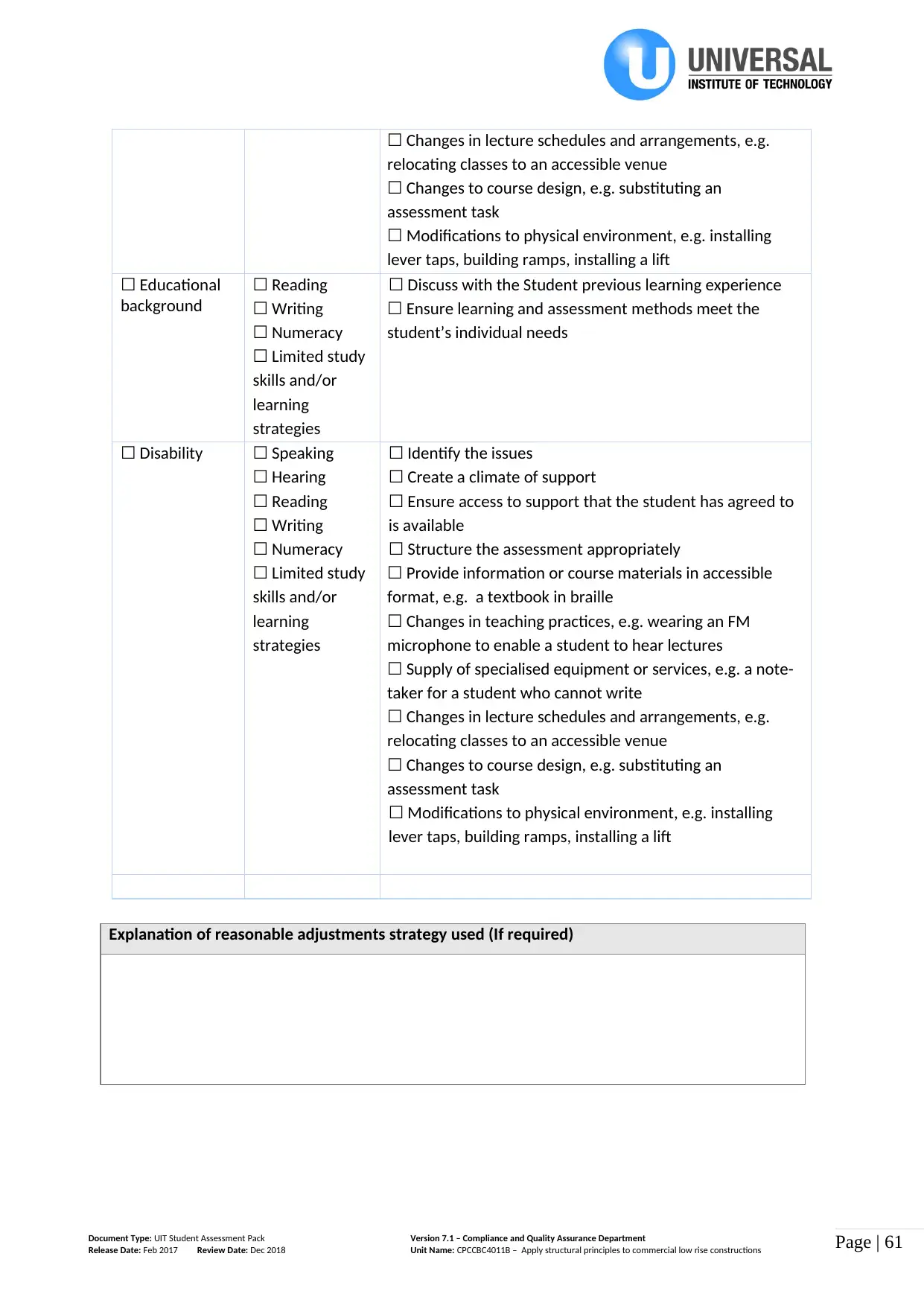
Page | 61
☐ Changes in lecture schedules and arrangements, e.g.
relocating classes to an accessible venue
☐ Changes to course design, e.g. substituting an
assessment task
☐ Modifications to physical environment, e.g. installing
lever taps, building ramps, installing a lift
☐ Educational
background
☐ Reading
☐ Writing
☐ Numeracy
☐ Limited study
skills and/or
learning
strategies
☐ Discuss with the Student previous learning experience
☐ Ensure learning and assessment methods meet the
student’s individual needs
☐ Disability ☐ Speaking
☐ Hearing
☐ Reading
☐ Writing
☐ Numeracy
☐ Limited study
skills and/or
learning
strategies
☐ Identify the issues
☐ Create a climate of support
☐ Ensure access to support that the student has agreed to
is available
☐ Structure the assessment appropriately
☐ Provide information or course materials in accessible
format, e.g. a textbook in braille
☐ Changes in teaching practices, e.g. wearing an FM
microphone to enable a student to hear lectures
☐ Supply of specialised equipment or services, e.g. a note-
taker for a student who cannot write
☐ Changes in lecture schedules and arrangements, e.g.
relocating classes to an accessible venue
☐ Changes to course design, e.g. substituting an
assessment task
☐ Modifications to physical environment, e.g. installing
lever taps, building ramps, installing a lift
Explanation of reasonable adjustments strategy used (If required)
Document Type: UIT Student Assessment Pack Version 7.1 – Compliance and Quality Assurance Department
Release Date: Feb 2017 Review Date: Dec 2018 Unit Name: CPCCBC4011B – Apply structural principles to commercial low rise constructions
☐ Changes in lecture schedules and arrangements, e.g.
relocating classes to an accessible venue
☐ Changes to course design, e.g. substituting an
assessment task
☐ Modifications to physical environment, e.g. installing
lever taps, building ramps, installing a lift
☐ Educational
background
☐ Reading
☐ Writing
☐ Numeracy
☐ Limited study
skills and/or
learning
strategies
☐ Discuss with the Student previous learning experience
☐ Ensure learning and assessment methods meet the
student’s individual needs
☐ Disability ☐ Speaking
☐ Hearing
☐ Reading
☐ Writing
☐ Numeracy
☐ Limited study
skills and/or
learning
strategies
☐ Identify the issues
☐ Create a climate of support
☐ Ensure access to support that the student has agreed to
is available
☐ Structure the assessment appropriately
☐ Provide information or course materials in accessible
format, e.g. a textbook in braille
☐ Changes in teaching practices, e.g. wearing an FM
microphone to enable a student to hear lectures
☐ Supply of specialised equipment or services, e.g. a note-
taker for a student who cannot write
☐ Changes in lecture schedules and arrangements, e.g.
relocating classes to an accessible venue
☐ Changes to course design, e.g. substituting an
assessment task
☐ Modifications to physical environment, e.g. installing
lever taps, building ramps, installing a lift
Explanation of reasonable adjustments strategy used (If required)
Document Type: UIT Student Assessment Pack Version 7.1 – Compliance and Quality Assurance Department
Release Date: Feb 2017 Review Date: Dec 2018 Unit Name: CPCCBC4011B – Apply structural principles to commercial low rise constructions
Paraphrase This Document
Need a fresh take? Get an instant paraphrase of this document with our AI Paraphraser
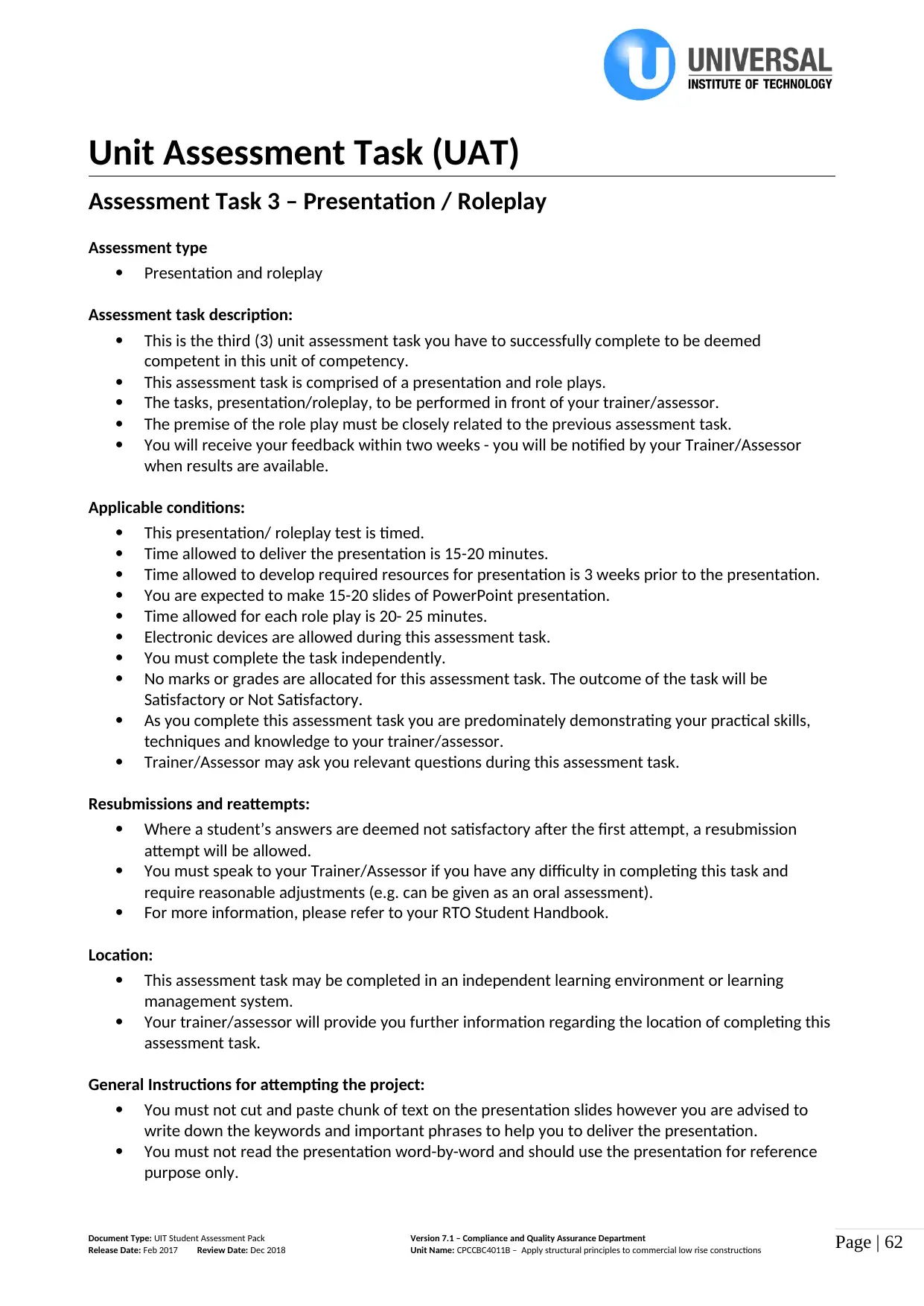
Page | 62
Unit Assessment Task (UAT)
Assessment Task 3 – Presentation / Roleplay
Assessment type
Presentation and roleplay
Assessment task description:
This is the third (3) unit assessment task you have to successfully complete to be deemed
competent in this unit of competency.
This assessment task is comprised of a presentation and role plays.
The tasks, presentation/roleplay, to be performed in front of your trainer/assessor.
The premise of the role play must be closely related to the previous assessment task.
You will receive your feedback within two weeks - you will be notified by your Trainer/Assessor
when results are available.
Applicable conditions:
This presentation/ roleplay test is timed.
Time allowed to deliver the presentation is 15-20 minutes.
Time allowed to develop required resources for presentation is 3 weeks prior to the presentation.
You are expected to make 15-20 slides of PowerPoint presentation.
Time allowed for each role play is 20- 25 minutes.
Electronic devices are allowed during this assessment task.
You must complete the task independently.
No marks or grades are allocated for this assessment task. The outcome of the task will be
Satisfactory or Not Satisfactory.
As you complete this assessment task you are predominately demonstrating your practical skills,
techniques and knowledge to your trainer/assessor.
Trainer/Assessor may ask you relevant questions during this assessment task.
Resubmissions and reattempts:
Where a student’s answers are deemed not satisfactory after the first attempt, a resubmission
attempt will be allowed.
You must speak to your Trainer/Assessor if you have any difficulty in completing this task and
require reasonable adjustments (e.g. can be given as an oral assessment).
For more information, please refer to your RTO Student Handbook.
Location:
This assessment task may be completed in an independent learning environment or learning
management system.
Your trainer/assessor will provide you further information regarding the location of completing this
assessment task.
General Instructions for attempting the project:
You must not cut and paste chunk of text on the presentation slides however you are advised to
write down the keywords and important phrases to help you to deliver the presentation.
You must not read the presentation word-by-word and should use the presentation for reference
purpose only.
Document Type: UIT Student Assessment Pack Version 7.1 – Compliance and Quality Assurance Department
Release Date: Feb 2017 Review Date: Dec 2018 Unit Name: CPCCBC4011B – Apply structural principles to commercial low rise constructions
Unit Assessment Task (UAT)
Assessment Task 3 – Presentation / Roleplay
Assessment type
Presentation and roleplay
Assessment task description:
This is the third (3) unit assessment task you have to successfully complete to be deemed
competent in this unit of competency.
This assessment task is comprised of a presentation and role plays.
The tasks, presentation/roleplay, to be performed in front of your trainer/assessor.
The premise of the role play must be closely related to the previous assessment task.
You will receive your feedback within two weeks - you will be notified by your Trainer/Assessor
when results are available.
Applicable conditions:
This presentation/ roleplay test is timed.
Time allowed to deliver the presentation is 15-20 minutes.
Time allowed to develop required resources for presentation is 3 weeks prior to the presentation.
You are expected to make 15-20 slides of PowerPoint presentation.
Time allowed for each role play is 20- 25 minutes.
Electronic devices are allowed during this assessment task.
You must complete the task independently.
No marks or grades are allocated for this assessment task. The outcome of the task will be
Satisfactory or Not Satisfactory.
As you complete this assessment task you are predominately demonstrating your practical skills,
techniques and knowledge to your trainer/assessor.
Trainer/Assessor may ask you relevant questions during this assessment task.
Resubmissions and reattempts:
Where a student’s answers are deemed not satisfactory after the first attempt, a resubmission
attempt will be allowed.
You must speak to your Trainer/Assessor if you have any difficulty in completing this task and
require reasonable adjustments (e.g. can be given as an oral assessment).
For more information, please refer to your RTO Student Handbook.
Location:
This assessment task may be completed in an independent learning environment or learning
management system.
Your trainer/assessor will provide you further information regarding the location of completing this
assessment task.
General Instructions for attempting the project:
You must not cut and paste chunk of text on the presentation slides however you are advised to
write down the keywords and important phrases to help you to deliver the presentation.
You must not read the presentation word-by-word and should use the presentation for reference
purpose only.
Document Type: UIT Student Assessment Pack Version 7.1 – Compliance and Quality Assurance Department
Release Date: Feb 2017 Review Date: Dec 2018 Unit Name: CPCCBC4011B – Apply structural principles to commercial low rise constructions
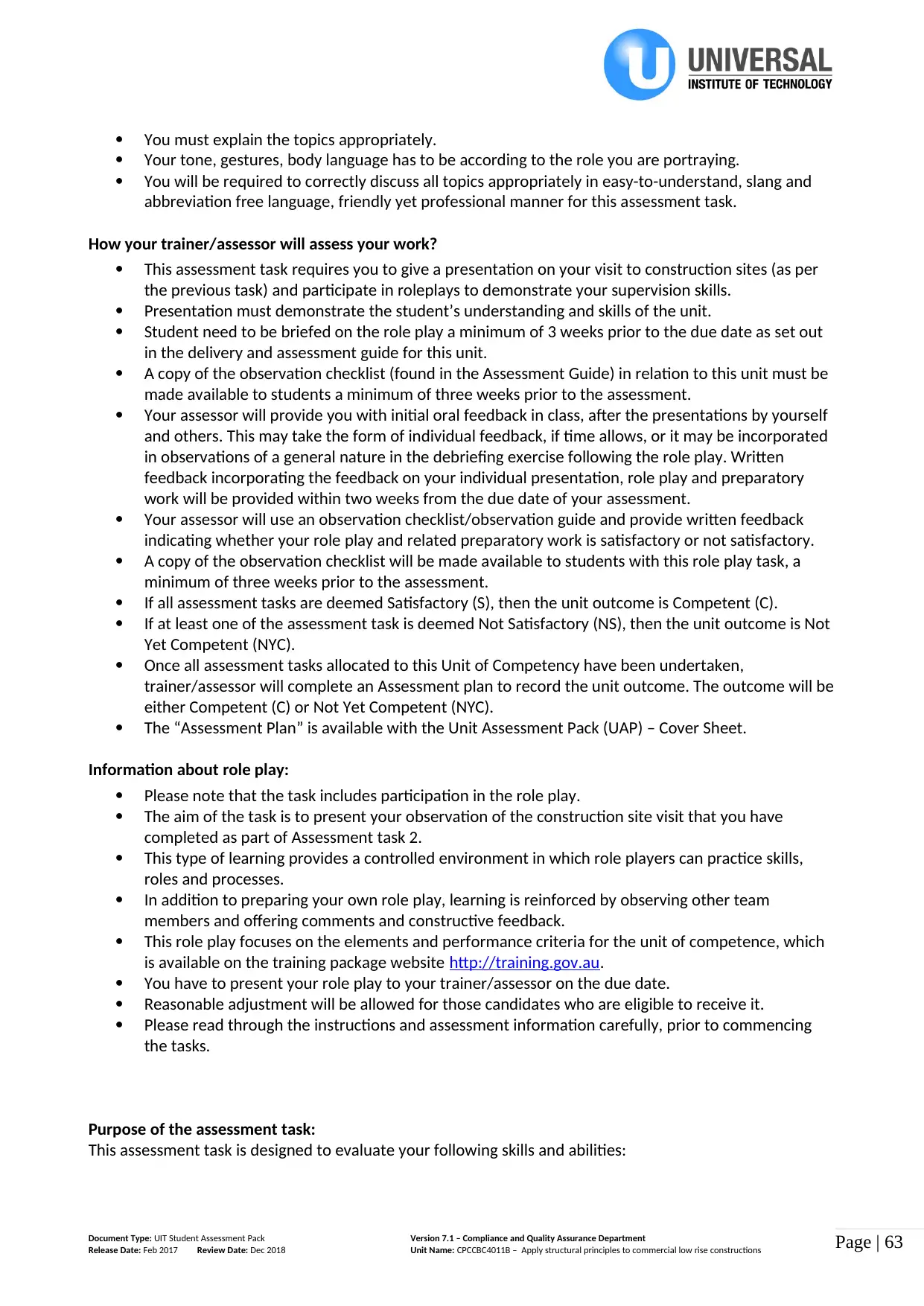
Page | 63
You must explain the topics appropriately.
Your tone, gestures, body language has to be according to the role you are portraying.
You will be required to correctly discuss all topics appropriately in easy-to-understand, slang and
abbreviation free language, friendly yet professional manner for this assessment task.
How your trainer/assessor will assess your work?
This assessment task requires you to give a presentation on your visit to construction sites (as per
the previous task) and participate in roleplays to demonstrate your supervision skills.
Presentation must demonstrate the student’s understanding and skills of the unit.
Student need to be briefed on the role play a minimum of 3 weeks prior to the due date as set out
in the delivery and assessment guide for this unit.
A copy of the observation checklist (found in the Assessment Guide) in relation to this unit must be
made available to students a minimum of three weeks prior to the assessment.
Your assessor will provide you with initial oral feedback in class, after the presentations by yourself
and others. This may take the form of individual feedback, if time allows, or it may be incorporated
in observations of a general nature in the debriefing exercise following the role play. Written
feedback incorporating the feedback on your individual presentation, role play and preparatory
work will be provided within two weeks from the due date of your assessment.
Your assessor will use an observation checklist/observation guide and provide written feedback
indicating whether your role play and related preparatory work is satisfactory or not satisfactory.
A copy of the observation checklist will be made available to students with this role play task, a
minimum of three weeks prior to the assessment.
If all assessment tasks are deemed Satisfactory (S), then the unit outcome is Competent (C).
If at least one of the assessment task is deemed Not Satisfactory (NS), then the unit outcome is Not
Yet Competent (NYC).
Once all assessment tasks allocated to this Unit of Competency have been undertaken,
trainer/assessor will complete an Assessment plan to record the unit outcome. The outcome will be
either Competent (C) or Not Yet Competent (NYC).
The “Assessment Plan” is available with the Unit Assessment Pack (UAP) – Cover Sheet.
Information about role play:
Please note that the task includes participation in the role play.
The aim of the task is to present your observation of the construction site visit that you have
completed as part of Assessment task 2.
This type of learning provides a controlled environment in which role players can practice skills,
roles and processes.
In addition to preparing your own role play, learning is reinforced by observing other team
members and offering comments and constructive feedback.
This role play focuses on the elements and performance criteria for the unit of competence, which
is available on the training package website http://training.gov.au.
You have to present your role play to your trainer/assessor on the due date.
Reasonable adjustment will be allowed for those candidates who are eligible to receive it.
Please read through the instructions and assessment information carefully, prior to commencing
the tasks.
Purpose of the assessment task:
This assessment task is designed to evaluate your following skills and abilities:
Document Type: UIT Student Assessment Pack Version 7.1 – Compliance and Quality Assurance Department
Release Date: Feb 2017 Review Date: Dec 2018 Unit Name: CPCCBC4011B – Apply structural principles to commercial low rise constructions
You must explain the topics appropriately.
Your tone, gestures, body language has to be according to the role you are portraying.
You will be required to correctly discuss all topics appropriately in easy-to-understand, slang and
abbreviation free language, friendly yet professional manner for this assessment task.
How your trainer/assessor will assess your work?
This assessment task requires you to give a presentation on your visit to construction sites (as per
the previous task) and participate in roleplays to demonstrate your supervision skills.
Presentation must demonstrate the student’s understanding and skills of the unit.
Student need to be briefed on the role play a minimum of 3 weeks prior to the due date as set out
in the delivery and assessment guide for this unit.
A copy of the observation checklist (found in the Assessment Guide) in relation to this unit must be
made available to students a minimum of three weeks prior to the assessment.
Your assessor will provide you with initial oral feedback in class, after the presentations by yourself
and others. This may take the form of individual feedback, if time allows, or it may be incorporated
in observations of a general nature in the debriefing exercise following the role play. Written
feedback incorporating the feedback on your individual presentation, role play and preparatory
work will be provided within two weeks from the due date of your assessment.
Your assessor will use an observation checklist/observation guide and provide written feedback
indicating whether your role play and related preparatory work is satisfactory or not satisfactory.
A copy of the observation checklist will be made available to students with this role play task, a
minimum of three weeks prior to the assessment.
If all assessment tasks are deemed Satisfactory (S), then the unit outcome is Competent (C).
If at least one of the assessment task is deemed Not Satisfactory (NS), then the unit outcome is Not
Yet Competent (NYC).
Once all assessment tasks allocated to this Unit of Competency have been undertaken,
trainer/assessor will complete an Assessment plan to record the unit outcome. The outcome will be
either Competent (C) or Not Yet Competent (NYC).
The “Assessment Plan” is available with the Unit Assessment Pack (UAP) – Cover Sheet.
Information about role play:
Please note that the task includes participation in the role play.
The aim of the task is to present your observation of the construction site visit that you have
completed as part of Assessment task 2.
This type of learning provides a controlled environment in which role players can practice skills,
roles and processes.
In addition to preparing your own role play, learning is reinforced by observing other team
members and offering comments and constructive feedback.
This role play focuses on the elements and performance criteria for the unit of competence, which
is available on the training package website http://training.gov.au.
You have to present your role play to your trainer/assessor on the due date.
Reasonable adjustment will be allowed for those candidates who are eligible to receive it.
Please read through the instructions and assessment information carefully, prior to commencing
the tasks.
Purpose of the assessment task:
This assessment task is designed to evaluate your following skills and abilities:
Document Type: UIT Student Assessment Pack Version 7.1 – Compliance and Quality Assurance Department
Release Date: Feb 2017 Review Date: Dec 2018 Unit Name: CPCCBC4011B – Apply structural principles to commercial low rise constructions
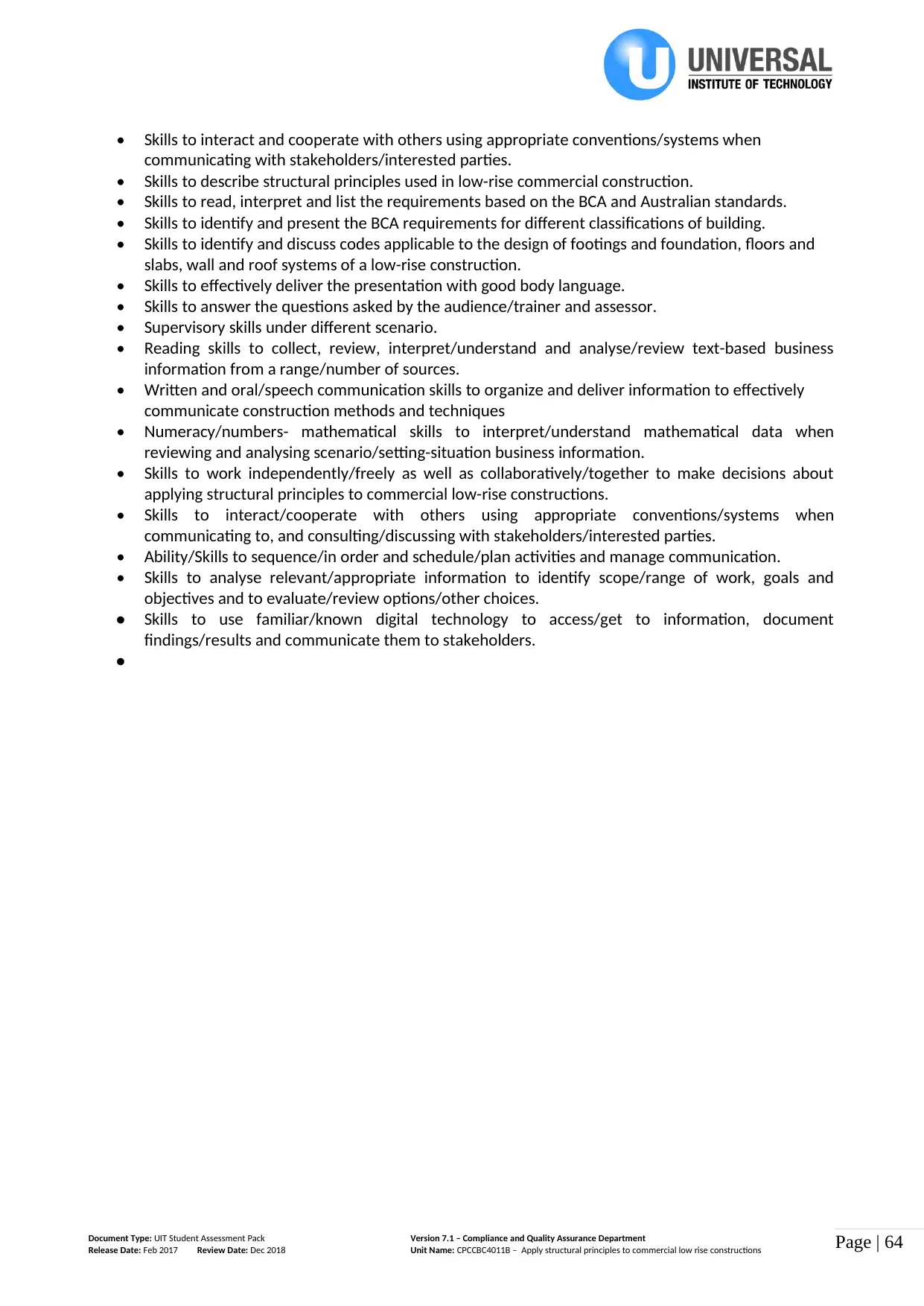
Page | 64
• Skills to interact and cooperate with others using appropriate conventions/systems when
communicating with stakeholders/interested parties.
• Skills to describe structural principles used in low-rise commercial construction.
• Skills to read, interpret and list the requirements based on the BCA and Australian standards.
• Skills to identify and present the BCA requirements for different classifications of building.
• Skills to identify and discuss codes applicable to the design of footings and foundation, floors and
slabs, wall and roof systems of a low-rise construction.
• Skills to effectively deliver the presentation with good body language.
• Skills to answer the questions asked by the audience/trainer and assessor.
• Supervisory skills under different scenario.
• Reading skills to collect, review, interpret/understand and analyse/review text-based business
information from a range/number of sources.
• Written and oral/speech communication skills to organize and deliver information to effectively
communicate construction methods and techniques
• Numeracy/numbers- mathematical skills to interpret/understand mathematical data when
reviewing and analysing scenario/setting-situation business information.
• Skills to work independently/freely as well as collaboratively/together to make decisions about
applying structural principles to commercial low-rise constructions.
• Skills to interact/cooperate with others using appropriate conventions/systems when
communicating to, and consulting/discussing with stakeholders/interested parties.
• Ability/Skills to sequence/in order and schedule/plan activities and manage communication.
• Skills to analyse relevant/appropriate information to identify scope/range of work, goals and
objectives and to evaluate/review options/other choices.
• Skills to use familiar/known digital technology to access/get to information, document
findings/results and communicate them to stakeholders.
•
Document Type: UIT Student Assessment Pack Version 7.1 – Compliance and Quality Assurance Department
Release Date: Feb 2017 Review Date: Dec 2018 Unit Name: CPCCBC4011B – Apply structural principles to commercial low rise constructions
• Skills to interact and cooperate with others using appropriate conventions/systems when
communicating with stakeholders/interested parties.
• Skills to describe structural principles used in low-rise commercial construction.
• Skills to read, interpret and list the requirements based on the BCA and Australian standards.
• Skills to identify and present the BCA requirements for different classifications of building.
• Skills to identify and discuss codes applicable to the design of footings and foundation, floors and
slabs, wall and roof systems of a low-rise construction.
• Skills to effectively deliver the presentation with good body language.
• Skills to answer the questions asked by the audience/trainer and assessor.
• Supervisory skills under different scenario.
• Reading skills to collect, review, interpret/understand and analyse/review text-based business
information from a range/number of sources.
• Written and oral/speech communication skills to organize and deliver information to effectively
communicate construction methods and techniques
• Numeracy/numbers- mathematical skills to interpret/understand mathematical data when
reviewing and analysing scenario/setting-situation business information.
• Skills to work independently/freely as well as collaboratively/together to make decisions about
applying structural principles to commercial low-rise constructions.
• Skills to interact/cooperate with others using appropriate conventions/systems when
communicating to, and consulting/discussing with stakeholders/interested parties.
• Ability/Skills to sequence/in order and schedule/plan activities and manage communication.
• Skills to analyse relevant/appropriate information to identify scope/range of work, goals and
objectives and to evaluate/review options/other choices.
• Skills to use familiar/known digital technology to access/get to information, document
findings/results and communicate them to stakeholders.
•
Document Type: UIT Student Assessment Pack Version 7.1 – Compliance and Quality Assurance Department
Release Date: Feb 2017 Review Date: Dec 2018 Unit Name: CPCCBC4011B – Apply structural principles to commercial low rise constructions
Secure Best Marks with AI Grader
Need help grading? Try our AI Grader for instant feedback on your assignments.
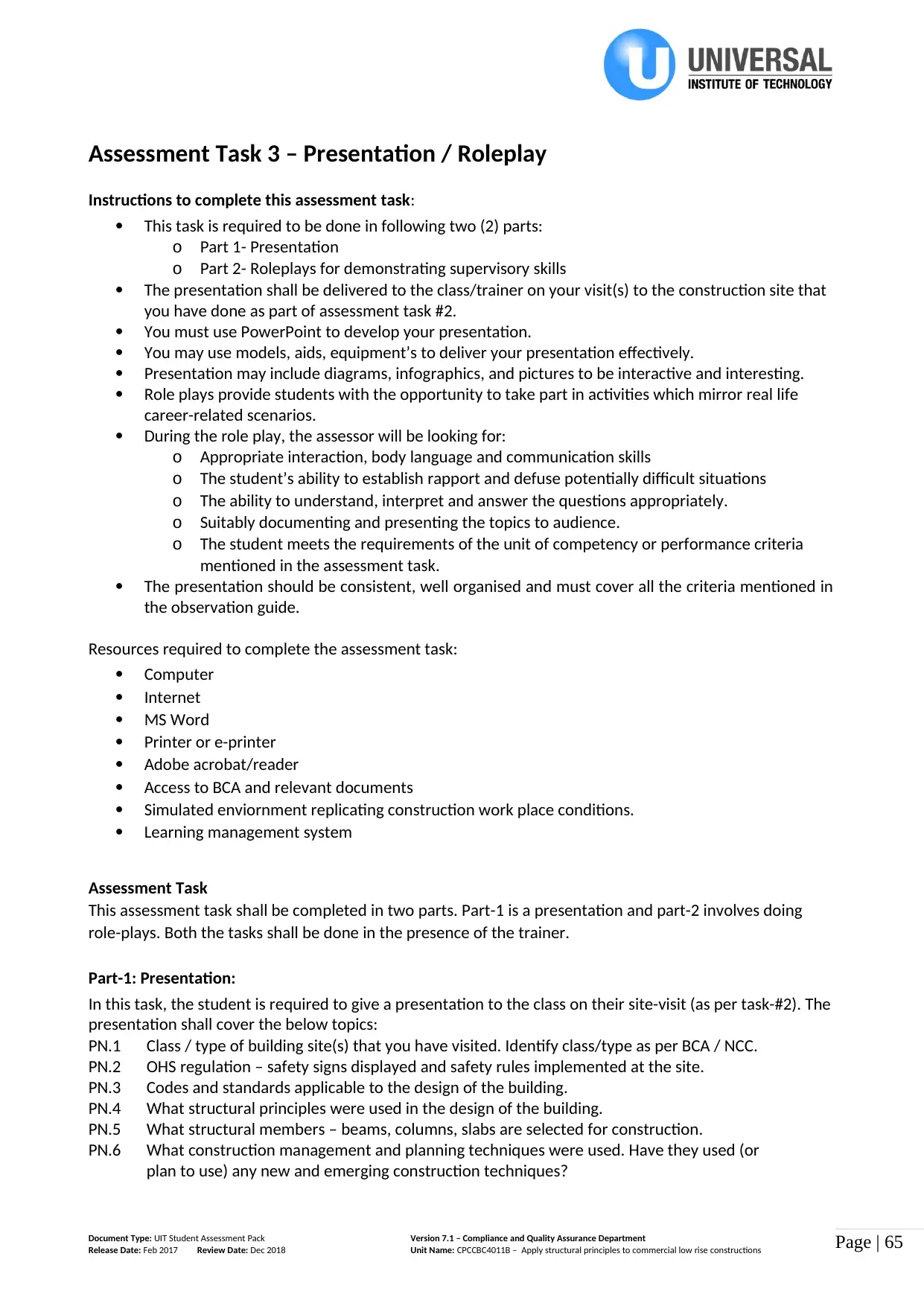
Page | 65
Assessment Task 3 – Presentation / Roleplay
Instructions to complete this assessment task:
This task is required to be done in following two (2) parts:
o Part 1- Presentation
o Part 2- Roleplays for demonstrating supervisory skills
The presentation shall be delivered to the class/trainer on your visit(s) to the construction site that
you have done as part of assessment task #2.
You must use PowerPoint to develop your presentation.
You may use models, aids, equipment’s to deliver your presentation effectively.
Presentation may include diagrams, infographics, and pictures to be interactive and interesting.
Role plays provide students with the opportunity to take part in activities which mirror real life
career-related scenarios.
During the role play, the assessor will be looking for:
o Appropriate interaction, body language and communication skills
o The student’s ability to establish rapport and defuse potentially difficult situations
o The ability to understand, interpret and answer the questions appropriately.
o Suitably documenting and presenting the topics to audience.
o The student meets the requirements of the unit of competency or performance criteria
mentioned in the assessment task.
The presentation should be consistent, well organised and must cover all the criteria mentioned in
the observation guide.
Resources required to complete the assessment task:
Computer
Internet
MS Word
Printer or e-printer
Adobe acrobat/reader
Access to BCA and relevant documents
Simulated enviornment replicating construction work place conditions.
Learning management system
Assessment Task
This assessment task shall be completed in two parts. Part-1 is a presentation and part-2 involves doing
role-plays. Both the tasks shall be done in the presence of the trainer.
Part-1: Presentation:
In this task, the student is required to give a presentation to the class on their site-visit (as per task-#2). The
presentation shall cover the below topics:
PN.1 Class / type of building site(s) that you have visited. Identify class/type as per BCA / NCC.
PN.2 OHS regulation – safety signs displayed and safety rules implemented at the site.
PN.3 Codes and standards applicable to the design of the building.
PN.4 What structural principles were used in the design of the building.
PN.5 What structural members – beams, columns, slabs are selected for construction.
PN.6 What construction management and planning techniques were used. Have they used (or
plan to use) any new and emerging construction techniques?
Document Type: UIT Student Assessment Pack Version 7.1 – Compliance and Quality Assurance Department
Release Date: Feb 2017 Review Date: Dec 2018 Unit Name: CPCCBC4011B – Apply structural principles to commercial low rise constructions
Assessment Task 3 – Presentation / Roleplay
Instructions to complete this assessment task:
This task is required to be done in following two (2) parts:
o Part 1- Presentation
o Part 2- Roleplays for demonstrating supervisory skills
The presentation shall be delivered to the class/trainer on your visit(s) to the construction site that
you have done as part of assessment task #2.
You must use PowerPoint to develop your presentation.
You may use models, aids, equipment’s to deliver your presentation effectively.
Presentation may include diagrams, infographics, and pictures to be interactive and interesting.
Role plays provide students with the opportunity to take part in activities which mirror real life
career-related scenarios.
During the role play, the assessor will be looking for:
o Appropriate interaction, body language and communication skills
o The student’s ability to establish rapport and defuse potentially difficult situations
o The ability to understand, interpret and answer the questions appropriately.
o Suitably documenting and presenting the topics to audience.
o The student meets the requirements of the unit of competency or performance criteria
mentioned in the assessment task.
The presentation should be consistent, well organised and must cover all the criteria mentioned in
the observation guide.
Resources required to complete the assessment task:
Computer
Internet
MS Word
Printer or e-printer
Adobe acrobat/reader
Access to BCA and relevant documents
Simulated enviornment replicating construction work place conditions.
Learning management system
Assessment Task
This assessment task shall be completed in two parts. Part-1 is a presentation and part-2 involves doing
role-plays. Both the tasks shall be done in the presence of the trainer.
Part-1: Presentation:
In this task, the student is required to give a presentation to the class on their site-visit (as per task-#2). The
presentation shall cover the below topics:
PN.1 Class / type of building site(s) that you have visited. Identify class/type as per BCA / NCC.
PN.2 OHS regulation – safety signs displayed and safety rules implemented at the site.
PN.3 Codes and standards applicable to the design of the building.
PN.4 What structural principles were used in the design of the building.
PN.5 What structural members – beams, columns, slabs are selected for construction.
PN.6 What construction management and planning techniques were used. Have they used (or
plan to use) any new and emerging construction techniques?
Document Type: UIT Student Assessment Pack Version 7.1 – Compliance and Quality Assurance Department
Release Date: Feb 2017 Review Date: Dec 2018 Unit Name: CPCCBC4011B – Apply structural principles to commercial low rise constructions
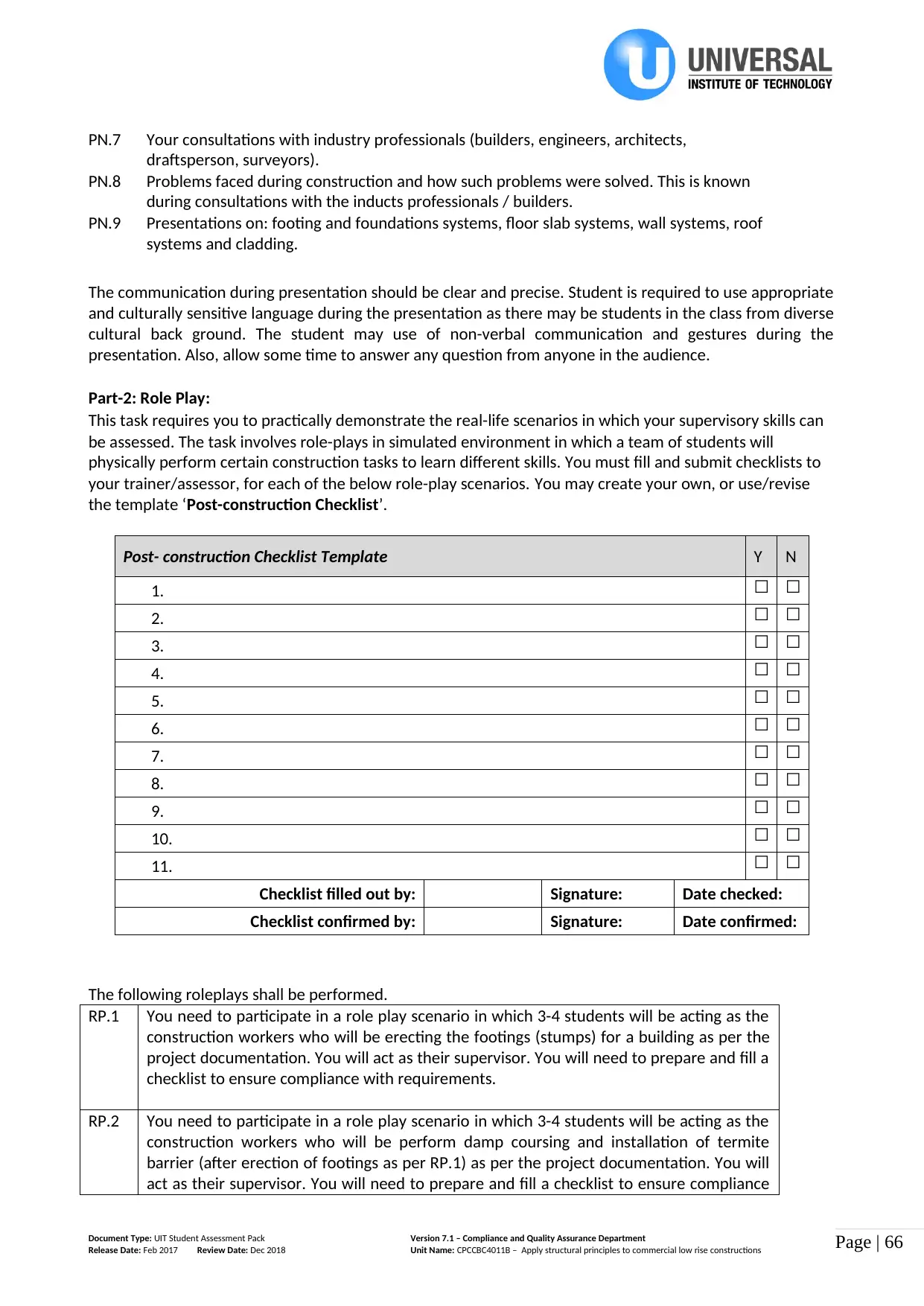
Page | 66
PN.7 Your consultations with industry professionals (builders, engineers, architects,
draftsperson, surveyors).
PN.8 Problems faced during construction and how such problems were solved. This is known
during consultations with the inducts professionals / builders.
PN.9 Presentations on: footing and foundations systems, floor slab systems, wall systems, roof
systems and cladding.
The communication during presentation should be clear and precise. Student is required to use appropriate
and culturally sensitive language during the presentation as there may be students in the class from diverse
cultural back ground. The student may use of non-verbal communication and gestures during the
presentation. Also, allow some time to answer any question from anyone in the audience.
Part-2: Role Play:
This task requires you to practically demonstrate the real-life scenarios in which your supervisory skills can
be assessed. The task involves role-plays in simulated environment in which a team of students will
physically perform certain construction tasks to learn different skills. You must fill and submit checklists to
your trainer/assessor, for each of the below role-play scenarios. You may create your own, or use/revise
the template ‘Post-construction Checklist’.
Post- construction Checklist Template Y N
1. ☐ ☐
2. ☐ ☐
3. ☐ ☐
4. ☐ ☐
5. ☐ ☐
6. ☐ ☐
7. ☐ ☐
8. ☐ ☐
9. ☐ ☐
10. ☐ ☐
11. ☐ ☐
Checklist filled out by: Signature: Date checked:
Checklist confirmed by: Signature: Date confirmed:
The following roleplays shall be performed.
RP.1 You need to participate in a role play scenario in which 3-4 students will be acting as the
construction workers who will be erecting the footings (stumps) for a building as per the
project documentation. You will act as their supervisor. You will need to prepare and fill a
checklist to ensure compliance with requirements.
RP.2 You need to participate in a role play scenario in which 3-4 students will be acting as the
construction workers who will be perform damp coursing and installation of termite
barrier (after erection of footings as per RP.1) as per the project documentation. You will
act as their supervisor. You will need to prepare and fill a checklist to ensure compliance
Document Type: UIT Student Assessment Pack Version 7.1 – Compliance and Quality Assurance Department
Release Date: Feb 2017 Review Date: Dec 2018 Unit Name: CPCCBC4011B – Apply structural principles to commercial low rise constructions
PN.7 Your consultations with industry professionals (builders, engineers, architects,
draftsperson, surveyors).
PN.8 Problems faced during construction and how such problems were solved. This is known
during consultations with the inducts professionals / builders.
PN.9 Presentations on: footing and foundations systems, floor slab systems, wall systems, roof
systems and cladding.
The communication during presentation should be clear and precise. Student is required to use appropriate
and culturally sensitive language during the presentation as there may be students in the class from diverse
cultural back ground. The student may use of non-verbal communication and gestures during the
presentation. Also, allow some time to answer any question from anyone in the audience.
Part-2: Role Play:
This task requires you to practically demonstrate the real-life scenarios in which your supervisory skills can
be assessed. The task involves role-plays in simulated environment in which a team of students will
physically perform certain construction tasks to learn different skills. You must fill and submit checklists to
your trainer/assessor, for each of the below role-play scenarios. You may create your own, or use/revise
the template ‘Post-construction Checklist’.
Post- construction Checklist Template Y N
1. ☐ ☐
2. ☐ ☐
3. ☐ ☐
4. ☐ ☐
5. ☐ ☐
6. ☐ ☐
7. ☐ ☐
8. ☐ ☐
9. ☐ ☐
10. ☐ ☐
11. ☐ ☐
Checklist filled out by: Signature: Date checked:
Checklist confirmed by: Signature: Date confirmed:
The following roleplays shall be performed.
RP.1 You need to participate in a role play scenario in which 3-4 students will be acting as the
construction workers who will be erecting the footings (stumps) for a building as per the
project documentation. You will act as their supervisor. You will need to prepare and fill a
checklist to ensure compliance with requirements.
RP.2 You need to participate in a role play scenario in which 3-4 students will be acting as the
construction workers who will be perform damp coursing and installation of termite
barrier (after erection of footings as per RP.1) as per the project documentation. You will
act as their supervisor. You will need to prepare and fill a checklist to ensure compliance
Document Type: UIT Student Assessment Pack Version 7.1 – Compliance and Quality Assurance Department
Release Date: Feb 2017 Review Date: Dec 2018 Unit Name: CPCCBC4011B – Apply structural principles to commercial low rise constructions
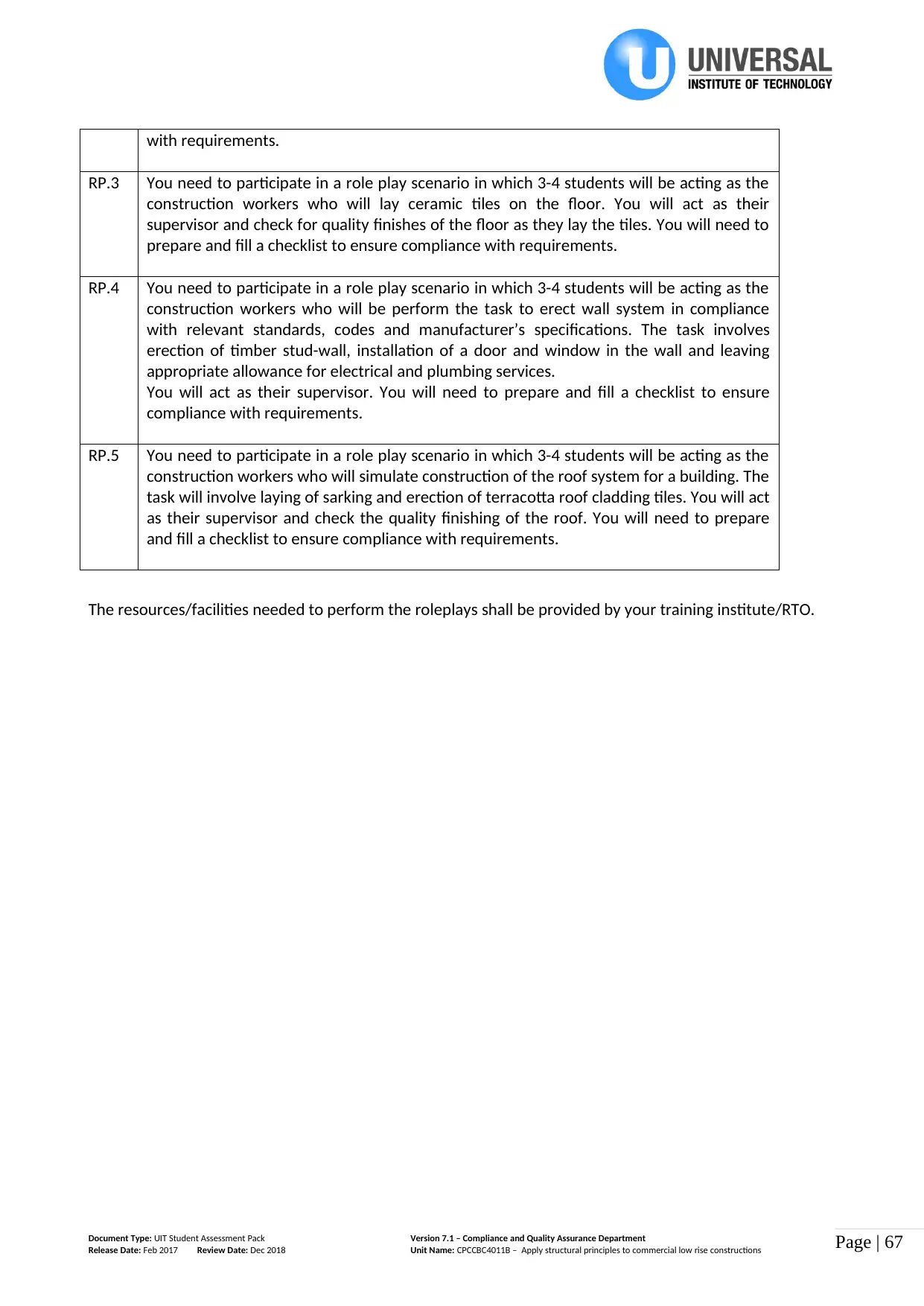
Page | 67
with requirements.
RP.3 You need to participate in a role play scenario in which 3-4 students will be acting as the
construction workers who will lay ceramic tiles on the floor. You will act as their
supervisor and check for quality finishes of the floor as they lay the tiles. You will need to
prepare and fill a checklist to ensure compliance with requirements.
RP.4 You need to participate in a role play scenario in which 3-4 students will be acting as the
construction workers who will be perform the task to erect wall system in compliance
with relevant standards, codes and manufacturer’s specifications. The task involves
erection of timber stud-wall, installation of a door and window in the wall and leaving
appropriate allowance for electrical and plumbing services.
You will act as their supervisor. You will need to prepare and fill a checklist to ensure
compliance with requirements.
RP.5 You need to participate in a role play scenario in which 3-4 students will be acting as the
construction workers who will simulate construction of the roof system for a building. The
task will involve laying of sarking and erection of terracotta roof cladding tiles. You will act
as their supervisor and check the quality finishing of the roof. You will need to prepare
and fill a checklist to ensure compliance with requirements.
The resources/facilities needed to perform the roleplays shall be provided by your training institute/RTO.
Document Type: UIT Student Assessment Pack Version 7.1 – Compliance and Quality Assurance Department
Release Date: Feb 2017 Review Date: Dec 2018 Unit Name: CPCCBC4011B – Apply structural principles to commercial low rise constructions
with requirements.
RP.3 You need to participate in a role play scenario in which 3-4 students will be acting as the
construction workers who will lay ceramic tiles on the floor. You will act as their
supervisor and check for quality finishes of the floor as they lay the tiles. You will need to
prepare and fill a checklist to ensure compliance with requirements.
RP.4 You need to participate in a role play scenario in which 3-4 students will be acting as the
construction workers who will be perform the task to erect wall system in compliance
with relevant standards, codes and manufacturer’s specifications. The task involves
erection of timber stud-wall, installation of a door and window in the wall and leaving
appropriate allowance for electrical and plumbing services.
You will act as their supervisor. You will need to prepare and fill a checklist to ensure
compliance with requirements.
RP.5 You need to participate in a role play scenario in which 3-4 students will be acting as the
construction workers who will simulate construction of the roof system for a building. The
task will involve laying of sarking and erection of terracotta roof cladding tiles. You will act
as their supervisor and check the quality finishing of the roof. You will need to prepare
and fill a checklist to ensure compliance with requirements.
The resources/facilities needed to perform the roleplays shall be provided by your training institute/RTO.
Document Type: UIT Student Assessment Pack Version 7.1 – Compliance and Quality Assurance Department
Release Date: Feb 2017 Review Date: Dec 2018 Unit Name: CPCCBC4011B – Apply structural principles to commercial low rise constructions
Paraphrase This Document
Need a fresh take? Get an instant paraphrase of this document with our AI Paraphraser
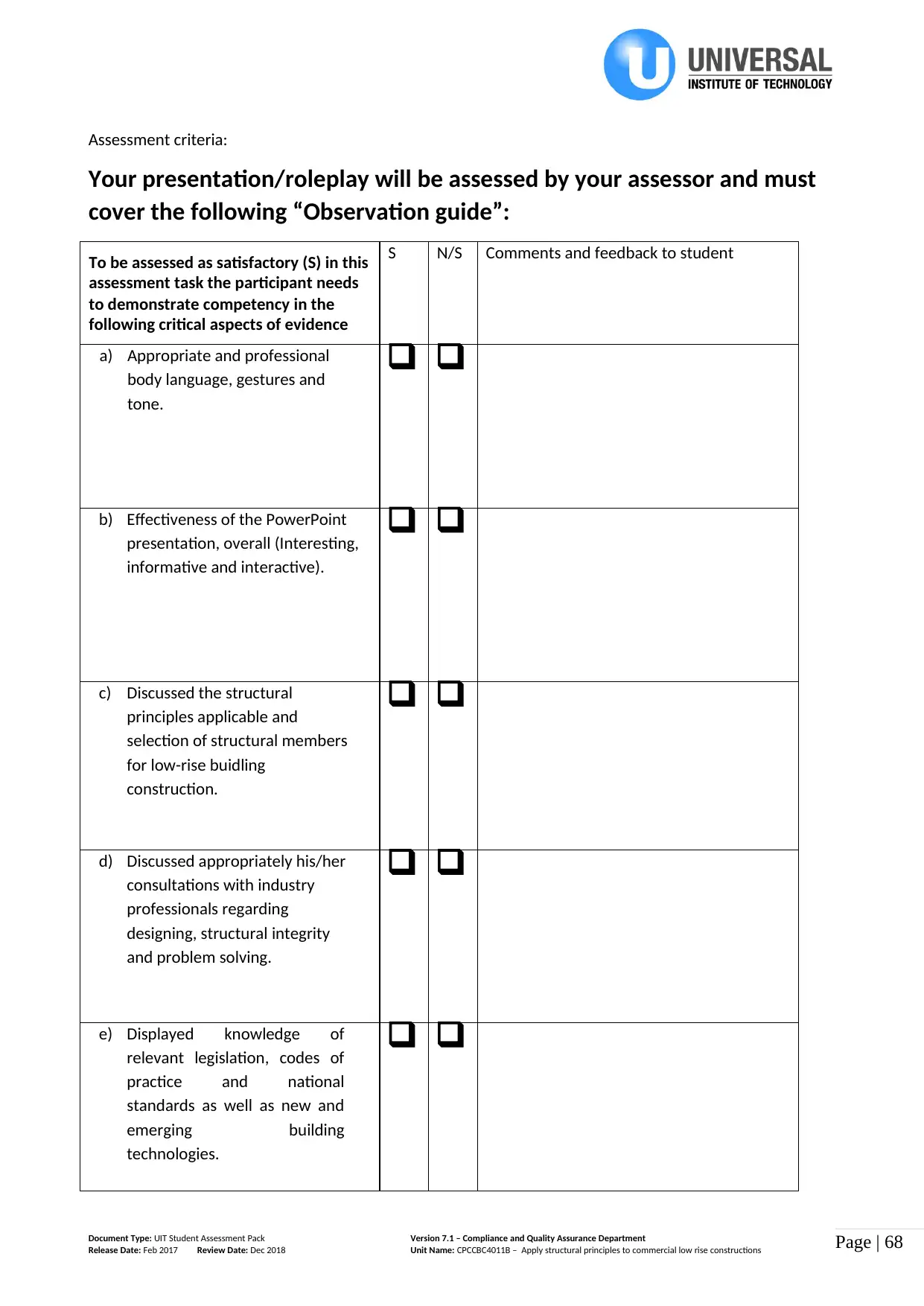
Page | 68
Assessment criteria:
Your presentation/roleplay will be assessed by your assessor and must
cover the following “Observation guide”:
To be assessed as satisfactory (S) in this
assessment task the participant needs
to demonstrate competency in the
following critical aspects of evidence
S N/S Comments and feedback to student
a) Appropriate and professional
body language, gestures and
tone.
b) Effectiveness of the PowerPoint
presentation, overall (Interesting,
informative and interactive).
c) Discussed the structural
principles applicable and
selection of structural members
for low-rise buidling
construction.
d) Discussed appropriately his/her
consultations with industry
professionals regarding
designing, structural integrity
and problem solving.
e) Displayed knowledge of
relevant legislation, codes of
practice and national
standards as well as new and
emerging building
technologies.
Document Type: UIT Student Assessment Pack Version 7.1 – Compliance and Quality Assurance Department
Release Date: Feb 2017 Review Date: Dec 2018 Unit Name: CPCCBC4011B – Apply structural principles to commercial low rise constructions
Assessment criteria:
Your presentation/roleplay will be assessed by your assessor and must
cover the following “Observation guide”:
To be assessed as satisfactory (S) in this
assessment task the participant needs
to demonstrate competency in the
following critical aspects of evidence
S N/S Comments and feedback to student
a) Appropriate and professional
body language, gestures and
tone.
b) Effectiveness of the PowerPoint
presentation, overall (Interesting,
informative and interactive).
c) Discussed the structural
principles applicable and
selection of structural members
for low-rise buidling
construction.
d) Discussed appropriately his/her
consultations with industry
professionals regarding
designing, structural integrity
and problem solving.
e) Displayed knowledge of
relevant legislation, codes of
practice and national
standards as well as new and
emerging building
technologies.
Document Type: UIT Student Assessment Pack Version 7.1 – Compliance and Quality Assurance Department
Release Date: Feb 2017 Review Date: Dec 2018 Unit Name: CPCCBC4011B – Apply structural principles to commercial low rise constructions
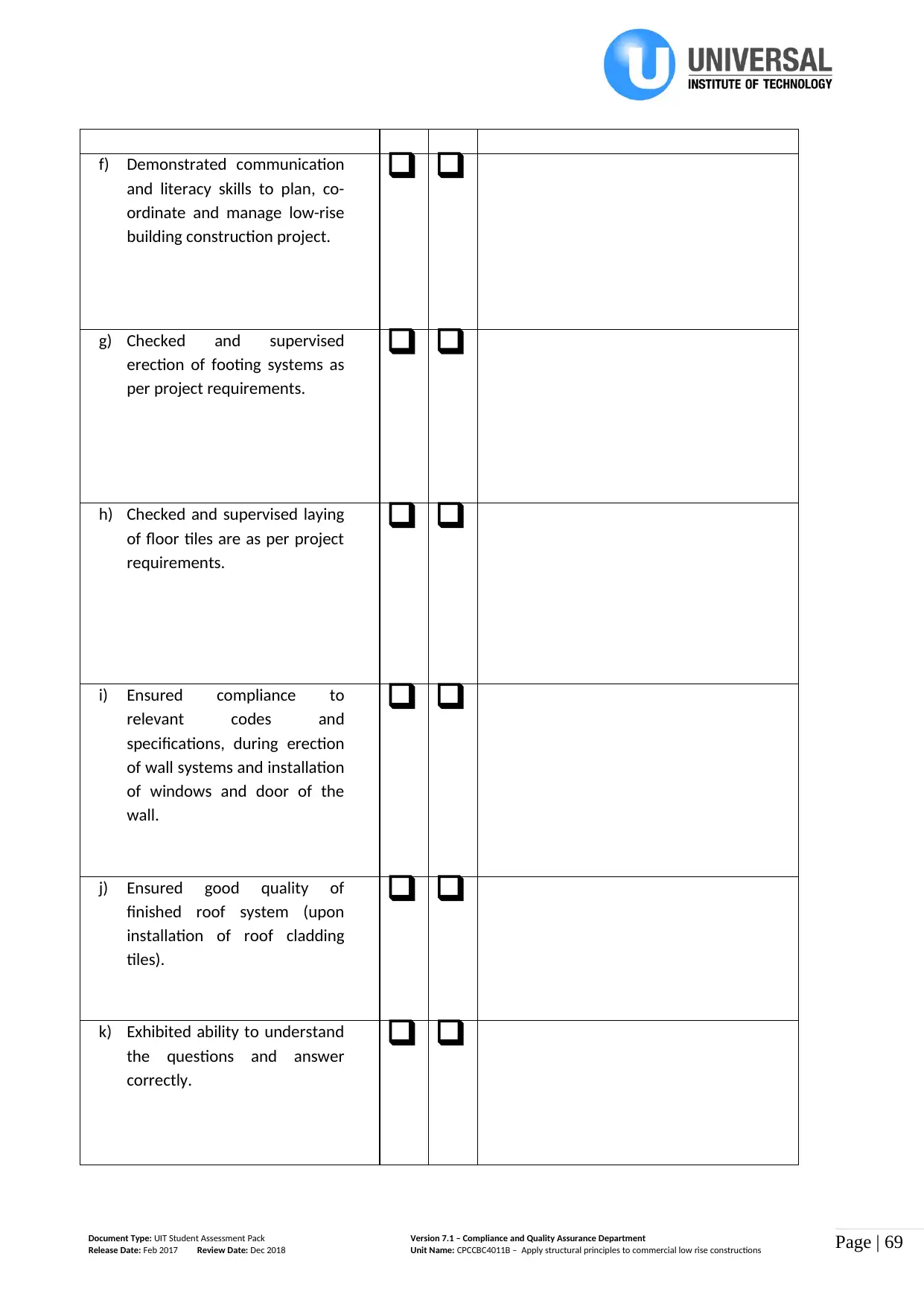
Page | 69
f) Demonstrated communication
and literacy skills to plan, co-
ordinate and manage low-rise
building construction project.
g) Checked and supervised
erection of footing systems as
per project requirements.
h) Checked and supervised laying
of floor tiles are as per project
requirements.
i) Ensured compliance to
relevant codes and
specifications, during erection
of wall systems and installation
of windows and door of the
wall.
j) Ensured good quality of
finished roof system (upon
installation of roof cladding
tiles).
k) Exhibited ability to understand
the questions and answer
correctly.
Document Type: UIT Student Assessment Pack Version 7.1 – Compliance and Quality Assurance Department
Release Date: Feb 2017 Review Date: Dec 2018 Unit Name: CPCCBC4011B – Apply structural principles to commercial low rise constructions
f) Demonstrated communication
and literacy skills to plan, co-
ordinate and manage low-rise
building construction project.
g) Checked and supervised
erection of footing systems as
per project requirements.
h) Checked and supervised laying
of floor tiles are as per project
requirements.
i) Ensured compliance to
relevant codes and
specifications, during erection
of wall systems and installation
of windows and door of the
wall.
j) Ensured good quality of
finished roof system (upon
installation of roof cladding
tiles).
k) Exhibited ability to understand
the questions and answer
correctly.
Document Type: UIT Student Assessment Pack Version 7.1 – Compliance and Quality Assurance Department
Release Date: Feb 2017 Review Date: Dec 2018 Unit Name: CPCCBC4011B – Apply structural principles to commercial low rise constructions

Page | 70Document Type: UIT Student Assessment Pack Version 7.1 – Compliance and Quality Assurance Department
Release Date: Feb 2017 Review Date: Dec 2018 Unit Name: CPCCBC4011B – Apply structural principles to commercial low rise constructions
Release Date: Feb 2017 Review Date: Dec 2018 Unit Name: CPCCBC4011B – Apply structural principles to commercial low rise constructions
Secure Best Marks with AI Grader
Need help grading? Try our AI Grader for instant feedback on your assignments.
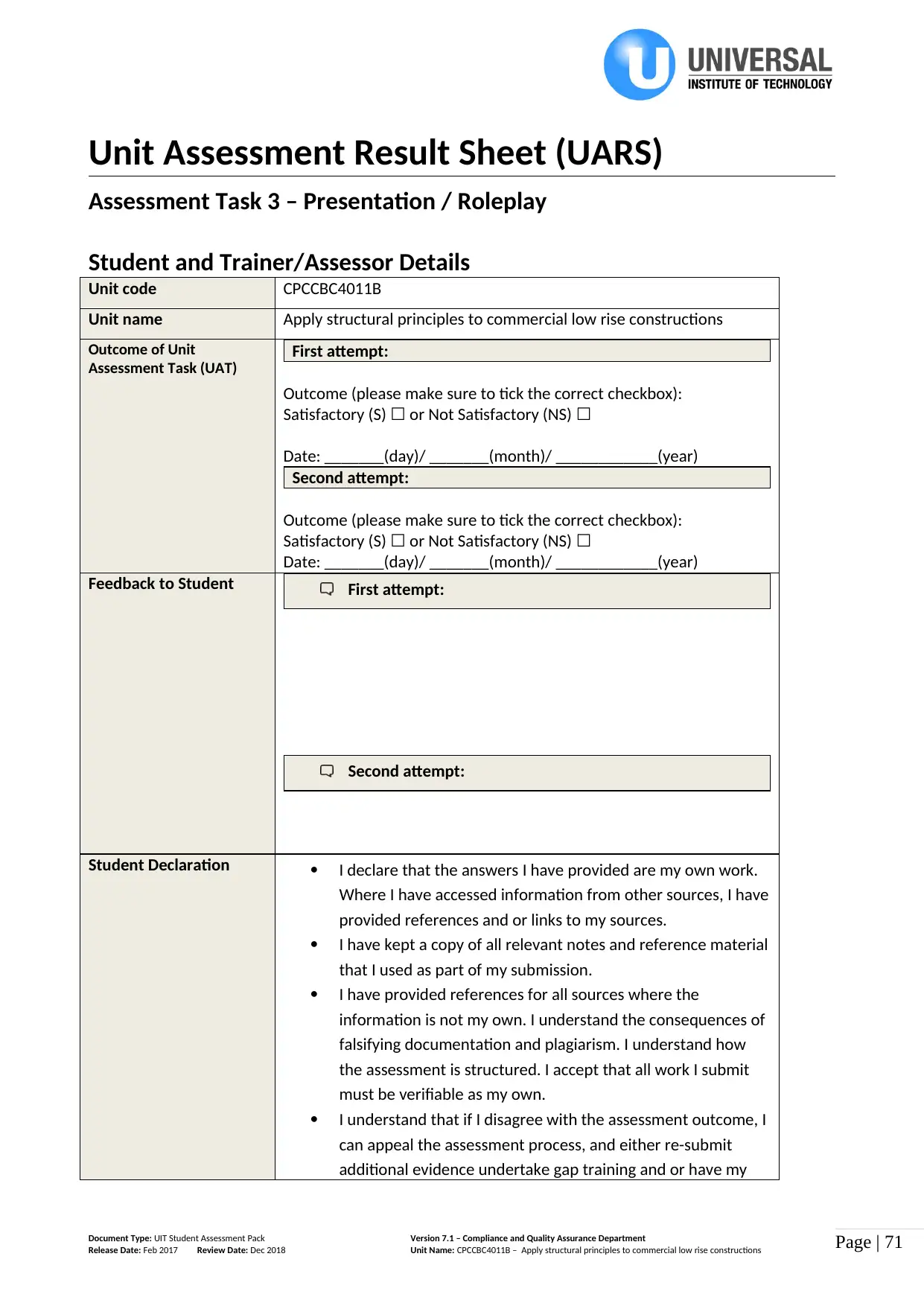
Page | 71
Unit Assessment Result Sheet (UARS)
Assessment Task 3 – Presentation / Roleplay
Student and Trainer/Assessor Details
Unit code CPCCBC4011B
Unit name Apply structural principles to commercial low rise constructions
Outcome of Unit
Assessment Task (UAT)
First attempt:
Outcome (please make sure to tick the correct checkbox):
Satisfactory (S) ☐ or Not Satisfactory (NS) ☐
Date: _______(day)/ _______(month)/ ____________(year)
Second attempt:
Outcome (please make sure to tick the correct checkbox):
Satisfactory (S) ☐ or Not Satisfactory (NS) ☐
Date: _______(day)/ _______(month)/ ____________(year)
Feedback to Student First attempt:
Second attempt:
Student Declaration I declare that the answers I have provided are my own work.
Where I have accessed information from other sources, I have
provided references and or links to my sources.
I have kept a copy of all relevant notes and reference material
that I used as part of my submission.
I have provided references for all sources where the
information is not my own. I understand the consequences of
falsifying documentation and plagiarism. I understand how
the assessment is structured. I accept that all work I submit
must be verifiable as my own.
I understand that if I disagree with the assessment outcome, I
can appeal the assessment process, and either re-submit
additional evidence undertake gap training and or have my
Document Type: UIT Student Assessment Pack Version 7.1 – Compliance and Quality Assurance Department
Release Date: Feb 2017 Review Date: Dec 2018 Unit Name: CPCCBC4011B – Apply structural principles to commercial low rise constructions
Unit Assessment Result Sheet (UARS)
Assessment Task 3 – Presentation / Roleplay
Student and Trainer/Assessor Details
Unit code CPCCBC4011B
Unit name Apply structural principles to commercial low rise constructions
Outcome of Unit
Assessment Task (UAT)
First attempt:
Outcome (please make sure to tick the correct checkbox):
Satisfactory (S) ☐ or Not Satisfactory (NS) ☐
Date: _______(day)/ _______(month)/ ____________(year)
Second attempt:
Outcome (please make sure to tick the correct checkbox):
Satisfactory (S) ☐ or Not Satisfactory (NS) ☐
Date: _______(day)/ _______(month)/ ____________(year)
Feedback to Student First attempt:
Second attempt:
Student Declaration I declare that the answers I have provided are my own work.
Where I have accessed information from other sources, I have
provided references and or links to my sources.
I have kept a copy of all relevant notes and reference material
that I used as part of my submission.
I have provided references for all sources where the
information is not my own. I understand the consequences of
falsifying documentation and plagiarism. I understand how
the assessment is structured. I accept that all work I submit
must be verifiable as my own.
I understand that if I disagree with the assessment outcome, I
can appeal the assessment process, and either re-submit
additional evidence undertake gap training and or have my
Document Type: UIT Student Assessment Pack Version 7.1 – Compliance and Quality Assurance Department
Release Date: Feb 2017 Review Date: Dec 2018 Unit Name: CPCCBC4011B – Apply structural principles to commercial low rise constructions
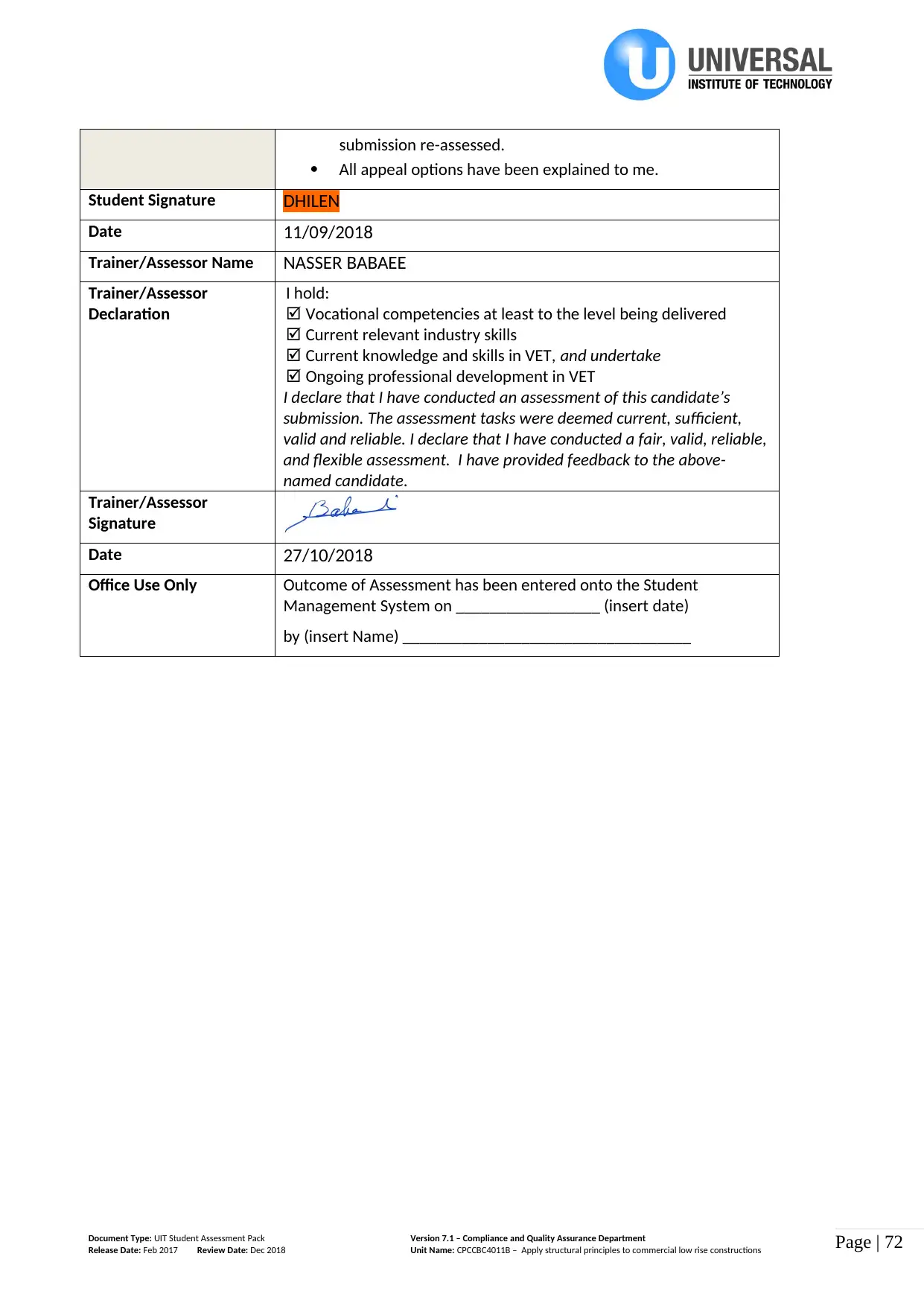
Page | 72
submission re-assessed.
All appeal options have been explained to me.
Student Signature DHILEN
Date 11/09/2018
Trainer/Assessor Name NASSER BABAEE
Trainer/Assessor
Declaration
I hold:
Vocational competencies at least to the level being delivered
Current relevant industry skills
Current knowledge and skills in VET, and undertake
Ongoing professional development in VET
I declare that I have conducted an assessment of this candidate’s
submission. The assessment tasks were deemed current, sufficient,
valid and reliable. I declare that I have conducted a fair, valid, reliable,
and flexible assessment. I have provided feedback to the above-
named candidate.
Trainer/Assessor
Signature
Date 27/10/2018
Office Use Only Outcome of Assessment has been entered onto the Student
Management System on _________________ (insert date)
by (insert Name) __________________________________
Document Type: UIT Student Assessment Pack Version 7.1 – Compliance and Quality Assurance Department
Release Date: Feb 2017 Review Date: Dec 2018 Unit Name: CPCCBC4011B – Apply structural principles to commercial low rise constructions
submission re-assessed.
All appeal options have been explained to me.
Student Signature DHILEN
Date 11/09/2018
Trainer/Assessor Name NASSER BABAEE
Trainer/Assessor
Declaration
I hold:
Vocational competencies at least to the level being delivered
Current relevant industry skills
Current knowledge and skills in VET, and undertake
Ongoing professional development in VET
I declare that I have conducted an assessment of this candidate’s
submission. The assessment tasks were deemed current, sufficient,
valid and reliable. I declare that I have conducted a fair, valid, reliable,
and flexible assessment. I have provided feedback to the above-
named candidate.
Trainer/Assessor
Signature
Date 27/10/2018
Office Use Only Outcome of Assessment has been entered onto the Student
Management System on _________________ (insert date)
by (insert Name) __________________________________
Document Type: UIT Student Assessment Pack Version 7.1 – Compliance and Quality Assurance Department
Release Date: Feb 2017 Review Date: Dec 2018 Unit Name: CPCCBC4011B – Apply structural principles to commercial low rise constructions
1 out of 72
Related Documents
Your All-in-One AI-Powered Toolkit for Academic Success.
+13062052269
info@desklib.com
Available 24*7 on WhatsApp / Email
![[object Object]](/_next/static/media/star-bottom.7253800d.svg)
Unlock your academic potential
© 2024 | Zucol Services PVT LTD | All rights reserved.




